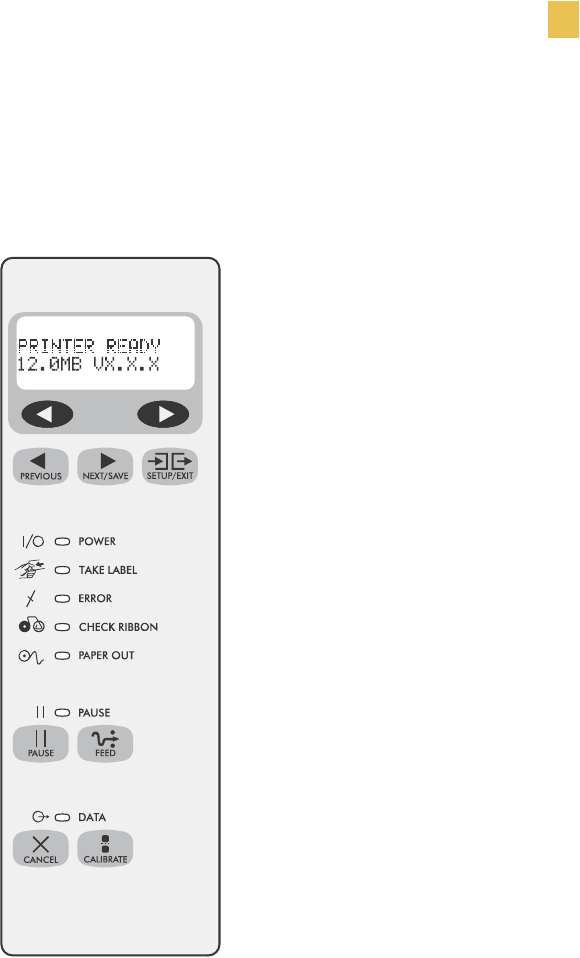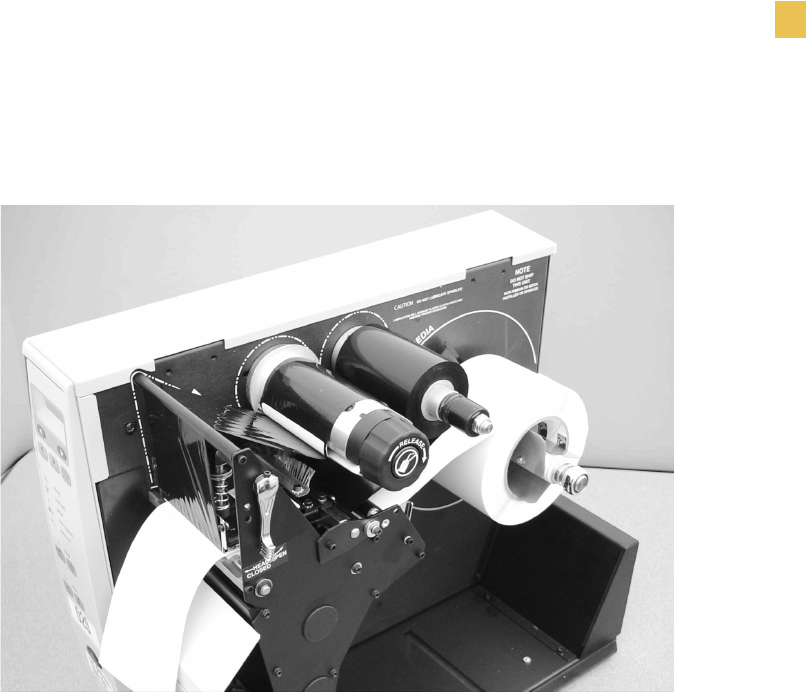Zebra Technologies RFID-R170XI-02 Thermal Transfer on Demand Bar Code Printer User Manual User Guide
Zebra Technologies Corporation Thermal Transfer on Demand Bar Code Printer User Guide
Users Manual
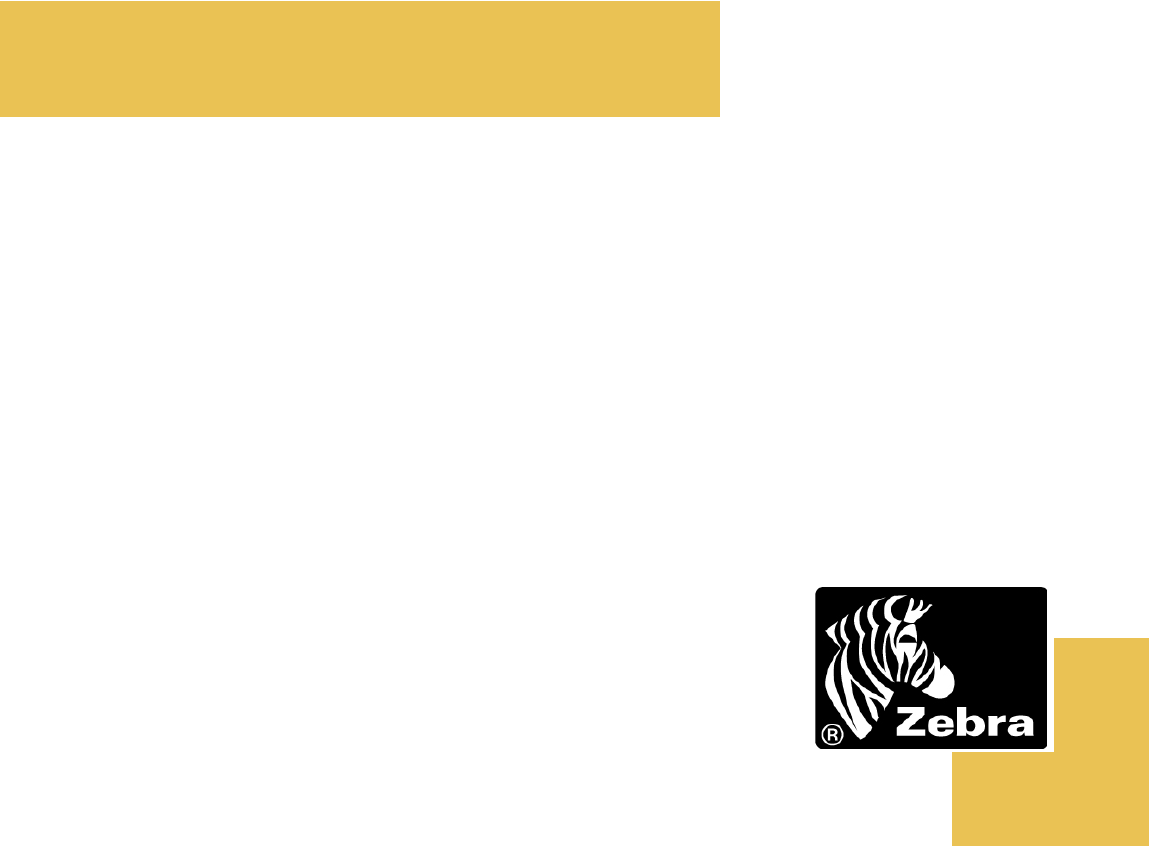
Zebra RXiIIIPlus™ Printers
User Guide
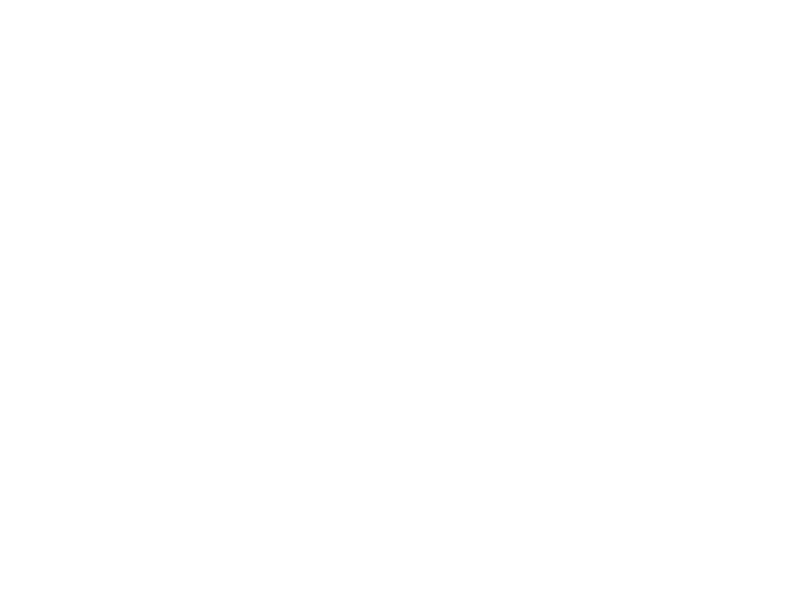
Copyright © ZIH Corp.
The copyrights in this manual and the label printer described therein are owned
by Zebra Technologies. All rights are reserved. Unauthorized reproduction of
this manual or the software in the label printer may result in imprisonment of
up to one year and fines of up to $10,000 (17 U.S.C.506). Copyright violators
may be subject to civil liability.
IBM® is a registered trademark of IBM Corporation.
Adobe® and Acrobat® are registered trademarks of Adobe Systems
Incorporated.
Zebra®, Stripe®, ZPL®, ZebraNet®, ZebraLink™, and ZPL II® are registered
trademarks of Zebra Technologies.
All other brand names, product names, trademarks, and registered trademarks
are property of their respective holders.
Part Number: 13383L R1

R110/R170XiIIIPlus User Guide i
Table of Contents
Proprietary Statement . . . . . . . . . . . . . . . . . . . . . . . . . . . . . . . . . . . . . . . . . . . . . . vii
Warranty Information. . . . . . . . . . . . . . . . . . . . . . . . . . . . . . . . . . . . . . . . . . . . . . . . xi
Printer Software and Firmware License Agreement. . . . . . . . . . . . . . . . . . . . . . xv
Preface . . . . . . . . . . . . . . . . . . . . . . . . . . . . . . . . . . . . . . . . . . . . . . . . . . . . . . . . . . xxi
Contacts . . . . . . . . . . . . . . . . . . . . . . . . . . . . . . . . . . . . . . . . . . . . . . . . . . . . . . . . . . . . .xxii
Support . . . . . . . . . . . . . . . . . . . . . . . . . . . . . . . . . . . . . . . . . . . . . . . . . . . . . . . . . . xxii
About this Document . . . . . . . . . . . . . . . . . . . . . . . . . . . . . . . . . . . . . . . . . . . . . . . . . . xxiii
Document Conventions . . . . . . . . . . . . . . . . . . . . . . . . . . . . . . . . . . . . . . . . . . . . . . . . xxiv
Related Documents . . . . . . . . . . . . . . . . . . . . . . . . . . . . . . . . . . . . . . . . . . . . . . . . . . . xxvi
Chapter 1 • Introduction . . . . . . . . . . . . . . . . . . . . . . . . . . . . . . . . . . . . . . . . . . . . . 1
Exterior View . . . . . . . . . . . . . . . . . . . . . . . . . . . . . . . . . . . . . . . . . . . . . . . . . . . . . . . . . . 2
Front Panel . . . . . . . . . . . . . . . . . . . . . . . . . . . . . . . . . . . . . . . . . . . . . . . . . . . . . . . . . . . 3
Front Panel Buttons . . . . . . . . . . . . . . . . . . . . . . . . . . . . . . . . . . . . . . . . . . . . . . . . . 4
Front Panel Lights. . . . . . . . . . . . . . . . . . . . . . . . . . . . . . . . . . . . . . . . . . . . . . . . . . . 5
Printer Components . . . . . . . . . . . . . . . . . . . . . . . . . . . . . . . . . . . . . . . . . . . . . . . . . . . . . 6
Chapter 2 • Printer Setup . . . . . . . . . . . . . . . . . . . . . . . . . . . . . . . . . . . . . . . . . . . . 7
Before You Begin . . . . . . . . . . . . . . . . . . . . . . . . . . . . . . . . . . . . . . . . . . . . . . . . . . . . . . . 8
Unpack and Inspect the Printer . . . . . . . . . . . . . . . . . . . . . . . . . . . . . . . . . . . . . . . . . . . . 9
Report Shipping Damage . . . . . . . . . . . . . . . . . . . . . . . . . . . . . . . . . . . . . . . . . . . . . 9
Store or Reship the Printer . . . . . . . . . . . . . . . . . . . . . . . . . . . . . . . . . . . . . . . . . . . . 9
Select a Site for the Printer . . . . . . . . . . . . . . . . . . . . . . . . . . . . . . . . . . . . . . . . . . . . . . 10
Select a Surface . . . . . . . . . . . . . . . . . . . . . . . . . . . . . . . . . . . . . . . . . . . . . . . . . . . 10
Provide Proper Operating Conditions . . . . . . . . . . . . . . . . . . . . . . . . . . . . . . . . . . . 10
Allow Proper Space. . . . . . . . . . . . . . . . . . . . . . . . . . . . . . . . . . . . . . . . . . . . . . . . . 10
Provide a Data Source . . . . . . . . . . . . . . . . . . . . . . . . . . . . . . . . . . . . . . . . . . . . . . 10
Connect the Printer to a Power Source . . . . . . . . . . . . . . . . . . . . . . . . . . . . . . . . . . . . . .11
Power Cord . . . . . . . . . . . . . . . . . . . . . . . . . . . . . . . . . . . . . . . . . . . . . . . . . . . . . . . .11
Communication Interfaces . . . . . . . . . . . . . . . . . . . . . . . . . . . . . . . . . . . . . . . . . . . . . . . 13
Data Cable Requirements. . . . . . . . . . . . . . . . . . . . . . . . . . . . . . . . . . . . . . . . . . . . 14

ii R110/R170XiIIIPlus User Guide
Table of Contents
Types of Media. . . . . . . . . . . . . . . . . . . . . . . . . . . . . . . . . . . . . . . . . . . . . . . . . . . . . . . . 15
Continuous Media . . . . . . . . . . . . . . . . . . . . . . . . . . . . . . . . . . . . . . . . . . . . . . . . . . 15
Non-Continuous Black Mark Media . . . . . . . . . . . . . . . . . . . . . . . . . . . . . . . . . . . . 15
Non-Continuous Web Media. . . . . . . . . . . . . . . . . . . . . . . . . . . . . . . . . . . . . . . . . . 16
RFID “Smart” Labels . . . . . . . . . . . . . . . . . . . . . . . . . . . . . . . . . . . . . . . . . . . . . . . . 17
Ribbon . . . . . . . . . . . . . . . . . . . . . . . . . . . . . . . . . . . . . . . . . . . . . . . . . . . . . . . . . . . . . . 18
Chapter 3 • Printer Operation . . . . . . . . . . . . . . . . . . . . . . . . . . . . . . . . . . . . . . . . 19
Load the Printer . . . . . . . . . . . . . . . . . . . . . . . . . . . . . . . . . . . . . . . . . . . . . . . . . . . . . . . 20
Load Roll Media . . . . . . . . . . . . . . . . . . . . . . . . . . . . . . . . . . . . . . . . . . . . . . . . . . . 20
Load Fanfold Media . . . . . . . . . . . . . . . . . . . . . . . . . . . . . . . . . . . . . . . . . . . . . . . . 22
Load Ribbon . . . . . . . . . . . . . . . . . . . . . . . . . . . . . . . . . . . . . . . . . . . . . . . . . . . . . . 24
Remove Used Ribbon. . . . . . . . . . . . . . . . . . . . . . . . . . . . . . . . . . . . . . . . . . . . . . . 28
Print a Configuration Label . . . . . . . . . . . . . . . . . . . . . . . . . . . . . . . . . . . . . . . . . . . . . . 29
Calibrate the Printer . . . . . . . . . . . . . . . . . . . . . . . . . . . . . . . . . . . . . . . . . . . . . . . . . . . . 31
Adjust Sensors. . . . . . . . . . . . . . . . . . . . . . . . . . . . . . . . . . . . . . . . . . . . . . . . . . . . . . . . 32
Media and Ribbon Sensor Calibration . . . . . . . . . . . . . . . . . . . . . . . . . . . . . . . . . . 32
Transmissive (Media) Sensors . . . . . . . . . . . . . . . . . . . . . . . . . . . . . . . . . . . . . . . . 34
Adjust the Printhead. . . . . . . . . . . . . . . . . . . . . . . . . . . . . . . . . . . . . . . . . . . . . . . . . . . . 37
Chapter 4 • Print Modes . . . . . . . . . . . . . . . . . . . . . . . . . . . . . . . . . . . . . . . . . . . . 39
Select a Print Mode . . . . . . . . . . . . . . . . . . . . . . . . . . . . . . . . . . . . . . . . . . . . . . . . . . . . 40
Tear-Off Mode . . . . . . . . . . . . . . . . . . . . . . . . . . . . . . . . . . . . . . . . . . . . . . . . . . . . . 40
Peel-Off Mode. . . . . . . . . . . . . . . . . . . . . . . . . . . . . . . . . . . . . . . . . . . . . . . . . . . . . 41
Cutter Mode . . . . . . . . . . . . . . . . . . . . . . . . . . . . . . . . . . . . . . . . . . . . . . . . . . . . . . 43
Rewind Mode . . . . . . . . . . . . . . . . . . . . . . . . . . . . . . . . . . . . . . . . . . . . . . . . . . . . . 45
Rewind Mode with Cutter Option . . . . . . . . . . . . . . . . . . . . . . . . . . . . . . . . . . . . . . 48
Remove Backing from Rewind Spindle . . . . . . . . . . . . . . . . . . . . . . . . . . . . . . . . . . . . . 51
Chapter 5 • Configuration . . . . . . . . . . . . . . . . . . . . . . . . . . . . . . . . . . . . . . . . . . . 53
Overview . . . . . . . . . . . . . . . . . . . . . . . . . . . . . . . . . . . . . . . . . . . . . . . . . . . . . . . . . . . . 54
Enter Setup Mode . . . . . . . . . . . . . . . . . . . . . . . . . . . . . . . . . . . . . . . . . . . . . . . . . . 54
Exit Setup Mode . . . . . . . . . . . . . . . . . . . . . . . . . . . . . . . . . . . . . . . . . . . . . . . . . . . 54
Password-Protected Parameters . . . . . . . . . . . . . . . . . . . . . . . . . . . . . . . . . . . . . . . . . . 56
Default Password Value . . . . . . . . . . . . . . . . . . . . . . . . . . . . . . . . . . . . . . . . . . . . . 56
Disable the Password Protection Feature. . . . . . . . . . . . . . . . . . . . . . . . . . . . . . . . 56
Configuration and Calibration LCD Displays . . . . . . . . . . . . . . . . . . . . . . . . . . . . . . . . . 57
ZebraNet PrintServer II LCD Displays . . . . . . . . . . . . . . . . . . . . . . . . . . . . . . . . . . . . . . 76

Table of Contents
R110/R170XiIIIPlus User Guide iii
Chapter 6 • RFID Guidelines . . . . . . . . . . . . . . . . . . . . . . . . . . . . . . . . . . . . . . . . . 79
Overview . . . . . . . . . . . . . . . . . . . . . . . . . . . . . . . . . . . . . . . . . . . . . . . . . . . . . . . . . . . . 80
Transponder Placement. . . . . . . . . . . . . . . . . . . . . . . . . . . . . . . . . . . . . . . . . . . . . . . . . 80
ZPL II Commands for RFID . . . . . . . . . . . . . . . . . . . . . . . . . . . . . . . . . . . . . . . . . . . . . . 81
Sample of RFID Programming. . . . . . . . . . . . . . . . . . . . . . . . . . . . . . . . . . . . . . . . . . . . 91
Chapter 7 • Data Ports . . . . . . . . . . . . . . . . . . . . . . . . . . . . . . . . . . . . . . . . . . . . . . 93
Standard Ports . . . . . . . . . . . . . . . . . . . . . . . . . . . . . . . . . . . . . . . . . . . . . . . . . . . . . . . . 94
Parallel Port . . . . . . . . . . . . . . . . . . . . . . . . . . . . . . . . . . . . . . . . . . . . . . . . . . . . . . 94
Serial Port . . . . . . . . . . . . . . . . . . . . . . . . . . . . . . . . . . . . . . . . . . . . . . . . . . . . . . . . 96
USB 2.0 Port . . . . . . . . . . . . . . . . . . . . . . . . . . . . . . . . . . . . . . . . . . . . . . . . . . . . . 102
Chapter 8 • Memory Cards . . . . . . . . . . . . . . . . . . . . . . . . . . . . . . . . . . . . . . . . . 103
PCMCIA Card . . . . . . . . . . . . . . . . . . . . . . . . . . . . . . . . . . . . . . . . . . . . . . . . . . . . . . . 104
CompactFlash Card . . . . . . . . . . . . . . . . . . . . . . . . . . . . . . . . . . . . . . . . . . . . . . . . . . . 106
Chapter 9 • Routine Maintenance. . . . . . . . . . . . . . . . . . . . . . . . . . . . . . . . . . . . 109
Cleaning Schedule. . . . . . . . . . . . . . . . . . . . . . . . . . . . . . . . . . . . . . . . . . . . . . . . . . . . .110
Clean Exterior . . . . . . . . . . . . . . . . . . . . . . . . . . . . . . . . . . . . . . . . . . . . . . . . . . . . . . . . 111
Clean Interior . . . . . . . . . . . . . . . . . . . . . . . . . . . . . . . . . . . . . . . . . . . . . . . . . . . . . . . . .111
Printhead and Platen Roller . . . . . . . . . . . . . . . . . . . . . . . . . . . . . . . . . . . . . . . . . .111
Sensors. . . . . . . . . . . . . . . . . . . . . . . . . . . . . . . . . . . . . . . . . . . . . . . . . . . . . . . . . .113
Snap Plate . . . . . . . . . . . . . . . . . . . . . . . . . . . . . . . . . . . . . . . . . . . . . . . . . . . . . . .115
Cutter . . . . . . . . . . . . . . . . . . . . . . . . . . . . . . . . . . . . . . . . . . . . . . . . . . . . . . . . . . .116
Replace Fuse. . . . . . . . . . . . . . . . . . . . . . . . . . . . . . . . . . . . . . . . . . . . . . . . . . . . . . . . .117
Chapter 10 • Troubleshooting . . . . . . . . . . . . . . . . . . . . . . . . . . . . . . . . . . . . . . . 119
Troubleshooting . . . . . . . . . . . . . . . . . . . . . . . . . . . . . . . . . . . . . . . . . . . . . . . . . . . . . . 120
LCD Error Messages . . . . . . . . . . . . . . . . . . . . . . . . . . . . . . . . . . . . . . . . . . . . . . . . . . 121
Print Quality Problems . . . . . . . . . . . . . . . . . . . . . . . . . . . . . . . . . . . . . . . . . . . . . . . . . 126
Communications Problems . . . . . . . . . . . . . . . . . . . . . . . . . . . . . . . . . . . . . . . . . . . . . 129
Printer Diagnostics. . . . . . . . . . . . . . . . . . . . . . . . . . . . . . . . . . . . . . . . . . . . . . . . . . . . 131
Power-On Self Test . . . . . . . . . . . . . . . . . . . . . . . . . . . . . . . . . . . . . . . . . . . . . . . . 131
Additional Printer Self Tests . . . . . . . . . . . . . . . . . . . . . . . . . . . . . . . . . . . . . . . . . 131
Communications Diagnostics Test . . . . . . . . . . . . . . . . . . . . . . . . . . . . . . . . . . . . 135
Additional Printer Diagnostics . . . . . . . . . . . . . . . . . . . . . . . . . . . . . . . . . . . . . . . . 135

iv R110/R170XiIIIPlus User Guide
Table of Contents
Appendix A • Specifications . . . . . . . . . . . . . . . . . . . . . . . . . . . . . . . . . . . . . . . . 137
Features. . . . . . . . . . . . . . . . . . . . . . . . . . . . . . . . . . . . . . . . . . . . . . . . . . . . . . . . . . . . 138
Standard Features . . . . . . . . . . . . . . . . . . . . . . . . . . . . . . . . . . . . . . . . . . . . . . . . 138
Print Modes. . . . . . . . . . . . . . . . . . . . . . . . . . . . . . . . . . . . . . . . . . . . . . . . . . . . . . 138
Zebra Programming Language (ZPL II®) . . . . . . . . . . . . . . . . . . . . . . . . . . . . . . . 138
Bar Codes . . . . . . . . . . . . . . . . . . . . . . . . . . . . . . . . . . . . . . . . . . . . . . . . . . . . . . . 139
Agency Approvals for All Printers . . . . . . . . . . . . . . . . . . . . . . . . . . . . . . . . . . . . . 140
Compliance for All Printers . . . . . . . . . . . . . . . . . . . . . . . . . . . . . . . . . . . . . . . . . . 140
General Specifications . . . . . . . . . . . . . . . . . . . . . . . . . . . . . . . . . . . . . . . . . . . . . . . . . 141
Electrical Specifications . . . . . . . . . . . . . . . . . . . . . . . . . . . . . . . . . . . . . . . . . . . . 141
Environmental Conditions for Operation and Storage. . . . . . . . . . . . . . . . . . . . . . 141
Print Specifications by Model . . . . . . . . . . . . . . . . . . . . . . . . . . . . . . . . . . . . . . . . . . . . 142
Ribbon Specifications by Model . . . . . . . . . . . . . . . . . . . . . . . . . . . . . . . . . . . . . . . . . . 144
Label Specifications . . . . . . . . . . . . . . . . . . . . . . . . . . . . . . . . . . . . . . . . . . . . . . . . . . . 146
R110XiIIIPlus Printers . . . . . . . . . . . . . . . . . . . . . . . . . . . . . . . . . . . . . . . . . . . . . . 146
R170XiIIIPlus Printers. . . . . . . . . . . . . . . . . . . . . . . . . . . . . . . . . . . . . . . . . . . . . . 149
Index . . . . . . . . . . . . . . . . . . . . . . . . . . . . . . . . . . . . . . . . . . . . . . . . . . . . . . . . . . . 151

R110/R170XiIIIPlus User Guide
Proprietary Statement
This manual contains proprietary information of Zebra Technologies Corporation and its
subsidiaries (“Zebra Technologies”). It is intended solely for the information and use of parties operating and
maintaining the equipment described herein. Such proprietary information may not be used, reproduced, or
disclosed to any other parties for any other purpose without the expressed written permission of Zebra
Technologies.
Product Improvements
Continuous improvement of products is a policy of Zebra Technologies. All specifications and designs are
subject to change without notice.
FCC Compliance Statement
Manufacturer: Zebra Technologies Corporation
333 Corporate Woods Parkway
Vernon Hills, Illinois, 60061-3109 U.S.A.
This equipment has been tested and found to comply with the limits for Class B Digital
Devices, pursuant to Part 15 of the FCC Rules. These limits are designed to provide
reasonable protection against harmful interference when the equipment is operated in a
residential environment. This equipment generates, uses, and can radiate radio frequency
energy and, if not installed and used in accordance with the product manuals, may cause
harmful interference to radio communications.
In order to ensure compliance, this printer must be used with Shielded Communications Cables.
This device complies with Part 15 rules. Operation is subject to the following two conditions:
1. This device may not cause harmful interference, and
2. This device must accept any interference received, including interference that may cause undesired
operation.
Caution – The Part 15 radio device operates on a non-interference basis with other devices operating at this
frequency when using the Zebra-supplied antenna. Any changes or modifications to the product not expressly
approved by Zebra could void the user’s authority to operate this device.
R110/R170XiIIIPlus User Guide
Canadian DOC Compliance Statement
This Class B digital apparatus complies with Canadian ICES-003.
Cet appareil numérique de la classe B est conforme à la norme NMB-003 du Canada.
Liability Disclaimer
Zebra Technologies takes steps to assure that its published Engineering specifications and
manuals are correct; however, errors do occur. Zebra Technologies reserves the right to correct any such
errors and disclaims liability resulting therefrom.
Limitation of Liability
In no event shall Zebra Technologies or anyone else involved in the creation, production or delivery of the
accompanying product (including hardware and software) be liable for any damages whatsoever (including,
without limitation, consequential damages including loss of business profits, business interruption or loss of
business information) arising out of the use of or the results of use of or inability to use such product, even if
Zebra Technologies has been advised of the possibility of such damages. Some jurisdictions do not allow the
exclusion or limitation of incidental or consequential damages, so the above limitation or exclusion may not
apply to you.
Copyrights
The copyrights in this manual and the label printer described therein are owned by Zebra Technologies.
Unauthorized reproduction of this manual or the software in the label printer may result in imprisonment of up
to one year and fines of up to $10,000 (17 U.S.C.506). Copyright violators may be subject to civil liability.
©2003 ZIH Corp. All trademarks and registered trademarks are property of their respective owners. All rights
reserved.

R110/R170XiIIIPlus User Guide xiii
Printer Software and Firmware
License Agreement
YOU SHOULD CAREFULLY READ THE FOLLOWING TERMS AND CONDITIONS OF
THIS ZEBRA TECHNOLOGIES PRINTER SOFTWARE AND FIRMWARE LICENSE
AGREEMENT (PSFLA) BEFORE USING THE PRINTER WHICH IS ENCLOSED OR
OTHERWISE ASSOCIATED WITH THIS AGREEMENT. IF YOU DO NOT AGREE
WITH THESE TERMS AND CONDITIONS, DO NOT OPERATE THE PRINTER AND
PLEASE PROMPTLY RETURN THE PRINTER, ENCLOSURES AND ALL PACKAGING
FOR A FULL REFUND.
Zebra Technologies (ZEBRA) hereby grants you a non-exclusive, non-transferable license to
use the SOFTWARE and FIRMWARE embedded in the printer and the accompanying
documentation according to the following terms:
1. The printer enclosed with or otherwise associated with this Agreement has or includes
certain SOFTWARE and FIRMWARE therein which is protected by copyright laws and
international copyright treaties, as well as other intellectual property laws and treaties. The
SOFTWARE and FIRMWARE is licensed, not sold. Such SOFTWARE and/or
FIRMWARE may include, but is not limited to, SOFTWARE and/or FIRMWARE that is
licensed under one or more of the following trademarks: ZPL (Zebra Programming
Language), Zebralink, Web View, Web Alert, ZBI (Zebra Basic Interpreter), BAR-ONE,
ZTools, Utilities, ZebraNet View for IP, ZebraNet Alert, PC Management Program,
ZebraNet View for Networks and ZebraNet Connect.
2. GRANT OF LICENSE. This License grants you the following rights:
• SOFTWARE and FIRMWARE. You may use, access, display, run, or otherwise interact
with (RUN) the SOFTWARE and FIRMWARE in connection with operating the printer
which is enclosed with or otherwise associated with this PSFLA (PRINTER). The primary
user of the PRINTER may make a second copy for his or her exclusive use on a portable
computer/printer.

xiv R110/R170XiIIIPlus User Guide
Printer Software and Firmware License Agreement
• Storage/Network Use. You may also store or install a copy of the SOFTWARE and
FIRMWARE on a storage device, such as a network server, used only to RUN the
SOFTWARE and FIRMWARE on your other PRINTERS over an internal network;
however, you must acquire and dedicate a license for each separate PRINTER on which
the SOFTWARE and FIRMWARE is RUN from the storage device. A license for the
SOFTWARE and FIRMWARE may not be shared or used concurrently on different
PRINTERS.
• Reservation of Rights. All rights not expressly granted are reserved by ZEBRA.
• Accessing Services Using the SOFTWARE and FIRMWARE. Your use of any service
accessible using the SOFTWARE and FIRMWARE is not covered by this PSFLA and
may be governed by separate terms of use, conditions or notices.
3. RESTRICTIONS.
• You must maintain all copyright notices on all copies of the SOFTWARE and
FIRMWARE.
• Limitations on modification. You may not modify, adapt, translate, or create derivative
works based on this SOFTWARE OR FIRMWARE or the accompanying documentation.
• Limitations of Reverse Engineering, Decompilation and Disassembly. You may not
reverse engineer, decompile, or disassemble the SOFTWARE or the FIRMWARE, except
and only to the extent that such activity is permitted by applicable law notwithstanding
this limitation.
• Rental. You may not rent or lease or lend the SOFTWARE or FIRMWARE.
• Support Services. ZEBRA may provide you with support services related to the
SOFTWARE and/or FIRMWARE (SUPPORT SERVICES), in its discretion. Use of
SUPPORT SERVICES, if any, is governed by the ZEBRA policies and programs
described in the user guide, in online documentation, and/or other ZEBRA provided
materials. Any supplemental SOFTWARE or FIRMWARE code provided to you as a part
of SUPPORT SERVICES shall be considered part of the SOFTWARE and/or
FIRMWARE and is subject to the terms of this PSFLA. With respect to technical
information you provide to ZEBRA as part of the SUPPORT SERVICES, ZEBRA may
use such information for its business purposes, including for product support and
development. ZEBRA will not utilize such technical information in a form that personally
identifies you except to the extent necessary to provide you with support.
• Replacement, Modification and Upgrade of the SOFTWARE and/or FIRMWARE.
ZEBRA reserves the right to replace, modify or upgrade the SOFTWARE and/or
FIRMWARE at any time by offering you a replacement or modified version of the
SOFTWARE and/or FIRMWARE or such upgrade and to charge for such replacement,
modification or upgrade. Any such replacement or modified SOFTWARE and/or
FIRMWARE code or upgrade to the SOFTWARE and/or FIRMWARE offered to you by
ZEBRA shall be considered part of the SOFTWARE and/or FIRMWARE and subject to
the terms of this PSFLA (unless this PSFLA is superseded by a further PSFLA
accompanying such replacement or modified version of or upgrade to the SOFTWARE
and/or FIRMWARE). In the event that ZEBRA offers a replacement or modified version
of or any upgrade to the SOFTWARE and/or FIRMWARE, (a) your continued use of the

Printer Software and Firmware License Agreement
R110/R170XiIIIPlus User Guide xv
SOFTWARE and/or FIRMWARE is conditioned on your acceptance of such replacement
or modified version of or upgrade to the SOFTWARE and/or FIRMWARE and any
accompanying superseding PSFLA and (b) in the case of the replacement or modified
SOFTWARE and/or FIRMWARE, your use of all prior versions of the SOFTWARE and/
or FIRMWARE is terminated.
4. TERMINATION. Without prejudice to any other rights, ZEBRA may terminate this
PSFLA if you fail to comply with the terms and conditions of this PSFLA. ZEBRA may
terminate this PSFLA by offering you a superseding PSFLA for the SOFTWARE and/or
FIRMWARE or any replacement or modified version of or upgrade to the SOFTWARE
and/or FIRMWARE and conditioning your continued use of the SOFTWARE and/or
FIRMWARE or such replacement, modified or upgraded version on your acceptance of
such superseding PSFLA. In addition, ZEBRA may terminate this PSFLA by notifying
you that your continued use of the SOFTWARE and/or FIRMWARE is prohibited. In the
event that ZEBRA terminates this PSFLA, you must immediately stop using the
SOFTWARE and/or FIRMWARE and destroy all copies of the SOFTWARE and/or
FIRMWARE and all of its component parts.
5. COPYRIGHT. All title and copyrights in and to the SOFTWARE and FIRMWARE, the
accompanying printed materials, and any copies of the SOFTWARE and FIRMWARE, are
owned by ZEBRA or its suppliers. All title and intellectual property rights in and to the
content which may be accessed through use of the SOFTWARE and/or FIRMWARE is the
property of the respective content owner and may be protected by applicable copyright or
other intellectual property laws and treaties. This PSFLA grants you no rights to use such
content. If this SOFTWARE and/or FIRMWARE contains documentation which is
provided only in electronic form, you may print one copy of such electronic
documentation. You may not copy the printed materials accompanying the SOFTWARE
and/or FIRMWARE.
6. U.S. GOVERNMENT RESTRICTED RIGHTS. All SOFTWARE and/or FIRMWARE
provided to the U.S. Government pursuant to solicitations issued on or after December 1,
1995 is provided with the commercial rights and restrictions described elsewhere herein.
All SOFTWARE and/or FIRMWARE provided to the U.S. Government pursuant to
solicitations issued prior to December 1, 1995 is provided with RESTRICTED RIGHTS
as provided for in FAR, 48 CFR 52.227-14 (JUNE 1987) or DFAR, 48 CFR 252.227-7013
(OCT 1988), as applicable.
7. EXPORT RESTRICTIONS. You agree that you will not export or re-export the
SOFTWARE and/or FIRMWARE, any part thereof, or any process or service that is the
direct product of the SOFTWARE and/or FIRMWARE (the foregoing collectively referred
to as the RESTRICTED COMPONENTS), to any country, person or entity subject to U.S.
export restrictions. You specifically agree not to export or re-export any of the
RESTRICTED COMPONENTS (i) to any country to which the U.S. has embargoed or
restricted the export of goods or services, which currently include, but are not necessarily
limited to Cuba, Iran, Iraq, Libya, North Korea, Sudan and Syria, or to any national of any
such country, wherever located, who intends to transmit or transport the RESTRICTED
COMPONENTS back to such country; (ii) to any person or entity who you know or have
reason to know will utilize the RESTRICTED COMPONENTS in the design,

xvi R110/R170XiIIIPlus User Guide
Printer Software and Firmware License Agreement
development or production of nuclear, chemical or biological weapons; or (iii) to any
person or entity who has been prohibited from participating in U.S. export transactions by
any federal agency of the U.S. government. You warrant and represent that neither the
U.S. Commerce Department, Bureau of Export Administration nor any other U.S. federal
agency has suspended, revoked or denied your export privileges.
8. DISCLAIMER OF WARRANTIES. ZEBRA AND ITS SUPPLIERS PROVIDE THE
SOFTWARE AND/OR FIRMWARE “AS IS” AND WITH ALL FAULTS, AND
HEREBY DISCLAIM ALL OTHER WARRANTIES AND CONDITIONS, EITHER
EXPRESS, IMPLIED OR STATUTORY, INCLUDING BUT NOT LIMITED TO ANY
(IF ANY) IMPLIED WARRANTIES OR CONDITIONS OF MERCHANTABILITY, OF
FITNESS FOR A PARTICULAR PURPOSE, OF LACK OF VIRUSES, AND OF LACK
OF NEGLIGENCE OR LACK OF WORKMANLIKE EFFORT. ALSO, THERE IS NO
WARRANTY OR CONDITION OF TITLE, OF QUIET ENJOYMENT, OR OF
NONINFRINGEMENT. THE ENTIRE RISK ARISING OUT OF THE USE OR
PERFORMANCE OF THE SOFTWARE AND FIRMWARE IS WITH YOU. ZEBRA
DOES NOT WARRANT THAT THE OPERATION OF THE SOFTWARE OR
FIRMWARE WILL BE UNINTERRUPTED OR ERROR FREE.
9. EXCLUSION OF ALL DAMAGES. TO THE MAXIMUM EXTENT PERMITTED BY
APPLICABLE LAW, IN NO EVENT SHALL ZEBRA OR ITS SUPPLIERS BE
LIABLE FOR ANY CONSEQUENTIAL, INCIDENTAL, DIRECT, INDIRECT,
SPECIAL, PUNITIVE, OR OTHER DAMAGES WHATSOEVER (INCLUDING,
WITHOUT LIMITATION, DAMAGES FOR ANY INJURY TO PERSON OR
PROPERTY, DAMAGES FOR LOSS OF PROFITS, BUSINESS INTERRUPTION,
LOSS OF BUSINESS INFORMATION, FOR LOSS OF PRIVACY FOR FAILURE TO
MEET ANY DUTY INCLUDING OF GOOD FAITH OR OF REASONABLE CARE,
FOR NEGLIGENCE, AND FOR ANY PECUNIARY OR OTHER LOSS
WHATSOEVER) ARISING OUT OF OR IN ANY WAY RELATED TO THE USE OF
OR INABILITY TO USE THE SOFTWARE OR FIRMWARE, WHETHER BASED ON
CONTRACT, TORT, NEGLIGENCE, STRICT LIABILITY OR OTHERWISE, EVEN IF
ZEBRA OR ANY SUPPLIER HAS BEEN ADVISED OF THE POSSIBILITY OF
SUCH DAMAGES. THIS EXCLUSION OF DAMAGES SHALL BE EFFECTIVE
EVEN IF ANY REMEDY FAILS OF ITS ESSENTIAL PURPOSE.
10. LIMITATIONS AND RELEASE OF LIABILITY.
• To the extent that the SOFTWARE and/or FIRMWARE covered by this PSFLA includes
emulation libraries, emulation libraries are offered “as is”. ZEBRA does not provide any
warranty associated with the emulation libraries.
• The emulation library does not work 100% correctly or cover 100% of the functionality of
the printer language being emulated. Modifications may be required for each target
application. If such modification is necessary, prior to making any such modification, you
are required to contact ZEBRA to obtain express written consent to make such
modification.
• If the emulation library is sold separately by an authorized party other than ZEBRA
(RESELLER—A party other than ZEBRA which is authorized by ZEBRA to distribute
the SOFTWARE and/or FIRMWARE with its application so long as the SOFTWARE and/

Printer Software and Firmware License Agreement
R110/R170XiIIIPlus User Guide xvii
or FIRMWARE is used with a ZEBRA printer) or is sold bundled with a printer to an end-
user by a RESELLER, and if claims are made by the RESELLER that the emulation
library performs as a 100% emulation solution, ZEBRA is not responsible if the emulation
library does not work as advertised by the RESELLER. Furthermore, ZEBRA is not liable
for any damages directly or indirectly relating to such emulation library which is sold
separately by the RESELLER or which is sold bundled with a printer to an end-user by the
RESELLER.
• The SOFTWARE and FIRMWARE was provided to you at no additional charge and
ZEBRA has included in this PSFLA terms that disclaim all warranties and liability for the
SOFTWARE and FIRMWARE. To the full extent allowed by law, YOU HEREBY
RELEASE ZEBRA AND ITS SUPPLIERS FROM ANY AND ALL LIABILITY
ARISING FROM OR RELATED TO ALL CLAIMS CONCERNING THE SOFTWARE
AND/OR FIRMWARE OR ITS USE. If you do not wish to accept the SOFTWARE OR
FIRMWARE under the terms of this PSFLA, do not use the PRINTER enclosed with or
otherwise associated with this PSFLA.
11. GOVERNING LAW. If you acquired the SOFTWARE and/or FIRMWARE in the United
States of America, the laws of the State of Illinois, U.S.A. will apply to this contract. If
you acquired this SOFTWARE and/or FIRMWARE outside of the United States of
America, then local law may apply. If any provision of this PSFLA is held invalid, the
remainder of this PSFLA shall continue in full force and effect.
12. QUESTIONS. Should you have any questions, or if you desire to contact ZEBRA for any
reason, please contact the ZEBRA subsidiary serving your country, or write:
Zebra Technologies Corporation
333 Corporate Woods Parkway
Vernon Hills, IL 60061

xviii R110/R170XiIIIPlus User Guide
Printer Software and Firmware License Agreement
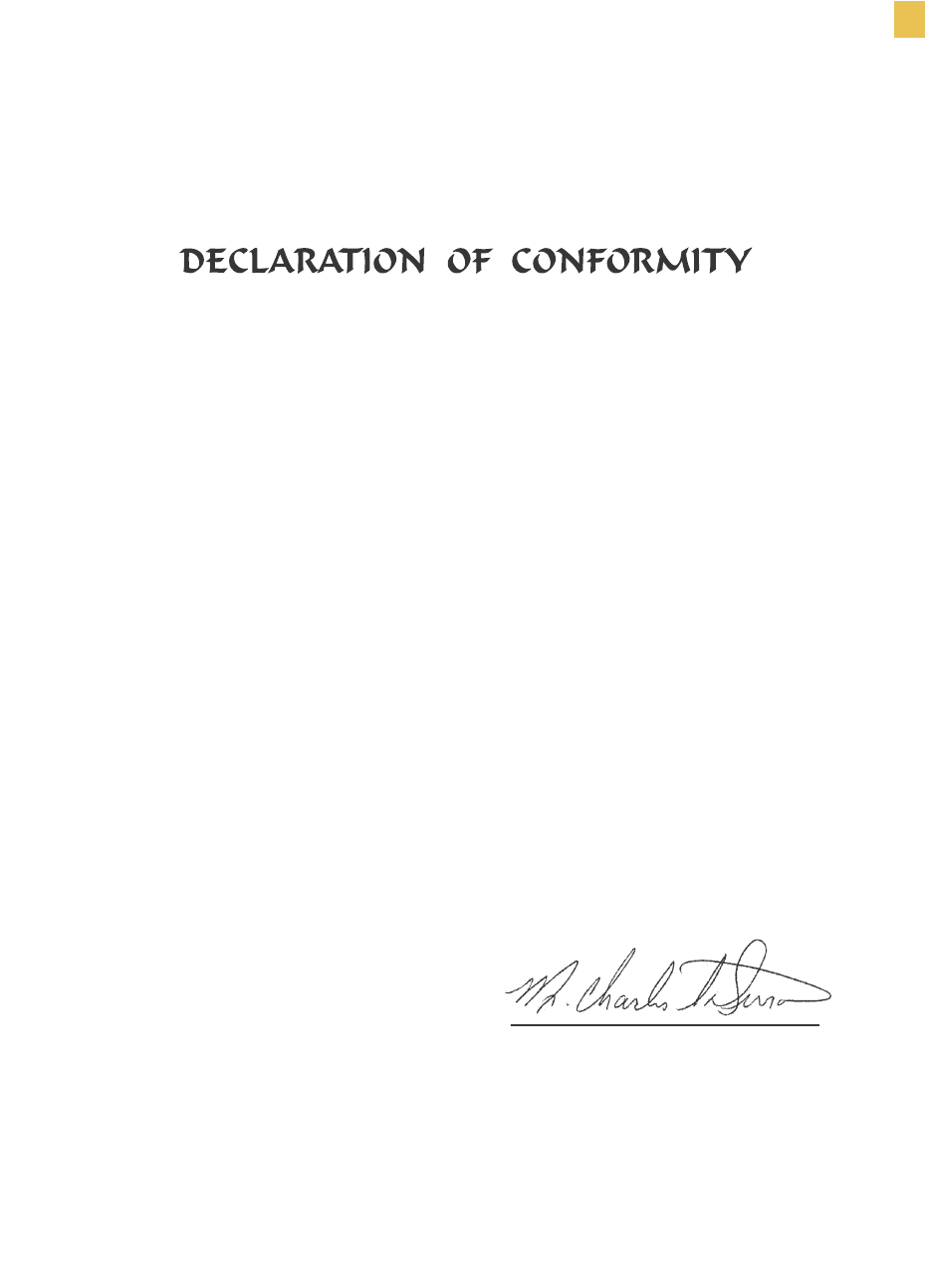
R110/R170XiIIIPlus User Guide vii
I have determined that the Zebra printers identified as the
manufactured by:
Have been shown to comply with the applicable technical standards of the FCC
If no unauthorized changed is made in the equipment,
and if the equipment is properly maintained and operated.
Xi Plus
Xi Plus, Xi Plus, Xi Plus,
Xi Plus, Xi Plus, Xi Plus
III Series
90 III 96 III 110 III
140 III 170 III 220 III
333 Corporate Woods Parkway
Vernon Hills, Illinois 60061-3109 U.S.A.
For Home, Office, Commercial, and industrial use
Zebra Technologies
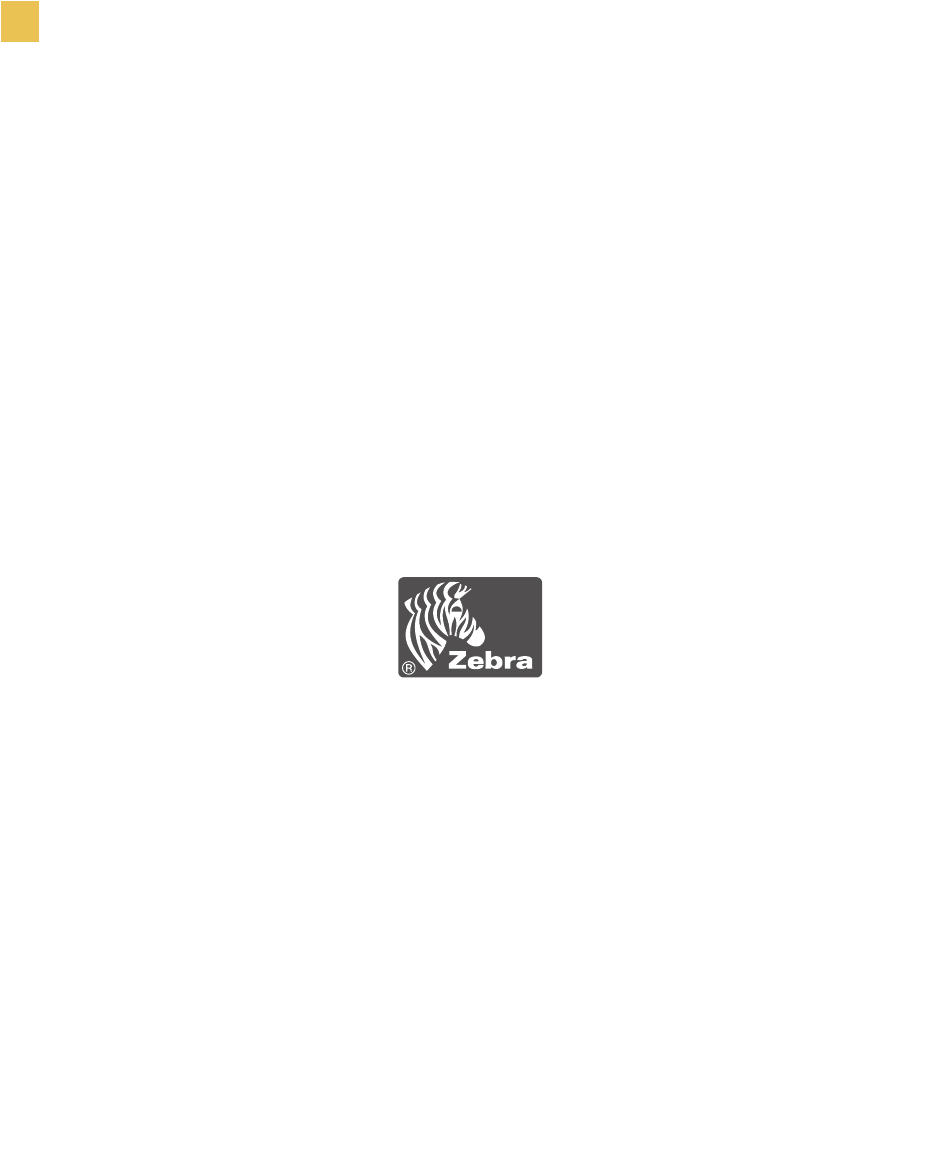
viii R110/R170XiIIIPlus User Guide

R110/R170XiIIIPlus User Guide ix
Warranty Information
Effective December 30, 2002
All new Zebra products are warranted by the manufacturer to be free from defect in material
and workmanship.
Printers and Related Hardware Products
Proof of purchase or shipment date is required to validate the warranty period. The warranty
becomes void if the equipment is modified, improperly installed or used, damaged by accident
or neglect, or if any parts are improperly installed or replaced by the user.
Products returned must be packaged in the original or comparable packing and shipping
container. In the event equipment is not so packaged, or if shipping damage is evident, it will
not be accepted for service under warranty. Surface transportation charges for return to
customers in the continental United States is paid by Zebra. Otherwise, Zebra pays CPT
(carriage paid to) nearest airport; customer pays customs, duties, taxes, and freight from
airport to destination. If Zebra determines that the product returned for warranty service or
replacement is not defective as herein defined, the customer will pay all handling and
transportation costs.
Printers
All printers (excluding printheads) are warranted against defect in material or workmanship
for twelve (12) months from the purchase date.
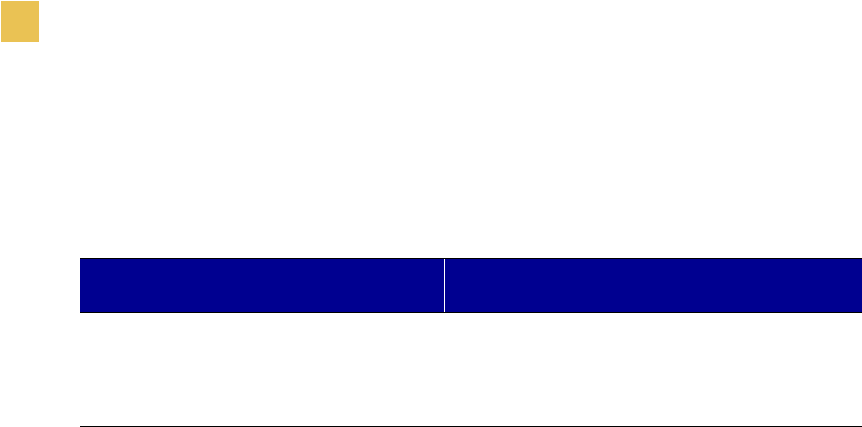
x R110/R170XiIIIPlus User Guide
Warranty Information
Printheads
Since printhead wear is part of normal operation, the original printhead is covered by a limited
warranty as indicated below. Warranty period begins on purchase date.
To qualify for this warranty, the printhead must be returned to the factory or to an authorized
service center. Customers are not required to purchase Genuine Zebra Supplies (media and/or
ribbons) for warranty qualification.
However, if it is determined that the use of inappropriate or inferior supplies has caused any
defect in the printhead for which a warranty claim is made, the user is responsible for Zebra’s
labor and material charges required to repair the defect. The warranty becomes void if the
printhead is physically worn or damaged; also if it is determined that failure to follow the
preventive maintenance schedule listed in the User Guide has caused defect in the thermal
printhead for which a warranty claim is made.
Printhead Warranty Period
Bar code label and receipt printer
printheads
6 months
Plastic card printer printheads 12 months
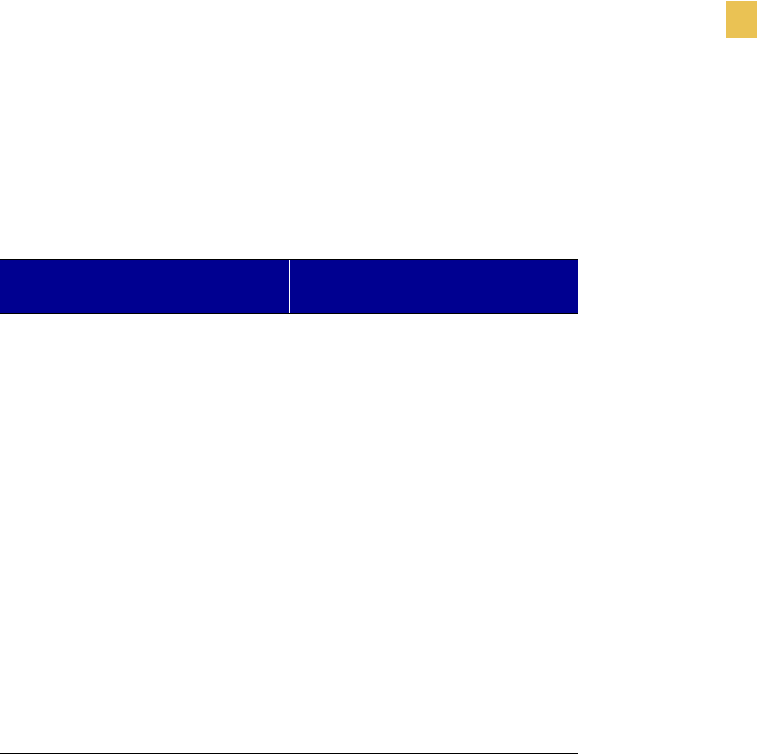
Warranty Information
R110/R170XiIIIPlus User Guide xi
Related Hardware Items
Products are warranted to be free of defects in material and workmanship from the date of
purchase according to this chart:
Defective product must be returned to Zebra for evaluation. In the event of notification of
defect within the warranty period, Zebra will replace the defective item provided there had not
been damage resulting from user abuse, modification, improper installation or use, or damage
in shipping or by accident or neglect.
Supplies Products
Supplies are warranted to be free from defect in material and workmanship for a period of
six (6) months for media and twelve (12) months for ribbon from the date of shipment by
Zebra. This is provided the user has complied with storage guidelines, handling, and usage of
the supplies in Zebra printers.
Zebra’s sole obligation under these warranties is to furnish parts and labor for the repair or
possible replacement of products found to be defective in material or workmanship during the
warranty period. Zebra may in its discretion issue a credit for any such defective products in
such amount as it deems reasonable.
Product Warranty Period
Accessories 1 month
Batteries 3 months
Cables 1 month
Chargers/Power Supplies 1 year
Hardware Keys 1 year
Keyboard Display Units 6 months
Parts 3 months
Pocket Eye®1 year
Software 1 month
ZebraNet® Print Servers 3 years

xii R110/R170XiIIIPlus User Guide
Warranty Information
Repair Services
Zebra repairs are warranted against defects in material and workmanship for 90 days from the
date of repair by Zebra. This excludes printheads, which are warranted separately. This
warranty does not cover normal wear and tear. This warranty becomes void if the item is
modified, improperly installed or used, or damaged by accident, neglect, or abuse.
Warranty Exclusions & Conditions Statement
The warranties given above are the only warranties given to you. No other warranties, express
or implied, are given. Zebra does not make any implied warranty of merchantability or fitness
for a particular purpose in connection with its sale of products or services. While Zebra’s
desire is to be responsive to your specific needs and questions, Zebra does not assume
responsibility for any specific application to which any Products are applied, including, but
not limited to, compatibility with other equipment. All statements, technical information, or
recommendations relating to Zebra Products are based on tests believed to be reliable, but do
not constitute a guaranty or warranty.
Zebra’s maximum liability for warranty claims is limited to the invoice price of the Product
claimed defective. Zebra does not assume responsibility for delays in replacement or repair of
products. Zebra shall not under any circumstances whatsoever be liable to you or any other
party for loss or profits, lost data, diminution of goodwill, or any other special or consequential
damages whatsoever with respect to any warranty claim made by you. Specifically for
software, Zebra is not liable for any incidental or consequential damages caused by abuse or
misapplication of the software or by its use in violation of the U.S. copyright law or
international treaty. No salesperson, representative, or agent of Zebra is authorized to make
any guaranty, warranty, or representation that contradicts the foregoing. Any waiver,
alteration, addition, or modification to the foregoing warranties must be in writing and signed
by an executive officer of Zebra to be valid.
Zebra Technologies
333 Corporate Woods Parkway
Vernon Hills, IL 60061-3109 U.S.A.
Phone +1 847.634.6700 or +1 800.423.0442
Fax + 1 847.913.8766 www.zebra.com

R110/R170XiIIIPlus User Guide xix
Preface
This section provides you with contact information, document structure and organization, and
additional reference documents.
Contents
Contacts . . . . . . . . . . . . . . . . . . . . . . . . . . . . . . . . . . . . . . . . . . xx
Support . . . . . . . . . . . . . . . . . . . . . . . . . . . . . . . . . . . . . . . . . xx
About this Document . . . . . . . . . . . . . . . . . . . . . . . . . . . . . . . . . xxi
Document Conventions . . . . . . . . . . . . . . . . . . . . . . . . . . . . . . xxii
Related Documents. . . . . . . . . . . . . . . . . . . . . . . . . . . . . . . . . xxiv

xx R110/R170XiIIIPlus User Guide
Preface
Contacts
Contacts
You can contact Zebra Corporation at any of the following:
Visit us at: http://www.zebra.com
Our Mailing Addresses:
Zebra Technologies Corporation
333 Corporate Woods Parkway
Vernon Hills, Illinois 60061.3109 U.S.A
Telephone: +1 847.634.6700
Fax: +1 847.913.8766
Zebra Technologies Europe Limited
Zebra House
The Valley Centre, Gordon Road
High Wycombe
Buckinghamshire HP13 6EQ, UK
Telephone: +44 (0)1494 472872
Fax: +44 (0)1494 450103
Support
You can contact Zebra support at:
Web Address: www.zebra.com/SS/service_support.htm
US Phone Number +1 847.913.2259
UK/International Phone Number +44 (0) 1494 768289
Important • The Web address is case-sensitive. The SS must be all caps.
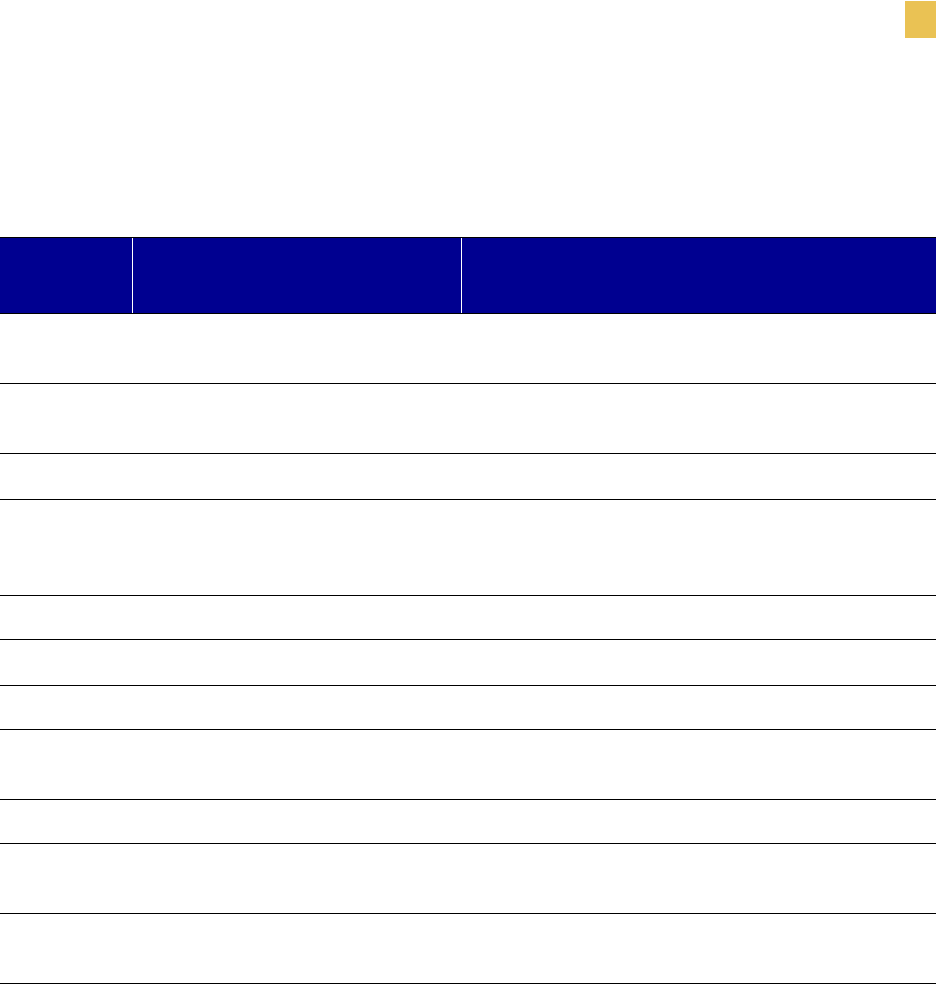
Preface
About this Document
R110/R170XiIIIPlus User Guide xxi
About this Document
The Zebra XiIIIPlus User Guide contains the following chapters and appendices:
Chapter
Number
Title Content
Warranty Information Warranty information on Zebra printers, related
hardware, and supplies.
1Introduction Printer overview, printer components, types of
labels, and system considerations.
2Printer Setup Instructions for setting up your printer.
3Printer Operation Instructions for loading media, loading and
removing ribbon, calibrating the printer, adjusting
sensors, and adjusting the printhead.
4Print Modes Descriptions of the available print options.
5Data Ports Standard data ports available on the printer.
6Memory Cards PCMCIA and CompactFlash card options available.
7Configuration How to adjust printer settings to fit your printing
needs.
8Routine Maintenance Routine cleaning and maintenance procedures.
9Troubleshooting Common printing problems and recommended
solutions.
ASpecifications Printer specifications, such as operating
temperatures and power requirements.
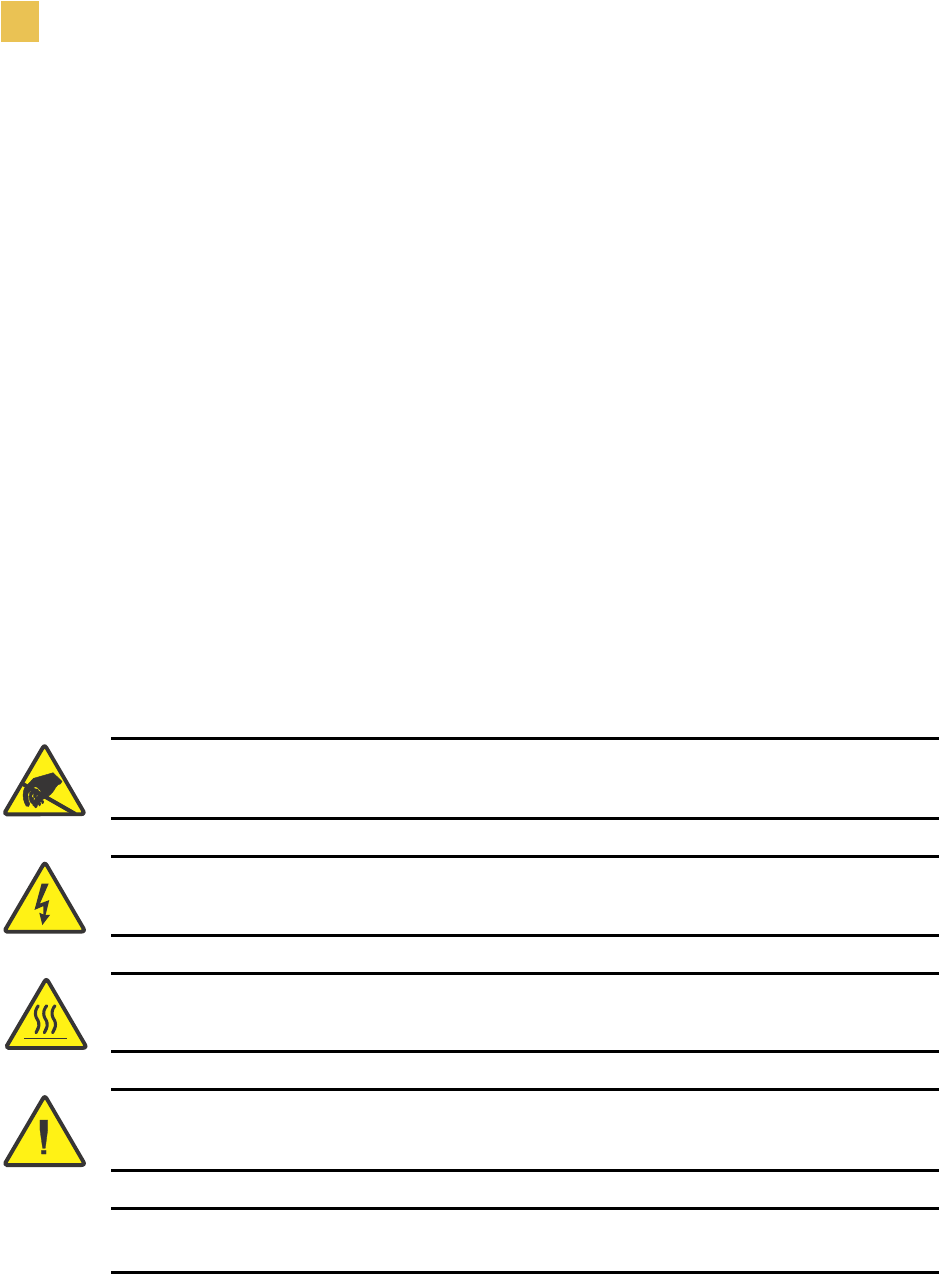
xxii R110/R170XiIIIPlus User Guide
Preface
Document Conventions
Document Conventions
The following conventions are used throughout this document to convey certain information:
About this Chapter Sections This section includes a brief overview of and a table of
contents for the chapter. These sections primarily serve as hyperlink components for the
Adobe Acrobat.pdf version of this guide.
Alternate Color (online only) Cross-references contain hot links to other sections in this
guide. If you are viewing this guide online in .pdf format, you can click the cross-reference
(blue text) to jump directly to its location.
Command Line Examples All command line examples appear in Courier New font.
For example, you would type the following to get to the Post-Install scripts in the bin
directory:
Ztools
Files and Directories All file names and directories appear in Courier New font. For
example, the Zebra<version number>.tar file and the /root directory.
Cautions, Important, Note, and Example
Electrostatic Discharge Caution • Warns you of the potential for electrostatic discharge.
Electric Shock Caution • Warns you of a potential electric shock situation.
Caution • Warns you of a situation where excessive heat could cause a burn.
Caution • Advises you that failure to take or avoid a specific action could result in physical
harm to you.
Caution • Advises you that failure to take or avoid a specific action could result in physical
harm to the hardware.
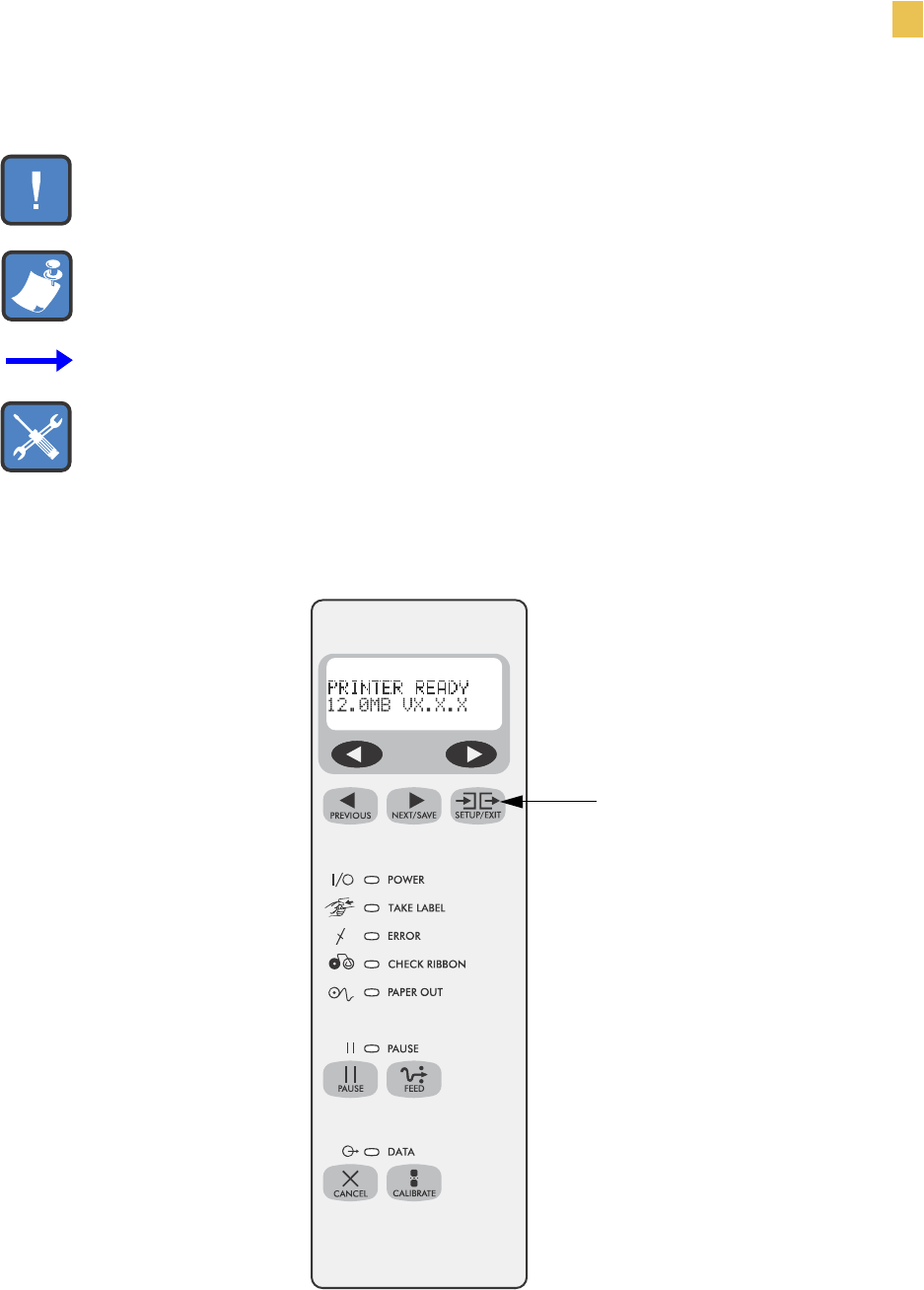
Preface
Document Conventions
R110/R170XiIIIPlus User Guide xxiii
Illustration Callouts Callouts are used when an illustration contains information that needs
to be labeled and described. A table that contains the labels and descriptions follows the
graphic. The following illustration and table provide an example.
Important • Advises you of information that is essential to complete a task.
Note • Indicates neutral or positive information that emphasizes or supplements important
points of the main text.
Example • Provides an example, often a scenario, to better clarify a section of text.
Tools • Tells you what tools you need to complete a given task.
1

xxiv R110/R170XiIIIPlus User Guide
Preface
Related Documents
Related Documents
In addition to this user guide, the following documents might be helpful references:
•ZPL II® Programming Guide Volume I (part number 45541L) and Vo lum e II (part
number 45542L).
•PrintServer II™ Installation and User Guide (part number 45537L).
•Maintenance Manual (part number 13185L for the 110XiIIIPlus, part number 48152L for
all other XiIIIPlus printers).
1SETUP/EXIT button

R110/R170XiIIIPlus User Guide 1
CHAPTER 1
Introduction
This chapter provides a high-level overview of the printer and its components.
Contents
Exterior View . . . . . . . . . . . . . . . . . . . . . . . . . . . . . . . . . . . . . . . . 2
Front Panel . . . . . . . . . . . . . . . . . . . . . . . . . . . . . . . . . . . . . . . . . 3
Front Panel Buttons. . . . . . . . . . . . . . . . . . . . . . . . . . . . . . . . . 4
Front Panel Lights . . . . . . . . . . . . . . . . . . . . . . . . . . . . . . . . . . 5
Printer Components . . . . . . . . . . . . . . . . . . . . . . . . . . . . . . . . . . 6
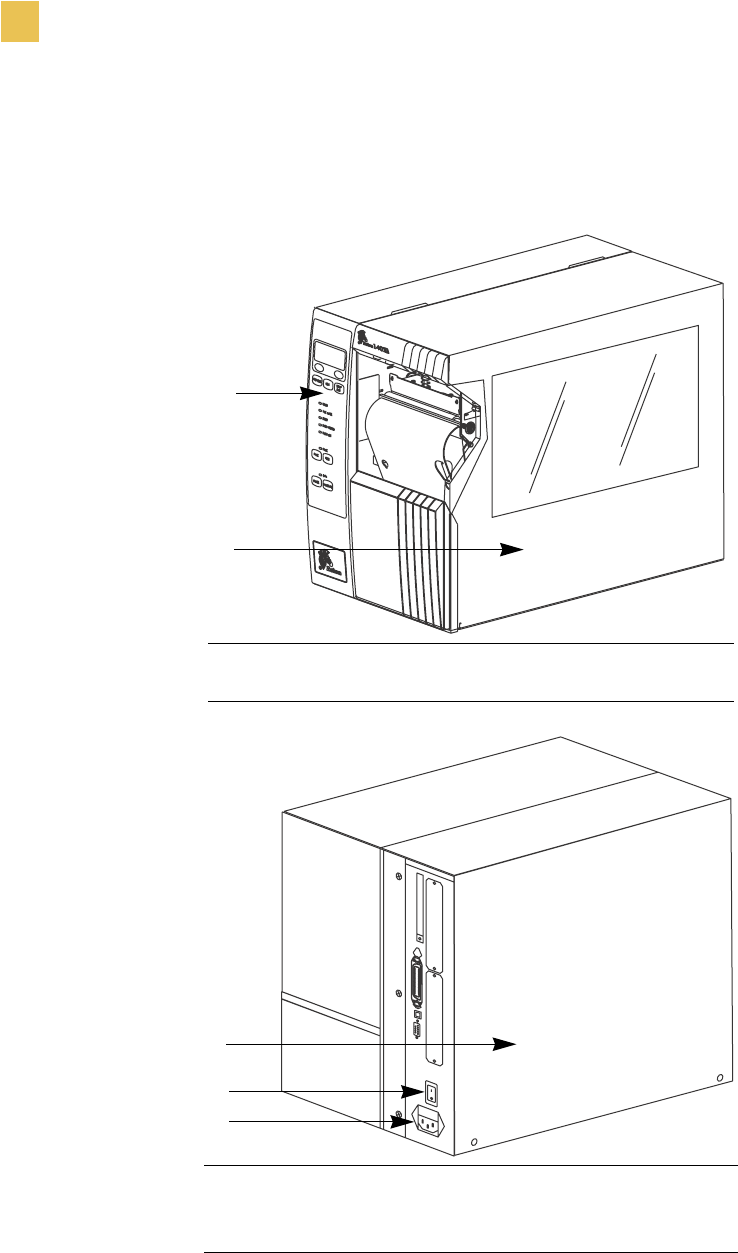
2 R110/R170XiIIIPlus User Guide
Introduction
Exterior View
Exterior View
The following illustrations show the exterior of the printer.
1Front panel
2Media door
1Electronics cover
2Power switch
3AC power cord connection
1
2
2
1
3
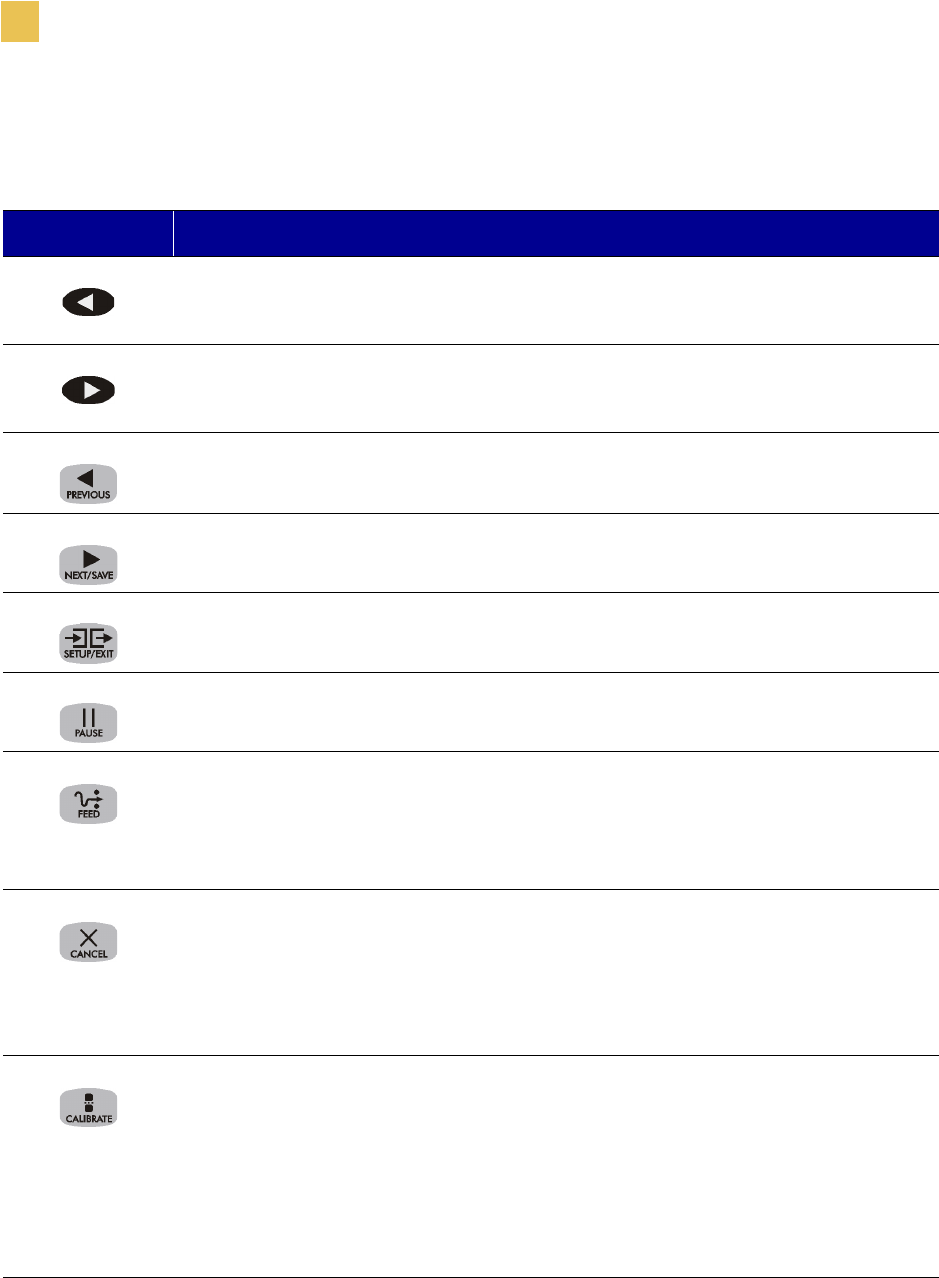
4 R110/R170XiIIIPlus User Guide
Introduction
Front Panel
Front Panel Buttons
This table describes the function of the buttons shown in the illustration on page 2.
Button Details
LEFT OVAL Changes parameter values. Common uses are to increase/decrease a value, answer
yes or no, indicate on or off, scroll through several choices, input the password, or
set up the printer for a firmware download.
RIGHT OVAL Changes parameter values. Common uses are to increase/decrease a value, answer
yes or no, indicate on or off, scroll through several choices, input the password, or
set up the printer for a firmware download.
PREVIOUS Scrolls to the previous parameter. Press and hold this button to scroll back quickly
through parameter sets.
NEXT/SAVE Scrolls to the next parameter. Press and hold this button to scroll forward quickly
through parameter sets.
SETUP/EXIT Enters and exits the setup mode.
PAUSE Starts and stops the printing process and allows other buttons to be used. If an error
messages is on the LCD, pressing this button removes the error.
FEED Forces the printer to feed a blank label each time the button is pressed.
• If the printer is not printing, one blank label immediately feeds.
• If the printer is printing, one blank label feeds after the current batch of
labels is complete.
CANCEL In the pause mode, this button cancels print jobs.
• If there are multiple print jobs in the print queue, press CANCEL once for
each print job to be deleted.
• To delete all print jobs, hold CANCEL for several seconds. The DATA light
turns off.
CALIBRATE This button can be used to calibrate the printer for the following:
• Media length
• Media type (continuous or non-continuous)
• Print mode (direct thermal or thermal transfer)
• Sensor values
For more information on calibration, see Calibrate the Printer on page 31.
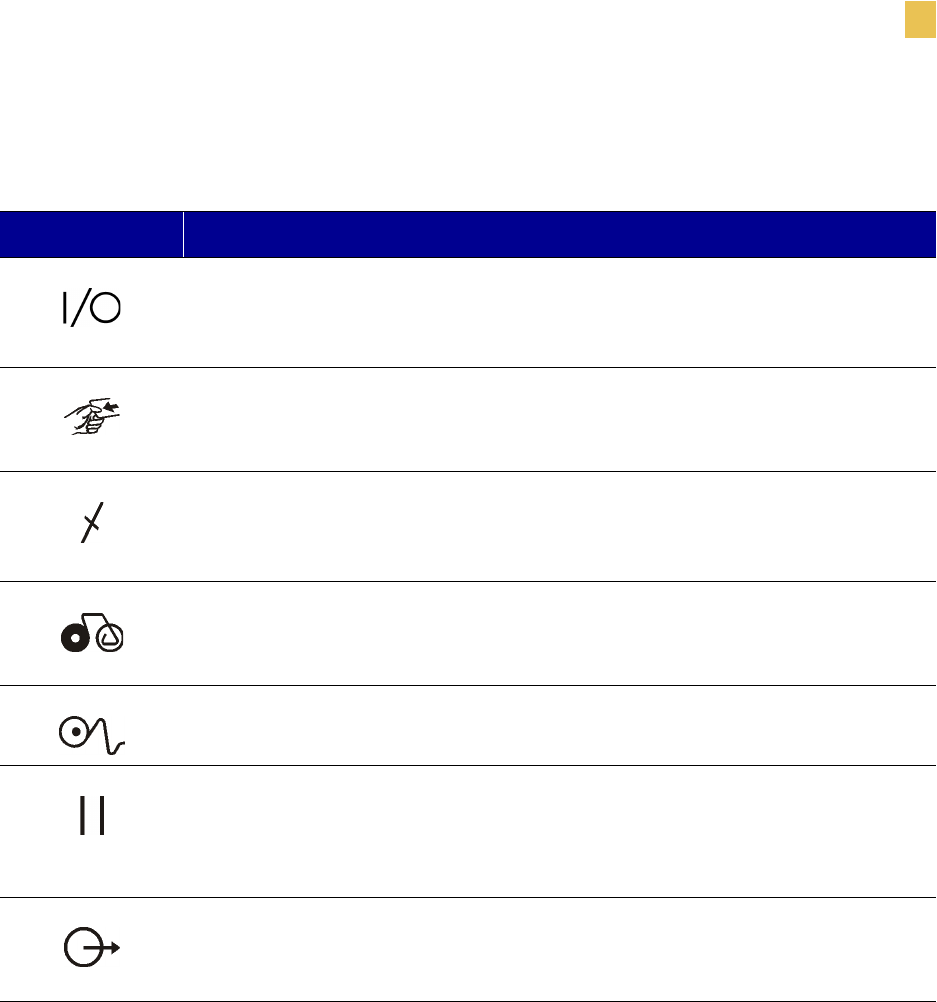
Introduction
Front Panel
R110/R170XiIIIPlus User Guide 5
Front Panel Lights
This table details the lights shown in the illustration on page 2.
Light Details
POWER Indicates printer power status.
• Off — printer is off.
• On — printer is on.
TAKE LABEL • Off — Normal operation.
• Flashing — (Peel-Off Mode only.) The label is available. Printing is
paused until the label is removed.
ERROR Indicates printer operation.
• Off — printer is in Normal operation.
• Flashing — printer pauses until the label is removed.
CHECK RIBBON • Off — Normal operation; ribbon (if used) is properly loaded.
• On — No media is under the label sensor. Printing is paused, the LCD
shows an error message, and the PAUSE light is on.
PAPER OUT Indicates that labels need to be reloaded.
PAUSE • Off — normal operation.
• On — all printing operations have stopped. Either PAUSE was pressed, a
pause command was included in the label format, the on-line verifier
detected an error, or a printer error was detected.
DATA • Off — Normal operation. No data being received or processed.
• On/Blinking — Data processing or printing is taking place. Data is being
received.
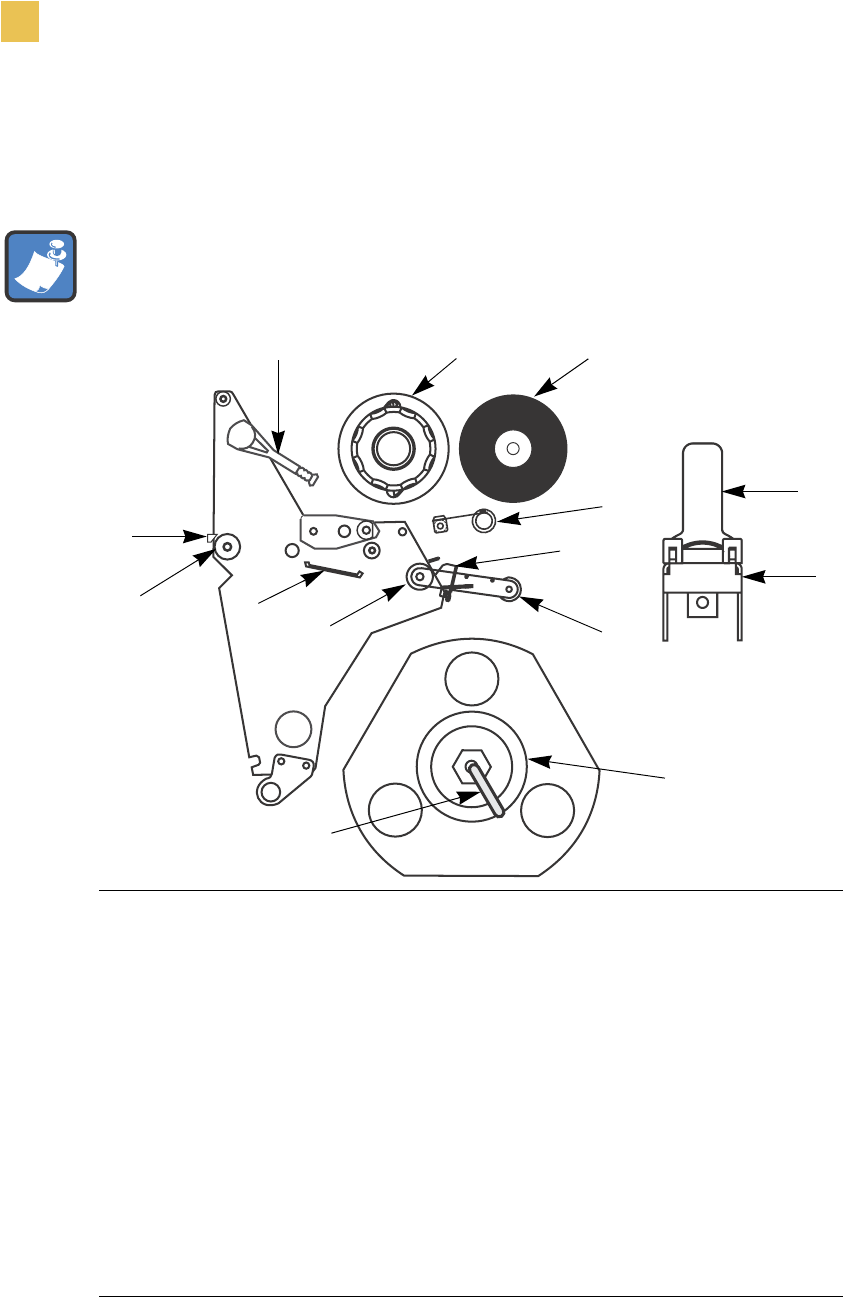
6 R110/R170XiIIIPlus User Guide
Introduction
Printer Components
Printer Components
This illustration shows a side view of the printer’s internal components.
Note • Depending on the printer options that you selected, your printer could look slightly
different. For more about printer options, go to www.zebra.com.
1Printhead lever
2Ribbon take-up spindle
3Ribbon supply spindle
4Ribbon dancer assembly (only on select models)
5Media guide
6Media dancer roller assembly
7Media supply guide
8Media supply hanger
9Rewind spindle (optional)
10 Spindle hook
11 Lower roller
12 Snap plate
13 Platen roller
14 Tear-off bar
123
47
8
6
9
10
14
13 12
11
5

R110/R170XiIIIPlus User Guide 7
CHAPTER 2
Printer Setup
This chapter provides the tasks that you must complete and the issues that you must consider
before you load and configure your printer.
Contents
Before You Begin . . . . . . . . . . . . . . . . . . . . . . . . . . . . . . . . . . . . 8
Unpack and Inspect the Printer. . . . . . . . . . . . . . . . . . . . . . . . . . 9
Report Shipping Damage . . . . . . . . . . . . . . . . . . . . . . . . . . . . 9
Store or Reship the Printer . . . . . . . . . . . . . . . . . . . . . . . . . . . 9
Select a Site for the Printer . . . . . . . . . . . . . . . . . . . . . . . . . . . . 10
Select a Surface . . . . . . . . . . . . . . . . . . . . . . . . . . . . . . . . . . 10
Provide Proper Operating Conditions . . . . . . . . . . . . . . . . . . 10
Allow Proper Space . . . . . . . . . . . . . . . . . . . . . . . . . . . . . . . . 10
Provide a Data Source . . . . . . . . . . . . . . . . . . . . . . . . . . . . . 10
Connect the Printer to a Power Source. . . . . . . . . . . . . . . . . . . 11
Power Cord . . . . . . . . . . . . . . . . . . . . . . . . . . . . . . . . . . . . . . 11
Communication Interfaces. . . . . . . . . . . . . . . . . . . . . . . . . . . . . 13
Data Cable Requirements . . . . . . . . . . . . . . . . . . . . . . . . . . . 14
Types of Media . . . . . . . . . . . . . . . . . . . . . . . . . . . . . . . . . . . . . 15
Continuous Media . . . . . . . . . . . . . . . . . . . . . . . . . . . . . . . . . 15
Non-Continuous Black Mark Media. . . . . . . . . . . . . . . . . . . . 15
Non-Continuous Web Media . . . . . . . . . . . . . . . . . . . . . . . . . 16
Ribbon. . . . . . . . . . . . . . . . . . . . . . . . . . . . . . . . . . . . . . . . . . . . 18

8 R110/R170XiIIIPlus User Guide
Printer Setup
Before You Begin
Before You Begin
Review this checklist, and resolve any issues before you begin setting up your printer. When
you are ready, continue with Printer Operation on page 19.
Unpack and Inspect Have you unpacked the printer and inspected it for damage? If
you have not, see Unpack and Inspect the Printer on page 9.
Select a Site Have you selected an appropriate location for the printer? If you have not,
see Select a Site for the Printer on page 10.
Attach Power Cord Do you have the correct power cord for your printer? If you are
unsure, see Power Cord on page 11. To attach the power cord and connect the printer to a
power source, see Connect the Printer to a Power Source on page 11.
Connect to a Data Source Have you determined how the printer will be connected to
a data source (usually a computer)? For more information, see Communication Interfaces
on page 13.
Select Media Do you have the correct media for your application? If you are unsure,
see Types of Media on page 15.
Select Ribbon Do you need to use ribbon, and is the appropriate ribbon available, if
needed? If you are unsure, see Ribbon on page 18.

Printer Setup
Unpack and Inspect the Printer
R110/R170XiIIIPlus User Guide 9
Unpack and Inspect the Printer
When you unpack the printer, save all packing materials. When the printer is out of the box,
raise the printer’s media door, and remove the power cord.
Inspect the printer for possible damage incurred during shipment. Check all exterior surfaces
for damage. Raise the media door, and inspect the media compartment for damage to
components.
Report Shipping Damage
If you discover shipping damage upon inspection:
• Immediately notify the shipping company of the damage, and file a damage report with
them. Zebra is not responsible for any damage incurred during shipment of the equipment
and does not repair this damage under warranty.
• Keep all packaging material for shipping company inspection.
• Notify your authorized Zebra reseller.
Store or Reship the Printer
If you are not placing the printer into immediate operation, repackage it using the original
packing materials. You may store the printer under the following conditions:
• Temperature: –40° to 140°F (–40° to 60°C)
• Relative humidity: 5% to 85% non-condensing
If you must ship the printer, remove any ribbon and media from the supply spools to avoid
damaging the printer. Carefully pack the printer into the original container or a suitable
alternate container to avoid damage during transit.
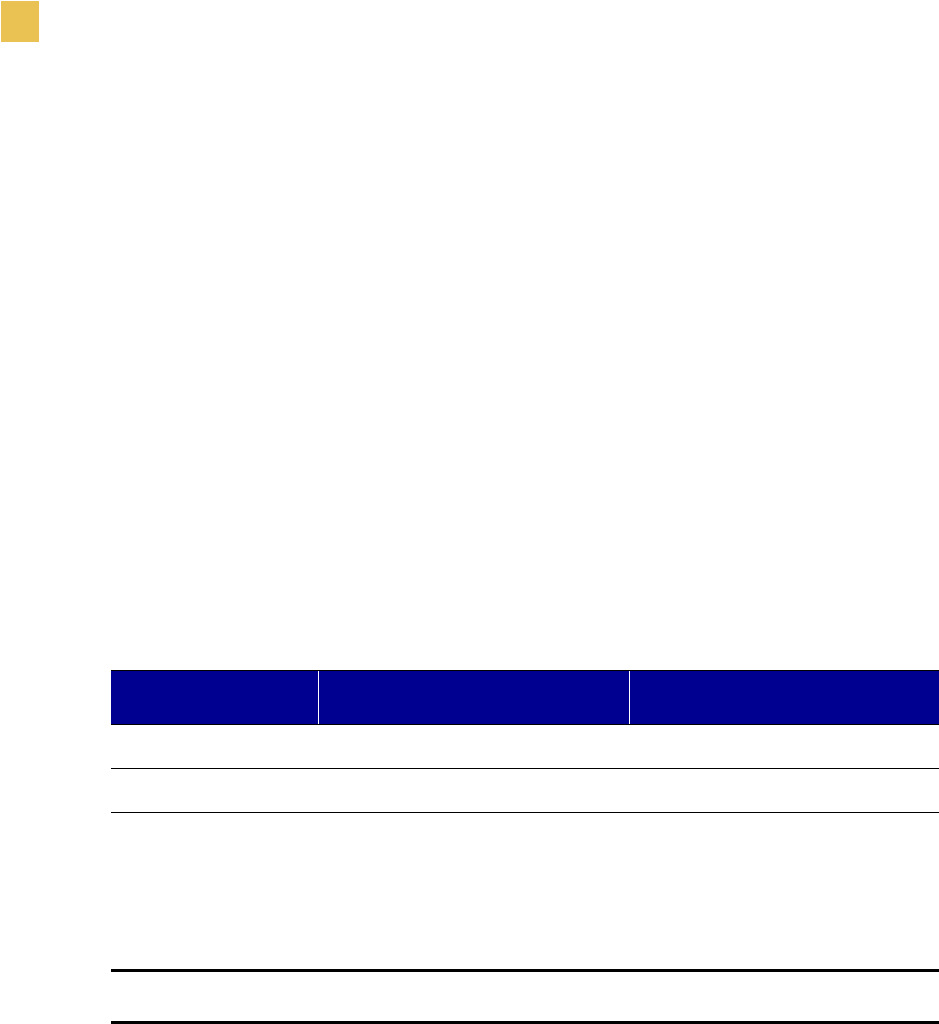
10 R110/R170XiIIIPlus User Guide
Printer Setup
Select a Site for the Printer
Select a Site for the Printer
Consider the following when selecting an appropriate location for your printer.
Select a Surface
Select a solid, level surface of sufficient size and strength to accommodate the printer and
other equipment (such as a computer), if necessary. The choices include a table, countertop,
desk, or cart.
Provide Proper Operating Conditions
Because the printer was designed and is fabricated as an industrial-type unit, it functions
satisfactorily in a location that conforms to specified environmental and electrical conditions,
including a warehouse or factory floor. For more information on the required conditions, see
General Specifications on page 131.
The following table shows the temperature and relative humidity requirements for the printer
when it is operating.
Allow Proper Space
The printer should have enough space around it for you to be able to open the media door. To
allow for proper ventilation and cooling, leave open space on all sides of the printer.
Provide a Data Source
If the printer will be located away from the data source, the selected site must provide the
appropriate connections to that data source. For more information on the types of
communication interfaces, see Communication Interfaces on page 13.
Mode Temperature Relative Humidity
Thermal Transfer 41° to 104°F (5° to 40°C) 20 to 85% non-condensing
Direct Thermal 32° to 104°F (0° to 40°C) 20 to 85% non-condensing
Caution • Do not place any padding or cushioning material behind or under the printer
because this restricts air flow and could cause the printer to overheat.
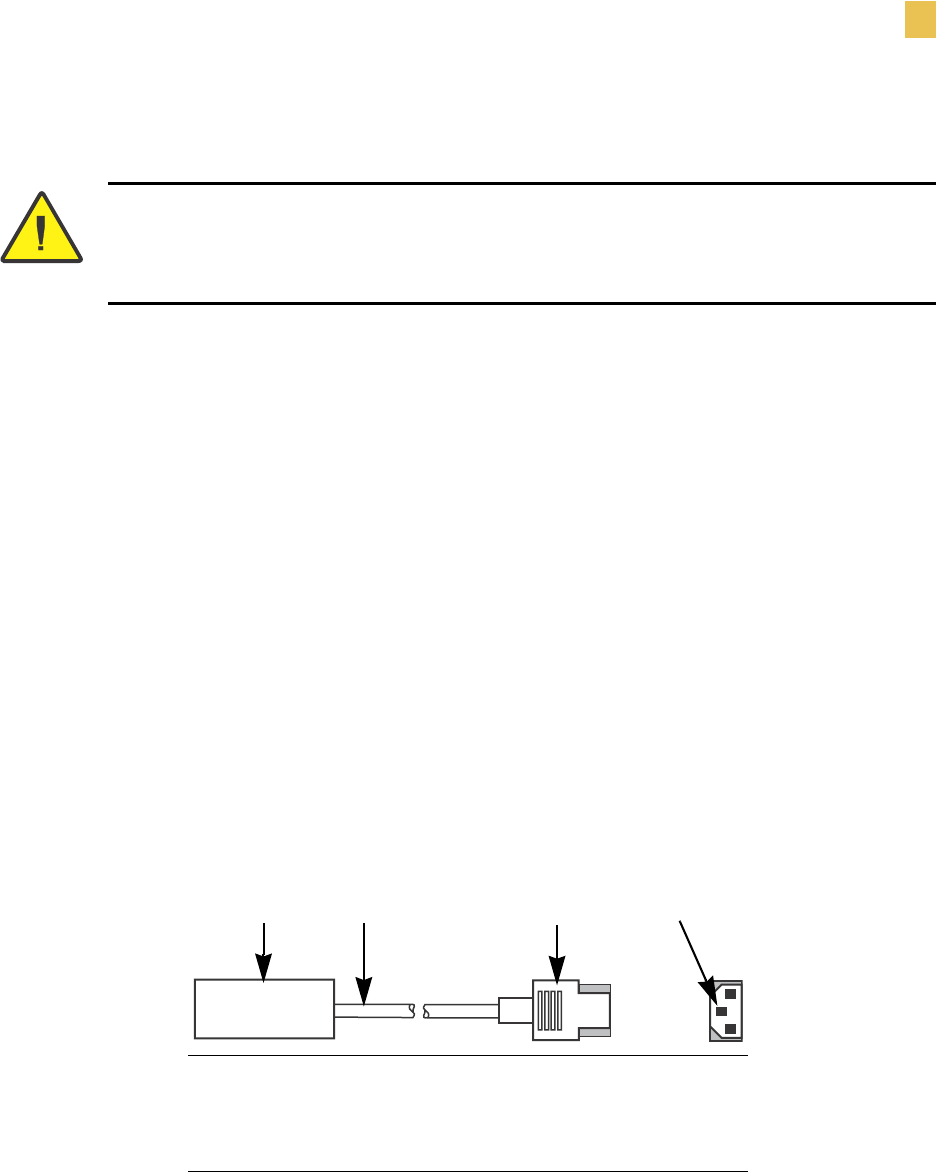
Printer Setup
Connect the Printer to a Power Source
R110/R170XiIIIPlus User Guide 11
Connect the Printer to a Power Source
To connect the printer to a power source, complete these steps:
1. Turn the printer power switch (located on the rear of the printer) to the Off (O) position.
2. Plug the power cord into the mating connector on the rear of the printer.
3. Plug the other end of the power cord into the power source.
Power Cord
Depending on how your printer was ordered, a power cord may or may not be included. If one
is not included or if the one included is not suitable for your requirements, refer to the
following guidelines.
Your power cord must meed these standards:
• The overall length must be less than 9.8 ft (3.0 m).
• It must be rated for at least 5 A, 250 V.
• The chassis ground (earth) must be connected to ensure safety and reduce electromagnetic
interference.
The ground connection is handled by the third wire (earth) in the power cord as
shown in the following illustration.
• The AC power plug and the IEC 320 connector must bear the certification mark of at least
one of the known international safety organizations shown in this illustration.
Caution • For personnel and equipment safety, always use an approved three-conductor
power cord specific to the region or country intended for installation. This cord must use an
IEC 320 female connector and the appropriate region-specific three-conductor grounded plug
configuration.
1AC power plug for your country
23-conductor HAR cable
3IEC 320 connector
4Neutral earth live in contact view
1 2 3 4
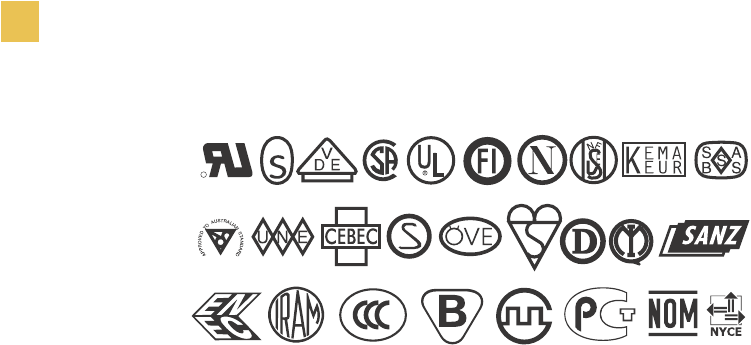
12 R110/R170XiIIIPlus User Guide
Printer Setup
Connect the Printer to a Power Source
+
R
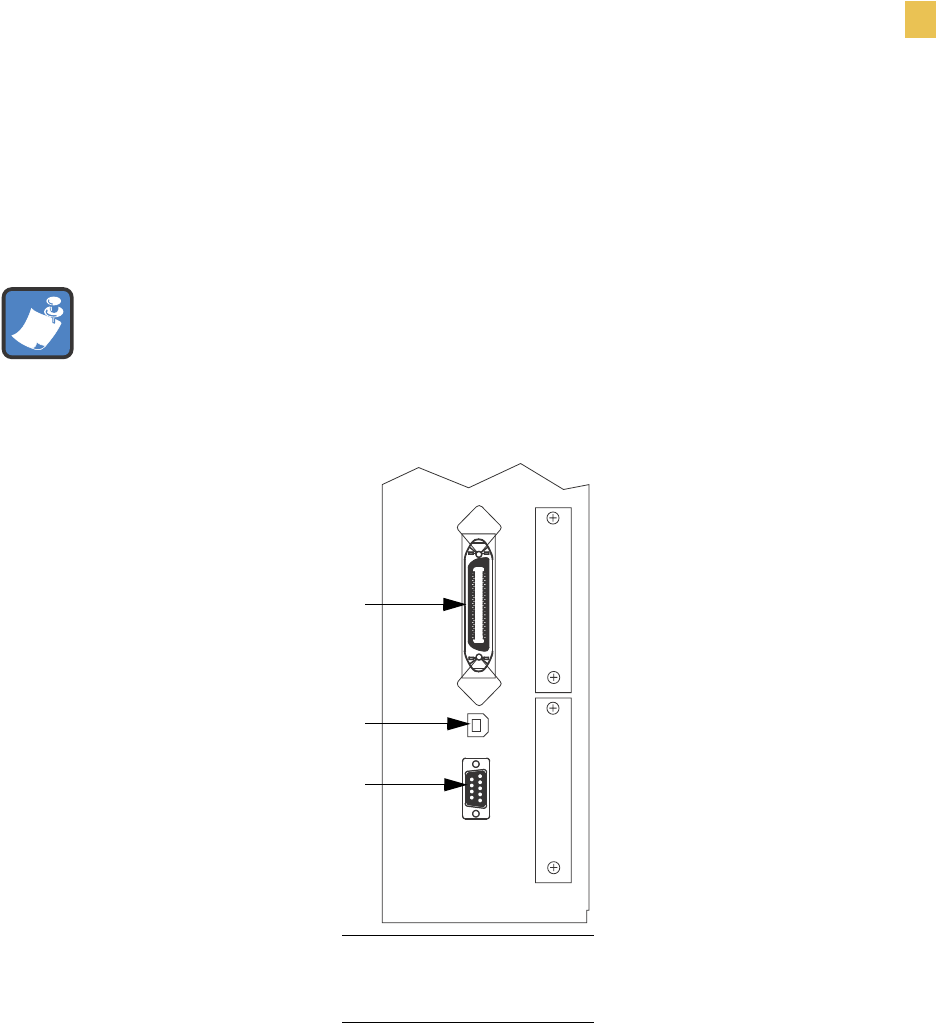
Printer Setup
Communication Interfaces
R110/R170XiIIIPlus User Guide 13
Communication Interfaces
The way that you connect your printer to a data source depends on the communication options
installed in the printer. The standard communication interfaces are an RS-232 serial data port,
a bi-directional parallel port, and a USB 2.0 port.
The following illustration shows the location of the communication interfaces on the back of
the printer. For more information about these interfaces, see Data Ports on page 53.
Other options for connecting your printer to a data source include the following:
• The optional ZebraNet®PrintServer II, which enables the printer to be connected to
10Base-T Ethernet networks.
• A wireless card socket option.
•The IBM
® Twinax or IBM® Coax option for those applications that require them.
Note • RS-422 and RS-485 serial data ports are available through an adapter. A DB-25 cable
and a USB 2.0 cable are also available.
1Parallel port
2Serial port
3USB 2.0 port
1
2
3

14 R110/R170XiIIIPlus User Guide
Printer Setup
Communication Interfaces
Data Cable Requirements
Data cables must be fully shielded and fitted with metal or metallized connector shells.
Shielded cables and connectors are required to prevent radiation and reception of electrical
noise.
To minimize electrical noise pickup in the cable:
• Keep data cables as short as possible.
• Do not bundle the data cables tightly with the power cords.
• Do not tie the data cables to power wire conduits.
Note • Zebra printers comply with FCC Rules and Regulations, Part 15 for Class B Equipment
using fully shielded, 6.5 ft (2 m) data cables. Use of unshielded cables may increase radiation
above the Class B limits.
Note • RS-422 and RS-485 applications should use twisted shielded pairs as recommended in
the TIA/EIA-485 Specification.
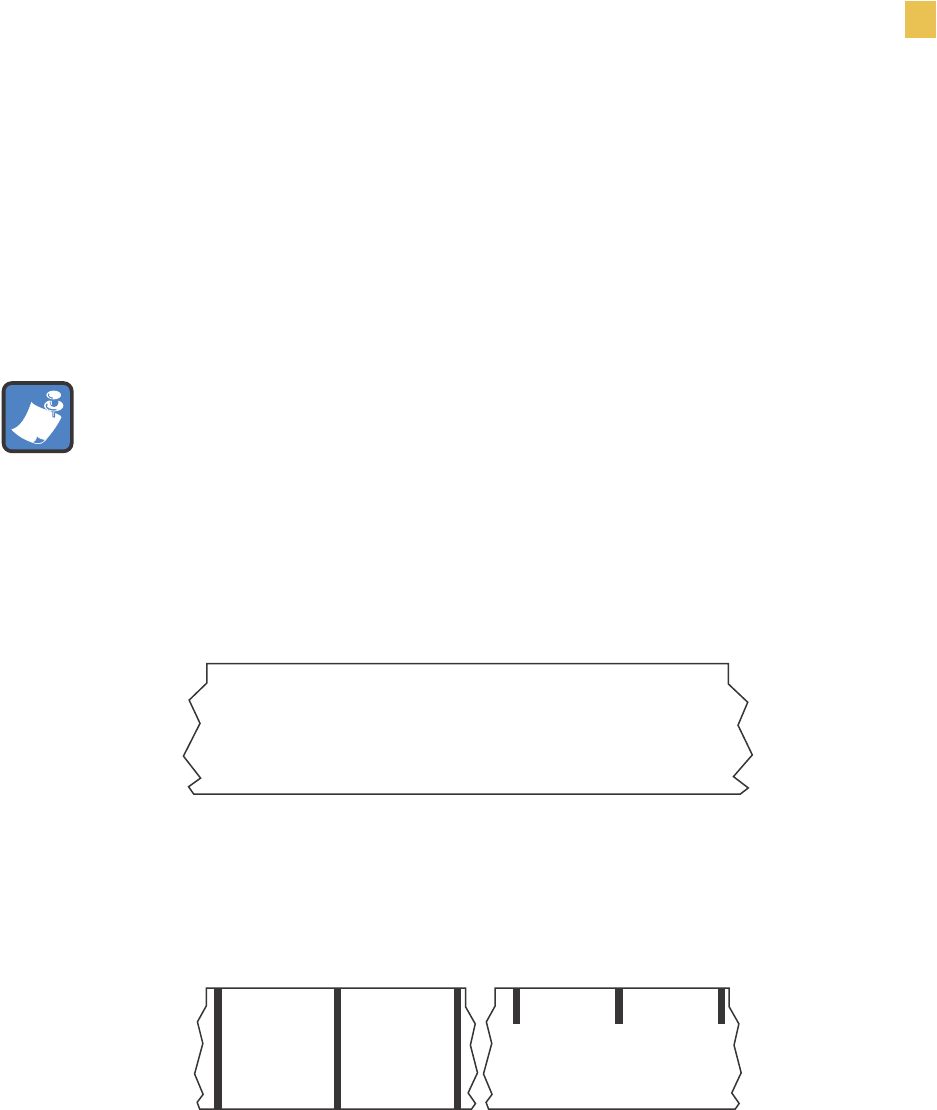
Printer Setup
Types of Media
R110/R170XiIIIPlus User Guide 15
Types of Media
The printer can use media that is on rolls or in fan-folded stacks. The difference between
media types is in whether the media is continuous or non-continuous.
We strongly recommend the use of Zebra-brand supplies for continuous high-quality printing.
A wide range of paper, polypropylene, polyester, and vinyl stock has been specifically
engineered to enhance the printing capabilities of the printer and to ensure against premature
printhead wear.
Continuous Media
Continuous media is one uninterrupted length of material that allows the image to be printed
anywhere on the label. The individual labels can be cut apart or stored in a roll for later use.
This illustration shows a sample of continuous media.
Non-Continuous Black Mark Media
Non-continuous black mark media has black marks printed on the back, which indicate the
start and end of each label. This illustration shows a sample of non-continuous black mark
media.
Note • Because print quality is affected by media and ribbon, printing speeds, and printer
operating modes, it is very important to run tests for your applications.
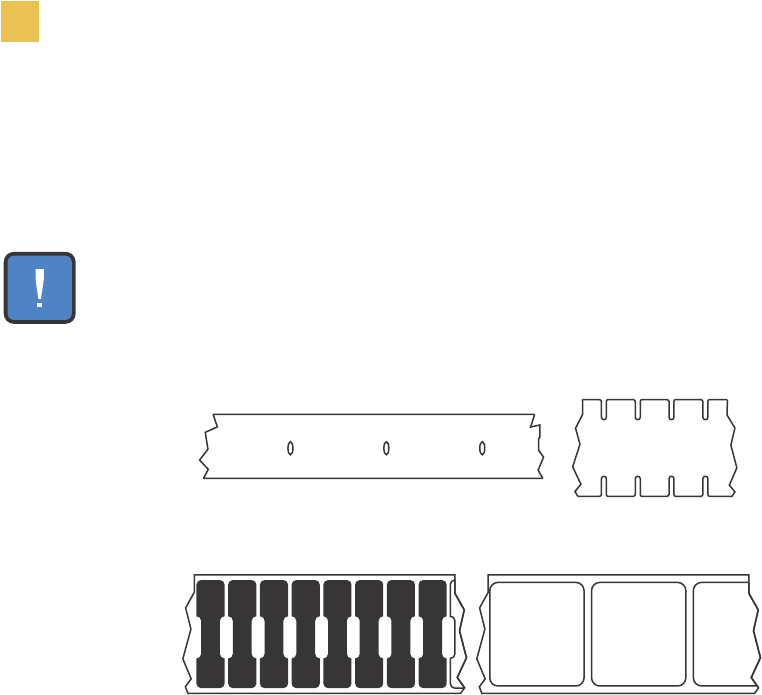
16 R110/R170XiIIIPlus User Guide
Printer Setup
Types of Media
Non-Continuous Web Media
Non-continuous web media refers to individual labels that are separated by a gap, notch, or
hole. When you look at the media, you can tell where one label ends and the next one begins.
This illustration shows samples of non-continuous web media.
Important • The life of the printhead may be reduced by abrasion from exposed paper
fibers when using perforated media.
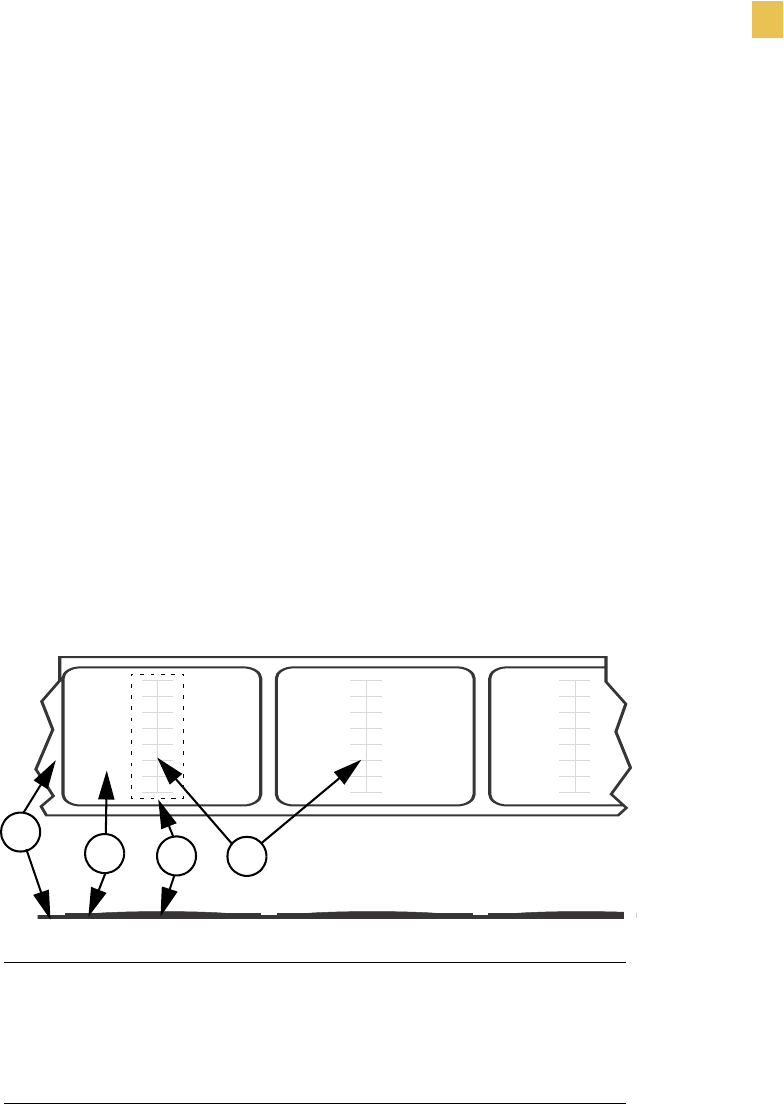
Printer Setup
Types of Media
R110/R170XiIIIPlus User Guide 17
RFID “Smart” Labels
“Smart” labels are usually made from two components: media and an embedded RFID
transponder (Figure 1). For more information about reading and encoding RFID tags, see
RFID Guidelines on page 69.
• The media (usually a label with a UHF transponder embedded between the label and liner)
is usually comprised of synthetic- or paper-based material that can be printed upon using
direct thermal or thermal transfer printing techniques. The media is typically made from
the same materials and adhesives that a non-RFID barcode printer would use.
• The UHF transponder, which is sometimes called the RFID tag, is usually comprised of an
antenna that is bonded to an integrated circuit (IC) chip. If you hold a “smart” label up to
the light, you can see the transponder’s antenna embedded within the label, and you can
feel a bump in the label where the IC chip is located.
The IC chip contains the RF circuit, coders, decoders, and memory. At a minimum,
“smart” labels have memory that can be read, while the vast majority also have memory
that can be encoded by the user as well. For more information about encoding “smart”
labels, see ZPL II Commands for RFID on page 81.
Figure 1 • RFID “Smart” Labels
1Liner
2Label
3Location of embedded transponder
4Outline of transponder antenna
(shape varies by manufacturer)
(label profile)
1234
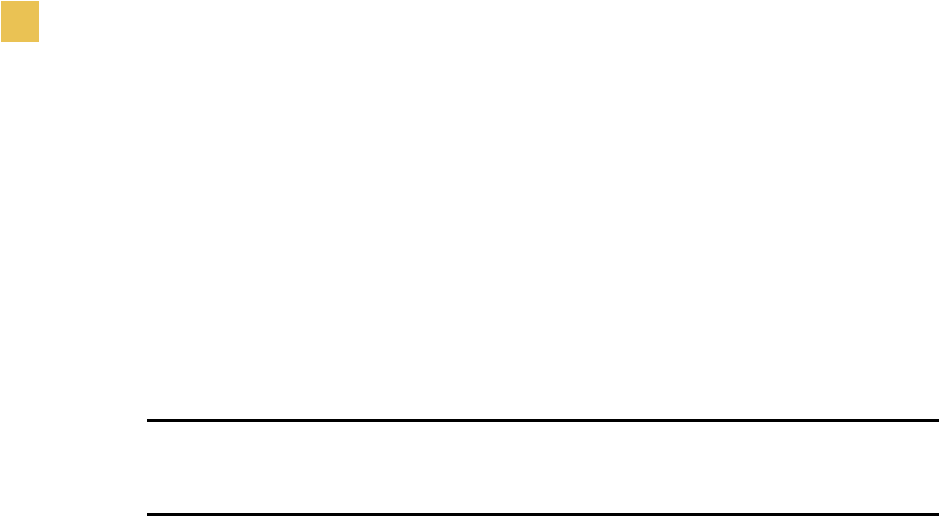
18 R110/R170XiIIIPlus User Guide
Printer Setup
Ribbon
Ribbon
Ribbon is a thin film carrying wax or wax resin that is transferred to the media during the
thermal transfer process. The media determines whether you need to use ribbon and
determines the minimum width of the ribbon. Consider the following:
•Thermal transfer — ribbon needed.
The ribbon must be as wide as or wider than the media being used. If the ribbon is
narrower than the media, areas of the printhead are unprotected and subject to
premature wear.
•Direct thermal transfer — no ribbon needed.
When printing in direct thermal mode, ribbon is not used and should not be loaded
in the printer.
Caution • The ribbon must be as wide or wider than the media being used. If the ribbon is
narrower than the media, areas of the printhead are unprotected and subject to premature
wear.

R110/R170XiIIIPlus User Guide 19
CHAPTER 3
Printer Operation
If you have completed the tasks and resolved the issues in the checklist in Before You Begin
on page 8, follow the instruction in this chapter to load and calibrate your printer and to print a
configuration label.
Contents
Load the Printer. . . . . . . . . . . . . . . . . . . . . . . . . . . . . . . . . . . . . 20
Load Roll Media . . . . . . . . . . . . . . . . . . . . . . . . . . . . . . . . . . 20
Load Fanfold Media. . . . . . . . . . . . . . . . . . . . . . . . . . . . . . . . 22
Load Ribbon . . . . . . . . . . . . . . . . . . . . . . . . . . . . . . . . . . . . . 24
Remove Used Ribbon . . . . . . . . . . . . . . . . . . . . . . . . . . . . . . 28
Print a Configuration Label . . . . . . . . . . . . . . . . . . . . . . . . . . . . 29
Calibrate the Printer . . . . . . . . . . . . . . . . . . . . . . . . . . . . . . . . . 31
Adjust Sensors . . . . . . . . . . . . . . . . . . . . . . . . . . . . . . . . . . . . . 32
Media and Ribbon Sensor Calibration. . . . . . . . . . . . . . . . . . 32
Transmissive (Media) Sensors . . . . . . . . . . . . . . . . . . . . . . . 34
Adjust the Printhead . . . . . . . . . . . . . . . . . . . . . . . . . . . . . . . . . 37
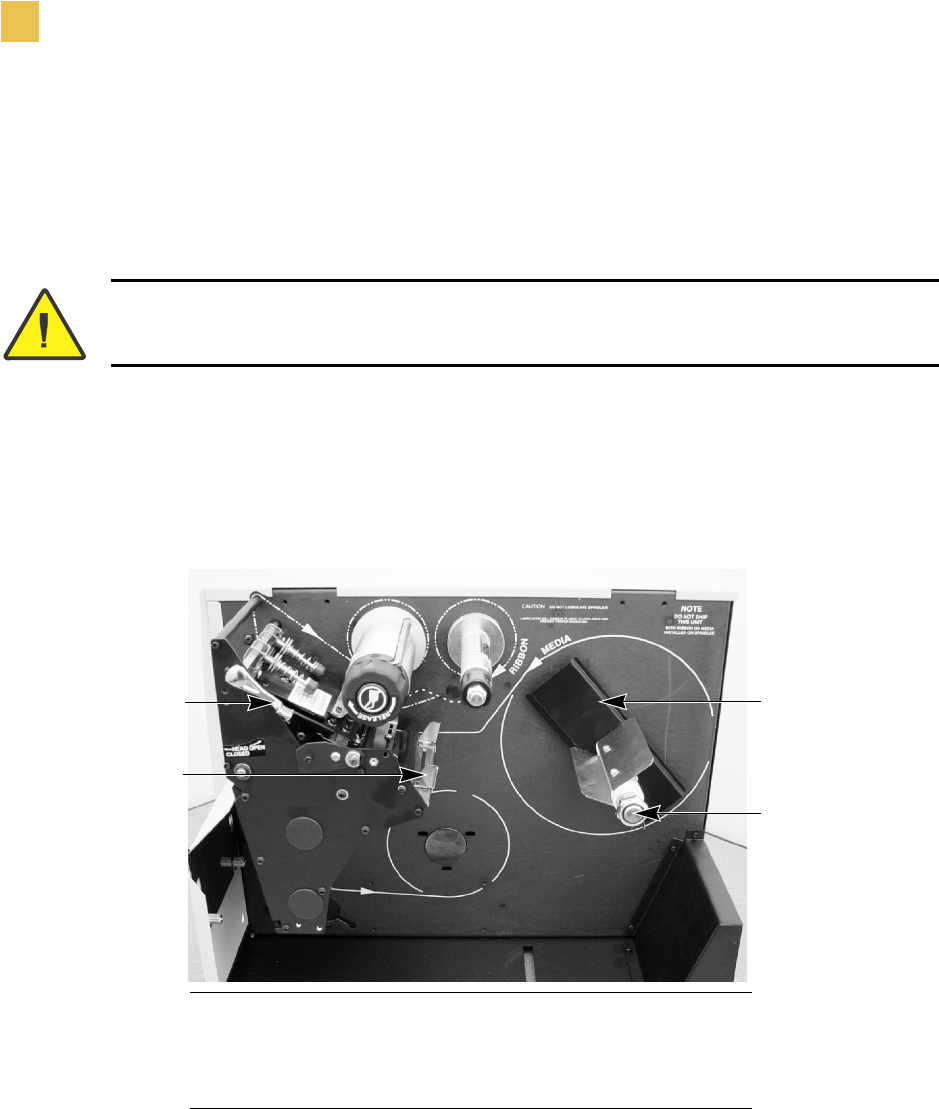
20 R110/R170XiIIIPlus User Guide
Printer Operation
Load the Printer
Load the Printer
This section gives you a series of instructions to load labels and ribbon (if used). The
instructions that follow are for a standard printer in Tear-Off Mode. To choose different
printing modes, see Print Modes on page 39.
Load Roll Media
Roll media feeds through the printer from the media hanger or media supply spindle.
This illustration identifies the components of the printer that you need to be familiar with to
load roll media.
Caution • Be sure the printer is Off (O) if you have connected the power cable.
1Printhead lever
2Media guide
3Media back plate
4Optional media spindle
1
2
3
4
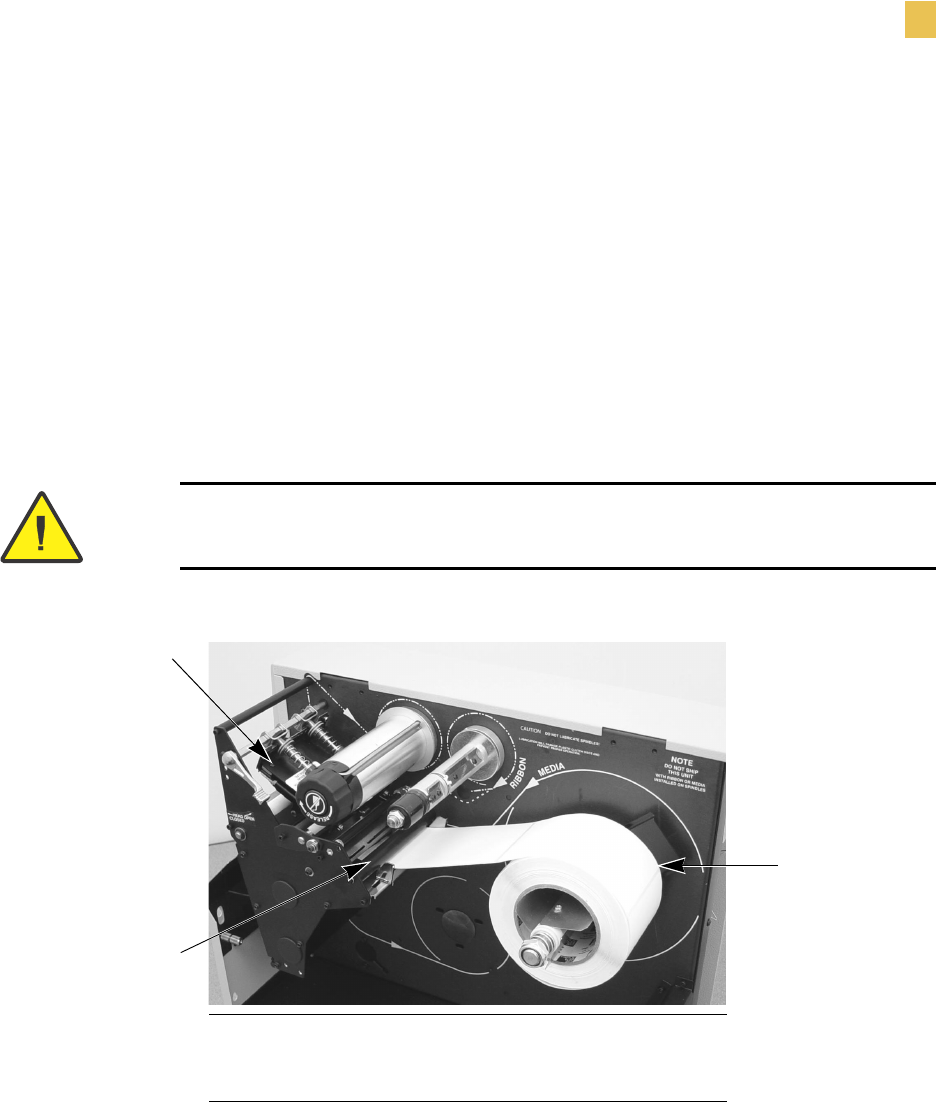
Printer Operation
Load the Printer
R110/R170XiIIIPlus User Guide 21
To load roll media, complete these steps:
1. Open the printhead.
2. Slide the media guide away from the printer frame. You might need to loosen the media
guide screw.
3. Put the roll of media on the media hanger.
4. Push the label core toward the printer frame. The labels must be aligned with the label
core.
5. Feed the media under the media guide roller and under the printhead.
6. Do you have the Cutter option?
•No — continue with the next step.
•Ye s — feed the media through the cutter.
7. Adjust the media supply guide so it is just touching, but does not restrict, the edge of the
media. The labels should lie flat as shown in the illustration.
8. Are you using direct thermal labels?
•Ye s — close the printhead and go to Print a Configuration Label on page 29.
•No — go to Load Ribbon on page 24.
Caution • The cutter blade is sharp. Do not rub or touch the blade with your fingers.
1Printhead
2Media guide roller
3Labels/media
1
2
3
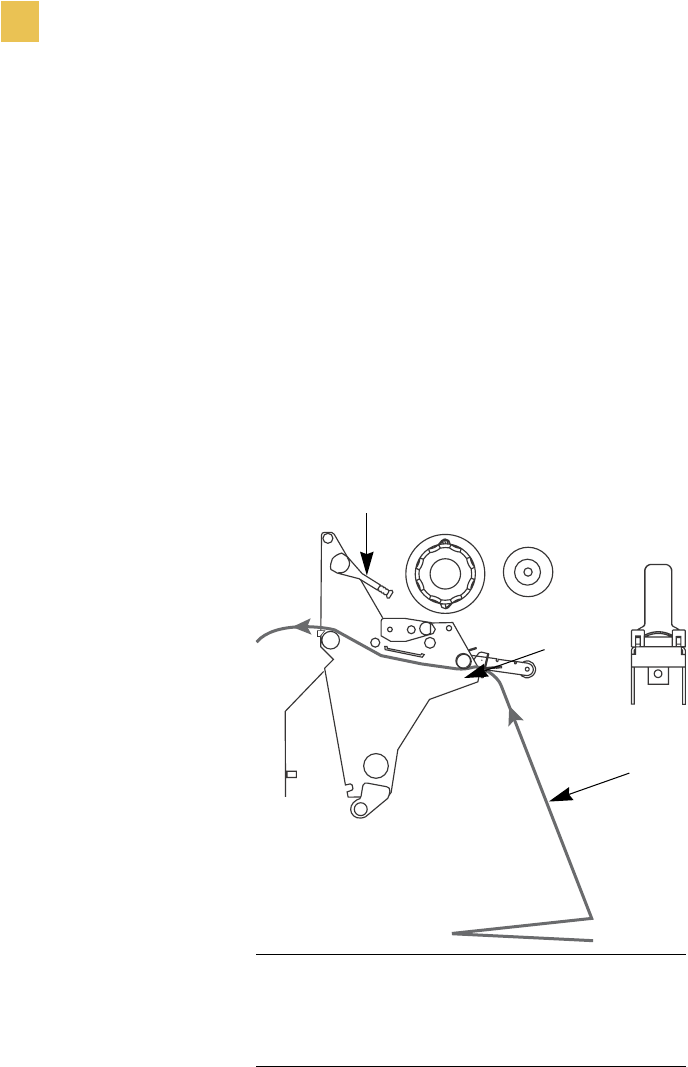
22 R110/R170XiIIIPlus User Guide
Printer Operation
Load the Printer
Load Fanfold Media
Fanfold media feeds through either the bottom or rear access slot from outside the printer. The
media hanger and media supply spindle are not used with fanfold media.
To load fanfold labels, complete these steps:
1. Slide the printhead lever to the Open position.
2. Slide the media guide as far from the printer frame as possible.
3. How do you want to feed the fanfold labels?
•From the bottom slot in the printer body.
This illustration shows the printer with fanfold labels loaded through the
bottom slot.
1Printhead lever
(shown in the Open position)
2Media guide
3Fanfold labels
1
2
3
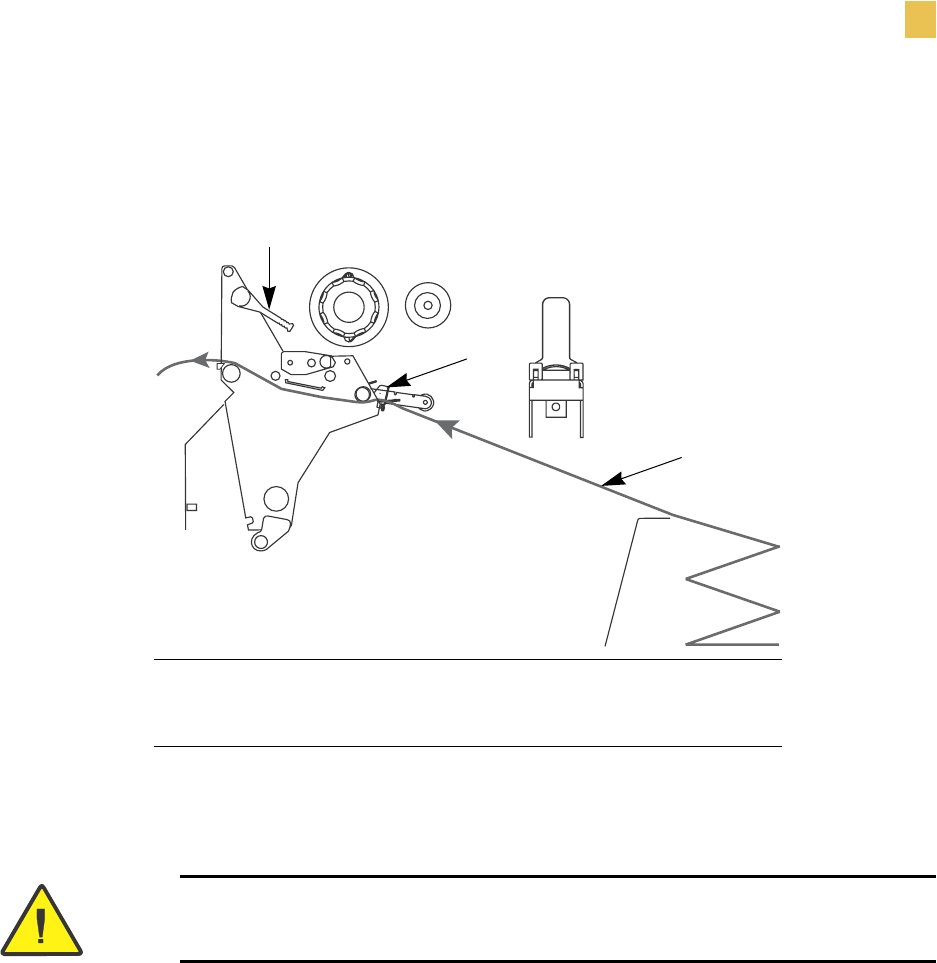
Printer Operation
Load the Printer
R110/R170XiIIIPlus User Guide 23
•From the rear slot in the printer body.
This illustration shows the printer with fanfold labels loaded through the rear
slot.
4. Do you have the Cutter option?
•No — continue with the next step.
•Ye s — feed the fanfold media through the cutter.
5. Adjust the media guide so it just touches, but does not restrict, the edge of the labels. The
labels should lie flat.
6. Are you using direct thermal labels?
•Ye s — close the printhead and go to Print a Configuration Label on page 29.
•No — go to Load Ribbon on page 24.
1Printhead lever (shown in the Open position)
2Media guide
3Fanfold labels
Caution • The cutter blade is sharp. Do not rub or touch the blade with your fingers.
1
2
3
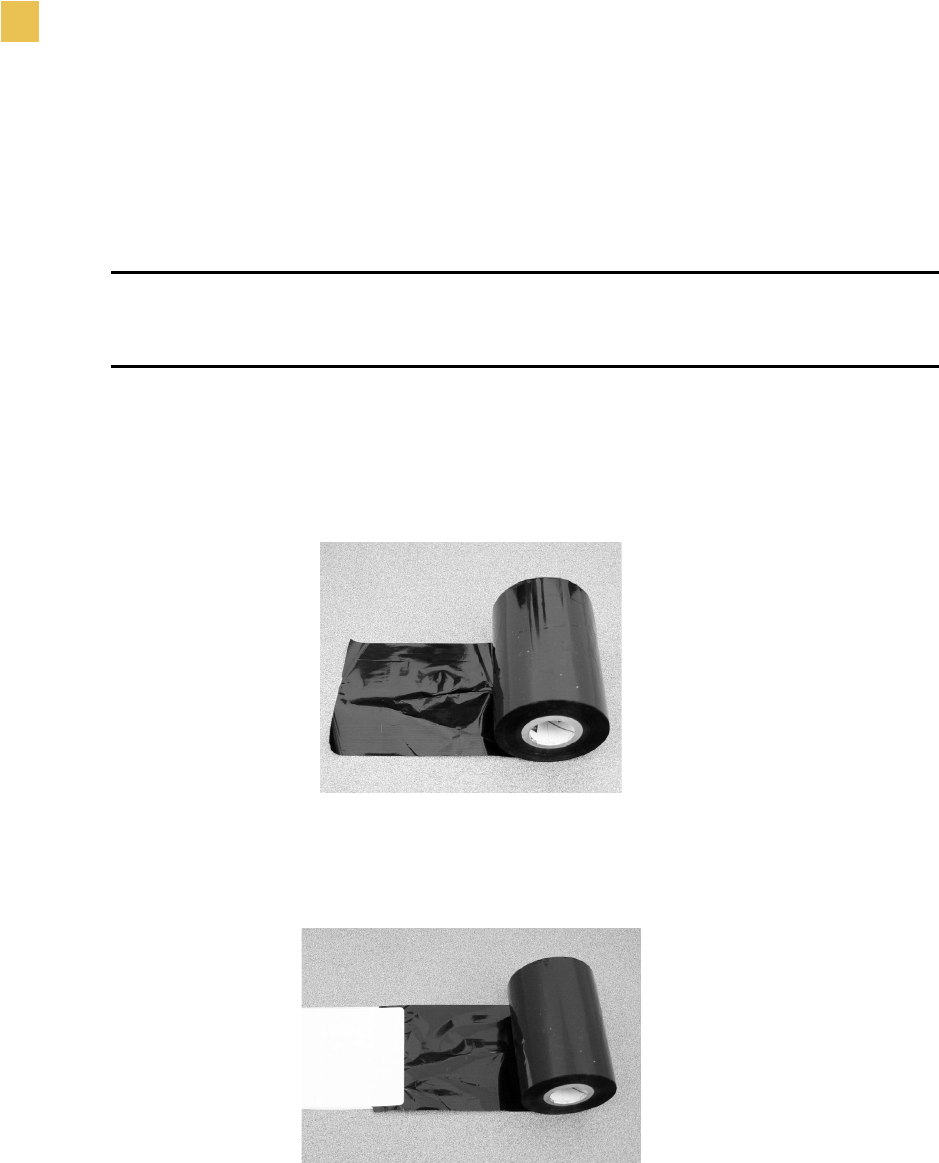
24 R110/R170XiIIIPlus User Guide
Printer Operation
Load the Printer
Load Ribbon
Before you load ribbon, make sure that the labels that you are using need ribbon. Only thermal
transfer labels require ribbon. Do not load ribbon if the printer is to be used with direct thermal
labels.
A ribbon leader makes it easier to load and unload ribbon. Make a leader for your ribbon roll if
it does not already have one.
To make a ribbon leader, complete these steps:
1. Unroll the ribbon about 6 in. (15 cm).
2. Tear off a strip of labels and backing about 6 in. (15 cm) long from the label roll.
3. Peel a label from the backing.
4. Overlap the ribbon and the backing with the ribbon on top, and use the label to tape them
together. This serves as a ribbon leader.
Caution • Use ribbon that is wider than the thermal transfer media. If the printhead is not
protected by the ribbon, the resulting abrasion from the media may cause premature printhead
wear.
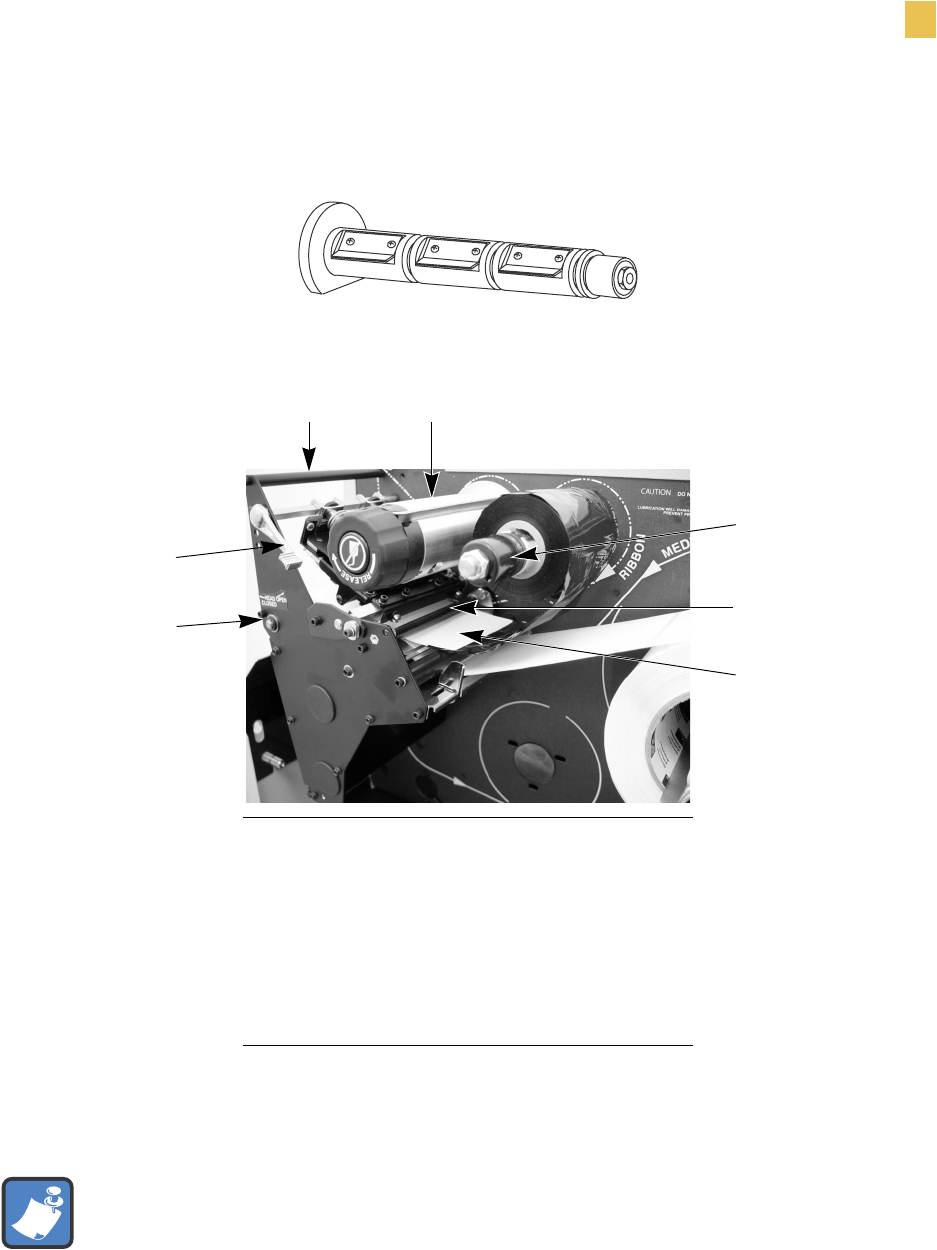
Printer Operation
Load the Printer
R110/R170XiIIIPlus User Guide 25
To load the ribbon, complete these steps:
1. Align the segments of the ribbon supply spindle as shown in the following illustration.
2. Place the roll of ribbon on the ribbon supply spindle, and push the core as far back as it can
go. The following illustration shows the printer components that are mentioned in this
procedure.
3. If the printhead is closed, open it using the printhead lever.
4. Thread the ribbon leader and attached ribbon under the ribbon guide roller, through the
print mechanism, and past the platen roller.
1Top roller
2Ribbon take-up spindle
3Ribbon supply spindle
4Ribbon guide roller
5Ribbon leader attached to ribbon
6Platen roller (not shown)
7Printhead lever
(shown in the Open position)
Note • For the R170XiIIIPlus, thread the leader first through the ribbon dancer roller
assembly.
1 2
3
4
6
5
7
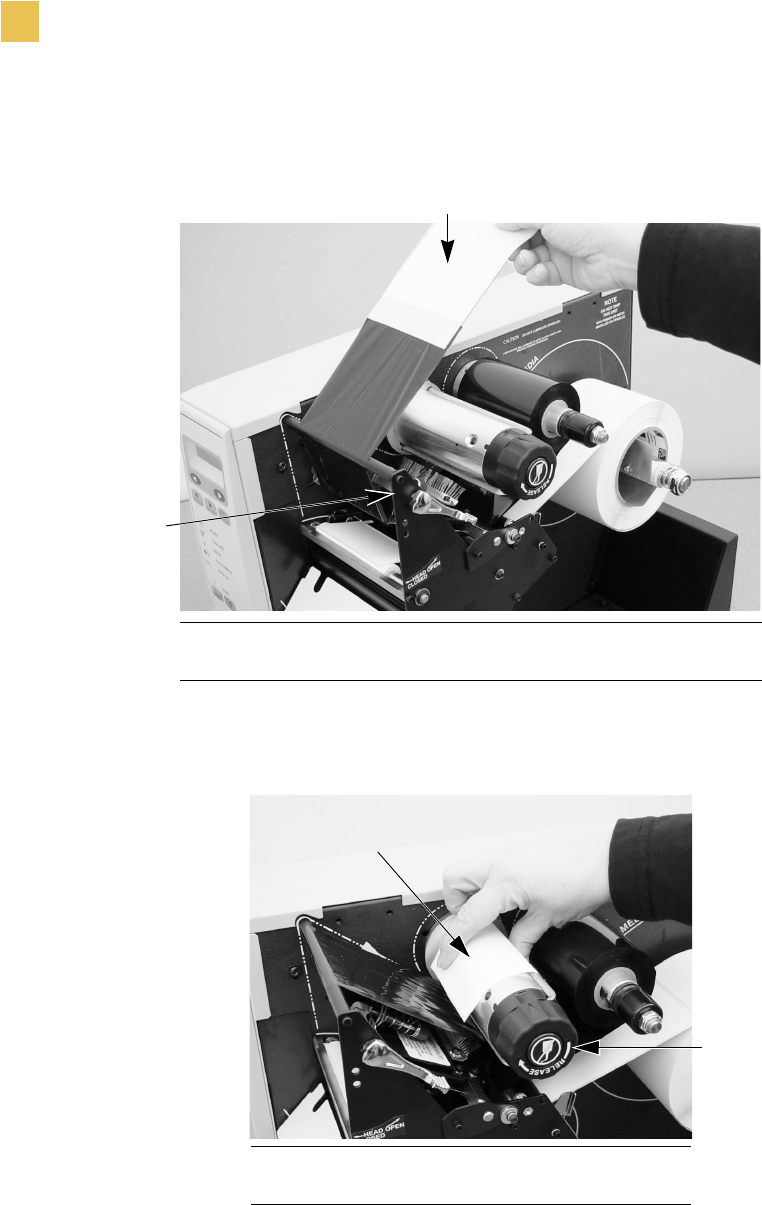
26 R110/R170XiIIIPlus User Guide
Printer Operation
Load the Printer
5. Pull the ribbon leader over the printhead and above the top roller as shown in the
following illustration.
6. Bring the ribbon leader and ribbon under the ribbon take-up spindle, and wrap them
around the spindle. The following illustration shows the ribbon leader wrapped around the
ribbon take-up spindle.
7. Turn the spindle counterclockwise until the ribbon stays on the spindle.
8. Close the printhead.
1Ribbon leader
2Printhead
1Ribbon leader
2Ribbon take-up spindle
1
2
1
2
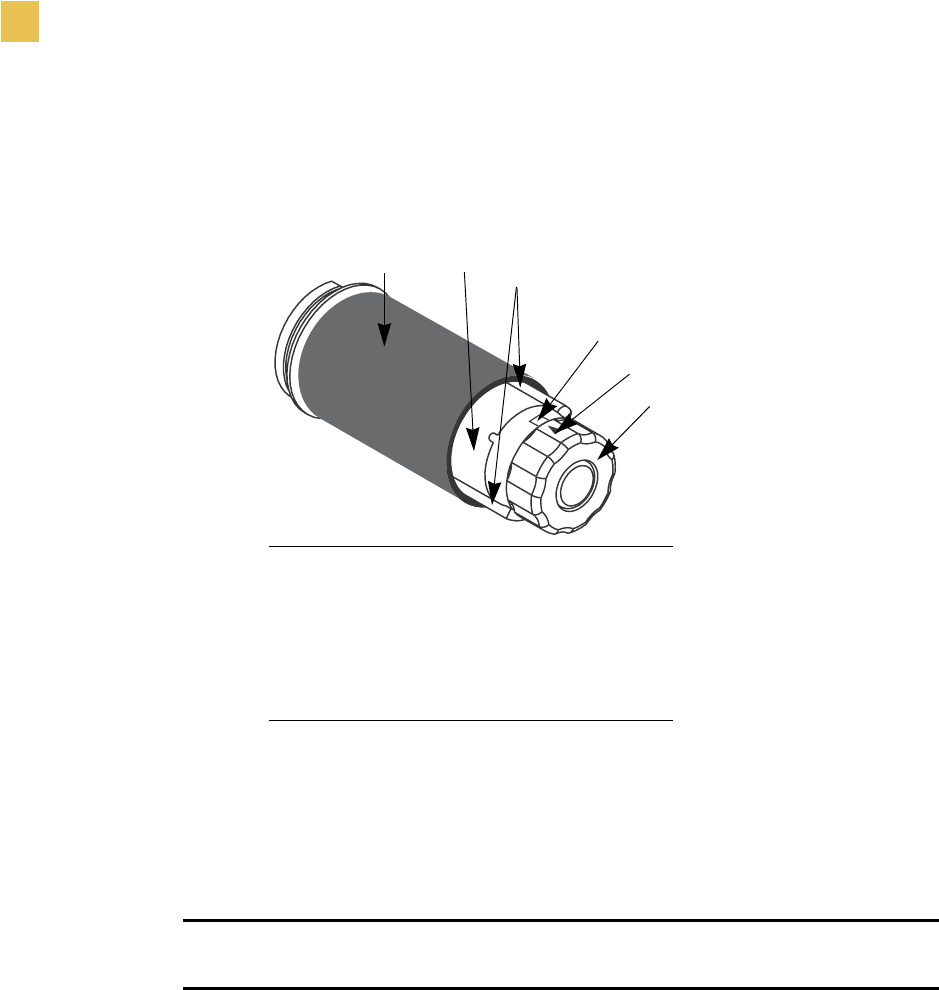
28 R110/R170XiIIIPlus User Guide
Printer Operation
Load the Printer
Remove Used Ribbon
When the ribbon has run out or must be changed, remove the used ribbon from the take-up
spindle. This illustration shows the ribbon take-up spindle.
To remove used ribbon, complete these steps:
1. Open the printhead.
2. Has the ribbon run out?
•Ye s — continue with the next step.
•No — tear or cut the ribbon as close to the ribbon take-up spindle as possible.
3. While holding the ribbon take-up spindle, turn the ribbon release knob clockwise until it
stops. This causes the ribbon release bars to pivot down, easing the spindle’s grip on the
used ribbon.
4. Slide the used ribbon off of the ribbon take-up spindle.
5. Align the arrow on the ribbon take-up spindle knob with the notch in the ribbon take-up
spindle.
6. To load new ribbon, see Load Ribbon on page 24.
1Used ribbon
2Ribbon take-up spindle
3Ribbon release bars
4Notch in ribbon take-up spindle
5Arrow on ribbon take-up spindle
6Ribbon release knob
Caution • Do not cut through the ribbon that is on the take-up spindle because you
may damage the spindle. Use the release knob to slide the ribbon off of the spindle.
1 2 3
4
5
6
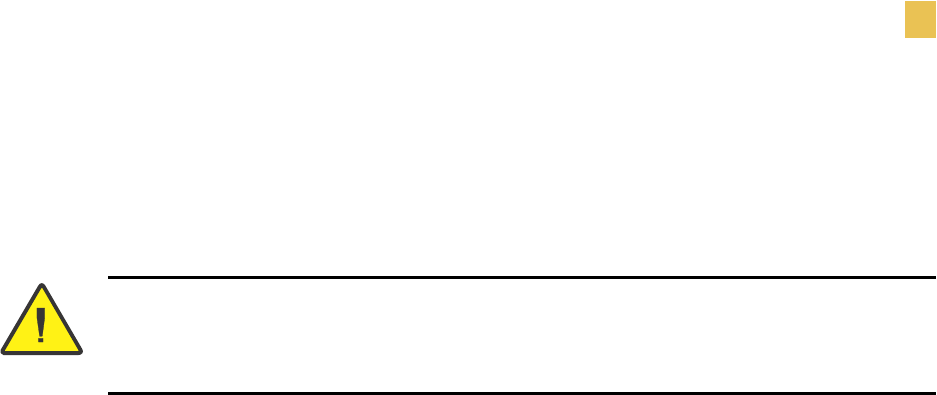
Printer Operation
Print a Configuration Label
R110/R170XiIIIPlus User Guide 29
Print a Configuration Label
When you have loaded the media and ribbon (if necessary), print a configuration label to use
as a record of your printer settings. Keep the configuration label for baseline information on
your printer when troubleshooting printing problems.
To print a configuration label, complete these steps:
1. Connect the power cord to the power connection on the back of the printer.
2. To confirm the power connection, turn the printer On (I).
The printer performs the power-up self test (POST). When the test is complete,
PRINTER READY displays on the front panel LCD.
3. Does the front panel LCD display PRINTER READY?
•Ye s — continue with the next step.
•No — go to Troubleshooting on page 119.
4. Turn the printer Off (O).
5. Press and hold CANCEL while turning the printer On (I).
6. Release CANCEL when the DATA light turns off (approximately five seconds).
The configuration label prints. A sample label, which may look different than
yours, is shown below.
Caution • For personal and equipment safety, always use an approved three-conductor power
cord specific to the region or country intended for installation. This cord must use an IEC 320
female connector and the appropriate region-specific three-conductor grounded plug
configuration.
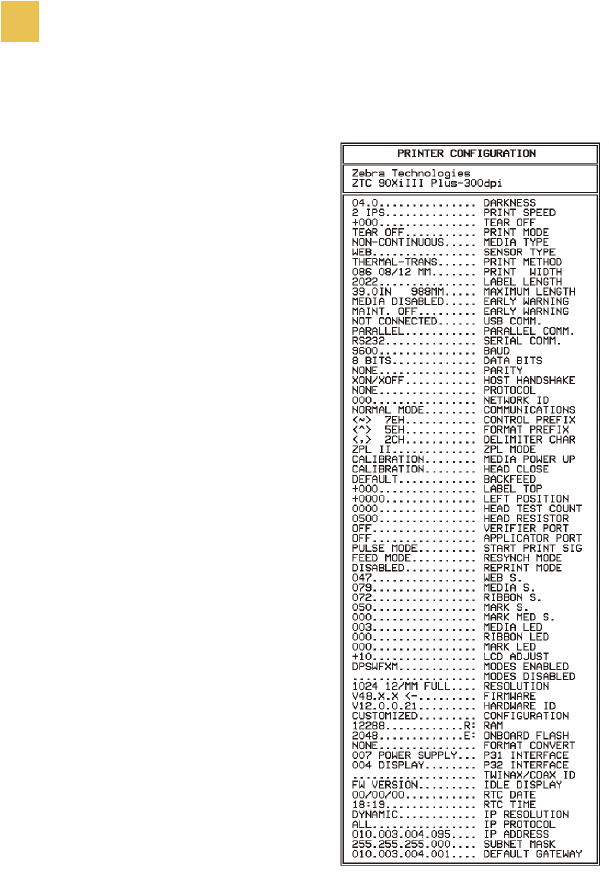
30 R110/R170XiIIIPlus User Guide
Printer Operation
Print a Configuration Label
7. Did the label print?
•Ye s , a configuration label printed. Connect the printer to your data source.
Communication can be handled in many different ways. More information
about the standard interfaces is available in Standard Ports on page 94.
•No, a label did not print. Sensors out of position is a common cause of printing
problems. Refer to Adjust Sensors on page 32. For additional assistance, refer
to Troubleshooting on page 119.
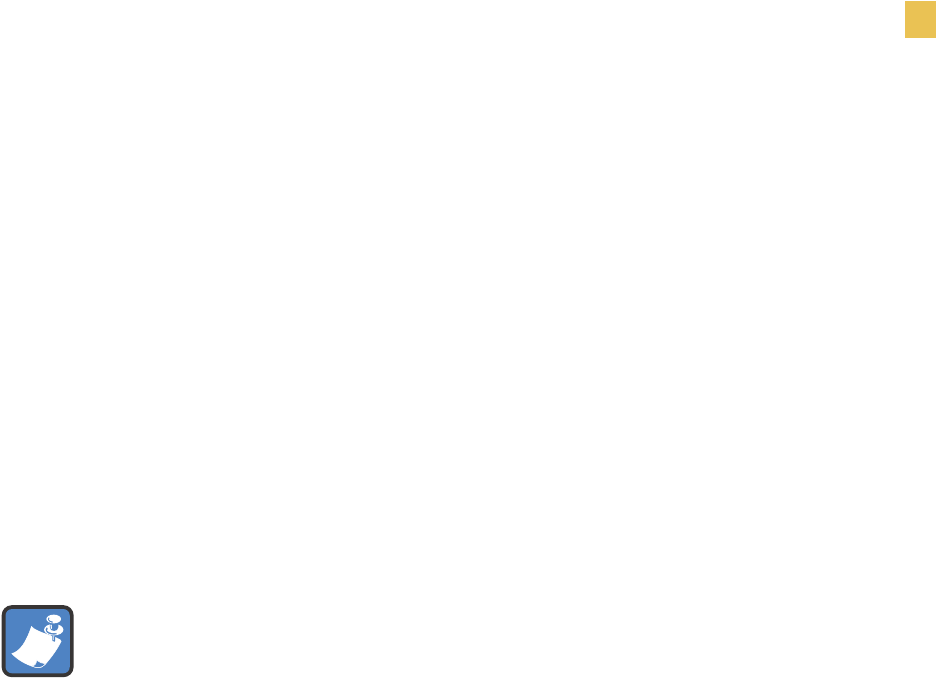
Printer Operation
Calibrate the Printer
R110/R170XiIIIPlus User Guide 31
Calibrate the Printer
There are five different ways that the printer can be calibrated. You may calibrate the printer as
needed.
•Auto-calibration occurs when the printer feeds media after the printhead is closed and
when the printer is first turned on (see Media Power Up on page 69 and Head Close
on page 69 for options). The printer automatically sets the value it detects for the spaces
between labels. This type of calibration also happens as part of both the sensor profile and
media and ribbon sensor calibration procedures.
•Long Calibration, which you select by pressing PAUSE then CALIBRATE,
calibrates the printer for media length, media type (continuous or non-continuous), and
print mode (thermal or direct thermal transfer) and updates the sensor values.
•Short Calibration, which you select by pressing just CALIBRATE, uses current
sensor values rather than detecting the spaces between labels and resetting the sensors.
This calibration sequence uses fewer labels than the long calibration sequence, but it is
less reliable because the values that are stored in the sensors could be incorrect.
•Sensor Profile Calibration, which you select through the front panel, auto-calibrates
the printer and prints a media sensor profile. See Sensor Profile on page 63 for
instructions.
•Media and Ribbon Sensor Sensitivity Calibration, which you select through the
front panel, resets the sensitivity of the sensors to detect correctly the media and ribbon
that you are using. See Media and Ribbon Sensor Calibration on page 32 for instructions.
If you change the type of ribbon and/or media, you might need to reset the sensitivity of
the media and ribbon sensors. When the sensors are at their new sensitivity, the printer
performs an auto-calibration.
Note • If you press CALIBRATE and nothing happens, you may need to upgrade your
firmware. Print a configuration label to see which version of firmware that is installed on
your printer. To upgrade your firmware or to check if you have the latest version, go to
http://www.zebra.com/SD/firmware.htm.

32 R110/R170XiIIIPlus User Guide
Printer Operation
Adjust Sensors
Adjust Sensors
This section describes how to adjust and calibrate sensors.
Media and Ribbon Sensor Calibration
Media and ribbon sensor calibration is one of the most common adjustments to the printer
settings. This procedure is performed through the front panel.
Indications that the sensitivity may need to be reset are:
•The
CHECK RIBBON light is on even though the ribbon is properly installed.
• Non-continuous labels are being treated as continuous labels.
To adjust the sensitivity of media and ribbon sensors, complete these
steps:
1. From the front panel, press the right oval to start the calibration procedure.
The LOAD BACKING prompt displays.
2. Open the printhead.
3. Remove approximately 8 in. (203 mm) of labels from the media backing, and pull the
media into the printer so that only the backing is between the media sensors.
4. Leave the printhead open.
5. Press the right oval to continue.
The REMOVE RIBBON prompt displays.
6. Remove the ribbon.
7. Close the printhead.
8. Press the right oval to continue.
The message CALIBRATING PLEASE WAIT displays.
The printer adjusts the scale (gain) of the signals that it receives from the media
and ribbon sensors. On the sensor profile, this essentially corresponds to moving
Note • Before you begin the calibration procedure, make sure that the maximum length is set
to a value 1 in. (25.4 mm) greater than the length of the labels that you are using. If the
maximum length is set to a lower value, the calibration process assumes that continuous media
is in the printer.
Important • This procedure must be followed exactly as presented. All of the steps must be
performed even if only one of the sensors requires adjustment. You may press the left oval at
any step in this procedure to cancel the procedure.

Printer Operation
Adjust Sensors
R110/R170XiIIIPlus User Guide 33
the peak of the graph up or down to optimize the readings for your application (for
more information, see Sensor Profile on page 63).
When calibration is complete, RELOAD ALL displays.
9. Open the printhead and pull the media forward until a label is positioned under the media
sensor.
10. Reload the ribbon back into to its proper position.
11. Close the printhead.
12. Press the right oval to continue.
The printer does a calibration equivalent to pressing CALIBRATE; during this
process, the printer determines the label length. To see the new readings on the
new scale, print a sensor profile.
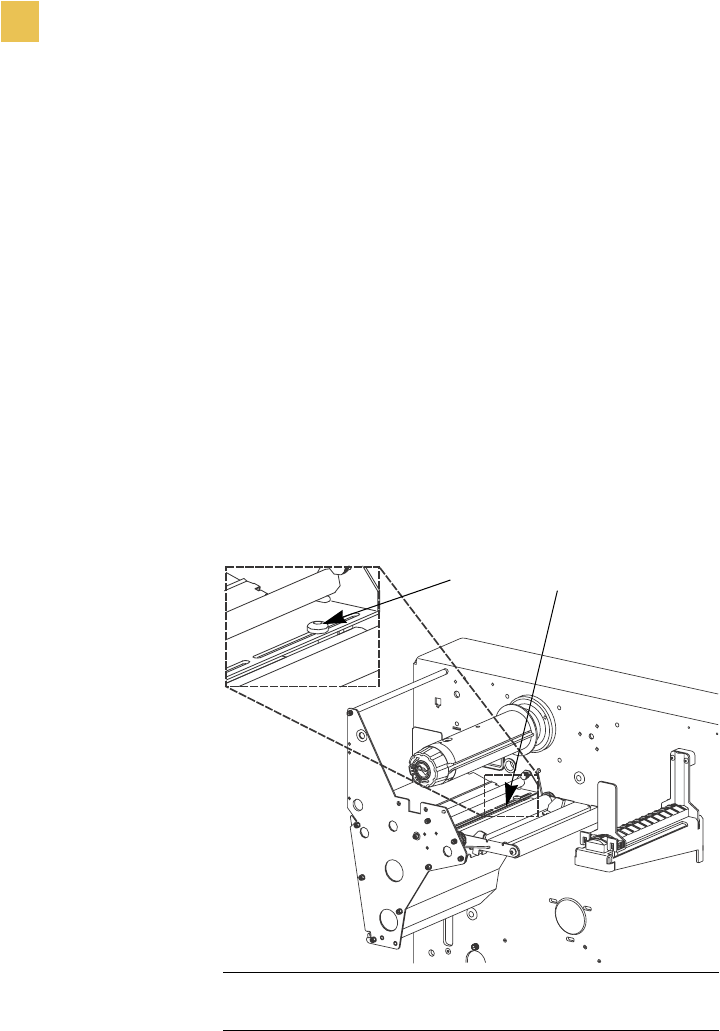
34 R110/R170XiIIIPlus User Guide
Printer Operation
Adjust Sensors
Transmissive (Media) Sensors
The transmissive sensor consists of two sections: a light source (the lower media sensor) and a
light sensor (the upper media sensor). The media passes between the two. The upper media
sensor can be positioned along the inside half of the media (the side closest to the back of the
printer) or the outside half of the media (the side farthest from the back of the printer).
Adjust these sensors only when the printer cannot detect the top of the label. The front panel
LCD displays ERROR CONDITION PAPER OUT, even though there are labels loaded in the
printer.
To adjust the upper media sensor for the inside half of the media,
complete these steps:
1. Remove the ribbon (if ribbon is used).
2. Locate the upper media sensor as shown in the following illustration. The upper media
sensor eye is directly below the adjustment screw head.
3. Slightly loosen the upper media sensor adjustment screw using a Phillips-head
screwdriver.
4. Using the tip of the screwdriver, slide the upper sensor along the slot to the desired
position (for non-continuous media with a notch or hole in the media, the sensor must be
directly above the notch or hole).
5. Tighten the adjustment screw to secure the upper media sensor.
1Upper media sensor adjustment screw
2Upper media sensor
12

Printer Operation
Adjust Sensors
R110/R170XiIIIPlus User Guide 35
To adjust the upper media sensor for the outside half of the media:
1. Remove the ribbon (if ribbon is used).
2. Locate the upper media sensor. The upper media sensor eye is directly below the
adjustment screw head.
3. Remove the upper media sensor adjustment screw using a Phillips-head screwdriver.
4. Lift the upper media sensor assembly from the slot, and move it and the wire cover to the
outside slot. Carefully pull the wires through the cable tie. You may need to set aside the
sensor wire cover if the adjustment is too far to the outside.
5. Replace and slightly tighten the adjustment screw.
6. Slide the upper media sensor along the slot to the desired position (for non-continuous
media with a notch or hole in the media, the sensor must be directly above the notch or
hole).
7. Tighten the adjustment screw.
8. Make sure that the wires are routed back into the groove of the media sensor bracket.
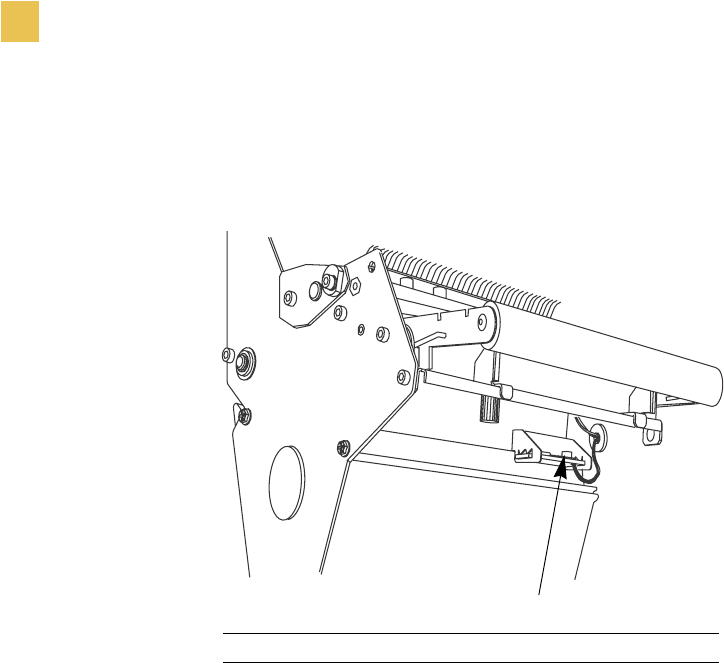
36 R110/R170XiIIIPlus User Guide
Printer Operation
Adjust Sensors
To adjust the lower media sensor, complete these steps:
1. Locate the lower media sensor assembly under the rear roller. (The sensor is a spring clip
holding a circuit board.)
2. Slide the sensor until the two brass-colored infrared emitters are under the upper media
sensor. Gently pull wires out as needed (wires should have a little slack).
3. If you move the sensor inward and a large loop of wire develops, remove the electronics
cover from the side of the printer, and gently pull the wires through. Clamp the wires so
that they do not rub any drive belts.
1Lower media sensor
1
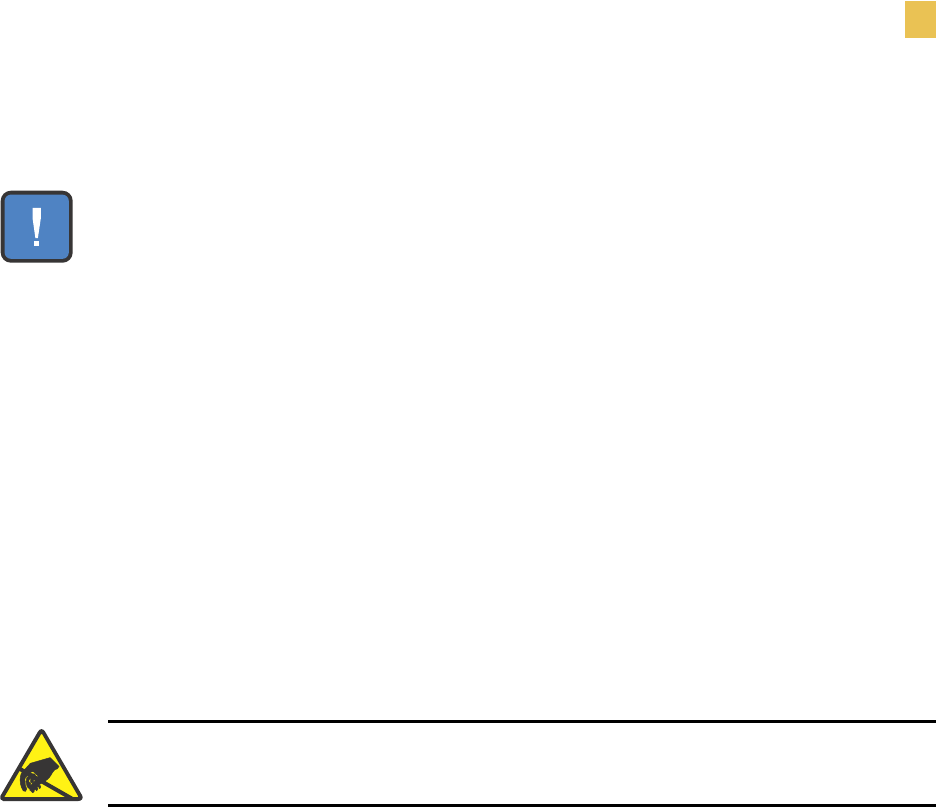
Printer Operation
Adjust the Printhead
R110/R170XiIIIPlus User Guide 37
Adjust the Printhead
Printhead pressure and the darkness setting affect print quality. If the darkness setting is too
high for the labels and ribbon being used, it causes premature printhead wear. If the toggle
pressure is not even, labels and ribbon may slip.
Toggle adjustment may be needed if printing is too light on one side or if thick labels are used.
Make sure that the toggles are positioned properly.
The toggles should be positioned so they provide even pressure on the labels. The toggles are
positioned by sliding them to the desired location. If the labels are too narrow to fit both
toggles, position one toggle over the center of the labels and decrease the pressure on the
unused toggle.
If positioning the toggles properly does not solve the problem, adjust printhead pressure.
Printhead life can be maximized by using the lowest pressure that produces the desired print
quality.
To adjust printhead pressure, complete these steps:
1. Print some labels at 2.4 in. (61 mm) per second by running the PA U S E S e l f Te s t
on page 133.
2. While printing labels, use the front panel controls to lower the darkness setting until the
labels are printing gray instead of black.
3. Loosen the locking nuts at the top of the toggle assemblies.
Important • Print quality depends on the labels and ribbon used as well as the toggle
pressure. Make sure your labels and ribbon are right for your application.
• Direct thermal labels do not need ribbon.
• Thermal transfer labels need thermal transfer ribbon.
Caution • Observe proper electrostatic safety precautions when handling any static-sensitive
components such as circuit boards and printheads.
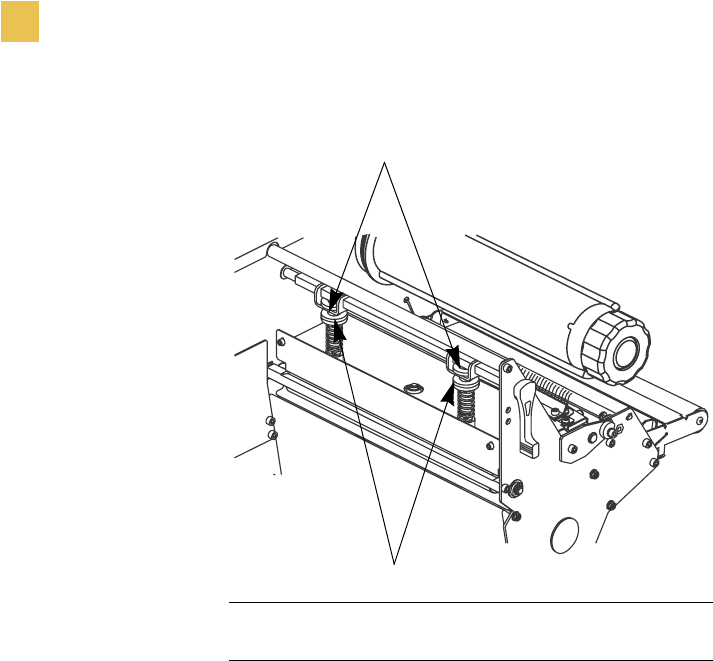
38 R110/R170XiIIIPlus User Guide
Printer Operation
Adjust the Printhead
4. Some media types require higher pressure to print well. For these media types, increase or
decrease pressure using the adjusting nuts until the left and right edges of the printed area
are equally dark.
5. Increase the darkness level using the front panel controls until the printing is clear.
6. Tighten the locking nuts.
1Locking nuts
2Adjusting nuts
2
1

R110/R170XiIIIPlus User Guide 39
CHAPTER 4
Print Modes
This chapter describes the available print modes.
Contents
Select a Print Mode . . . . . . . . . . . . . . . . . . . . . . . . . . . . . . . . . . 40
Tear-Off Mode . . . . . . . . . . . . . . . . . . . . . . . . . . . . . . . . . . . . 40
Peel-Off Mode . . . . . . . . . . . . . . . . . . . . . . . . . . . . . . . . . . . . 41
Cutter Mode. . . . . . . . . . . . . . . . . . . . . . . . . . . . . . . . . . . . . . 43
Rewind Mode . . . . . . . . . . . . . . . . . . . . . . . . . . . . . . . . . . . . 45
Rewind Mode with Cutter Option. . . . . . . . . . . . . . . . . . . . . . 48
Remove Backing from Rewind Spindle . . . . . . . . . . . . . . . . . . . 51

40 R110/R170XiIIIPlus User Guide
Print Modes
Select a Print Mode
Select a Print Mode
The options on your printer may let you set up additional print modes. Use the front panel
controls to set up the printer to the print mode that you wish to use.
The following are the available print mode selections:
•Tear-off
• Peel-off
•Cutter
•Rewind
• Applicator (used only if a machine will apply printed labels to something)
To select a print mode, complete these steps:
1. From the front panel, press SETUP/EXIT.
2. Press NEXT/SAVE until the LCD reads PRINT MODE.
3. Use the right or left oval to scroll though the choices. Be sure to select a print mode that
your hardware supports—some of the selections displayed are for optional printer
features.
4. To save your selection, press SETUP/EXIT.
Tear-Off Mode
See Load the Printer on page 20 to set up labels in Tear-Off Mode.
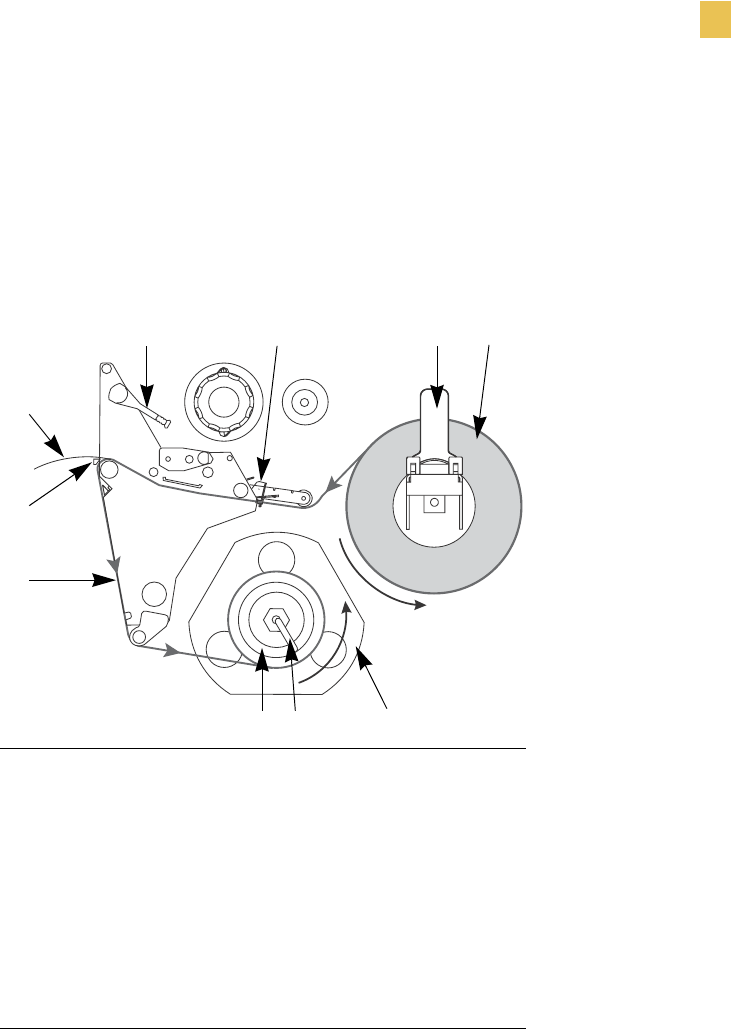
Print Modes
Select a Print Mode
R110/R170XiIIIPlus User Guide 41
Peel-Off Mode
Peel-Off Mode advances one label at a time. The printer does not print another label until the
first label is removed. The TAKE LABEL light flashes until the label is removed. The backing
is wound on the rewind spindle, but the rewind plate is not used.
This illustration shows the printer loaded with labels in Peel-Off Mode.
1Printhead lever
2Media guide
3Media supply guide
4Media
5Guide plate
6Spindle hook
7Rewind spindle
8 Label backing
9 Tear-off bar
10 Printed label
1234
7 6 5
8
9
10

42 R110/R170XiIIIPlus User Guide
Print Modes
Select a Print Mode
To set up the printer in Peel-Off Mode, complete these steps:
1. Remove the rewind plate (if installed) from the front of the printer. Store it on the two
mounting screws on the inside of the front panel.
2. From the front panel, select Peel-Off Mode.
3. Open the printhead.
4. Slide the media guide and media supply guide as far from the printer frame as possible.
5. Flip down the media supply guide.
6. Put the roll of media on the media hanger.
7. Push the label core toward the printer frame. The labels must be aligned with the label
core.
8. Feed the media under the media guide roller and under the printhead.
9. Adjust the media supply guide so it is just touching the edge of the media.
10. When loading labels, allow approximately 36 in. (915 mm) of labels to extend past the
tear-off/peel-off bar. Remove all labels from this portion to create a leader.
11. Remove the hook from the rewind spindle. If you are using a core, slide it onto the rewind
spindle until it is flush against the guide plate.
12. Wind the label backing around either the 3 in. (76 mm) core or the rewind spindle and
reinstall the hook.
13. Flip up the media supply guide. Slide in the media guide and media supply guide so they
just touch, the edge of the labels. The labels should lie flat.
14. Before closing the printhead, make sure that:
• The labels are positioned against the inside guides.
• The labels are taut and parallel with the pathway when wound onto the rewind
spindle or core.
15. Close the printhead.
The backing winds on the rewind spindle or core.
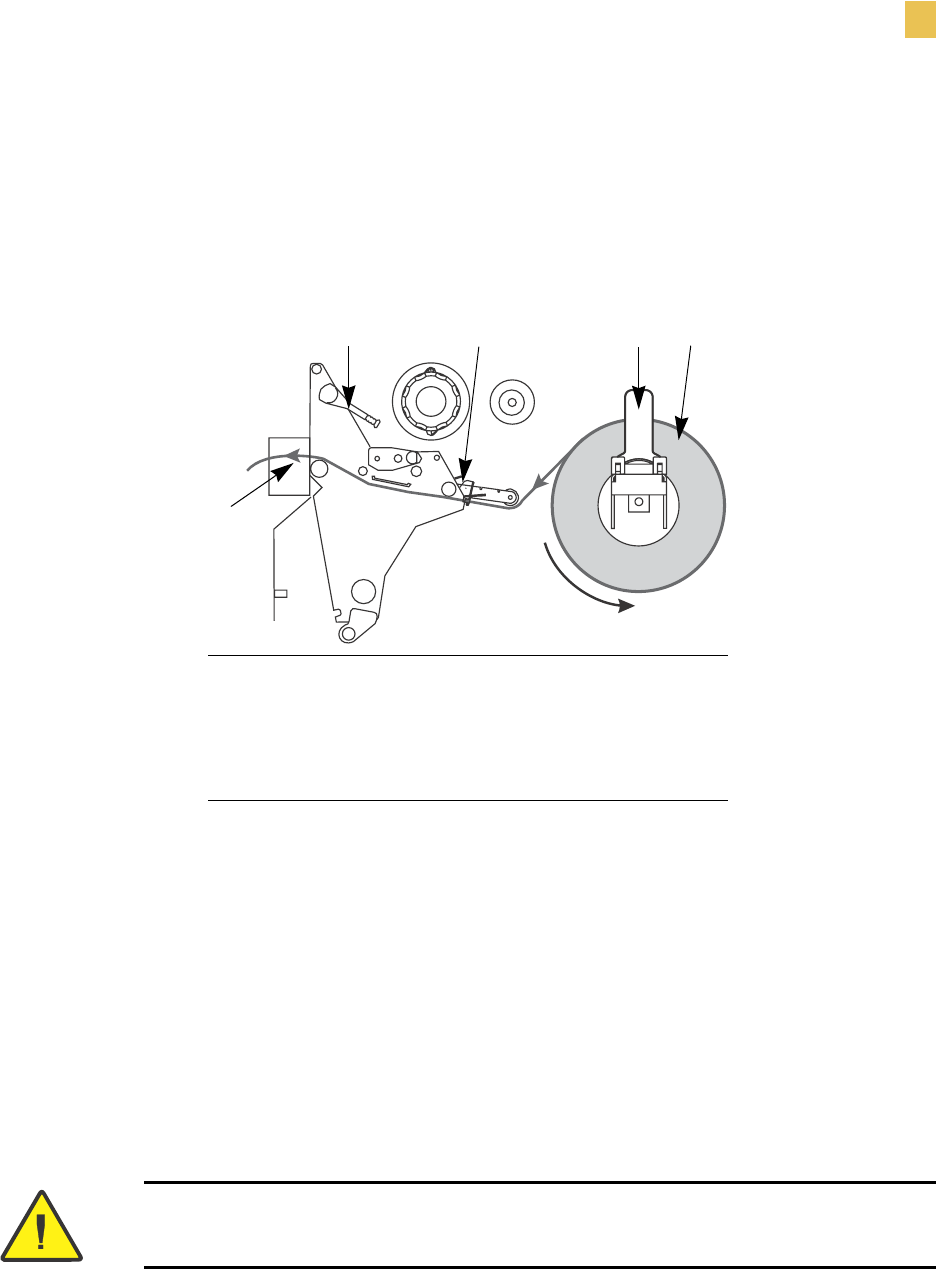
Print Modes
Select a Print Mode
R110/R170XiIIIPlus User Guide 43
Cutter Mode
A cutter is a rotating knife with a self-sharpening blade that is attached to the front of the
printer. The cutter is used to cut individual labels as they are printed. See www.zebra.com for
more information about the cutter option.
This illustration shows the printer loaded with labels in Cutter Mode.
To set up the printer in Cutter Mode, complete these steps:
1. Turn the printer On (I).
2. From the front panel, select Cutter Mode.
3. Open the printhead.
4. Slide the media guide and media supply guide as far from the printer frame as possible.
5. Flip down the media supply guide.
6. Put the roll of media on the media hanger.
7. Push the label core toward the printer frame. The labels must be aligned with the label
core.
8. Feed the media under the media guide roller and under the printhead.
9. Feed the labels through the cutter mechanism.
10. Flip up the media supply guide.
1Printhead lever
2Media guide
3Media supply guide
4Media
5Cutter
Caution • The cutter blade is sharp. Do not rub or touch the blade with your fingers.
12 3 4
5

44 R110/R170XiIIIPlus User Guide
Print Modes
Select a Print Mode
11. Slide in the media guide and media supply guide so they just touch, but do not restrict, the
edge of the roll.
12. Before closing the printhead, make sure that:
• The labels are positioned against the inside guides.
• The labels are taut and parallel with the pathway when wound onto the rewind
spindle or core.
13. Close the printhead.
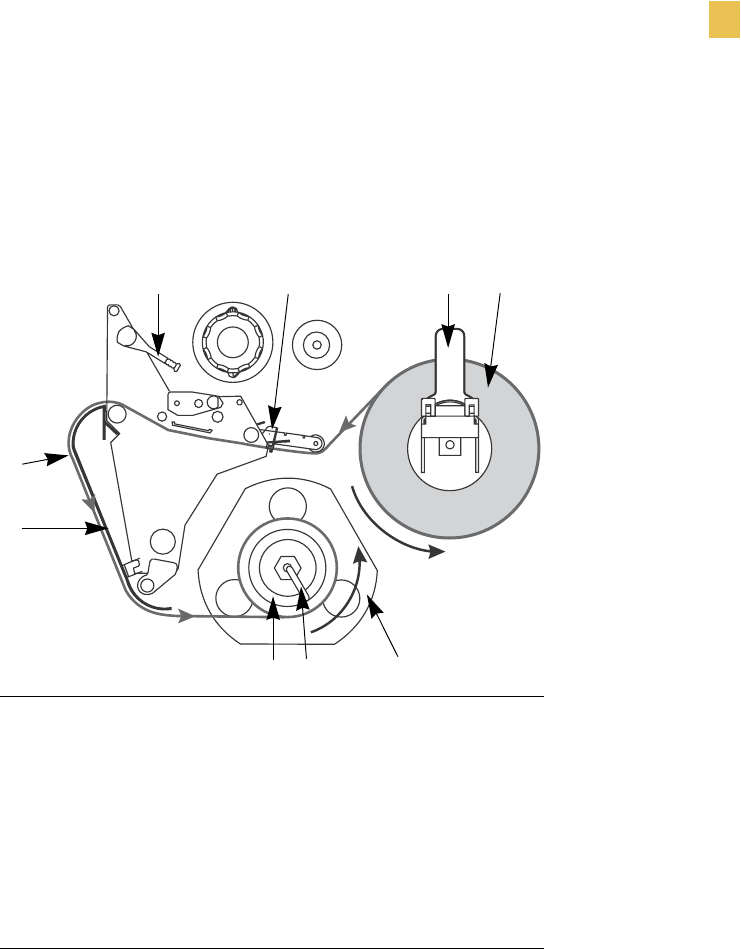
Print Modes
Select a Print Mode
R110/R170XiIIIPlus User Guide 45
Rewind Mode
Rewind Mode allows the media to be wound on a core after printing.
The following illustration shows the printer loaded with labels in Rewind Mode.
1Printhead lever
2Media guide
3Media supply guide
4Labels
5Guide plate
6Spindle hook
7Rewind spindle
8 Rewind plate
9 Printed labels
12 3 4
7 6 5
8
9
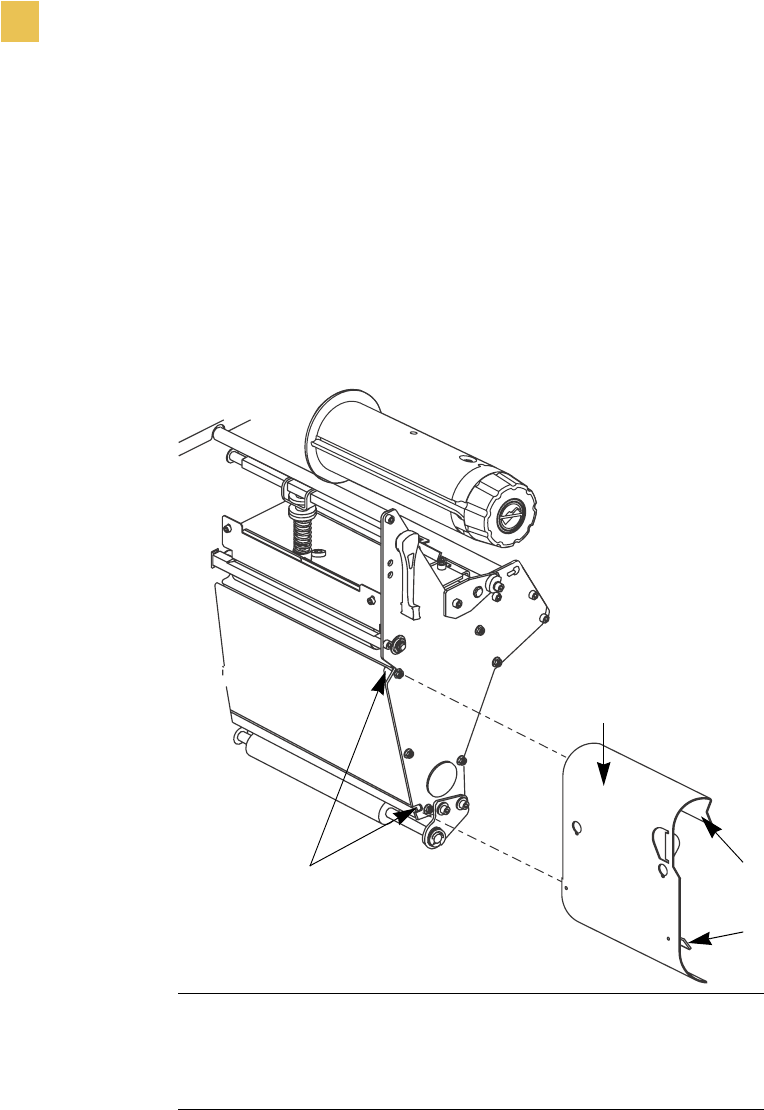
46 R110/R170XiIIIPlus User Guide
Print Modes
Select a Print Mode
To install the rewind plate, complete these steps:
1. Remove the rewind plate from its storage location inside the printer.
2. Position the rewind plate so that the lip on the attached hook plate points down.
3. Insert the hook plate lip 1/2 in. (13 mm) into the lower slot in the side plate.
4. Align the upper end of the rewind plate with the matching slot in the side plate.
5. Slide in the rewind plate until it stops against the printer’s main frame.
This illustration shows the rewind plate and where it hooks to the printer.
1Slots
2Rewind plate
3Lip
4Adjustable hook plate
2
3
1
4

Print Modes
Select a Print Mode
R110/R170XiIIIPlus User Guide 47
To set up the printer in Rewind Mode, complete these steps:
1. If you have not already done so, install the rewind plate.
2. From the front panel, select Rewind Mode.
3. Open the printhead.
4. Slide the media guide and media supply guide as far from the printer frame as possible.
Flip down the media supply guide.
5. Put the roll of media on the media hanger.
6. Push the label core toward the printer frame. The labels must be aligned with the label
core.
7. Feed the media under the media guide roller and under the printhead.
8. Adjust the media supply guide so it is just touching the edge of the media.
9. When loading labels, allow approximately 36 in. (915 mm) of labels to extend past the
printhead. Remove all labels from this portion to create a leader.
10. Remove the hook from the rewind spindle. If you are using a core, slide it onto the rewind
spindle until it is flush against the guide plate.
11. Wind the label backing around either the 3 in. (76 mm) core or the rewind spindle.
Reinstall the hook.
12. Flip up the media supply guide. Slide in the media guide and media supply guide so they
just touch the edge of the labels. The labels should lie flat.
13. Before closing the printhead, make sure that:
• The labels are positioned against the inside guides.
• The labels are taut and parallel to the pathway when wound onto the rewind
spindle or core.
14. Close the printhead.
The labels wind on the rewind spindle or core.
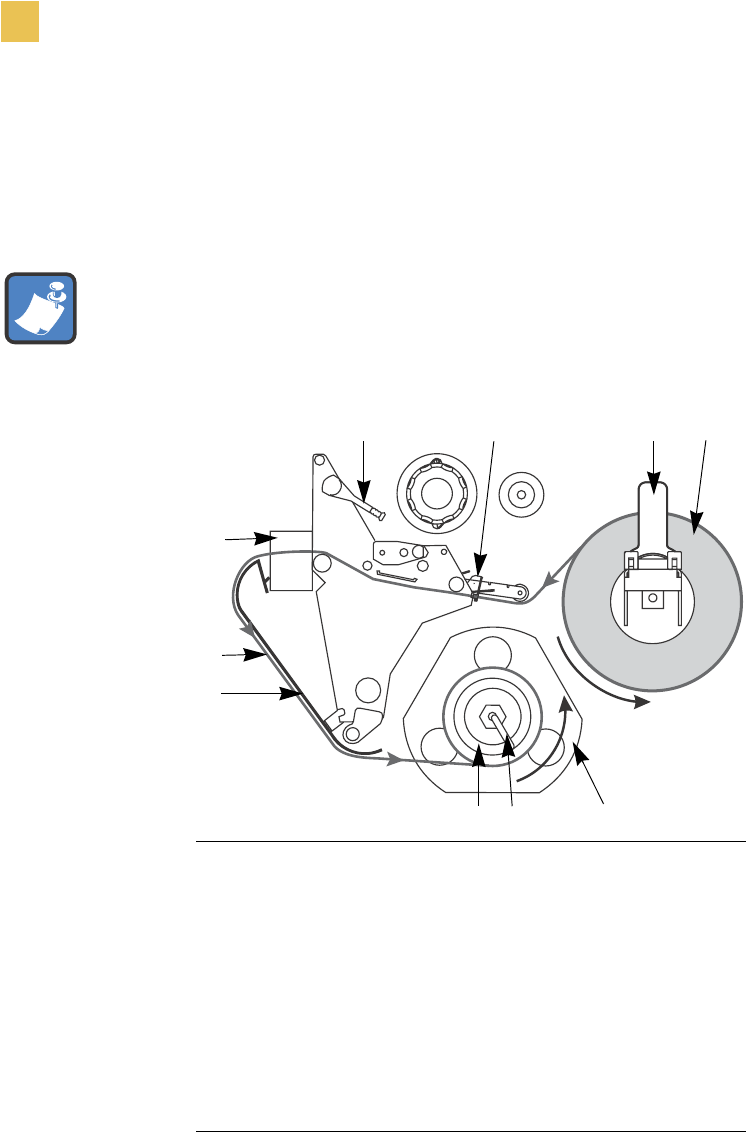
48 R110/R170XiIIIPlus User Guide
Print Modes
Select a Print Mode
Rewind Mode with Cutter Option
Printers with the cutter option can use the Rewind Mode to print and save a roll of labels. See
www.zebra.com for more information about the cutter option.
This illustration shows the printer loaded with labels in Rewind Mode with the cutter option.
Note • Rewind Mode cannot be used with the cutter option on R110XiIIIPlus printers.
1Printhead lever
2Media guide
3Media supply guide
4Labels
5Rewind spindle
6Guide plate
7Spindle hook
8Rewind plate
9Printed label
10 Cutter
1234
7 6 5
8
9
10
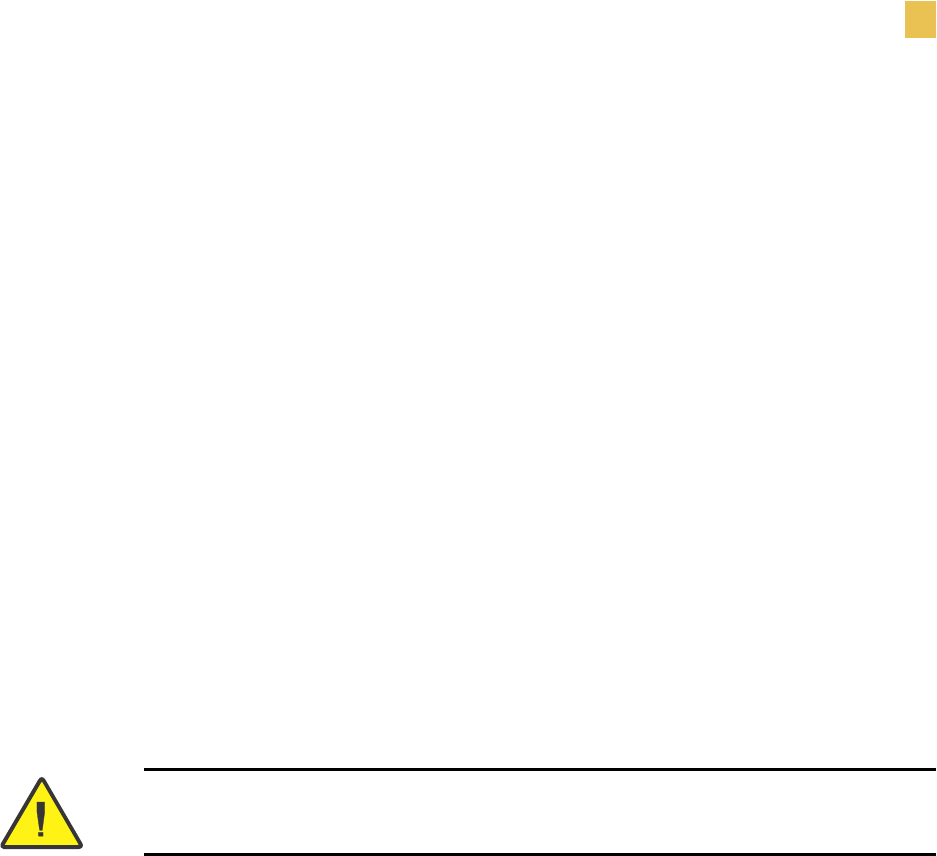
Print Modes
Select a Print Mode
R110/R170XiIIIPlus User Guide 49
To set up the Rewind Mode for printers with the cutter option, complete
these steps:
1. Turn the printer On (I).
The printer feeds out and cuts one label.
2. From the front panel, select Rewind Mode.
3. Remove the rewind plate from its storage location in front of the print mechanism inside
the media compartment.
4. Invert the rewind plate so that the lip on the attached hook plate points down.
5. Insert the hook plate lip 1/2 in. (13 mm) into the lower opening in the side plate. Slide in
the rewind plate until it stops against the printer’s main frame.
6. Insert the two small tabs on the rewind plate into the corresponding slots in the cutter
support bracket. (The rewind plate should spring into the proper position.)
7. Open the printhead.
8. Slide the media guide and media supply guide as far from the printer frame as possible.
9. Flip down the media supply guide.
10. Put the roll of media on the media hanger.
11. Push the label core toward the printer frame. The labels must be aligned with the label
core.
12. Feed the media under the media guide roller and under the printhead.
13. Feed the labels through the cutter mechanism.
14. When loading labels, allow approximately 36 in. (915 mm) of labels to extend past the
printhead. Remove all labels from this portion to create a leader.
15. Adjust the media supply guide so it is just touching the edge of the media.
16. Remove the hook from the rewind spindle.
17. If you are using a core, slide it onto the rewind spindle until it is flush against the guide
plate.
18. Wind the label backing around either the 3 in. (76 mm) core or the rewind spindle.
19. Reinstall the hook.
20. Flip up the media supply guide.
21. Slide in the media guide and media supply guide so they just touch, but do not restrict, the
edge of the roll.
22. Before closing the printhead, make sure that:
• The labels are positioned against the inside guides.
Caution • The cutter blade is sharp. Do not rub or touch the blade with your fingers.

50 R110/R170XiIIIPlus User Guide
Print Modes
Select a Print Mode
• The labels are taut and parallel with the pathway when wound onto the rewind
spindle or core.
23. Close the printhead.
The labels wind on the rewind spindle or core.
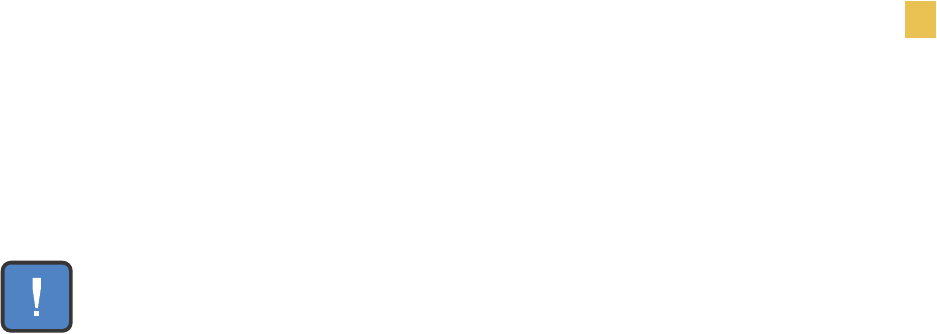
Print Modes
Remove Backing from Rewind Spindle
R110/R170XiIIIPlus User Guide 51
Remove Backing from Rewind Spindle
Rewind Mode and Peel-Off Mode use the rewind spindle. The label backing must be removed
every time you change labels for the printer to work correctly.
To remove label backing from the rewind spindle, complete these steps:
1. Have the labels run out?
•Ye s — continue with the next step.
•No — unwind approximately 36 in. (915 mm) of backing from the rewind
spindle. Cut or tear it off at the spindle.
2. Pull out the spindle hook.
3. Slide the backing off of the rewind spindle and discard.
4. Replace the spindle hook.
Important • It is not necessary to turn off the power to remove backing from the rewind
spindle. If power is turned off, all label formats and images, as well as any temporarily saved
parameter settings stored in the printer’s internal memory, are lost. When power is turned back
on, these items must be reloaded.
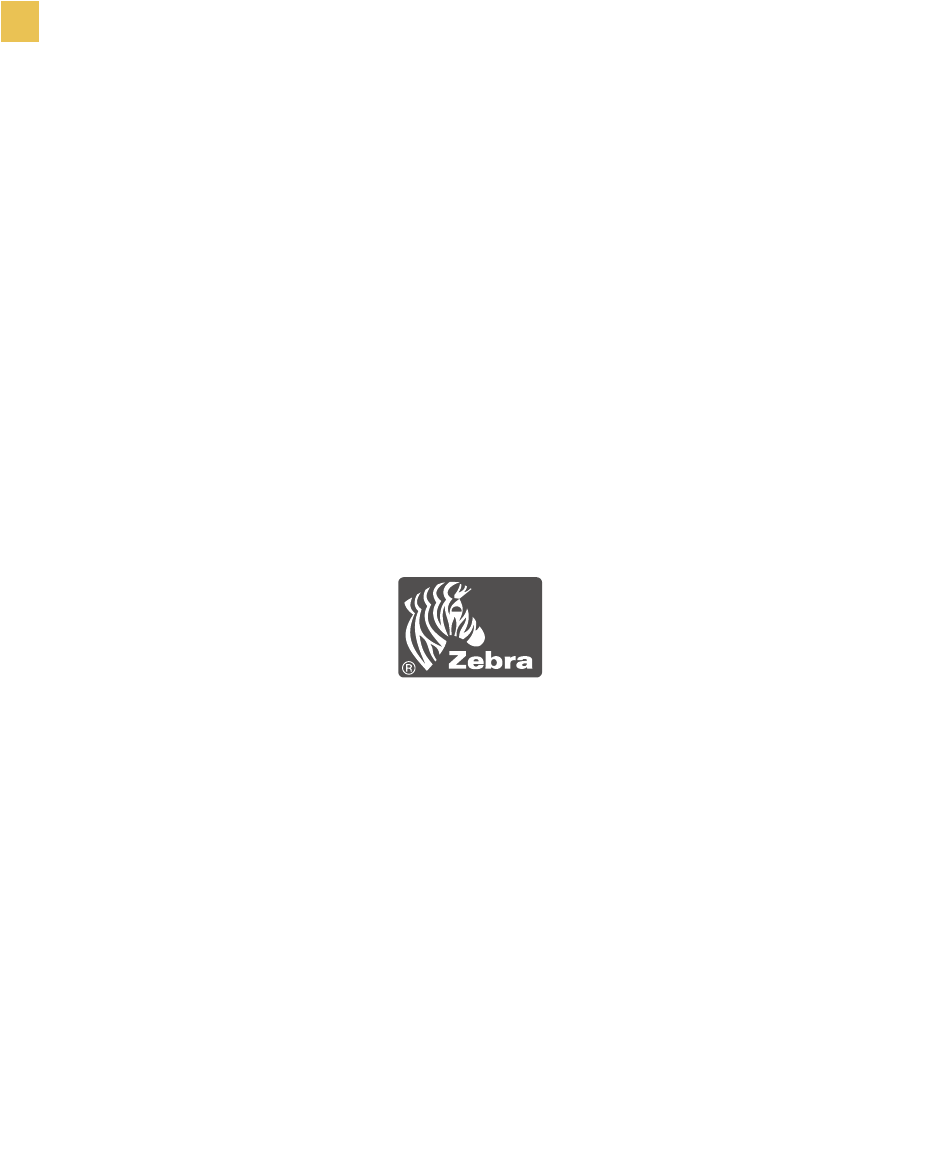
52 R110/R170XiIIIPlus User Guide
Print Modes
Remove Backing from Rewind Spindle

R110/R170XiIIIPlus User Guide 53
CHAPTER 5
Configuration
This appendix describes the function of the front panel.
Contents
Overview . . . . . . . . . . . . . . . . . . . . . . . . . . . . . . . . . . . . . . . . . . 54
Enter Setup Mode . . . . . . . . . . . . . . . . . . . . . . . . . . . . . . . . . 54
Exit Setup Mode . . . . . . . . . . . . . . . . . . . . . . . . . . . . . . . . . . 54
Password-Protected Parameters . . . . . . . . . . . . . . . . . . . . . . . 56
Default Password Value . . . . . . . . . . . . . . . . . . . . . . . . . . . . 56
Disable the Password Protection Feature . . . . . . . . . . . . . . . 56
Configuration and Calibration LCD Displays . . . . . . . . . . . . . . . 57
ZebraNet PrintServer II LCD Displays. . . . . . . . . . . . . . . . . . 76
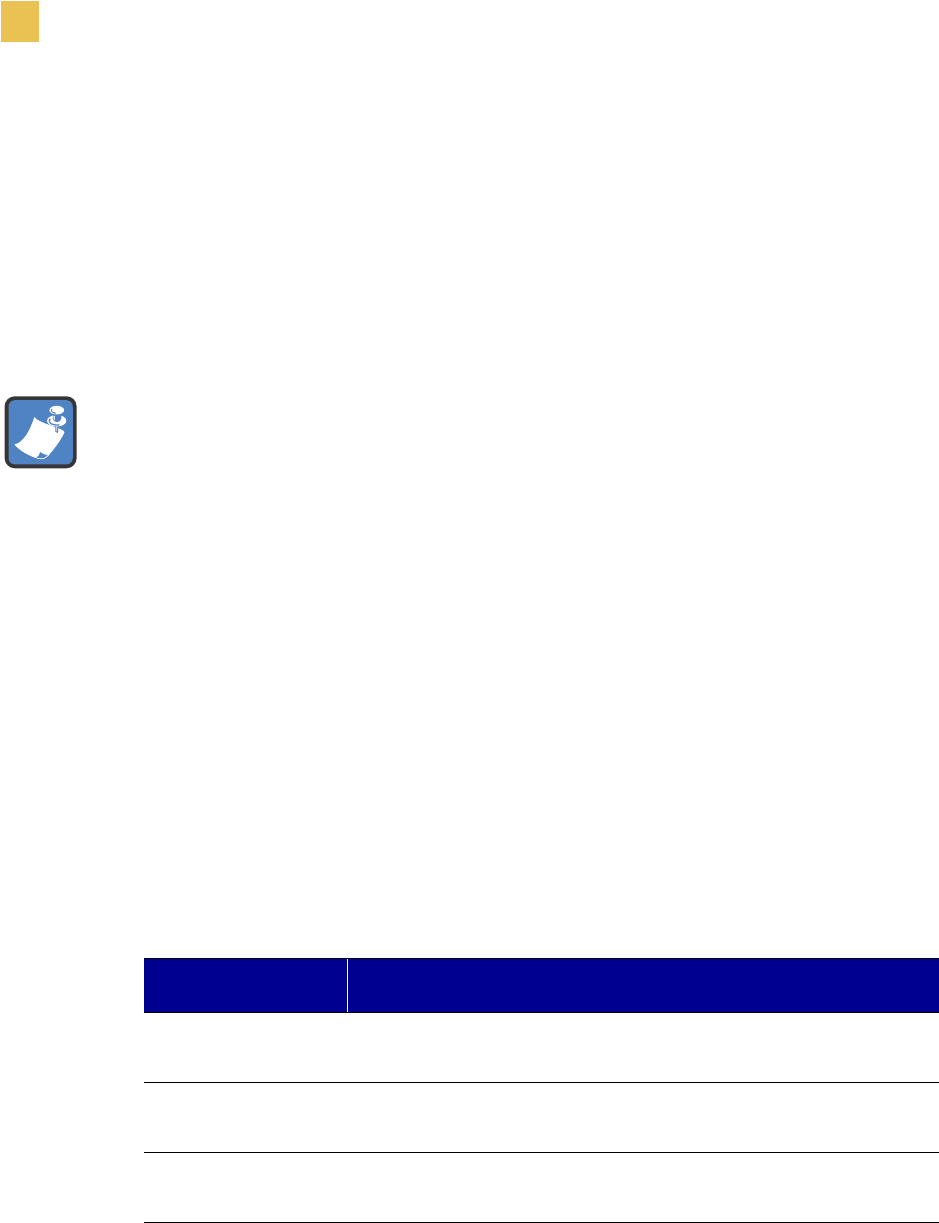
54 R110/R170XiIIIPlus User Guide
Configuration
Overview
Overview
After you have installed the labels and ribbon and printed a configuration label, you can
change the printer’s settings using the front panel controls. For an overview of the front panel,
including descriptions of the buttons and lights, see Front Panel on page 3. If you need to
restore the printer to its factory default settings, see FEED and PAUSE Self Test on page 135.
Many printer settings may be controlled by your printer’s driver or label preparation software.
Please refer to the driver or software documentation for more information.
Enter Setup Mode
To enter Setup Mode, complete these steps:
1. Press SETUP/EXIT to enter Setup Mode.
2. Press either NEXT/SAVE or PREVIOUS to scroll to the parameter that you wish to set.
Exit Setup Mode
To leave Setup Mode, complete these steps:
1. Press SETUP/EXIT.
The LCD displays SAVE CHANGES.
2. Press the left or right oval to display the save choices. The choices are described in the
following table.
.
Note • Printers that are operating on an IP network can be quickly configured with the
ZebraLink™ WebView (ZebraNet®PrintServer II required). For information, see the
ZebraNet Networking: PrintServer II Installation and User Guide.
LCD Display Description
PERMANENT Permanently saves the changes. Values are stored in the printer
even when power is turned off.
TEMPORARY Saves the changes until you change them again or until power is
turned off.
CANCEL Cancels all changes from the time you pressed SETUP/EXIT
except the darkness and tear-off settings (if they were changed).
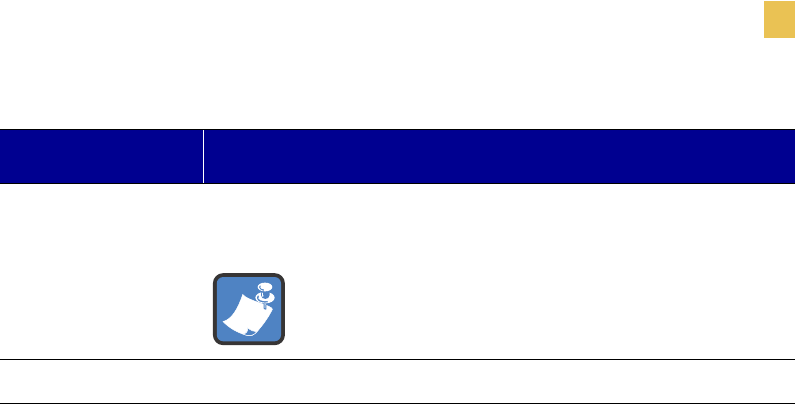
Configuration
Overview
R110/R170XiIIIPlus User Guide 55
3. Press NEXT/SAVE to select the displayed choice.
When the configuration and calibration sequence is done, PRINTER READY displays.
LOAD DEFAULTS Loads the factory defaults. To see the factory default values, see
Configuration and Calibration LCD Displays on page 57.
Note • Loading factory defaults causes the printer to
auto-calibrate.
LOAD LAST SAVE Loads values from the last permanent save.
LCD Display Description

56 R110/R170XiIIIPlus User Guide
Configuration
Password-Protected Parameters
Password-Protected Parameters
Certain parameters are password-protected by factory default, including the communication
parameters.
The first time that you attempt to change a password-protected parameter, the printer displays
ENTER PASSWORD. Before you can change the parameter, you must enter the four-digit
password. After you have entered the password correctly, you do not have to enter it again
unless you leave Setup Mode by pressing SETUP/EXIT or by turning the printer Off (O).
To Enter a Password for a Password-Protected Parameter, complete
these steps:
1. At the password prompt, use the left oval to change the selected digit position.
2. When you have selected the digit that you wish to change, use the right oval to increase
the selected digit value. Repeat these two steps for each digit of the password.
3. After entering the password, press NEXT/SAVE.
The parameter you selected to change is displayed. If the password was entered
correctly, you can change the value.
Default Password Value
The default password value is 1234. The password can be changed using the ^KP (Define
Password) ZPL II instruction or through ZebraLink™ WebView (ZebraNet®PrintServer II
required).
Disable the Password Protection Feature
You can disable the password protection feature so that it no longer prompts you for a
password by setting the password to 0000 via the ^KPØ ZPL/ZPL II command. To reenable
the password-protection feature, send the ZPL/ZPL II command ^KPx, where x can be any
number from 1 to 9999.
Note • If the parameters are set incorrectly, the printer may function unpredictably.
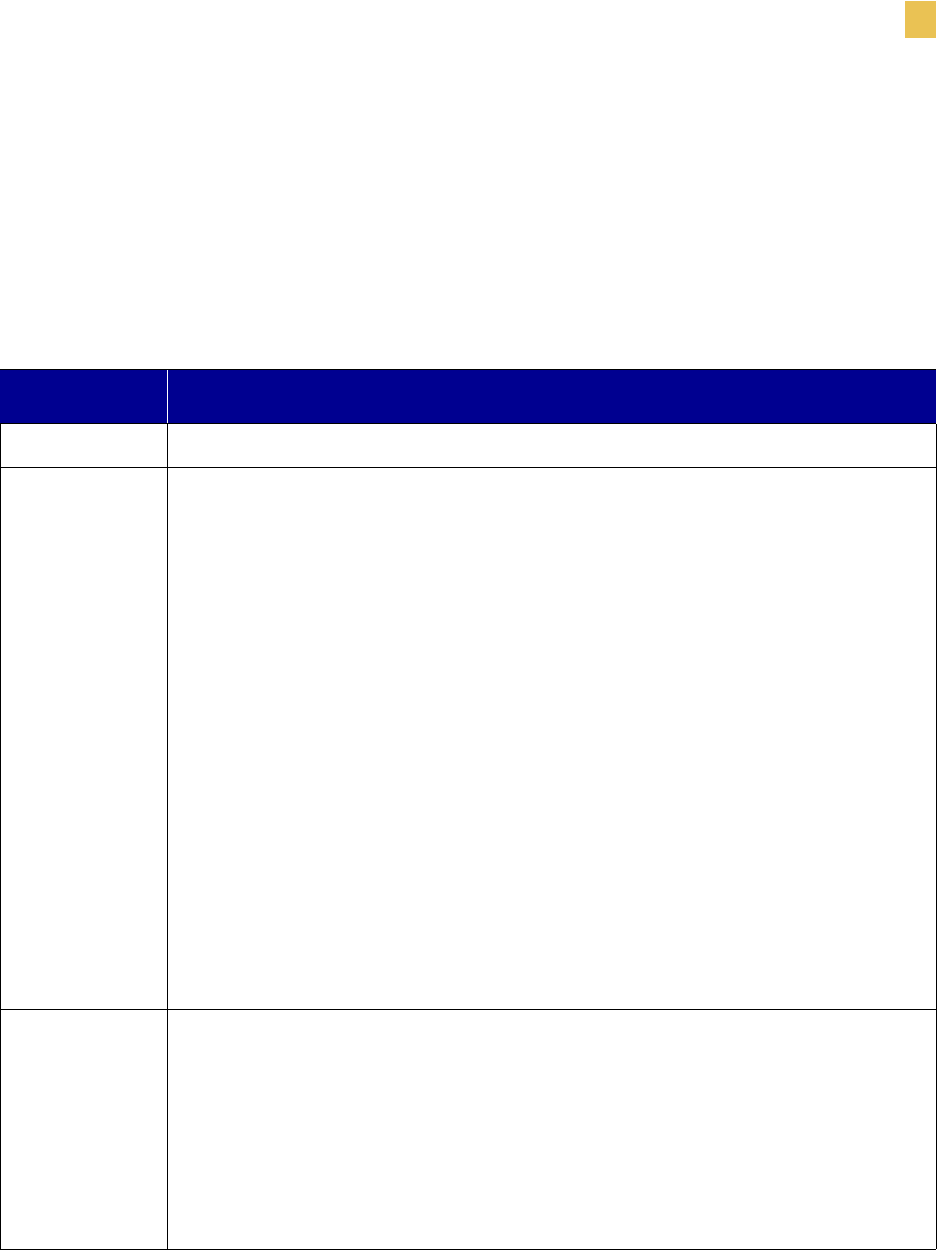
Configuration
Configuration and Calibration LCD Displays
R110/R170XiIIIPlus User Guide 57
Configuration and Calibration LCD Displays
Use the LCD display on the front panel to adjust printer settings. Table 1 lists parameters in
the order in which they are displayed when you press NEXT/SAVE after entering setup
mode. Table 2 on page 76 lists parameters that are specific to ZebraNet® PrintServer II.
Throughout this process, press NEXT/SAVE to continue to the next parameter, or press
PREVIOUS to return to the previous parameter in the cycle.
Table 1• Front Panel LCD Messages (Page 1 of 19)
LCD Description
PRINTER READY This message displays after the Power-On Self Test (POST) is complete.
DARKNESS Adjusting Print Darkness
Darkness settings depend on a variety of factors, including ribbon type, labels, and the
condition of the printhead. You may adjust the darkness for consistent high-quality
printing.
If printing is too light, or if there are voids in printed areas, you should increase the
darkness. If printing is too dark, or if there is spreading or bleeding of printed areas,
you should decrease the darkness. Darkness settings also may be changed by the
driver or software settings.
The FEED Self Test described in the FEED Self Test on page 134 can also be used to
determine the best darkness setting. Because the darkness setting takes effect
immediately, you can see the results on labels that are currently printing.
Caution • Set the darkness to the lowest setting that provides good print quality. If
the darkness is set too high, the ink may smear, or the ribbon may burn through.
• Press the right oval to increase darkness.
• Press the left oval to decrease darkness.
Default: +4
Range: 0 to +30.0
PRINT SPEED Adjusting Print Speed
Slower print speeds typically yield better print quality. Print speed changes take effect
upon exiting the menu mode.
• Press the right oval to increase print speed.
• Press the left oval to decrease print speed.
Default: 2 ips
Range: 2 ips to +12 ips (depends on specific printer)
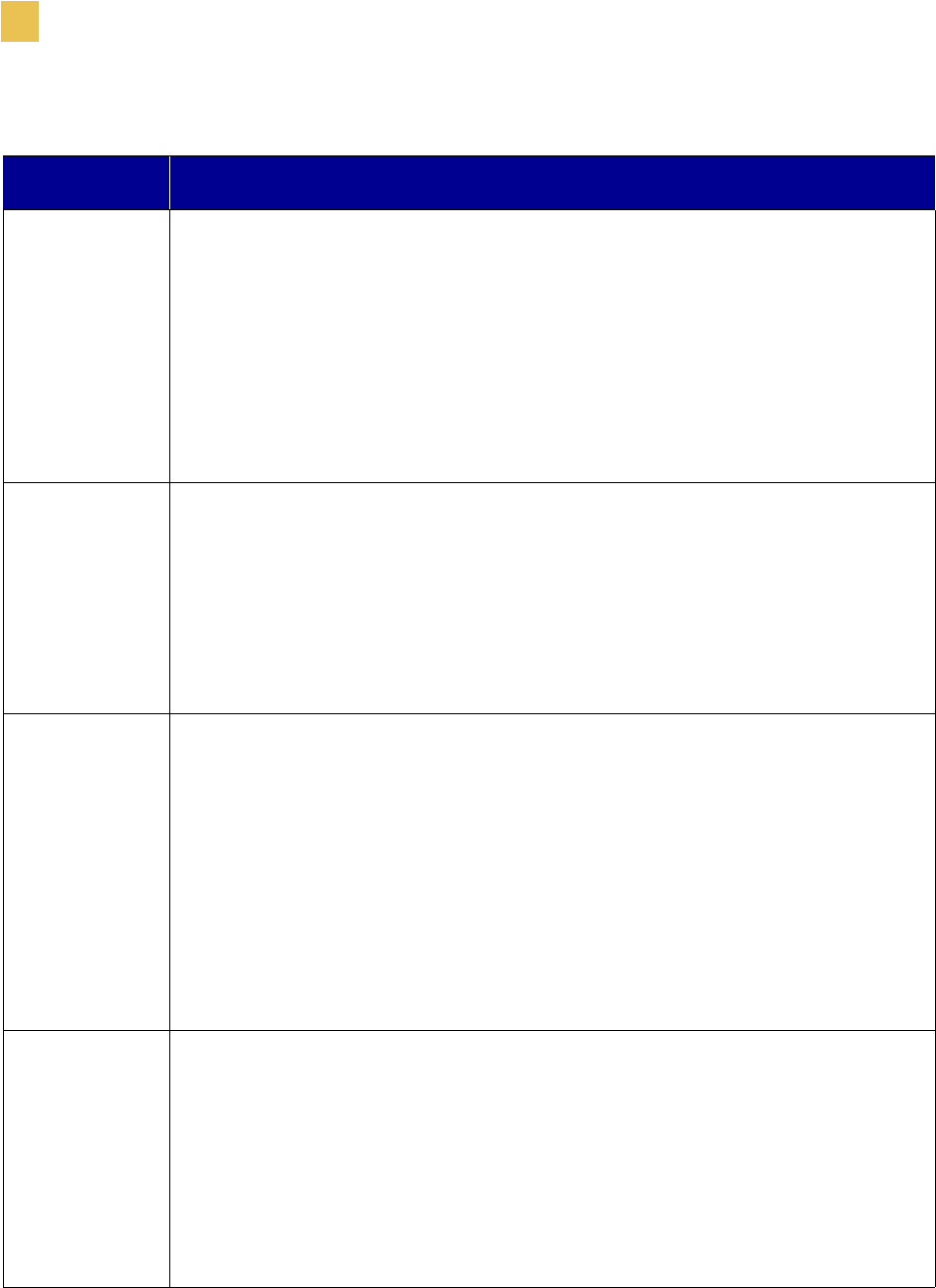
58 R110/R170XiIIIPlus User Guide
Configuration
Configuration and Calibration LCD Displays
TEAR OFF Adjusting the Tear-Off Position
This parameter establishes the position of the labels over the tear-off/peel-off bar after
printing.
Each press of an oval adjusts the tear-off position by four dot rows.
• Press the right oval to increase value.
• Press the left oval to decrease value.
Default: +0
Range: –120 to +120
PRINT MODE Selecting Print Mode
Print mode settings tell the printer the method of label delivery that you wish to use.
Be sure to select a print mode that your hardware configuration supports because
some of the selections displayed are for optional printer features.
• Press either oval to display choices.
Default: Tear-off
Selections: Tear-off, peel-off, cutter, rewind, applicator
MEDIA TYPE Setting Media Type
This parameter tells the printer the type of media that you are using. Selecting
continuous media requires that you include a label length instruction in your label
format (^LLxxxx if you are using ZPL or ZPL II).
When non-continuous media is selected, the printer feeds media to calculate label
length (the distance between two recognized registration points of the inter-label gap,
webbing, or alignment notch or hole).
• Press either oval to display choices.
Default: Continuous
Selections: Continuous, non-continuous
SENSOR TYPE Setting the Sensor Type
This parameter tells the printer whether you are using media with a web (gap/space
between labels, notch, or hole) to indicate the separations between labels or if you are
using media with a black mark printed on the back. If your media does not have black
marks for registration on the back, leave your printer at the default (web).
• Press either oval to display other choices.
Default: Web
Selections: Web, mark
Table 1• Front Panel LCD Messages (Page 2 of 19)
LCD Description
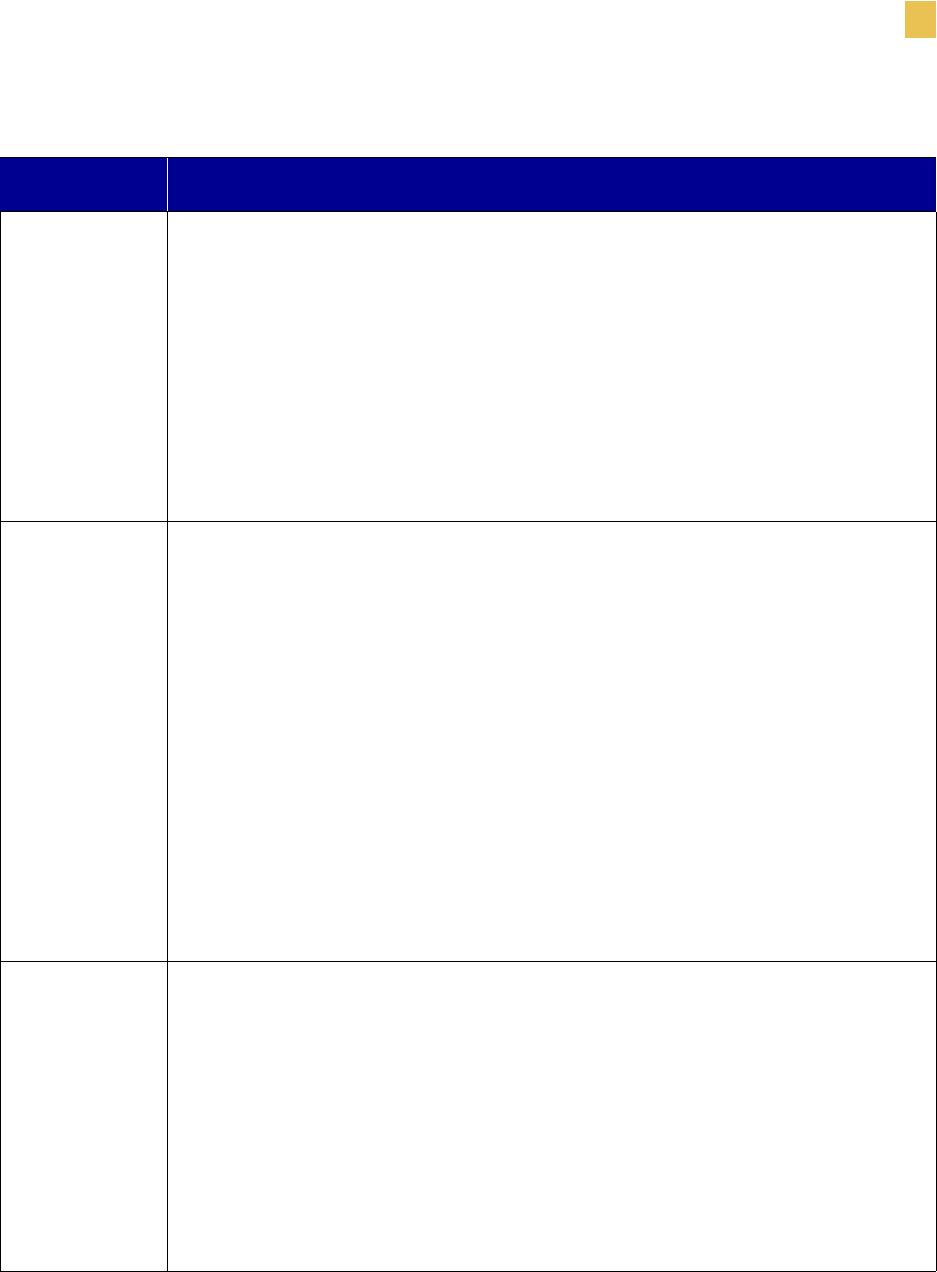
Configuration
Configuration and Calibration LCD Displays
R110/R170XiIIIPlus User Guide 59
PRINT METHOD Selecting Print Method
The print method parameter tells the printer the method of printing that you wish to
use: direct thermal (no ribbon) or thermal transfer (using thermal transfer media and
ribbon).
• Press either oval to display choices.
Default: Thermal transfer
Selections: Thermal transfer, direct thermal
Note • Selecting direct thermal when using thermal transfer media and ribbon creates
a printer error condition, but printing continues.
PRINT WIDTH Setting Print Width
Print width determines the printable area across the width of the label.
To change value shown:
1. Press the left oval to move the cursor.
2. Press the right oval to increase the value of the digit.
Note • The printer does not accept any value larger than the maximum print width
listed in General Specifications on page 141.
To change the unit of measurement:
1. Press the left oval until the unit of measurement is active.
2. Press the right oval to toggle to a different unit of measure (mm, inches, or dots).
Default Range: The default and range of acceptable values vary depending on what
printer you have. See General Specifications on page 141 for further information
about the ranges available for your model.
MAXIMUM LENGTH Setting Maximum Length
Maximum length is used in conjunction with the calibration procedure. The value of
this setting is the maximum label length that is used during the media portion of the
calibration process. Only a few labels are required to set media sensors. Always set
the value that is at least 1 in. (25.4 mm) longer than the longest label to be used on the
printer.
• To increase the value, press the right oval.
• To decrease the value, press the left oval.
Default Range: The default and range of acceptable values vary depending on your
printer’s configuration. Values are adjustable in 1 in. (25.4 mm) increments.
Table 1• Front Panel LCD Messages (Page 3 of 19)
LCD Description
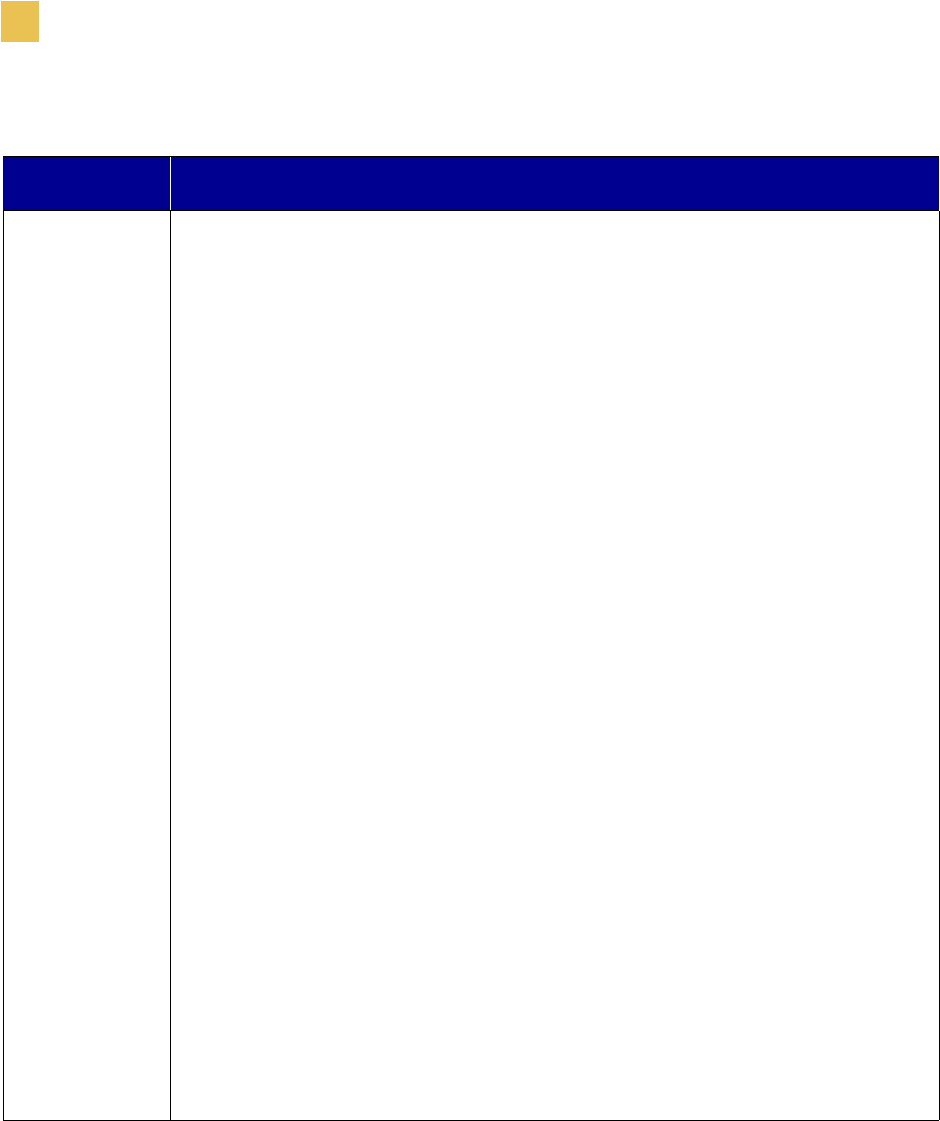
60 R110/R170XiIIIPlus User Guide
Configuration
Configuration and Calibration LCD Displays
EARLY WARNING Setting Early Warning
When this parameter is enabled, the printer provides warnings when labels or ribbons
are running low or when the printhead needs to be cleaned.
Note • Labels per roll and ribbon length need to be updated when beginning use of
the Early Warning System. Also, the printer does not make any adjustments when
power is turned off and on.
• Press the right or left oval to display other choices.
Default: Media disabled, ribbon disabled, maintenance disabled
Selections: Media disabled, media enabled, ribbon disabled, ribbon enabled,
maintenance disabled, maintenance enabled
To change the Early Warning settings,
1. When the LCD displays EARLY WARNING, press the right or left oval until the
desired setting is listed on the LCD. (If you are prompted for a password, enter
your password using the instructions in Password-Protected Parameters
on page 56.)
2. Press NEXT/SAVE to access the next early warning option.
3. Repeat this process to set the early warning for ribbon or maintenance (printhead
cleaning).
When the printer detects that less than 15% of the labels or ribbon remain, WARNING
MEDIA LOW or WARNING RIBBON LOW appears on the LCD. If the alert function has
been enabled, an alert is also sent. When the printhead is opened then closed after a
media or ribbon warning has been received, the LCD prompts with MEDIA
REPLACED? or RIBBON REPLACED?. Press the right oval to select YES to clear the
warning and reset the label counter.
Note • When setting the early warning for maintenance, an additional setting appears
after the media setting that prompts the LCD to ask HEAD CLEAN?.
1. Press the right oval to select YES.
2. Press SETUP/EXIT to exit setup mode.
3. Press NEXT/SAVE to save changes.
Table 1• Front Panel LCD Messages (Page 4 of 19)
LCD Description
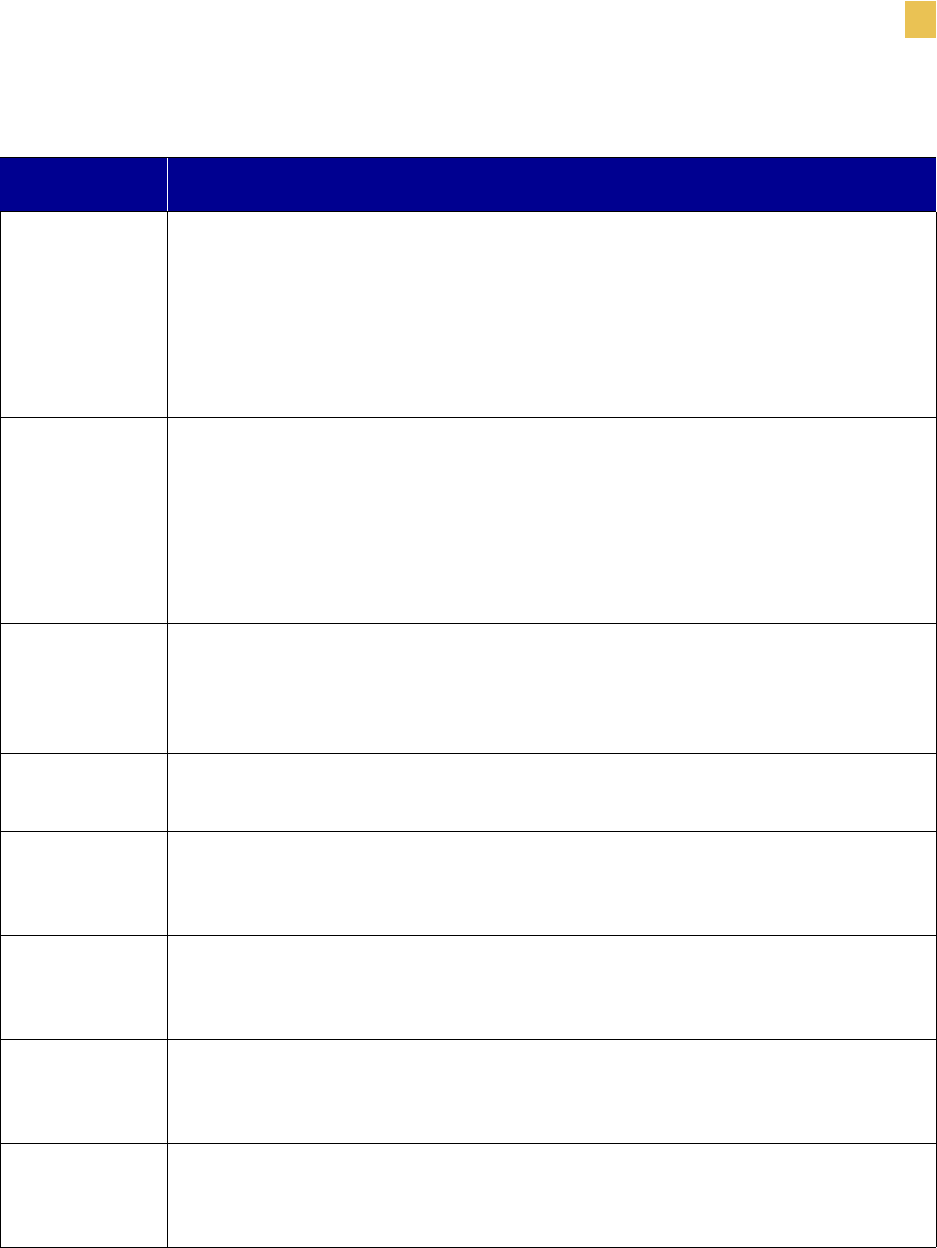
Configuration
Configuration and Calibration LCD Displays
R110/R170XiIIIPlus User Guide 61
LABELS PER
ROLL
Setting Labels Per Roll
This parameter needs to be updated when setting the Early Warning System so the
printer can provide early warnings when labels are running low.
• Press the right or left oval to display other choices.
Default: 900 labels
Range: 100 labels to 9999 labels
RIBBON LENGTH Setting Ribbon Length
This parameter must be updated when setting the Early Warning System so the printer
can provide early warnings when ribbon is running low.
• Press the right or left oval to display other choices.
Default: 450 m
Range: 100 m to 450 m
LIST FONTS List Fonts
• Press the right oval to print a label that lists the available fonts in the printer,
including standard printer fonts plus any optional fonts. Fonts may be stored in
RAM, Flash memory, font EPROMs, or font cards.
LIST BAR CODES List Bar Codes
• Press the right oval to print a label that lists the available bar codes in the printer.
LIST IMAGES List Images
• Press the right oval to print a label that lists the available images stored in the
printer’s RAM, Flash memory, optional EPROM, or optional memory card.
LIST FORMATS List Formats
• Press the right oval to print a label that lists the available formats stored in the
printer’s RAM, Flash memory, optional EPROM, or optional memory card.
LIST SETUP List Setup
• Press the right oval to print a label that lists the current printer configuration. (Same
as CANCEL Self Test as shown in CANCEL Self Test on page 132.)
LIST ALL List All
• Press the right oval to print a label that lists the available fonts, bar codes, images,
formats, and the current printer configuration.
Table 1• Front Panel LCD Messages (Page 5 of 19)
LCD Description
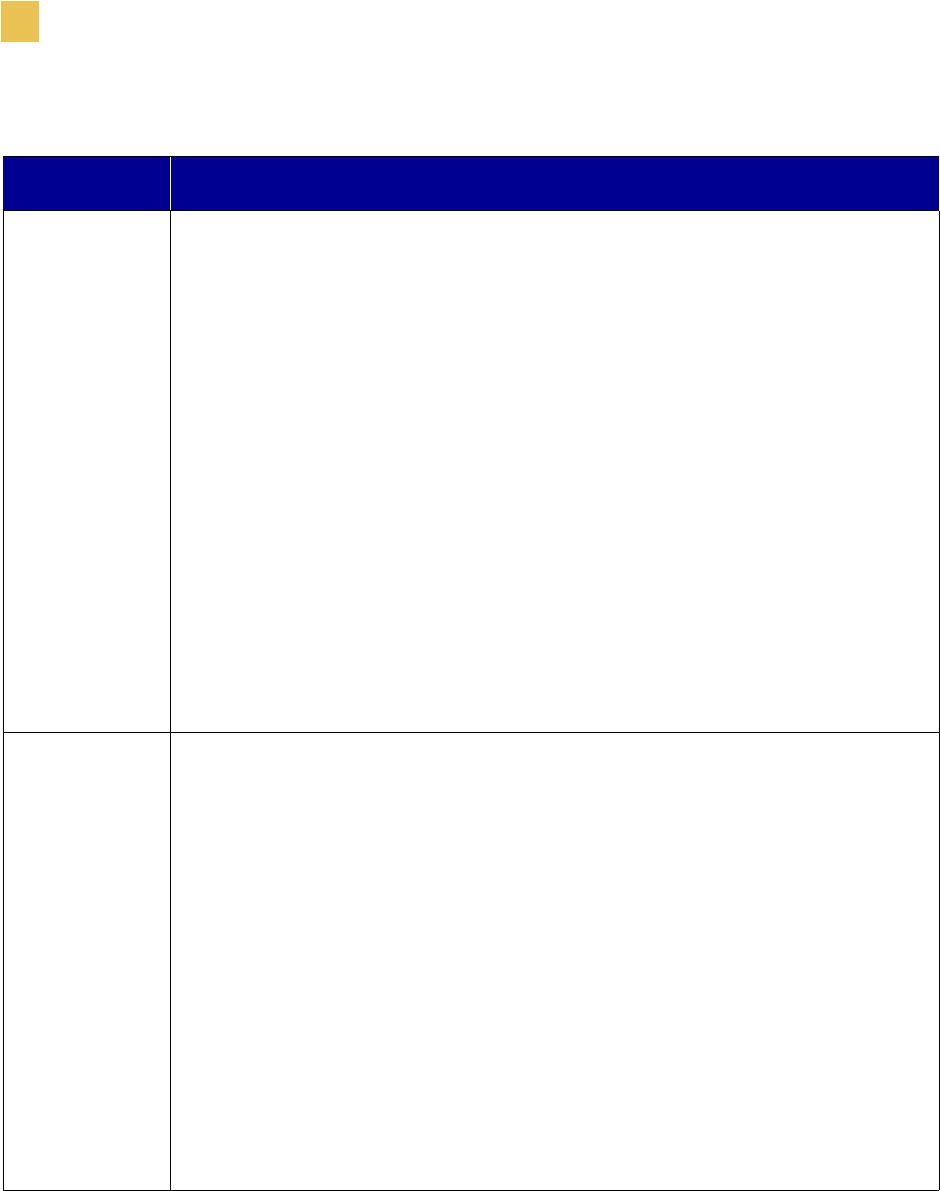
62 R110/R170XiIIIPlus User Guide
Configuration
Configuration and Calibration LCD Displays
INITIALIZE CARD
A B
Initialize Memory Card
Caution • Perform this operation only when it is necessary to erase all previously
stored information from the memory card.
1. When the LCD displays INITIALIZE CARD, press the left oval to select the A
memory (internal CompactFlash) or the right oval to select B memory (PCMCIA
card). (If you are prompted for a password, enter your password using the
instructions in Password-Protected Parameters on page 56.)
The front panel LCD asks ARE YOU SURE?.
2. Do you wish to continue?
• Press the left oval to select NO to cancel the request and return to INITIALIZE CARD
prompt.
• Press the right oval to select YES and begin initialization.
FORMATTING CARD displays.
When formatting is complete, INITIALIZE CARD displays.
Note • Depending on the amount of memory in the memory card, initialization may
take up to three minutes to complete.
INIT FLASH MEM Initialize Flash Memory
Caution • Perform this operation only when it is necessary to erase all previously
stored information from Flash memory.
1. When the LCD displays INITIALIZE CARD, press the right oval to select YES. (If you
are prompted for a password, enter your password using the instructions in
Password-Protected Parameters on page 56.)
The LCD asks INITIALIZE FLASH.
2. Press the right oval YES.
The LCD asks ARE YOU SURE?.
3. Do you wish to continue?
• Press the left oval to select NO to cancel the request and return to the INIT FLASH
MEM prompt.
• Press the right oval to select YES and begin initialization.
When formatting is complete, INIT FLASH MEM displays.
Table 1• Front Panel LCD Messages (Page 6 of 19)
LCD Description
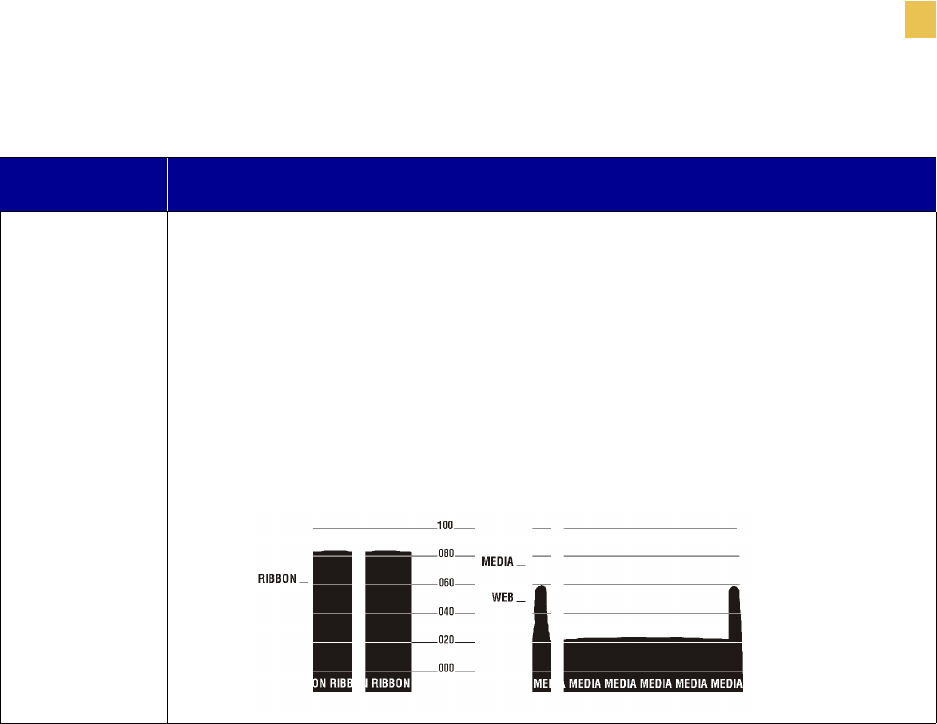
Configuration
Configuration and Calibration LCD Displays
R110/R170XiIIIPlus User Guide 63
SENSOR PROFILE Sensor Profile
The media sensor profile may be used to troubleshoot registration problems that may
be caused when the media sensor detects preprinted areas on the media or experiences
difficulty in determining web location.
• Press the right oval to start this standard calibration procedure and print a media
sensor profile.
See the media sensor profile below. If the sensitivity of the media and/or ribbon
sensors must be adjusted, use Calibrate Media and Ribbon Sensors on page 64 to
adjust the media and ribbon sensor sensitivity.
Media Sensor Profile
Table 1• Front Panel LCD Messages (Page 7 of 19)
LCD Description
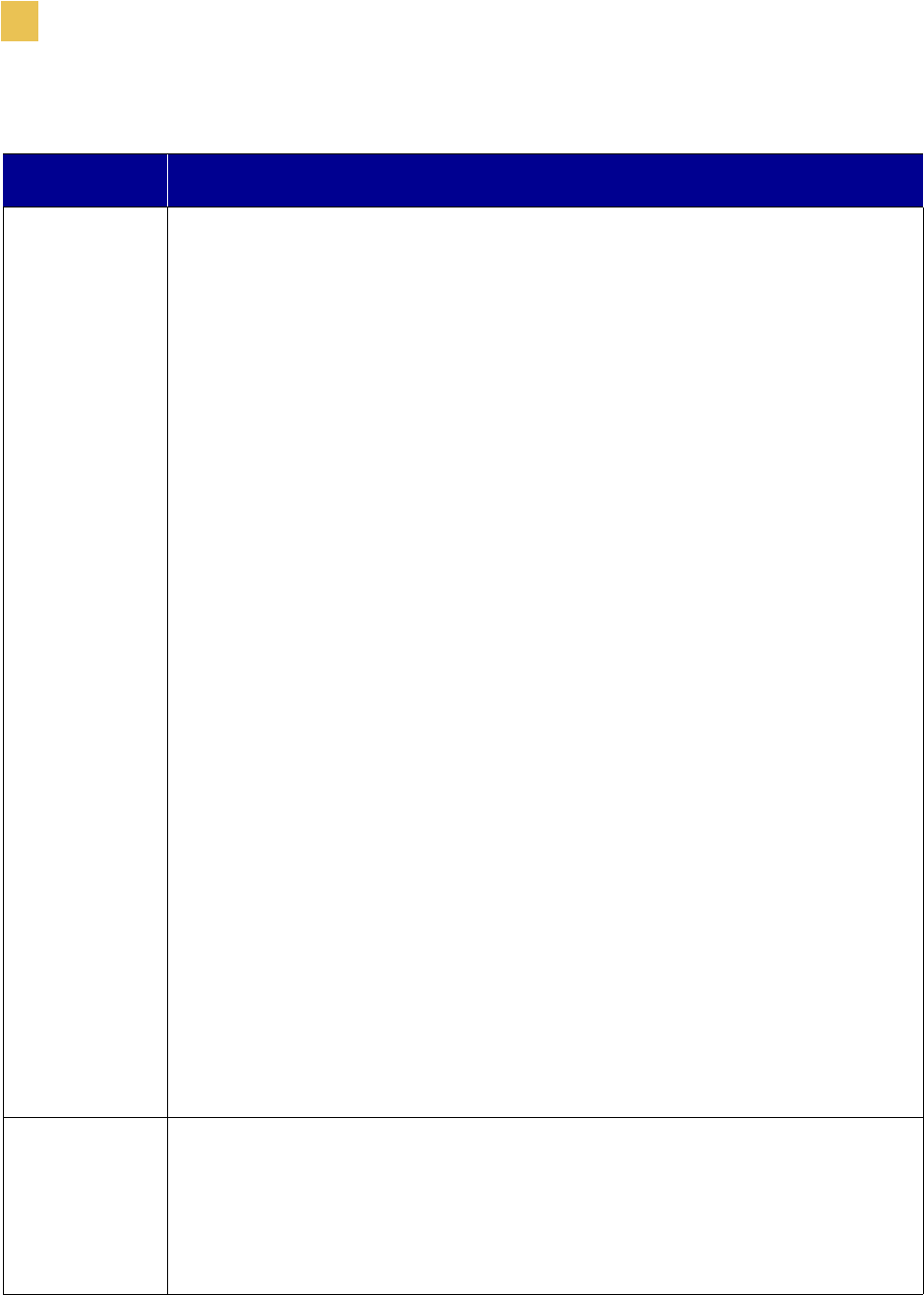
64 R110/R170XiIIIPlus User Guide
Configuration
Configuration and Calibration LCD Displays
MEDIA AND
RIBBON
CALIBRATE
Calibrate Media and Ribbon Sensors
Use this procedure to adjust sensitivity of media and ribbon sensors.
Important • This procedure must be followed exactly as presented. All of the steps
must be performed even if only one of the sensors requires adjustment. You may press
the left oval at any step in this procedure to cancel the procedure.
1. Press the right oval to start the calibration procedure.
The LOAD BACKING prompt displays.
2. Open the printhead.
3. Remove approximately 8 in. (203 mm) of labels from the backing, and pull the
media into the printer so that only the backing is between the media sensors.
4. Leave the printhead open.
5. Press the right oval to continue.
The REMOVE RIBBON prompt displays.
6. Remove the ribbon.
7. Close the printhead.
8. Press the right oval to continue.
The message CALIBRATING PLEASE WAIT displays.
The printer adjusts the scale (gain) of the signals that it receives from the media and
ribbon sensors. On the sensor profile, this essentially corresponds to moving the
peak of the graph up or down to optimize the readings for your application.
When calibration is complete, RELOAD ALL displays.
9. Open the printhead and pull the media forward until a label is positioned under
the media sensor.
10. Reload the ribbon.
11. Close the printhead.
12. Press the right oval to continue.
The printer does a calibration equivalent to pressing CALIBRATE; during this
process, the printer determines the label length. To see the new readings on the new
scale, print a sensor profile.
PARALLEL COMM Setting Parallel Communications
Select the communications port that matches the one being used by the host computer.
• Press the right or left oval to display other choices.
Default: Bidirectional
Selections: Bidirectional, unidirectional, or Twinax/coax
Table 1• Front Panel LCD Messages (Page 8 of 19)
LCD Description
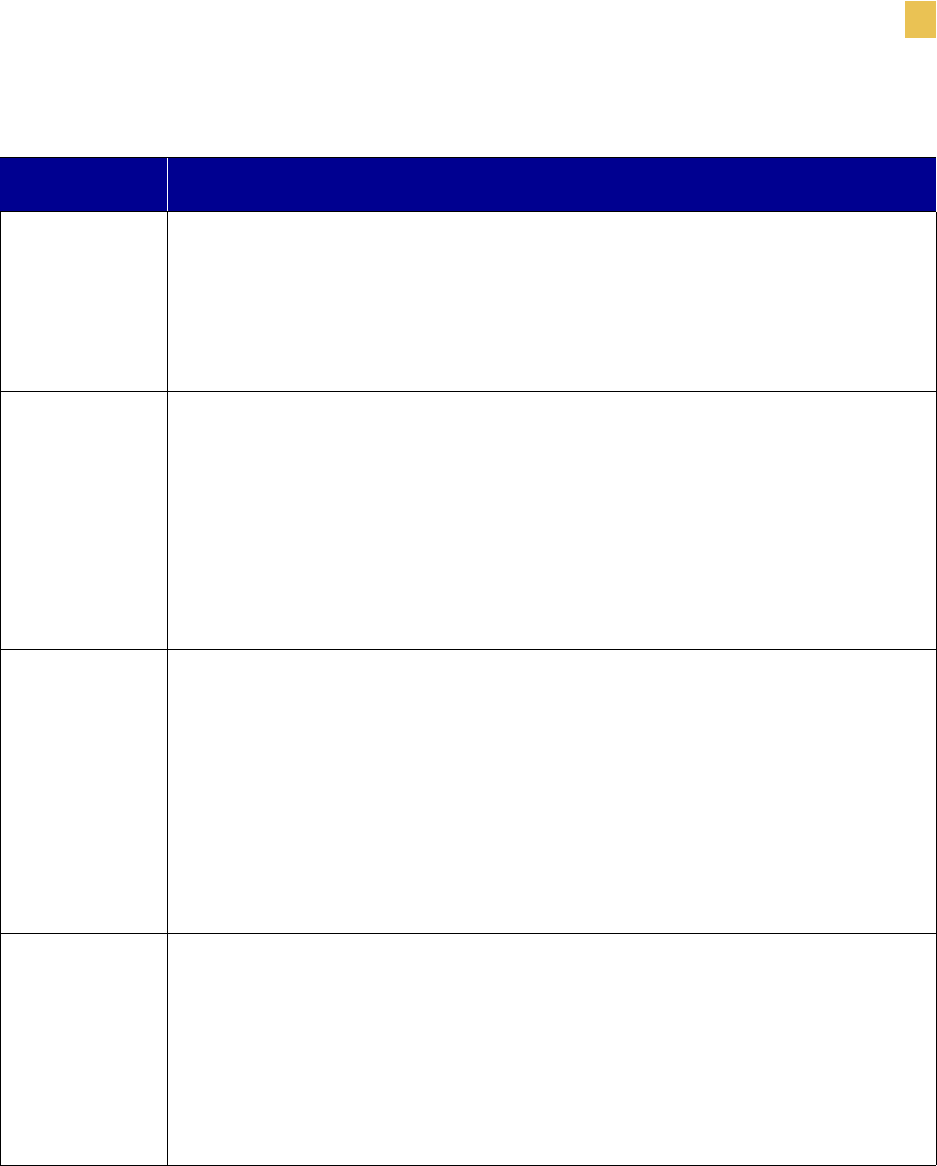
Configuration
Configuration and Calibration LCD Displays
R110/R170XiIIIPlus User Guide 65
SERIAL COMM Setting Serial Communications
Select the communications port that matches the one being used by the host computer.
• Press the right or left oval to display other choices.
Default: RS-232
Selections: RS-232, RS-422/485, RS-485 multidrop
BAUD Setting Baud
The baud setting of the printer must match the baud setting of the host computer for
accurate communications to take place. Select the value that matches the one being
used by the host computer.
• Press the right or left oval to display other choices.
Default: 9600
Selections: 110, 300, 600, 1200, 2400, 4800, 9600, 14400, 19200, 28800, 38400,
57600, 115200
DATA BITS Setting Data Bits
The data bits of the printer must match the data bits of the host computer for accurate
communications to take place. Set the data bits to match the setting being used by the
host computer.
Note • Code Page 850 requires the data bits to be set to 8 bits.
• Press the right or left oval to display other choices.
Default: 8 bits
Selections: 7bits, 8bits
PARITY Setting Parity
The parity of the printer must match the parity of the host computer for accurate
communications to take place. Select the parity that matches the one being used by
the host computer.
• Press the right or left oval to display other choices.
Default: None
Selections: None, Even, Odd
Table 1• Front Panel LCD Messages (Page 9 of 19)
LCD Description
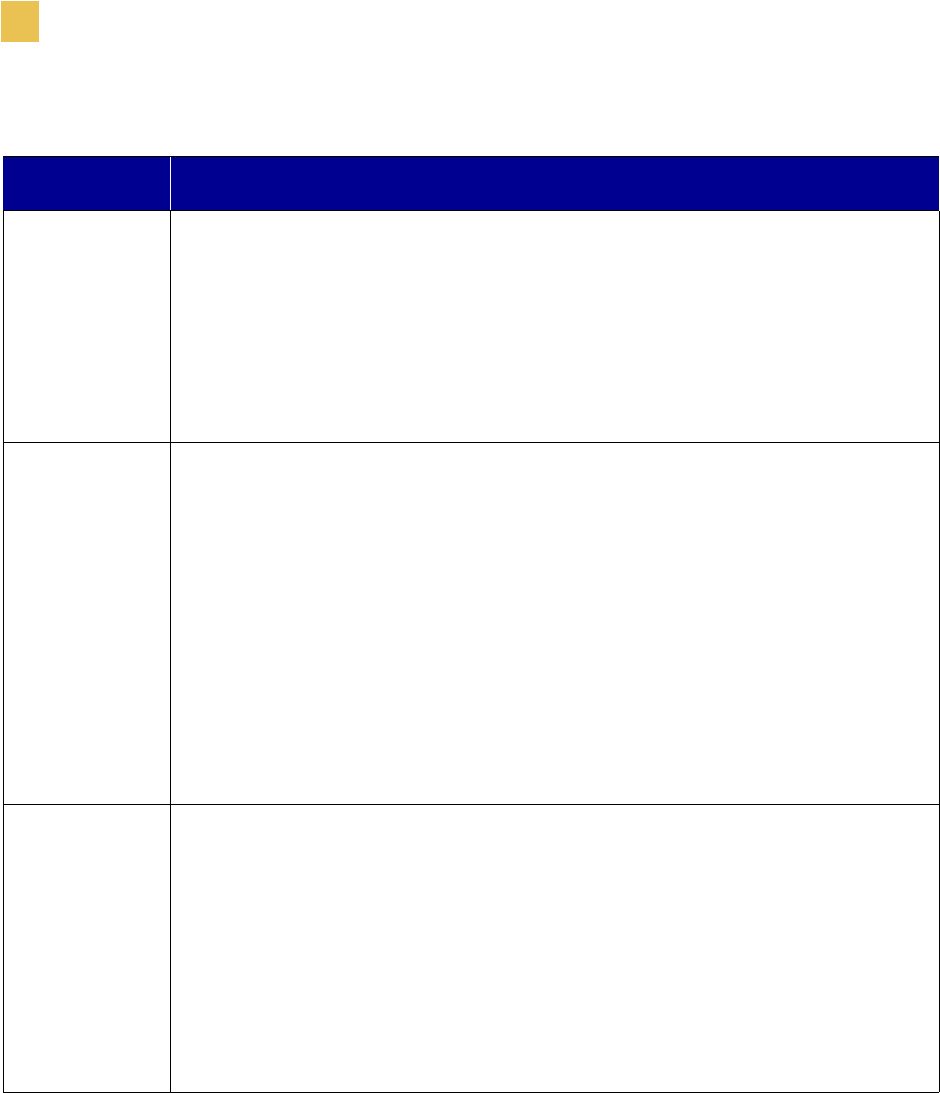
66 R110/R170XiIIIPlus User Guide
Configuration
Configuration and Calibration LCD Displays
HOST
HANDSHAKE
Setting Host Handshake
The handshake protocol of the printer must match the handshake protocol of the host
computer for proper communications to take place. Select the handshake protocol that
matches the one being used by the host computer.
• Press the right or left oval to display other choices.
Default: XON/XOFF
Selections: XON/XOFF, RTS/CTS, DTR/DSR
PROTOCOL Setting Protocol
Protocol is a type of error checking system. Depending on the selection, an indicator
may be sent from the printer to the host computer signifying that data has been
received. Select the protocol that is requested by the host computer. Further details on
protocol can be found in the ZPL II Programming Guide.
• Press the right or left oval to display other choices.
Default: None
Selections: None, Zebra, ACK/NACK
Note • Zebra is the same as ACK/NACK, except that Zebra response messages are
sequenced. If Zebra is selected, the printer must use DTR/DSR host handshake
protocol.
NETWORK ID Setting Network ID
Network ID is used to assign a unique number to a printer used in an RS-422/RS-485
network. This gives the host computer the means to address a specific printer. If the
printer is used in an RS-422/RS-485 network, you must select a network ID number.
This does not affect TCP/IP or IPX networks.
1. Press the left oval to move to the next digit position.
2. Press the right oval to increase the value of the digit.
Default: 000
Range: 000 to 999
Table 1• Front Panel LCD Messages (Page 10 of 19)
LCD Description
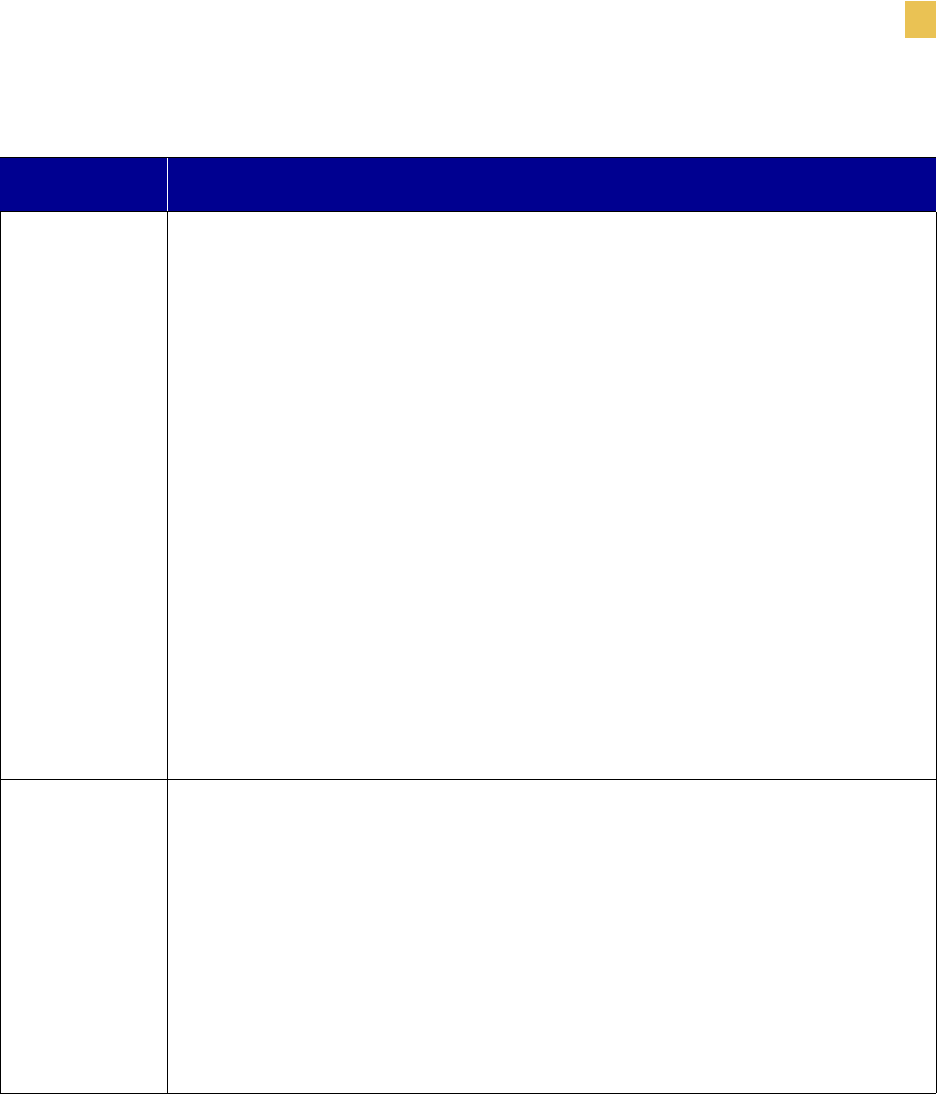
Configuration
Configuration and Calibration LCD Displays
R110/R170XiIIIPlus User Guide 67
COMMUNICA-TIONS Setting Communications Mode
The communication diagnostics mode is a troubleshooting tool for checking the
interconnection between the printer and the host computer. When DIAGNOSTICS is
selected, all data sent from the host computer to the printer is printed as straight
ASCII characters, with the hex value below the ASCII text. The printer prints all
characters received, including control codes, like CR (carriage return). A sample
printout is shown in Communications Diagnostics Test on page 135.
Notes on diagnostic printouts are:
• FE indicates a framing error.
• OE indicates an overrun error.
• PE indicates a parity error.
• NE indicates noise.
1. Press the right or left oval to toggle between the choices.
2. For any errors, check that your communication parameters are correct.
3. Set the print width equal to or less than the label width used for the test. See Label
Specifications on page 146 for more information.
Default: Normal mode
Selections: Normal mode, diagnostics
CONTROL PREFIX Control Prefix Character
The printer looks for this two-digit hex character to indicate the start of a ZPL/ZPL II
control instruction.
Note • Do not use the same hex value for the control, format, and delimiter character.
The printer must see different characters to work properly.
1. Press the left oval to move to the next digit position.
2. Press the right oval to increase the value of the digit.
Default: 7E (tilde—displayed as a black square)
Range: 00 to FF
Table 1• Front Panel LCD Messages (Page 11 of 19)
LCD Description
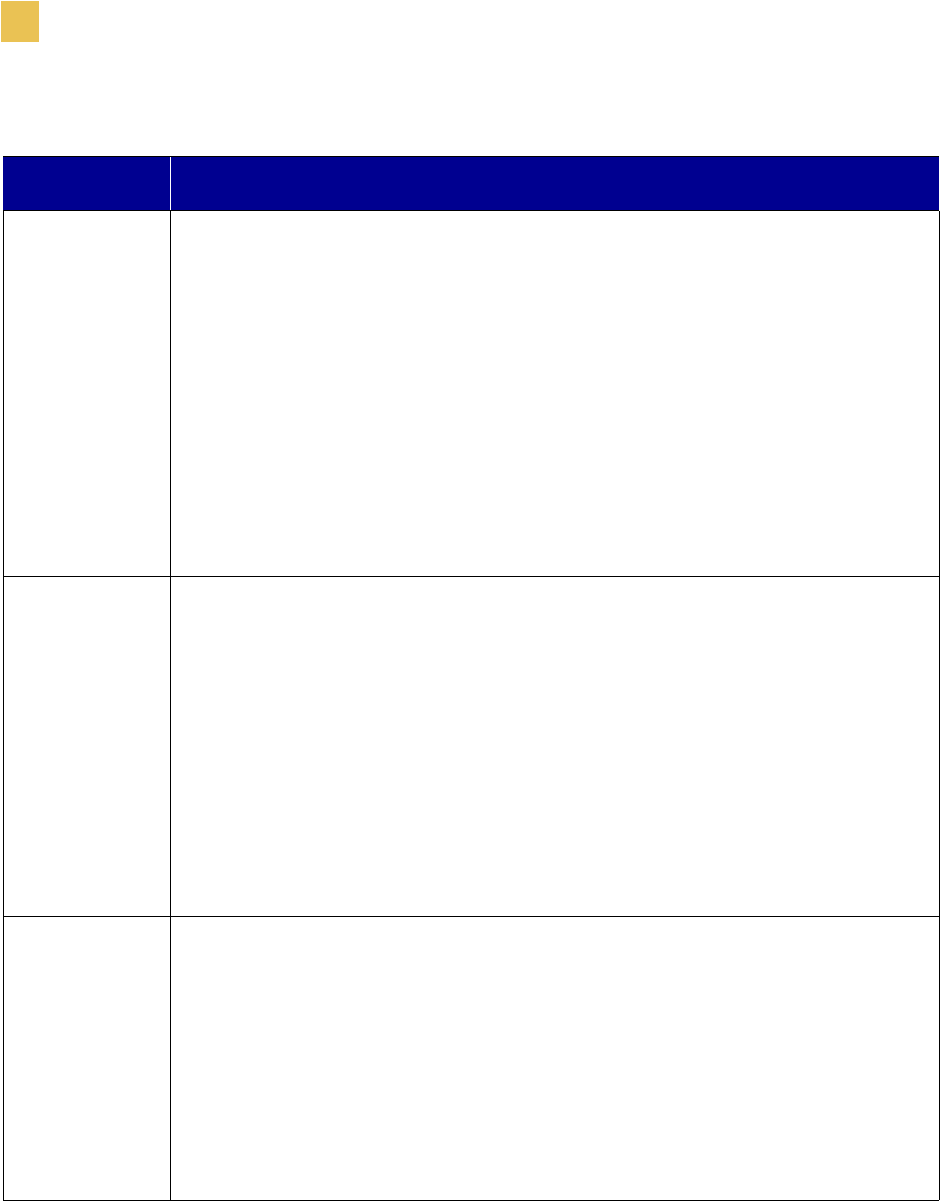
68 R110/R170XiIIIPlus User Guide
Configuration
Configuration and Calibration LCD Displays
FORMAT PREFIX Format Prefix Character
The format prefix is a two-digit hex value used as a parameter place marker in
ZPL/ZPL II format instructions. The printer looks for this 2-digit hex character to
indicate the start of a ZPL/ZPL II format instruction. See the ZPL II Programming
Guide Volume I for more information.
Note • Do not use the same hex value for the control, format, and delimiter character.
The printer must see different characters to work properly.
1. Press the left oval to move to the next digit position.
2. Press the right oval to increase the value of the digit.
Default: 5E (caret)
Range: 00 to FF
DELIMITER CHAR Delimiter Character
The delimiter character is a 2-digit hex value used as a parameter place marker in
ZPL/ZPL II format instructions. See the ZPL II Programming Guide Volume I for
more information.
Note • Do not use the same hex value for the control, format, and delimiter character.
The printer must see different characters to work properly.
1. Press the left oval to move to the next digit position.
2. Press the right oval to increase the value of the digit.
Default: 2C (comma)
Range: 00 to FF
ZPL MODE Selecting ZPL Mode
The printer remains in the selected mode until it is changed by this front panel
instruction or by using a ZPL/ZPL II command. The printer accepts label formats
written in either ZPL or ZPL II. This eliminates the need to rewrite any ZPL formats
you already have. See the ZPL II Programming Guide for more information on the
differences between ZPL and ZPL II.
• Press the right or left oval to display other choices.
Default: ZPL II
Selections: ZPL II, ZPL
Table 1• Front Panel LCD Messages (Page 12 of 19)
LCD Description
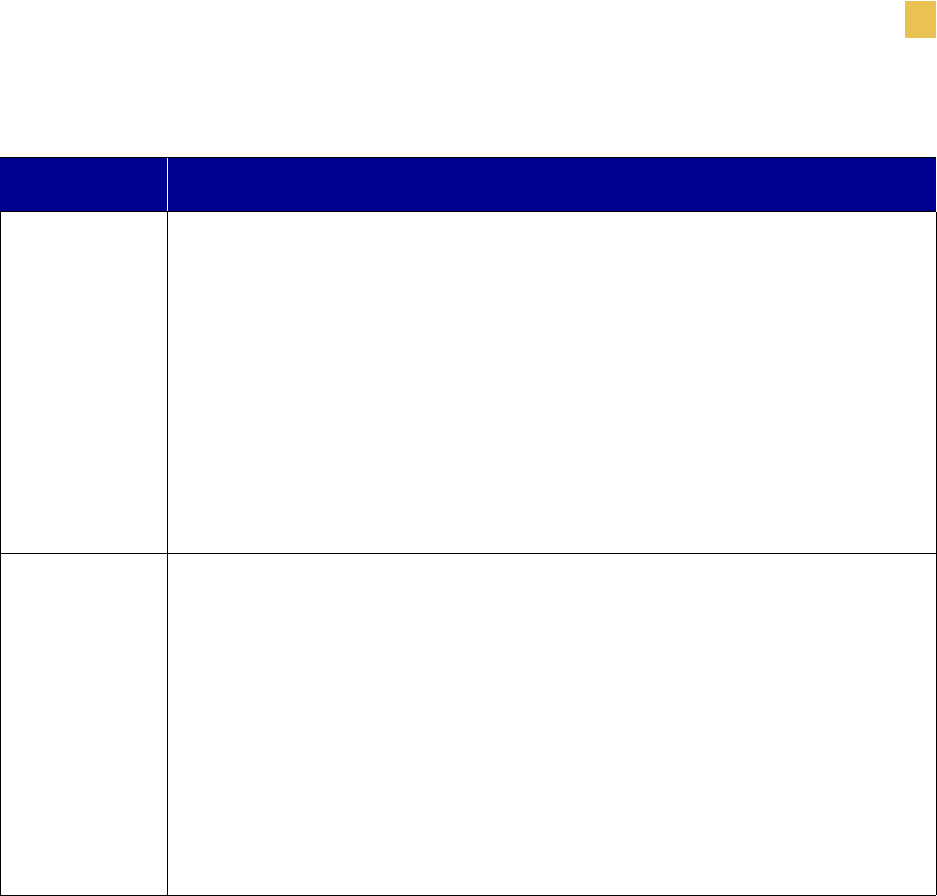
Configuration
Configuration and Calibration LCD Displays
R110/R170XiIIIPlus User Guide 69
MEDIA POWER UP Media Power Up
This parameter sets the action of the labels when the printer is turned on.
• Press the right or left oval to display the choices.
Default: Calibration
Selections: Feed, Calibration, Length, and No Motion
• Feed—feeds the labels to the first registration point.
• Calibration—determines the length of the label.
• Length—used in continuous mode to feed the last stored label length.
• No Motion—the media does not move. You must press FEED to cause the
printer to resynch to the start of the next label.
HEAD CLOSE Head Close
This parameter sets the action of the labels when the printhead is closed.
• Press the right or left oval to display the choices.
Default: Calibration
Selections: Feed, Calibration, Length, and No Motion
• Feed—feeds the labels to the first registration point.
• Calibration—determines the length of the label.
• Length—used in continuous mode to feed the last stored label length.
• No Motion—the media does not move. You must press FEED to cause the
printer to resynch to the start of the next label.
Table 1• Front Panel LCD Messages (Page 13 of 19)
LCD Description
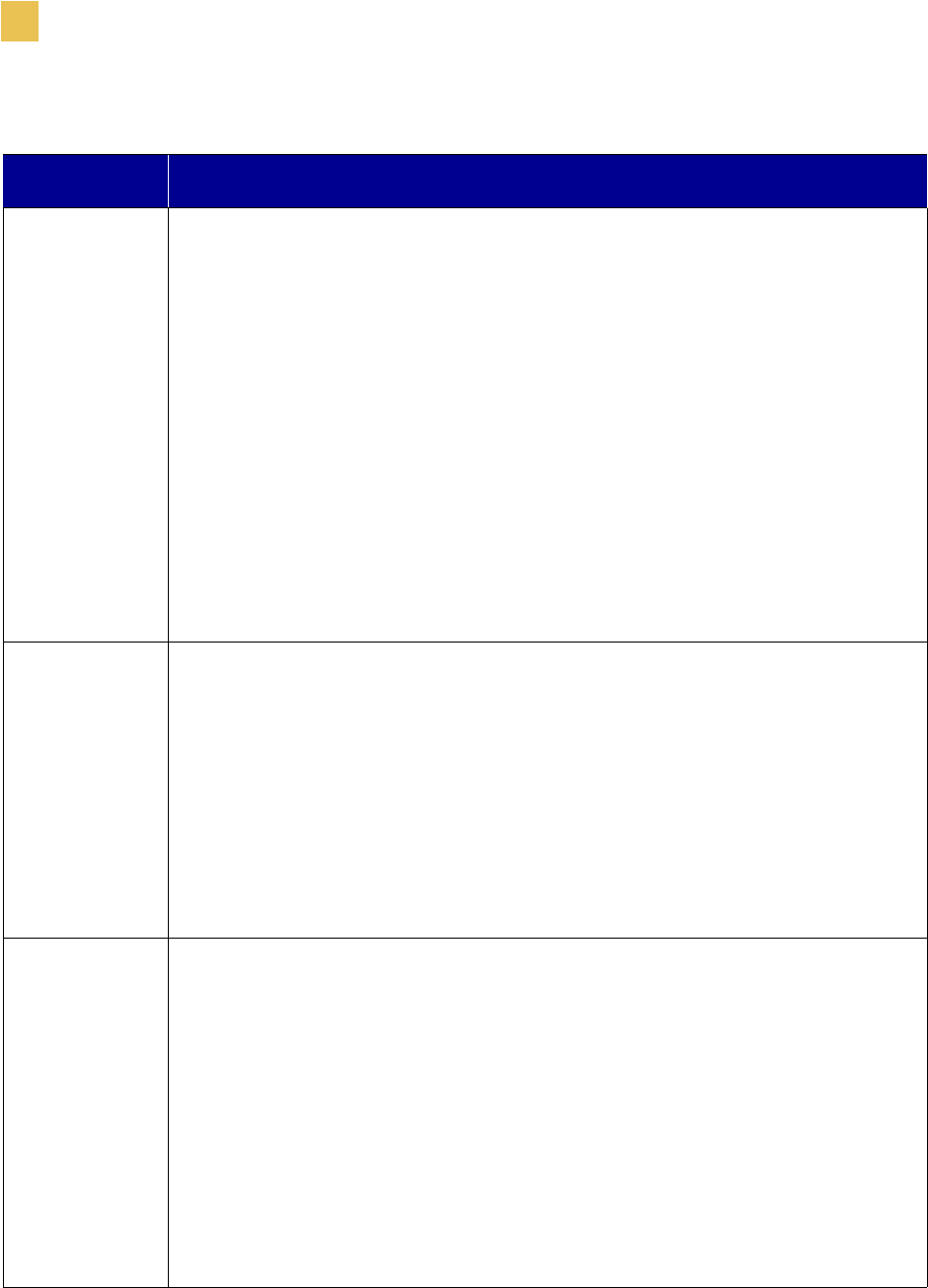
70 R110/R170XiIIIPlus User Guide
Configuration
Configuration and Calibration LCD Displays
BACKFEED Backfeed Sequence
This parameter establishes when and how much label backfeed occurs after a label is
removed or cut in Peel-Off, Cutter, and Applicator Modes. It has no effect in Rewind
or Tear-Off Modes. This parameter setting can be superseded by the ~JS instruction
when received as part of a label format (see the ZPL II Programming Guide).
Note • The difference between the value entered and 100% establishes how much
backfeed occurs before the next label prints. For example, a value of 40 means that
40% of the backfeed takes place after the label is removed or cut. The remaining 60%
takes place before the next label prints. A value of BEFORE means that all backfeed
takes place before the next label prints.
• Press the right or left oval to display other choices.
Default: Default (90%)
Selections: Default, after, before, 10%, 20%, 30%, 40%, 50%,
60%, 70%, 80%, off
LABEL TOP Adjusting Label Top Position
The label top position adjusts the print position vertically on the label. Positive
numbers adjust the label top position further down the label (away from the
printhead), negative numbers adjust the position up the label (toward the printhead).
The displayed value represents dots.
• To increase the value, press the right oval.
• To decrease the value, press the left oval.
Default: +0
Range: –120 to +120 dot rows
LEFT POSITION Adjusting Left Position
This parameter establishes how far from the left edge of a label the format begins to
print by adjusting horizontal positioning on the label. Positive numbers adjust the
printing to the left by the number of dots selected, negative numbers shift printing to
the right.
The displayed value represents dots.
1. Press the left oval to move the cursor.
2. Press the right oval to change between + and to increase the value of the digit.
3. For a negative value, enter the value before changing to the minus sign.
Default: 0000
Range: –9999 to +9999
Table 1• Front Panel LCD Messages (Page 14 of 19)
LCD Description
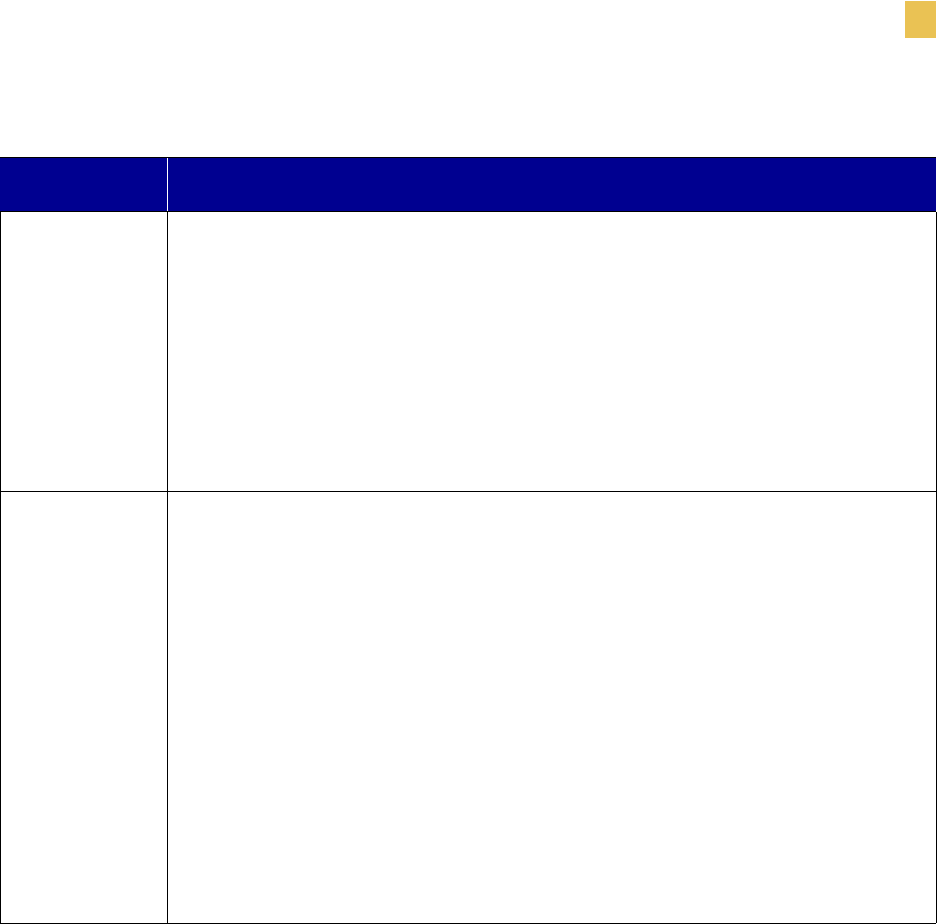
Configuration
Configuration and Calibration LCD Displays
R110/R170XiIIIPlus User Guide 71
HEAD TEST
COUNT
Setting the Head Test Count
The printer periodically performs a test of the printhead functionality, called a
printhead test or head test. This parameter establishes how many labels are printed
between these internal tests.
1. Press the left oval to move to the next digit position.
2. Press the right oval to increase the value of the digit.
Default: 0000 (disables the test)
Range: 0000 to 9999
HEAD RESISTOR Setting the Head Resistor Value
Caution • This parameter should be changed only by qualified service personnel. Do
not set the value higher than that shown on the printhead. Setting a higher value may
damage the printhead.
This value has been preset at the factory to match the resistance value of the
printhead. It does not need to be changed unless the printhead or the main logic board
is replaced.
1. Look on the printhead for the label that shows the resistance value (Ωvalue).
2. Press the left oval to move to the next digit position.
3. Press the right oval to increase the value of the digit.
Initial Value: Factory-set to match the printhead shipped with your printer.
Default Value: 0500
Range: 0500 to 2500
Table 1• Front Panel LCD Messages (Page 15 of 19)
LCD Description
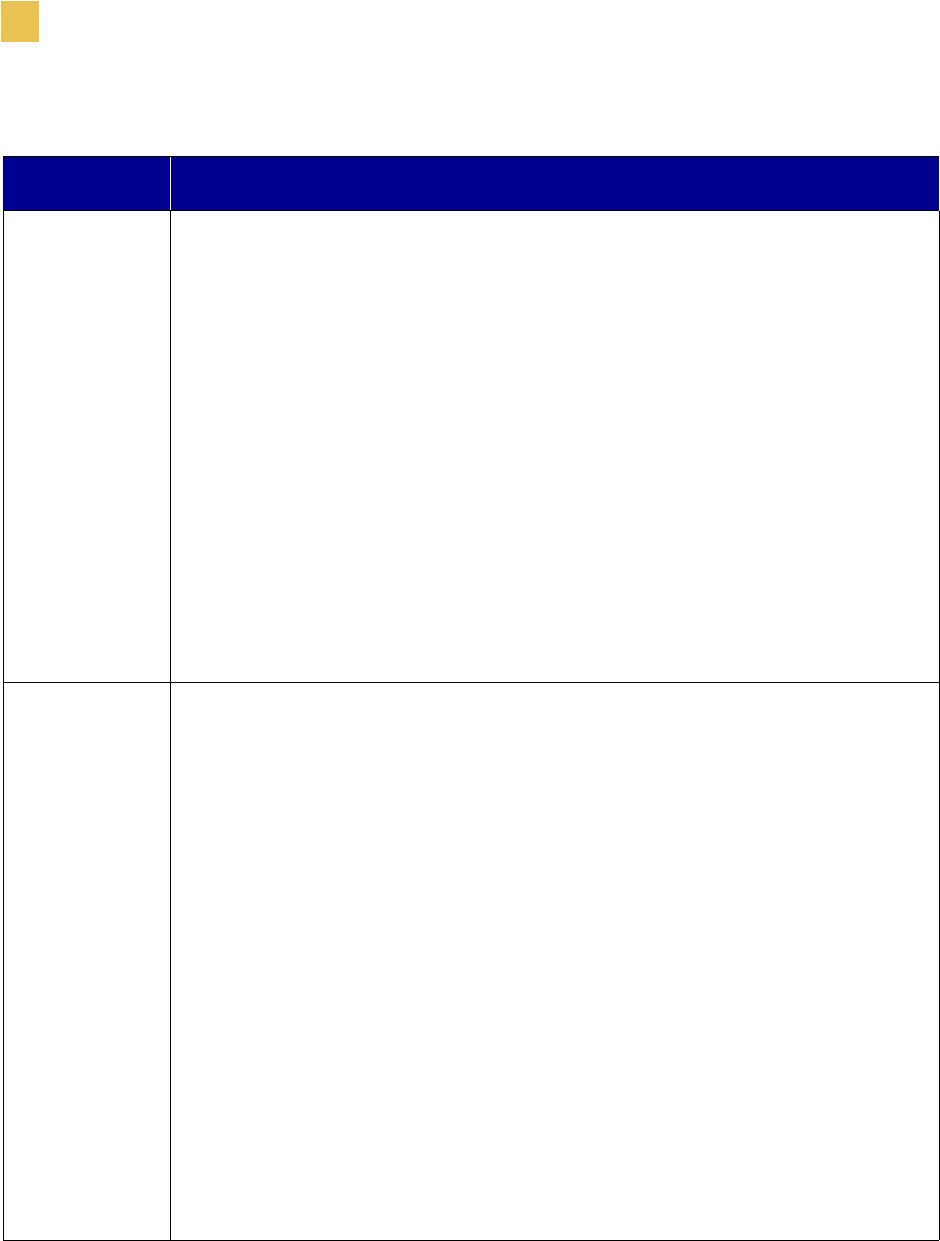
72 R110/R170XiIIIPlus User Guide
Configuration
Configuration and Calibration LCD Displays
VERIFIER PORT Setting the Verifier Port
The auxiliary port is used to determine how the printer reacts to the online verifier.
The three operating conditions for this port are:
• OFF: The verifier port is off.
• VER-RPRNT ERR: Label reprinted if verifier detects an error. If a bar code is
near the upper edge of the label, the label is fed out far enough to be verified and
then backfed to allow the next label to print and be verified.
• VER-THRUPUT: Allows greatest throughput but may not indicate a verifica-
tion error immediately upon detection. May print from one to three labels before
an error is recognized and printing stops.
• Press the right or left oval to display other choices.
Default: Off
Selections: Off, VER-RPRNT, VER-THRUPUT
For more information on the operation of the optional verifier, see the documentation
provided with that option.
APPLICATOR
PORT
Setting the Applicator Port
Determines the action of the verifier port.
Note • Set this value as suggested by the applicator manufacturer.
• Off: The applicator port is off.
• Mode 1: Asserts the ~END_PRINT signal low while the printer is moving the
label forward.
• Mode 2: Asserts the ~END_PRINT signal high while the printer is moving the
label forward.
• Mode 3: Asserts the ~END_PRINT signal low for 20 milliseconds when a label
has been completed and positioned. Not asserted during continuous printing
modes.
• Mode 4: Asserts the ~END_PRINT signal high for 20 milliseconds when a
label has been completed and positioned. Not asserted during continuous print-
ing modes.
• Press the right or left oval to display other choices.
Default: Off
Selections: Off, mode 1, mode 2, mode 3, mode 4
Table 1• Front Panel LCD Messages (Page 16 of 19)
LCD Description
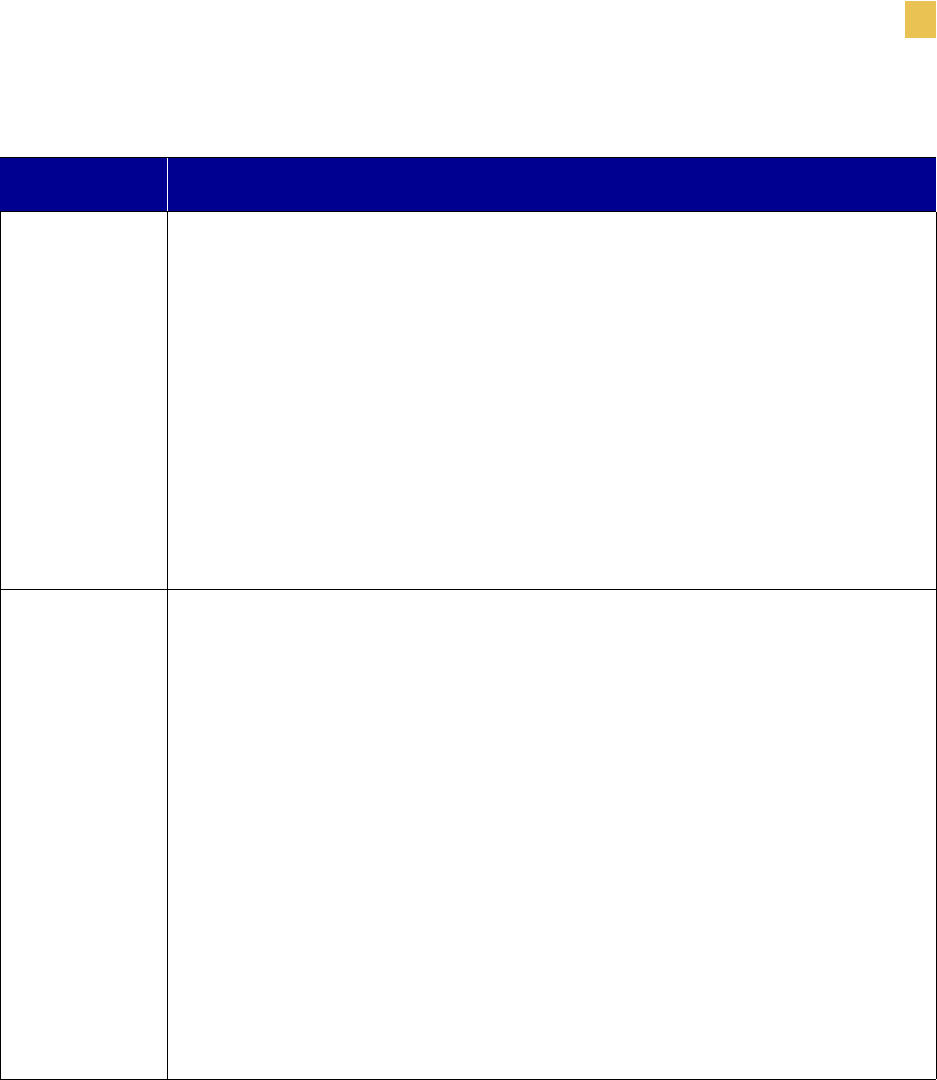
Configuration
Configuration and Calibration LCD Displays
R110/R170XiIIIPlus User Guide 73
START PRINT SIG Start Print Signal
This parameter determines how the printer reacts to the Start Print Signal input on pin
3 of the applicator interface connector at the rear of the printer.
• In Pulse Mode, labels print when the signal transitions from HIGH to LOW.
• In Level Mode, labels print as long as the signal is asserted LOW.
Caution • Start Print Signal is set by the applicator manufacturer and should not be
changed unless the factory defaults have been reloaded. The printer must be returned
to its designated setting for it to work properly.
• Press the right or left oval to display other choices.
Default: Pulse Mode
Selections: Pulse Mode, Level Mode
RESYNCH MODE Resynch Mode
This parameter determines how the printer reacts if the label synchronization is lost
and the label top is not where expected.
• Feed Mode—If the label top is not where expected, the printer feeds a blank
label to find the label top position.
• Error Mode—If the label top is not where expected, the printer stops, enters
Pause Mode, displays the message Error Condition Feed Label, flashes the
ERROR light, and asserts the Service Required signal (pin 10 on the Applicator
Interface Connector).
To resynch the media to the top of the label in Error Mode, press PAUSE to exit
Pause Mode. The ERROR light stops flashing, and the Service Required signal is
deactivated. The action of the printer is determined by the Head Close
configuration selection (see Head Close on page 69).
• Press the right or left oval to toggle between choices.
Default: Feed Mode
Selections: Feed Mode, Error Mode
Table 1• Front Panel LCD Messages (Page 17 of 19)
LCD Description
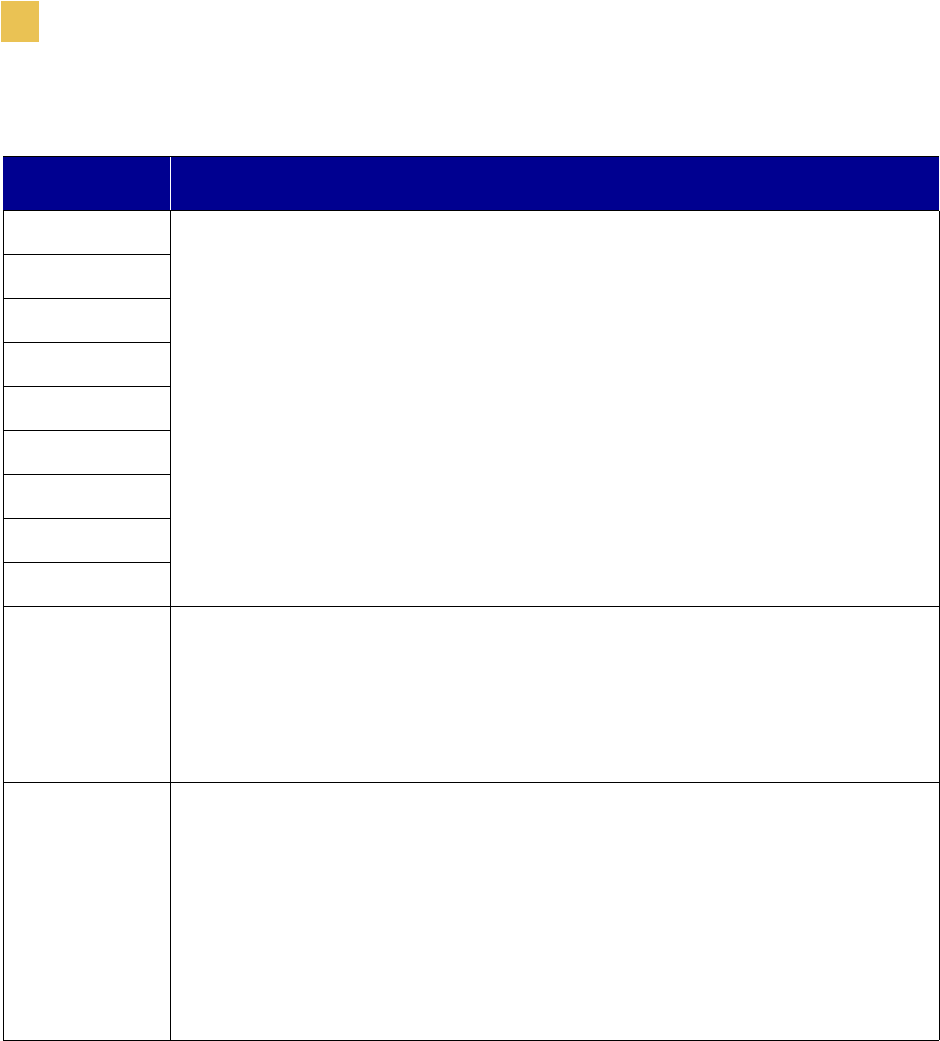
74 R110/R170XiIIIPlus User Guide
Configuration
Configuration and Calibration LCD Displays
WEB S. These parameters are automatically set during the calibration procedure. They should
be changed only by a qualified service technician. See the Maintenance Manual for
more information on these parameters.
• Press NEXT/SAVE to scroll through these parameters.
MEDIA S.
RIBBON S.
MARK S.
TAKE LABEL
MARK MED S.
MEDIA LED
RIBBON LED
MARK LED
LCD ADJUST LCD Adjustment
This parameter allows you to adjust the contrast of your LCD if it is difficult to read.
1. Press the left oval to move the cursor.
2. Press the right oval to toggle +/- or to increase the value of the digit.
Range: 00 to 19
FORMAT
CONVERT
Format Convert
Selects the bitmap scaling factor. The first number is the original dots per inch (dpi)
value; the second, the dpi to which you would like to scale.
Note • Not applicable on all printers.
• Press the right or left oval to display other choices.
Default: None
Selections: None, 150 → 300, 150 → 600, 200 → 600, 300 → 600
Table 1• Front Panel LCD Messages (Page 18 of 19)
LCD Description
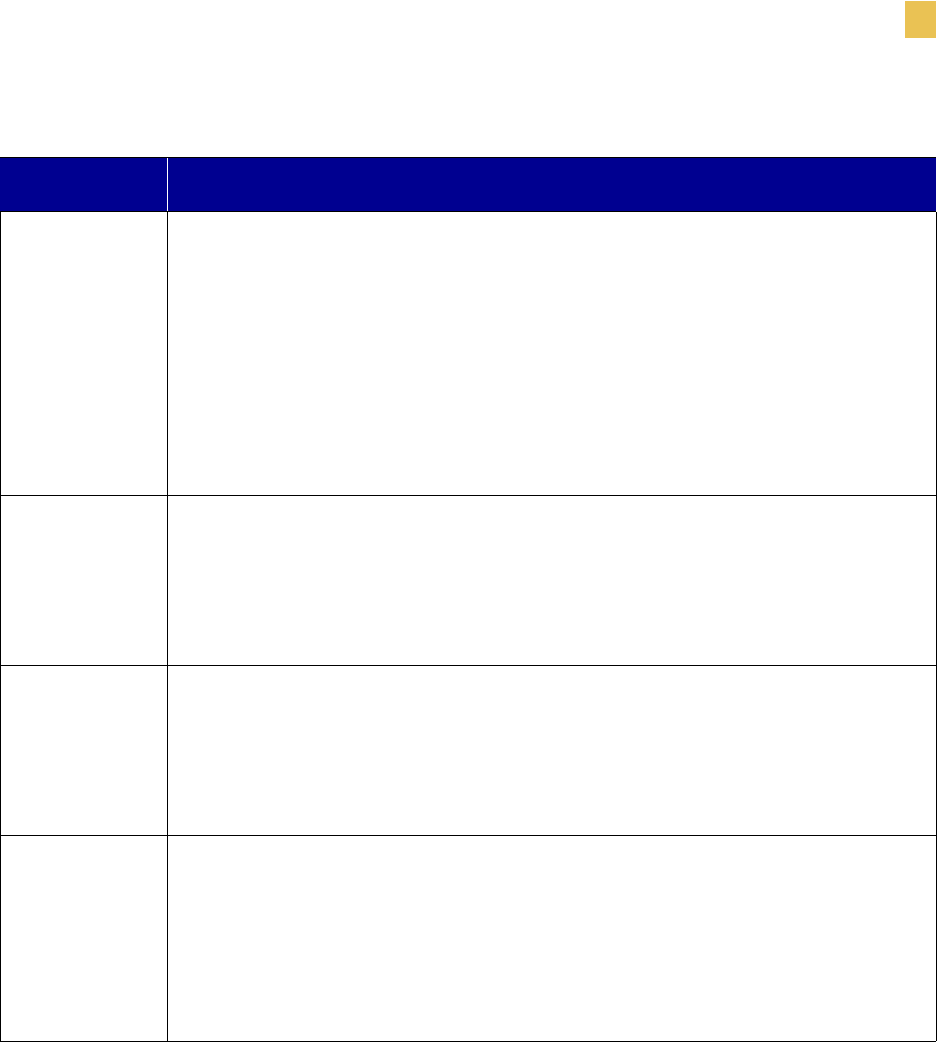
Configuration
Configuration and Calibration LCD Displays
R110/R170XiIIIPlus User Guide 75
IDLE DISPLAY Idle Display
This parameter selects the LCD options for the real-time clock.
Note • If the default value is not selected, pressing either oval briefly displays the
firmware version of the printer.
• Press the right or left oval to display other choices.
Default: Firmware version
Selections: mm/dd/yy (24 hour), mm/dd/yy (12 hour), dd/mm/yy (24 hour),
dd/mm/yy (12 hour)
RTC DATE RTC (Real-time clock) Date
This parameter allows you to set the date following the convention selected in IDLE
DISPLAY.
1. Press the left oval to move to the next digit position.
2. Press the right oval to increase the value of the digit.
RTC TIME RTC (Real-time clock) Time
This parameter allows you to set the time following the convention selected in IDLE
DISPLAY.
1. Press the left oval to move to the next digit position.
2. Press the right oval to increase the value of the digit.
LANGUAGE Selecting the Display Language
This parameter allows you to change the language used on the LCD.
• Press the right or left oval to display other choices.
Default: English
Selections: English, Spanish, French, German, Italian, Norwegian, Portuguese,
Swedish, Danish, Spanish 2, Dutch, Finnish, Japanese
Table 1• Front Panel LCD Messages (Page 19 of 19)
LCD Description
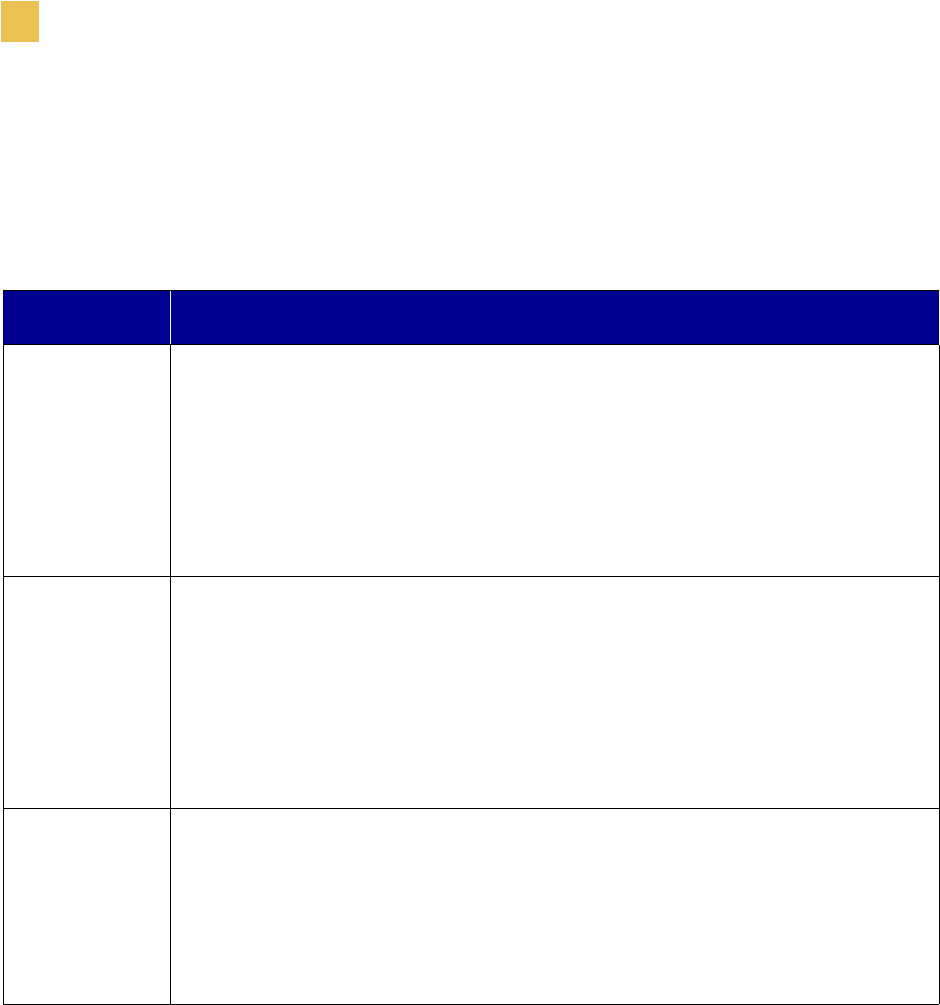
76 R110/R170XiIIIPlus User Guide
Configuration
ZebraNet PrintServer II LCD Displays
ZebraNet PrintServer II LCD Displays
The following menu options display only if you have a ZebraNet PrintServer II (PSII)
installed.
Table 2• Front Panel LCD Messages for PSII
LCD Explanation
IP RESOLUTION IP Resolution
Depending on the selection, allows either the user (permanent) or the server
(dynamic) to select the IP address. For more information, see the PrintServer II™
Installation and User Guide.
• Press the right or left oval to display other choices.
Default: Dynamic
Selections: Dynamic, permanent
IP PROTOCOLS IP Protocols
If Dynamic was chosen in the previous parameter, this selection determines the
method(s) by which the PrintServer II receives the IP address from the server. For
more information, see the PrintServer II™ Installation and User Guide.
• Press the right or left oval to display other choices.
Default: All
Selections: All, gleaning only, RARP, BOOTP, DHCP, DHCP/BOOTP
IP ADDRESS IP Address
This parameter allows you to select the IP address if Permanent was chosen in IP
RESOLUTION. (If Dynamic was chosen, the user cannot select the address.) For more
information, see the PrintServer II™ Installation and User Guide.
1. Press the left oval to move to the next digit position.
2. Press the right oval to increase the value of the digit.
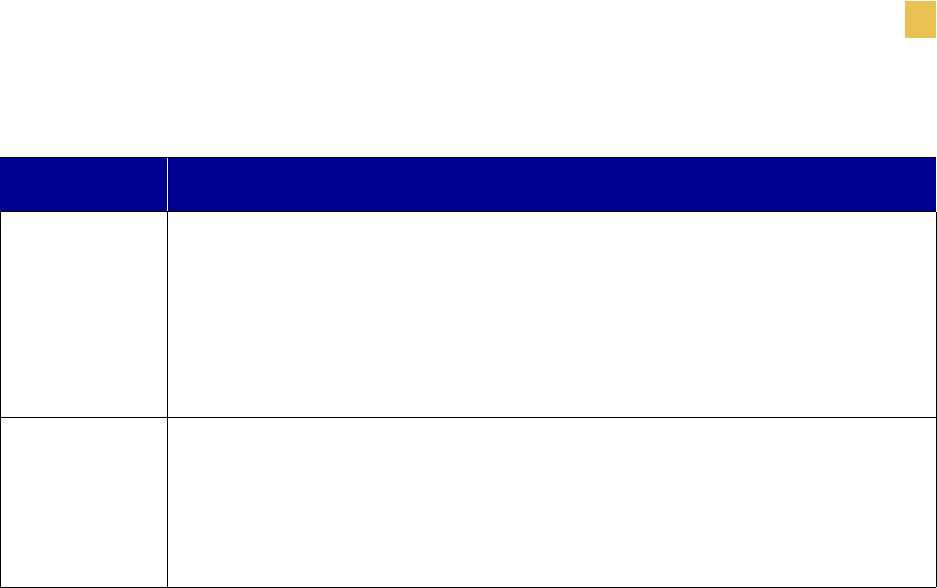
Configuration
ZebraNet PrintServer II LCD Displays
R110/R170XiIIIPlus User Guide 77
SUBNET MASK Subnet Mask
This parameter selects the part of the IP address that is considered to be part of the
local network. It can be reached without going through the default gateway.
• Press the right or left oval to display other choices.
Default: Permanent (user must set)
Selections: Dynamic (user may set, but server can assign), permanent
DEFAULT
GATEWAY
Default Gateway
This parameter allows you to select the IP address that the network traffic is routed
through if the destination address is not part of the local network.
1. Press the left oval to move to the next digit position.
2. Press the right oval to increase the value of the digit.
Table 2• Front Panel LCD Messages for PSII
LCD Explanation
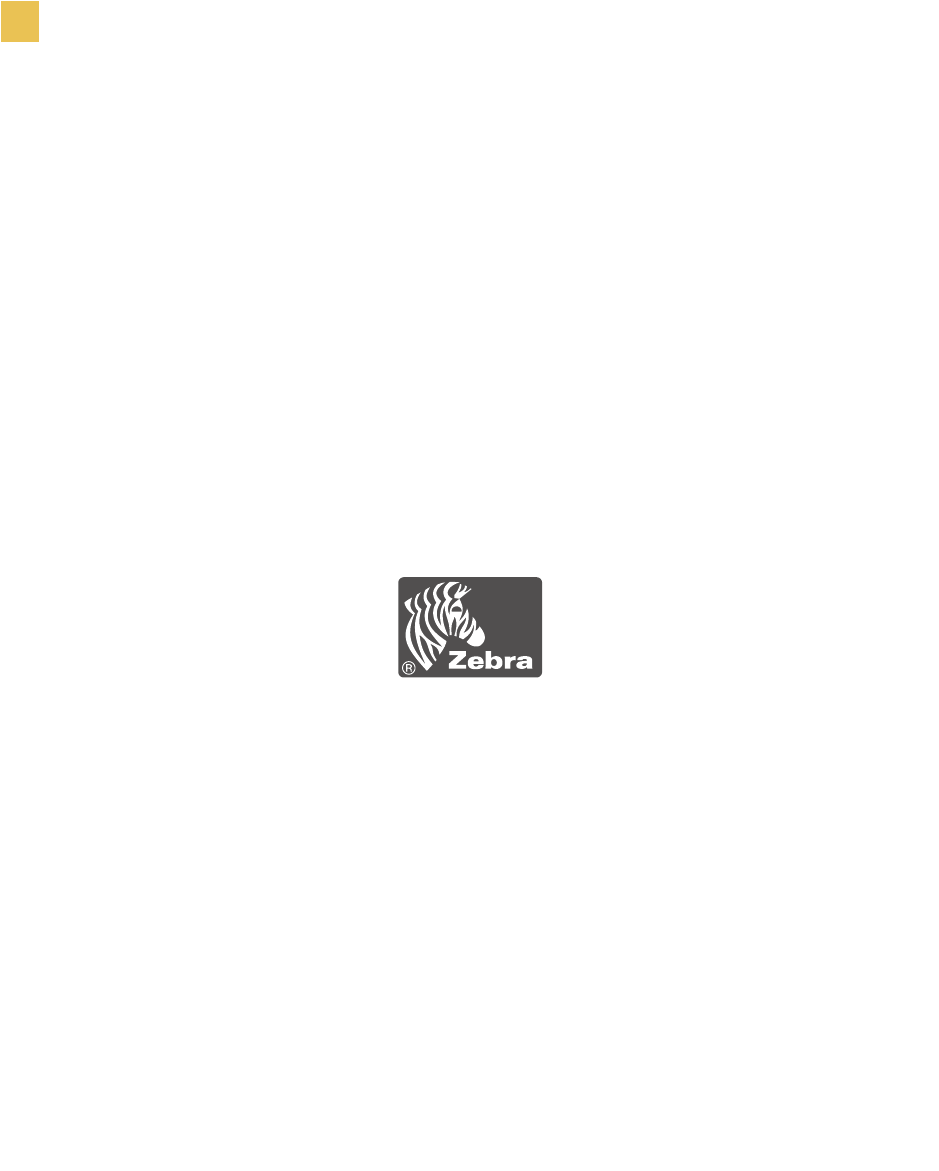
78 R110/R170XiIIIPlus User Guide
Configuration
ZebraNet PrintServer II LCD Displays

R110/R170XiIIIPlus User Guide 79
CHAPTER 6
RFID Guidelines
This chapter provides an overview of how RFID works and the ZPL commands used to create
RFID labels.
Contents
Overview . . . . . . . . . . . . . . . . . . . . . . . . . . . . . . . . . . . . . . . . . . 80
Transponder Placement . . . . . . . . . . . . . . . . . . . . . . . . . . . . . . 80
ZPL II Commands for RFID. . . . . . . . . . . . . . . . . . . . . . . . . . . . 81
Sample of RFID Programming . . . . . . . . . . . . . . . . . . . . . . . . . 91

80 R110/R170XiIIIPlus User Guide
RFID Guidelines
Overview
Overview
The R110 and R170 XiIIIplus “smart” label printer-encoders serve as dynamic tools for both
printing and encoding RFID labels, tickets, and tags. The printer encodes information on
ultra-thin UHF RFID transponders embedded in “smart” labels. It then immediately verifies
proper encoding and prints bar codes, graphics, and/or text on the label’s surface. For more
information about RFID media, see RFID “Smart” Labels on page 17.
Function of an encoded “smart” label depends on factors such as where the label is placed on
an item as well as on the contents of the item (such as metals or liquids). Contact the supplier
of your RFID reader for assistance with these types of issues.
Transponder Placement
Communication between the “smart” label and the printer is established when the transponder
lines up with the printer’s antenna. The optimal transponder position varies with the
transponder size, its configuration, and the type of RFID IC chip used.
Print quality may be affected by printing directly over the transponder. In particular, there is an
area on each label immediately around the location of the IC chip where the printer may print
with low quality. Design your printed label around the location of the chip in the type of
approved “smart” label that you select. For the list of approved transponders and related
placement specifications, go to http://www.rfid.zebra.com/r4m.htm.
Important • It is important to use transponders that have been specifically approved for use in
this RFID printer. Failure to do so may result in the inability to read or write to the embedded
RFID tags. As new transponders become commercially available, Zebra will evaluate them for
compatibility with this printer. For the list of approved transponders, go to
http://www.rfid.zebra.com/r4m.htm.
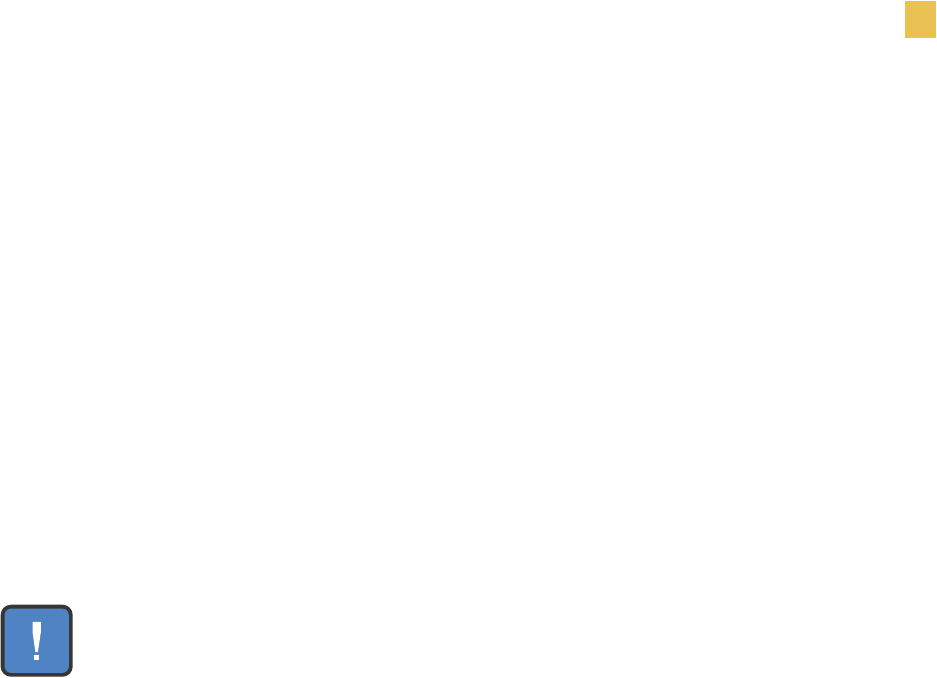
RFID Guidelines
ZPL II Commands for RFID
R110/R170XiIIIPlus User Guide 81
ZPL II Commands for RFID
Printing and encoding (writing) of “smart” labels is handled through the use of Zebra
Programming Language (ZPL). Each transponder has memory that can be read from through
ZPL commands, and most transponders have memory that can be written to. The printer
divides the ZPL commands that it receives into two categories: RFID and non-RFID (such as
the printing commands for bar codes or human-readable text). RFID commands are executed
first.
ZPL commands also provide for exception handling, such as setting the number of read/write
retries before declaring a transponder defective. For example, if an RFID transponder fails to
program correctly or cannot be detected, the printer ejects it and prints the word “void” across
the label. This process continues for the number of RFID tags specified by the ^RS command
using the same data and format. If the problems persist, after the specified number of tags are
ejected, the printer removes the customer format from the print queue and proceeds with the
next format (if one exists in the buffer).
The following pages provide the ZPL II commands that can be used for RFID applications.
Important • If a parameter is designated as not applicable, any value entered for the
parameter will be ignored, but the place holder for the field is required.
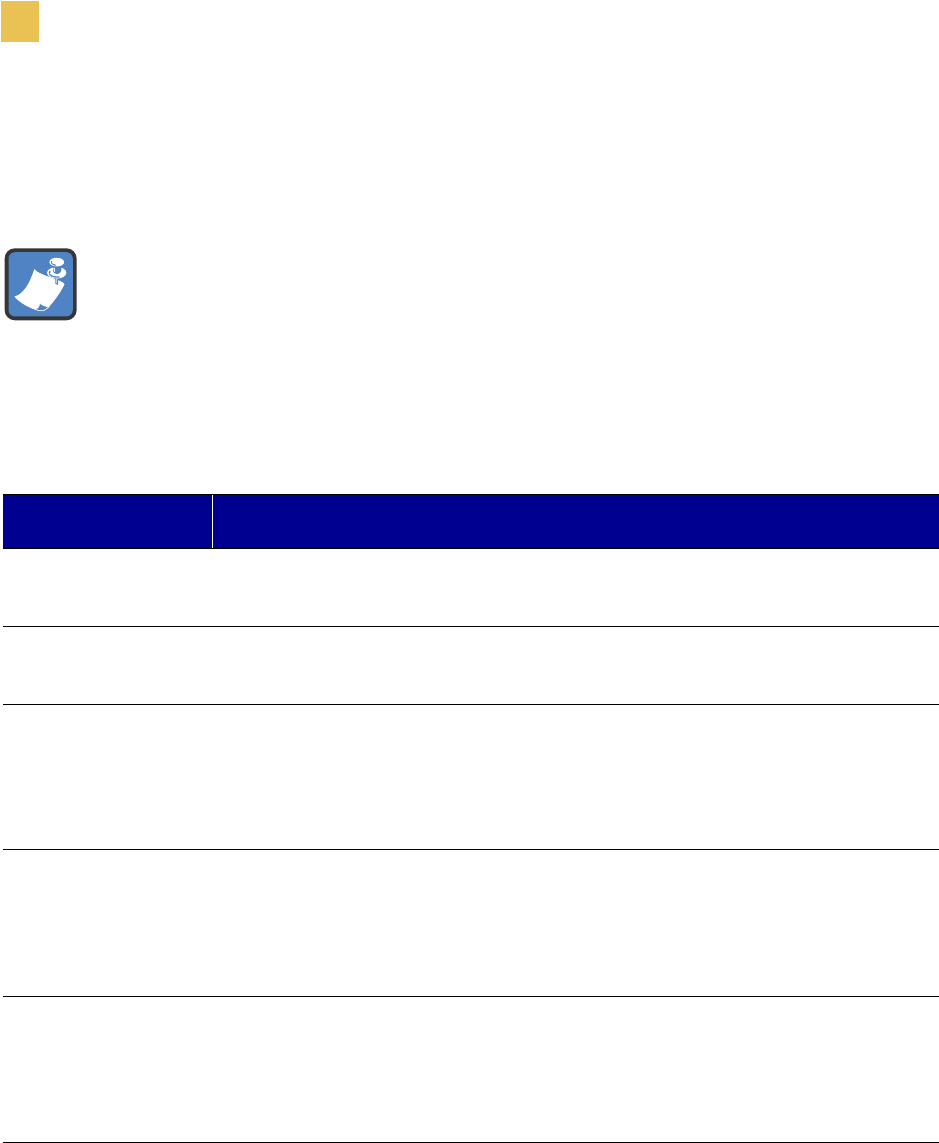
82 R110/R170XiIIIPlus User Guide
RFID Guidelines
ZPL II Commands for RFID
^WT
Write Tag
Description The ^WT command allows you to program the current RFID tag.
Format ^WTb,r,m,w,f,v
The following table identifies the parameters for this format.
Note • Check the amount of data memory available for the tag that you will be using. If more
is sent than the memory can hold, the data will be truncated.
Parameters Details
b = block number* Accepted values: 0 to n, where n is the maximum number of blocks for the tag.
Default value: 0
r = number of retries Accepted values: 0 to 10
Default value: 0
m = motion Accepted values:
• 0 (Feed label after writing.)
• 1 (No Feed after writing. Other ZPL may cause a feed.)
Default value: 0
w = write protect Accepted values:
• 0 (Not write protected.)
• 1 (Write protect.)
Default value: 0
f = data format Accepted values:
• 0 (ASCII)
• 1 (Hexadecimal)
Default value: 0
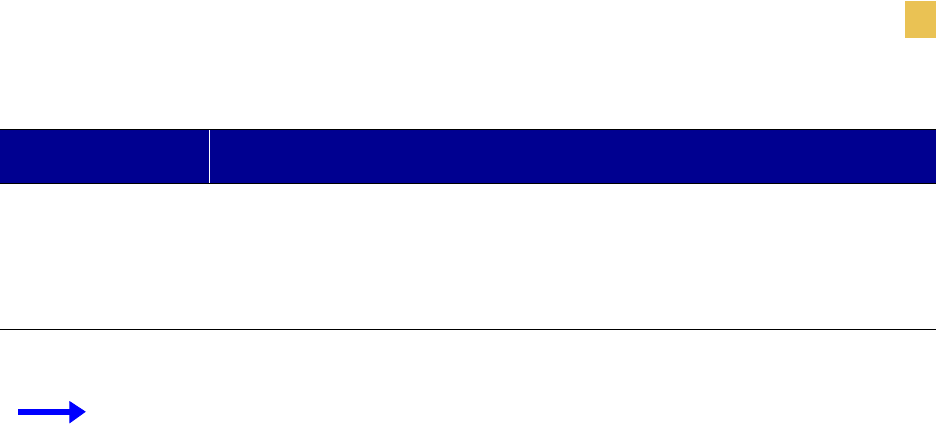
RFID Guidelines
ZPL II Commands for RFID
R110/R170XiIIIPlus User Guide 83
v = verify valid data Default value: y
Accepted values:
• n (Do not verify)
• y (Verify valid data [Hex A5A5 in the first two bytes] before writing)
*Not applicable for R110/R170XiIIIplus
Example • This sample encodes data “RFIDRFID” and will try writing up to five times, if
necessary.
^XA
^WT,5^FDRFIDRFID^FS
^XZ
Parameters Details
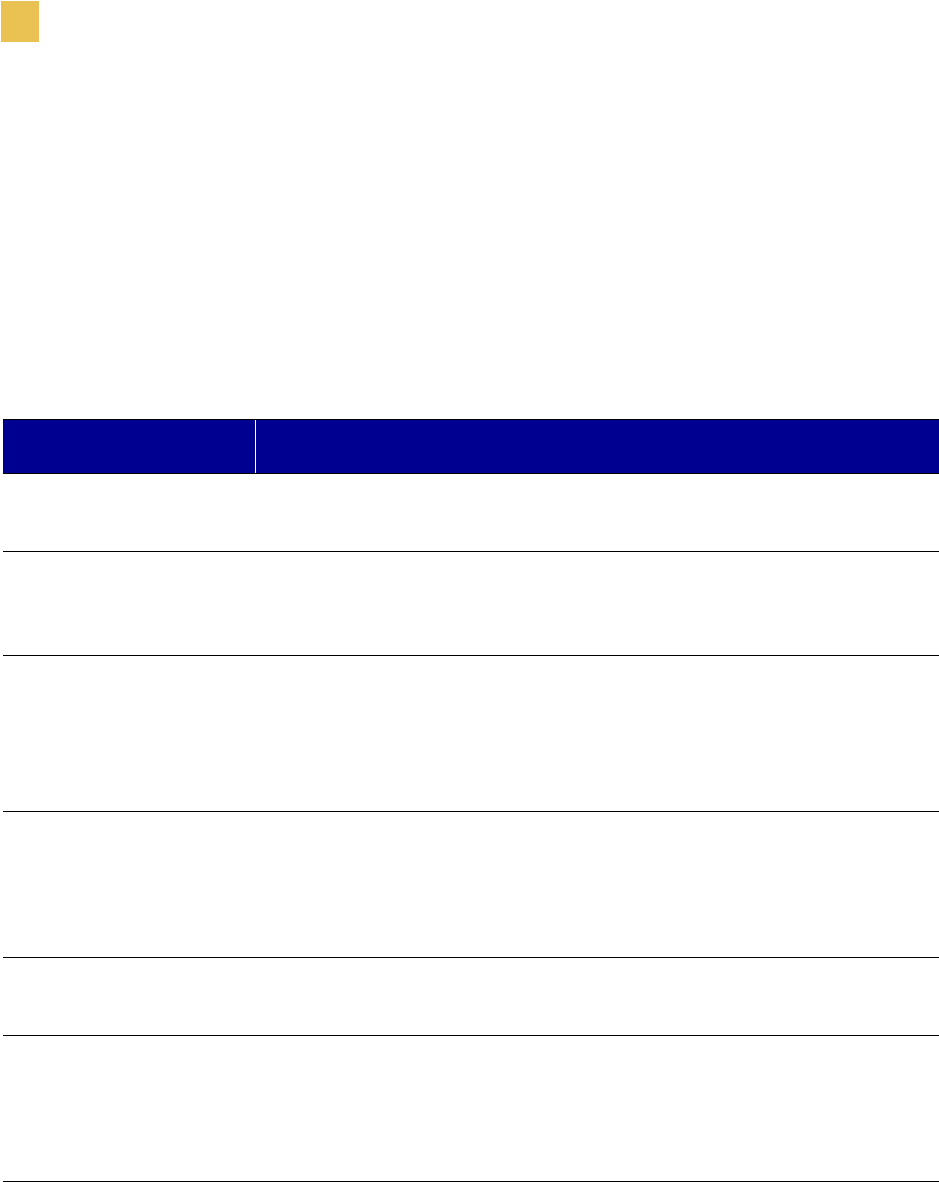
84 R110/R170XiIIIPlus User Guide
RFID Guidelines
ZPL II Commands for RFID
^RT
Read Tag
Description The ^RT command tells the printer to read the current RFID tag data. The data
can be sent back to the host via the ^HV command.
Format ^RT#,b,n,f,r,m,s
The following table identifies the parameters for this format.
Parameters Details
# = number to be assigned
to the field
Accepted values: 0 to 9999
Default value: 0
b = starting block
number*
Accepted values: 0 to n, where n is the maximum number of blocks for
the tag.
Default value: 0
n = number of blocks
to read*
Accepted values: 1 to n, where n is the maximum number of blocks minus
the starting block number. For example, if the tag has 8 blocks (starting with
block 0) and you start with block 6, n can be 2. This would give you block 6
and block 7 information.
Default value: 1
f = format Accepted values:
• 0 (ASCII)
• 1 (Hexadecimal)
Default value: 0
r = number of retries Accepted values: 0 to 10
Default value: 0
m = motion Accepted values:
• 0 (Feed label after writing.)
• 1 (No Feed after writing. Other ZPL may cause a feed.)
Default value: 0
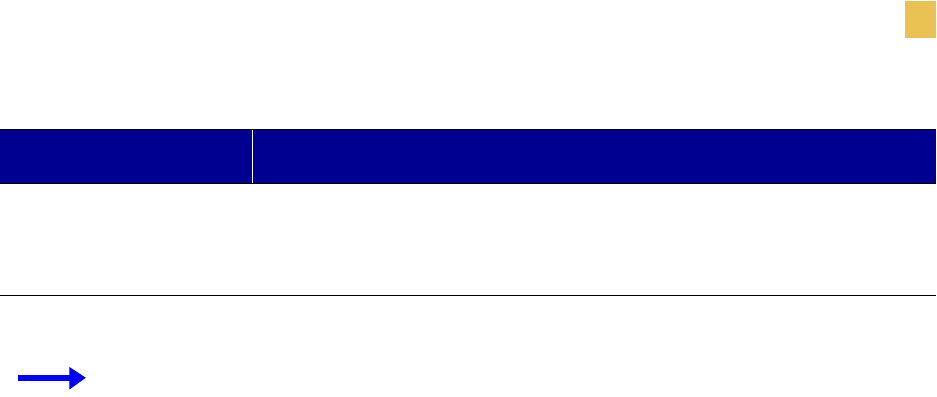
RFID Guidelines
ZPL II Commands for RFID
R110/R170XiIIIPlus User Guide 85
s = special mode For EPC Class 1 (Alien reader) only. Not applicable for EPC class 0.
Default value: 0 (Do not read if mismatched checksum.)
Accepted values: 1 (Read even if mismatched checksum.)
*Not applicable for R110/R170XiIIIplus
Example • This sample reads a tag, prints the data on a label, and sends the string
Tag Data:xxxxxxxx back to the host. The data read will go into the ^FN1 location
of the format. The printer will retry the command five times, if necessary.
^XA
^FO20,120^A0N,60^FN1^FS
^RT1,,,,5^FS
^HV1,,Tag Data:^FS
^XZ
Parameters Details
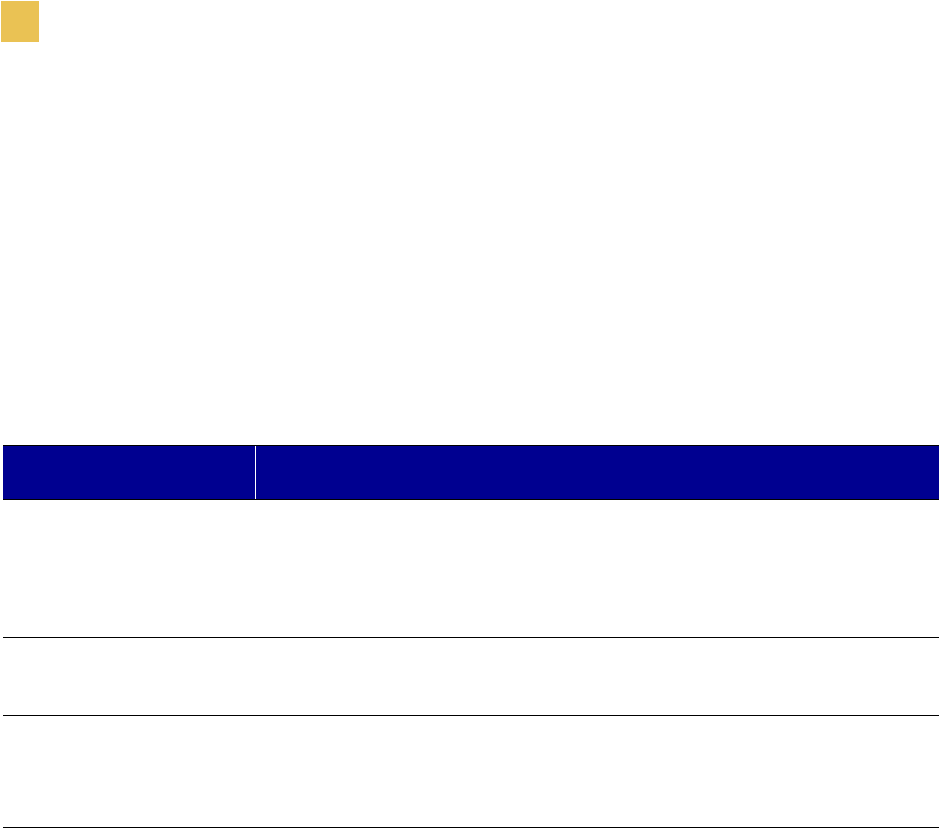
86 R110/R170XiIIIPlus User Guide
RFID Guidelines
ZPL II Commands for RFID
^HV
Host Verification
Description This command is used to return data from specified fields, along with an
optional ASCII header, to the host. It can be used with any field that has been assigned a
number with the ^RT command.
Format ^HV#,n,h
The following table identifies the parameters for this format.
Parameters Details
# = field number specified
with another command
The value assigned to this parameter should be the same as the one used in
the ^RT or ^RI command.
Accepted values: 0 to 9999
Default value: 0
n = number of bytes to be
returned
Accepted values: 1 to 256
Default value: 64
h = header Header (in uppercase ASCII characters) to be returned with the data.
Acceptable values: 0 to 3072 characters
Default value: none
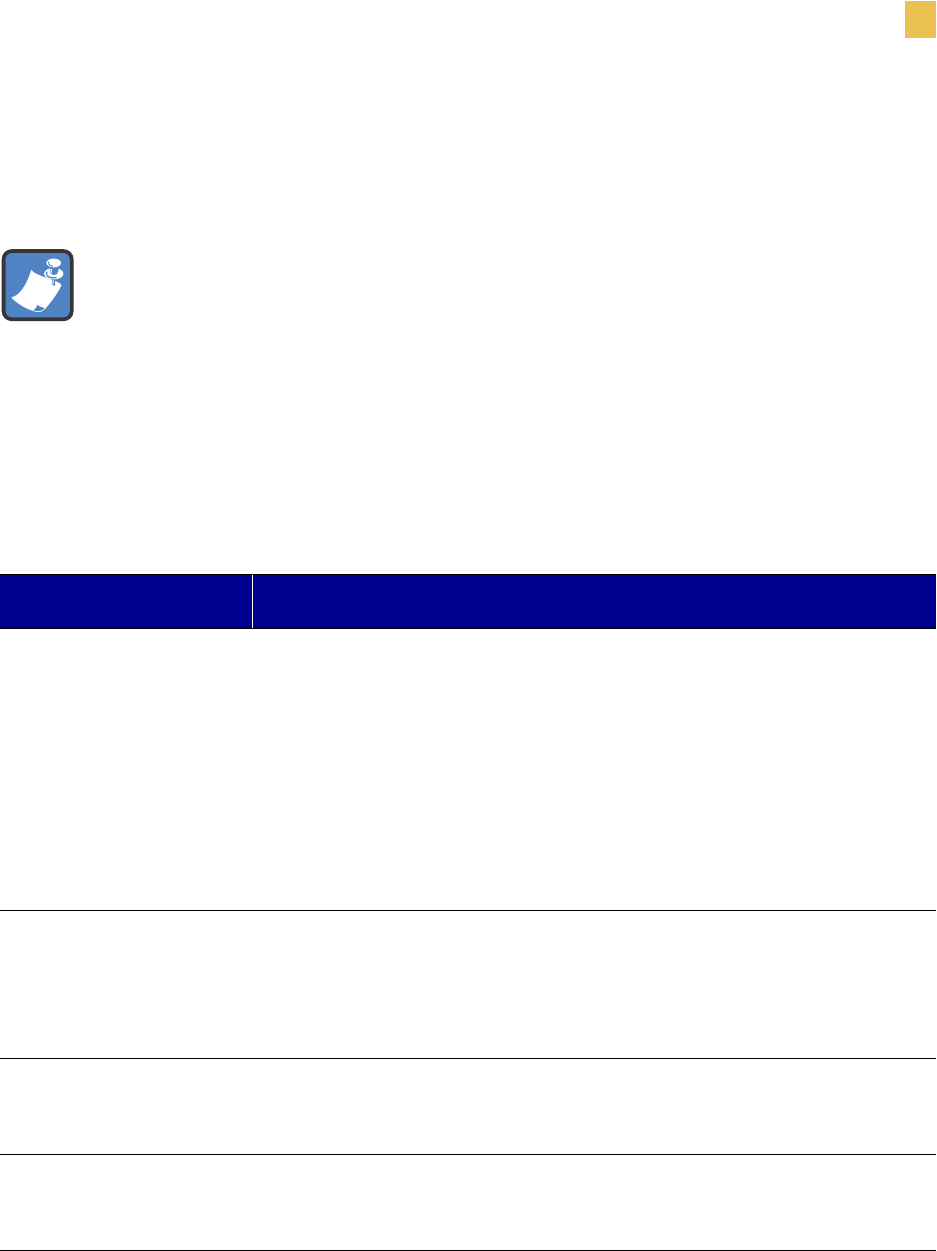
RFID Guidelines
ZPL II Commands for RFID
R110/R170XiIIIPlus User Guide 87
^RS
RFID Setup
Description The ^RS command is used to set up for RFID operation. Specifically, it moves
the tag into the effective area for reading or writing or for possible error handling if there is an
error.
Format ^RSt,p,v,n,e
The following table identifies the parameters for this format.
Note • Use care when using this command in combination with ^RT (reading tag data).
Problems can occur if the data read from the tag is going to be printed on the label. Any data
read from the transponder must be positioned to be printed above the read/write position.
Failure to do this will prevent read data from being printed on the label.
Parameters Details
t = tag type* Accepted values:
• 1 = Auto detect (automatically determine the tag type by querying the tag)
• 2 = Tag it (Texas Instruments Tagit tags)
• 3 = Icode (Phillips Icode tags)
• 4 = Pico tag (Inside Technology’s)
• 5 = ISO15693 tag
• 6 = ePC tag
Default value: 1
p = read/write position of
the transponder in the
vertical (Y axis) in dot
rows from the top of the
label
Set to 0 (no movement) if the transponder is already in the effective area
without moving the media.
Accepted values: 0 to label length
Default value: label length minus 8 dot rows
v = length of void printout
in vertical (Y axis) dot
rows
Default value: label length
Accepted values: 0 to label length
n = number of labels to try
in case of read/encode
failure
Default value: 3
Accepted values: 1 to 10 (number of labels)
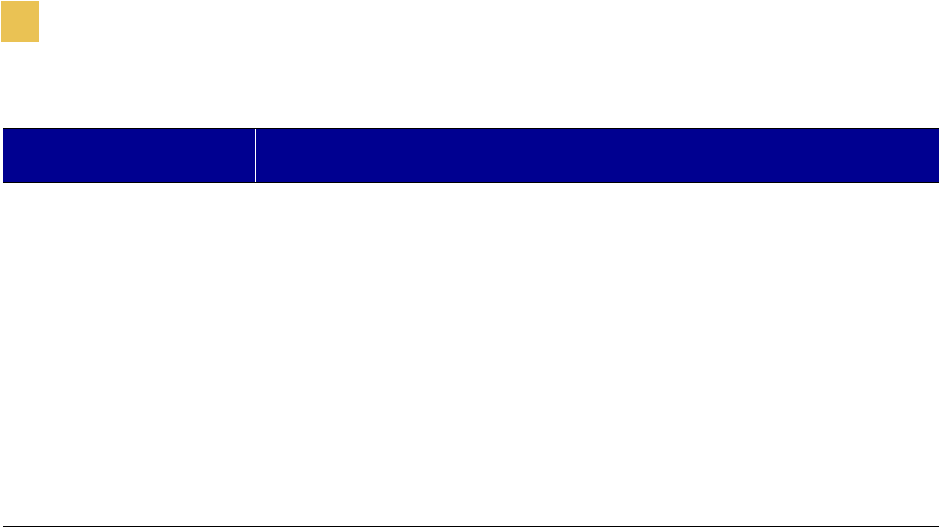
88 R110/R170XiIIIPlus User Guide
RFID Guidelines
ZPL II Commands for RFID
e = error handling Send an error message to the host as an unsolicited message for each failure
and set the printer in error mode.
Accepted values:
• N = No action
• P = Place printer in Pause
• E = Place printer in Error
Default value: N
Note • To enable or disable the unsolicited error message, refer to the ^SX
and ^SQ commands. The parameter for the RFID error in these commands
is V.
*Not applicable for R110/R170XiIIIplus
Parameters Details
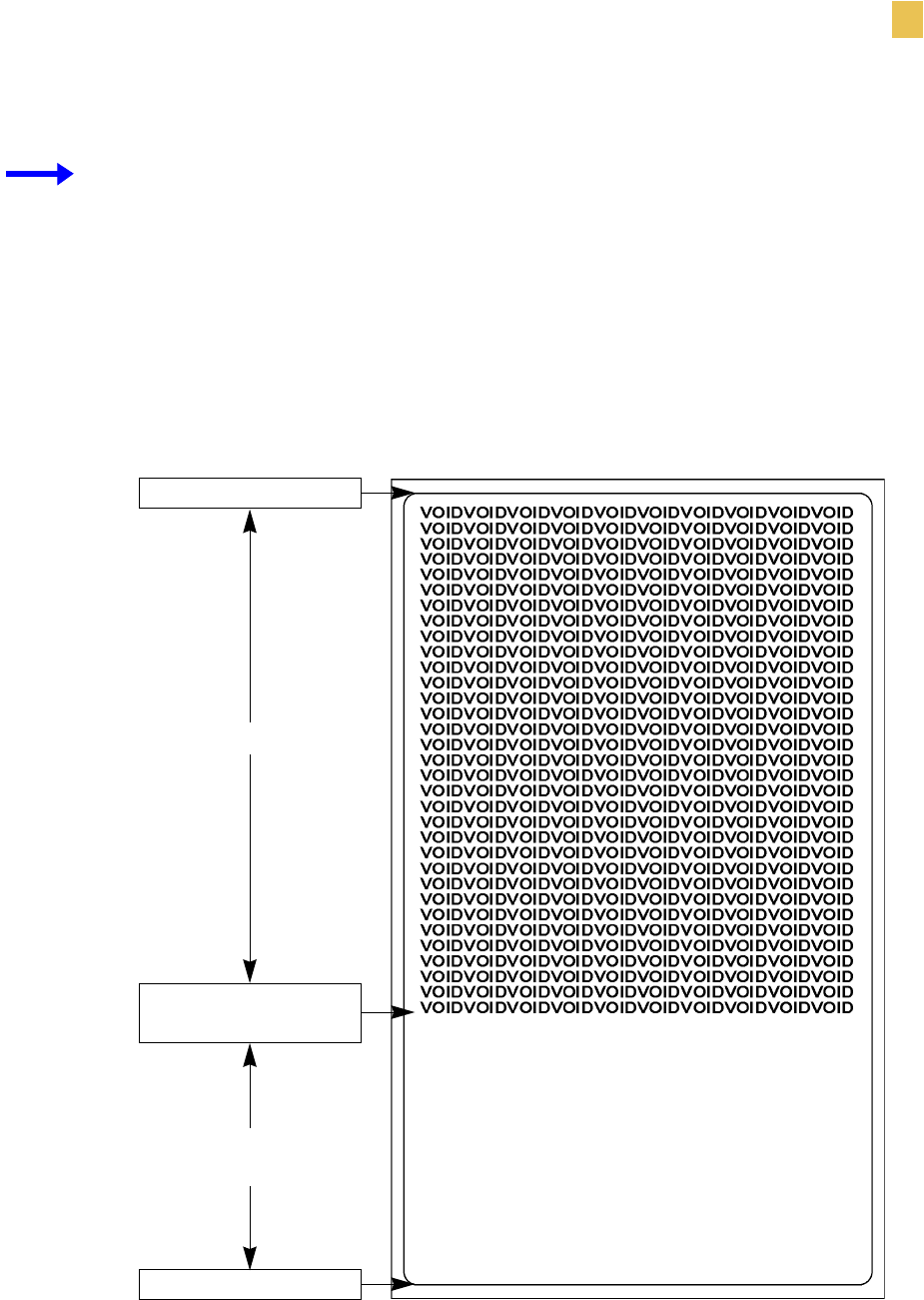
RFID Guidelines
ZPL II Commands for RFID
R110/R170XiIIIPlus User Guide 89
Example 1 • This example sets the printer to move the media to 800 dots from the top of
the media [or label length minus 800 from the bottom (leading edge) of the media] and
voids the rest of the media in case of an error. The printer will try to print two labels, then
will pause the printer if printing and encoding fail.
^XA
^RS,800,,2,P^FS
^XZ
The following illustration shows the resulting voided label. Note where the void starts. The
media has been moved 800 dot rows from the top of the label (label length minus 800 dot
rows from the bottom (leading edge) of a label) to bring the transponder into the effective
area to read/write a tag. If the printer fails the operation, the rest of the media is voided.
Top of label
Start of RFID
operation
800 dot rows
Bottom of label
Label length minus
800 dot rows
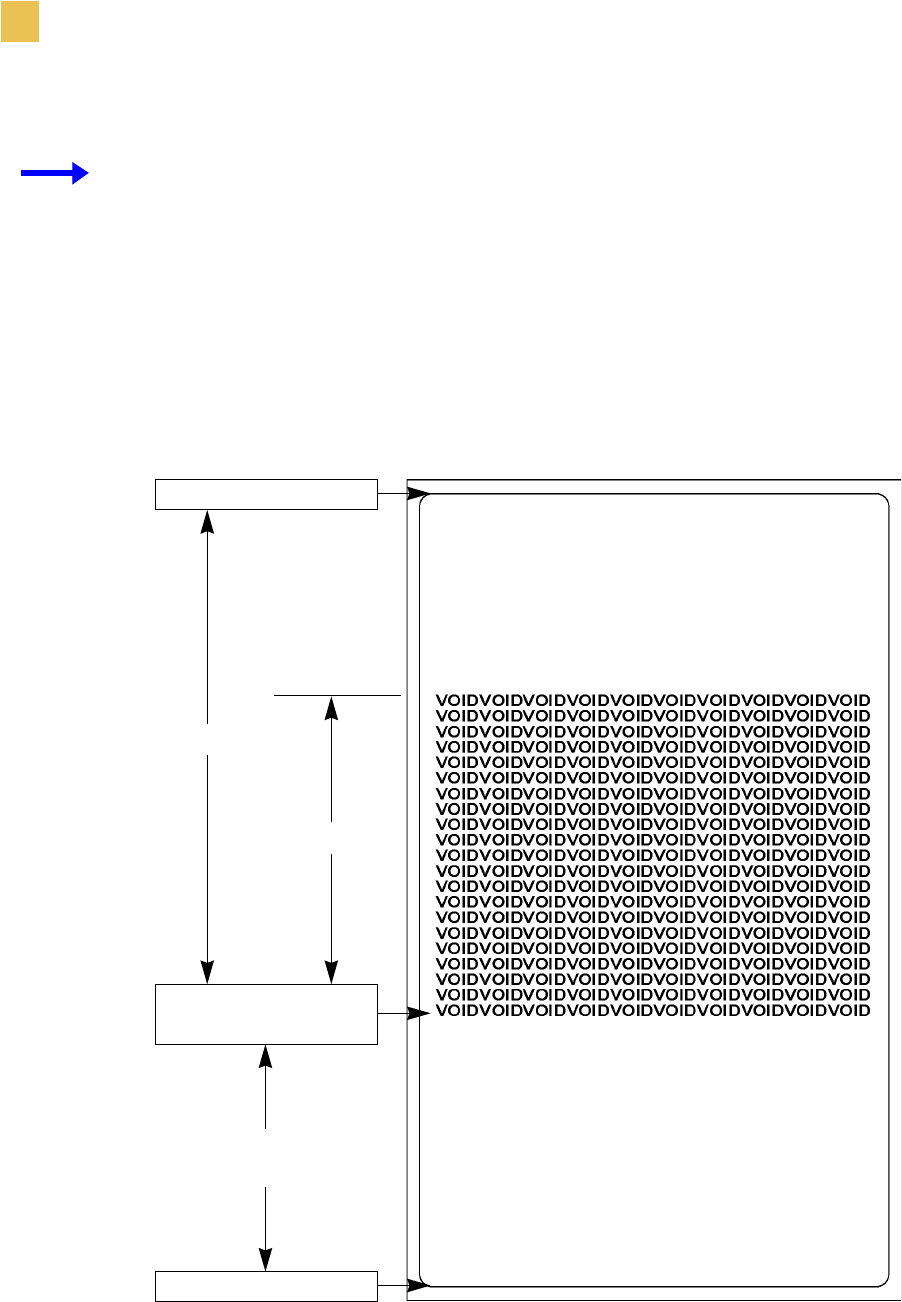
90 R110/R170XiIIIPlus User Guide
RFID Guidelines
ZPL II Commands for RFID
Example 2 • This example sets the printer to move the media to 800 dots from the top of
the media [or label length - 500 from the bottom (leading edge) of the media] and prints
“void” 500 dots in vertical length (Y axis) in case of an error.
^XA
^RS,800,500,2,P^FS
^XZ
The following illustration shows the resulting voided label. Note where the void starts. The
media has been moved 800 dot rows from the top of the label [label length minus 800 dot
rows from the bottom (leading edge) of a label] to bring the transponder into the effective
area to read/write a tag. If the printer fails the operation, an area that is 500 dot rows of the
media is voided instead of the entire rest of the media.
Top of label
Start of RFID
operation
800 dot rows
Bottom of label
Label length minus
800 dot rows
500 dot rows

RFID Guidelines
Sample of RFID Programming
R110/R170XiIIIPlus User Guide 91
Sample of RFID Programming
ZPL II is Zebra’s label design language. ZPL II lets you create a wide variety of labels from
the simple to the very complex, including text, bar codes, and graphics.
This section is not intended as an introduction to ZPL II. If you are a new ZPL II user, order
the ZPL II Programming Guide (part number 46530L) or go to http://support.zebra.com to
download the guide.
For your programming, do the following:
1. Set up the printer and turn the power On (I).
2. Use any word processor or text editor capable of creating ASCII-only files (for example,
use Microsoft® Word and save as a .txt file) and type in the label format exactly as shown
in the sample label format that follows.
3. Save the file in a directory for future use. Use the “.zpl” extension.
4. Copy the file to the printer.
From the DOS command window, use the “COPY” command to send a file to the
Zebra printer. For example, if your file name is format1.zpl then type, COPY
FORMAT 1.ZPL XXXX, where XXXX is the port to which your Zebra printer is
connected (such as LPT1).
5. Compare your results with those shown. If your printout does not look like the one shown,
confirm that the file you created is identical to the format shown, then repeat the printing
procedure. If nothing prints, refer to
•Printer Setup on page 7
•Printer Operation on page 19
•Configuration on page 53
•Troubleshooting on page 119
to make sure that your system is set up correctly.
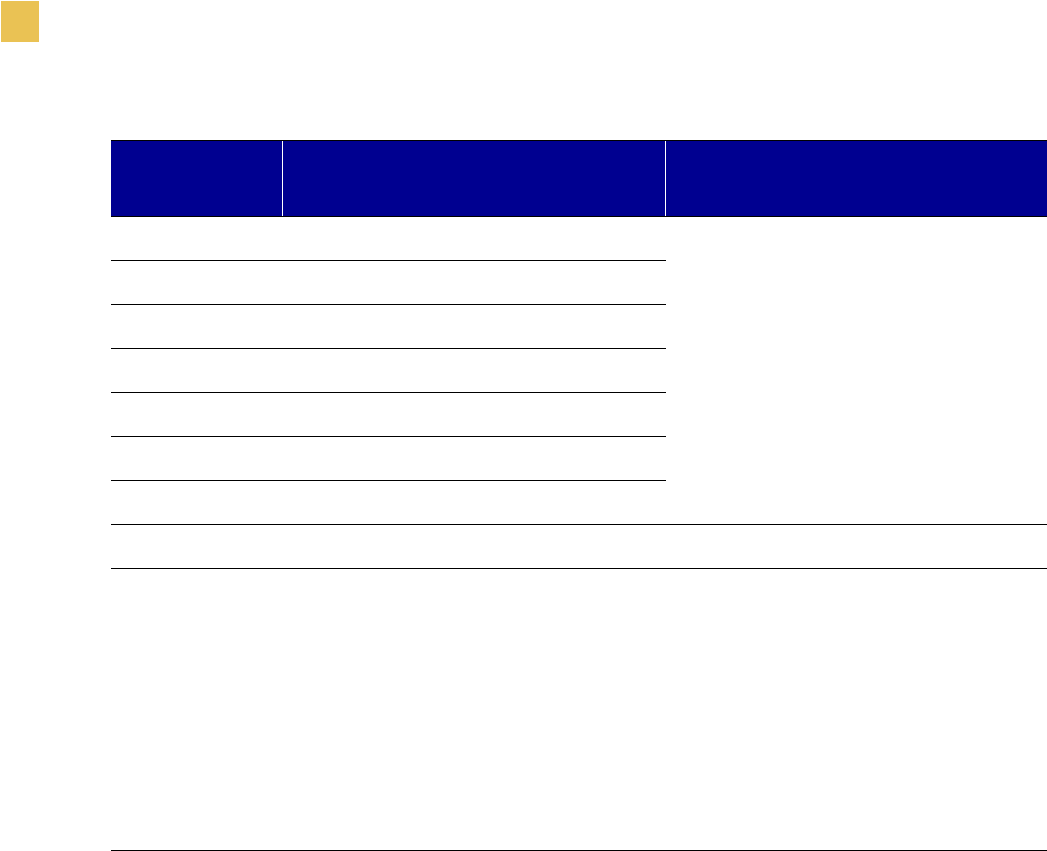
92 R110/R170XiIIIPlus User Guide
RFID Guidelines
Sample of RFID Programming
Line
Number Type This Label Format Resulting Printout
1 ^XA ZEBRA
5A65627261000000
2^RS,0^FS
3^WT^FDZebra^FS
4 ^FO100,100^A0n,60^FN0^FS
5 ^FO100,200^A0n,40^FN1^FS
6^RT0^FS
7 ^RT1,,,1^FS
8^XZ
Line 1 Indicates start of label format.
Line 2 Indicates no movement for media.
Line 3 Writes the data “Zebra” to the tag.
Line 4 Print field number ‘0’ at location 100,100.^FN0 is replaced by what we read on line 6.
Line 5 Print field number ‘1’ at location 100,200. ^FN1 is replaced by what we read on line 7.
Line 6 Read Tag into field number 0 in ASCII format (default).
Line 7 Read Tag into field number 1 in hexadecimal format.
Line 8 End of label format.

R110/R170XiIIIPlus User Guide 93
CHAPTER 7
Data Ports
This chapter describes the standard communication ports on the printer.
Standard Ports. . . . . . . . . . . . . . . . . . . . . . . . . . . . . . . . . . . . . . 94
Parallel Port. . . . . . . . . . . . . . . . . . . . . . . . . . . . . . . . . . . . . . 94
Serial Port . . . . . . . . . . . . . . . . . . . . . . . . . . . . . . . . . . . . . . . 96
USB 2.0 Port . . . . . . . . . . . . . . . . . . . . . . . . . . . . . . . . . . . . 102
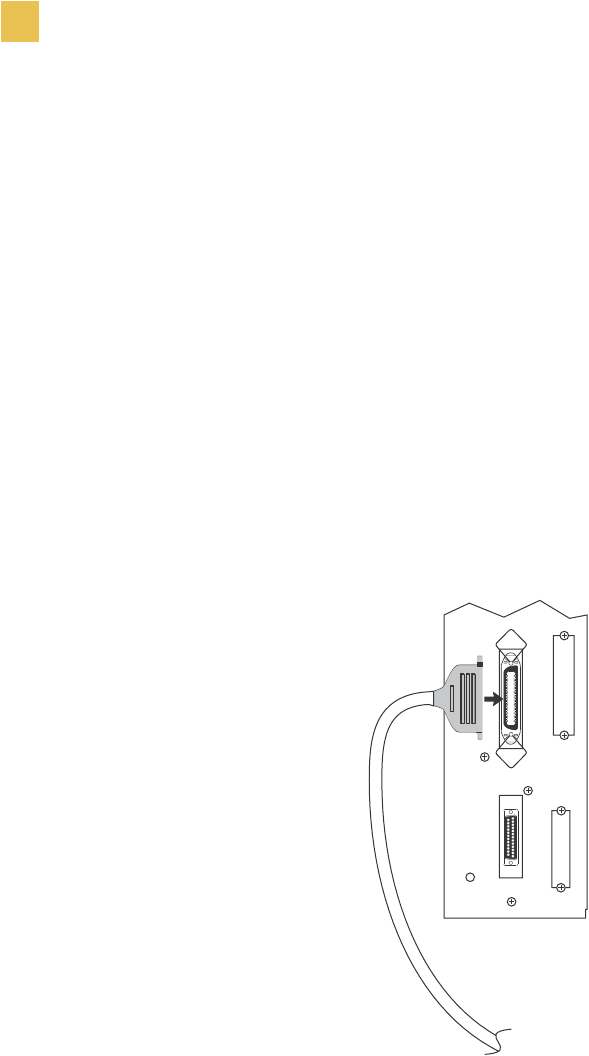
94 R110/R170XiIIIPlus User Guide
Data Ports
Standard Ports
Standard Ports
The different ports available to connect the printer to your computer or network include:
• Parallel
• Serial RS-232
•USB
Parallel Port
When communicating via the parallel port, the values selected must be the same as those used
by the host equipment connected to the printer. Port selection for status information is
determined by the channel sending the request. The parallel port can be set for bidirectional or
unidirectional communication. The default setting is bidirectional.
A standard 36-pin parallel connector (as shown below) is available on the back of the printer
for connection to the data source.
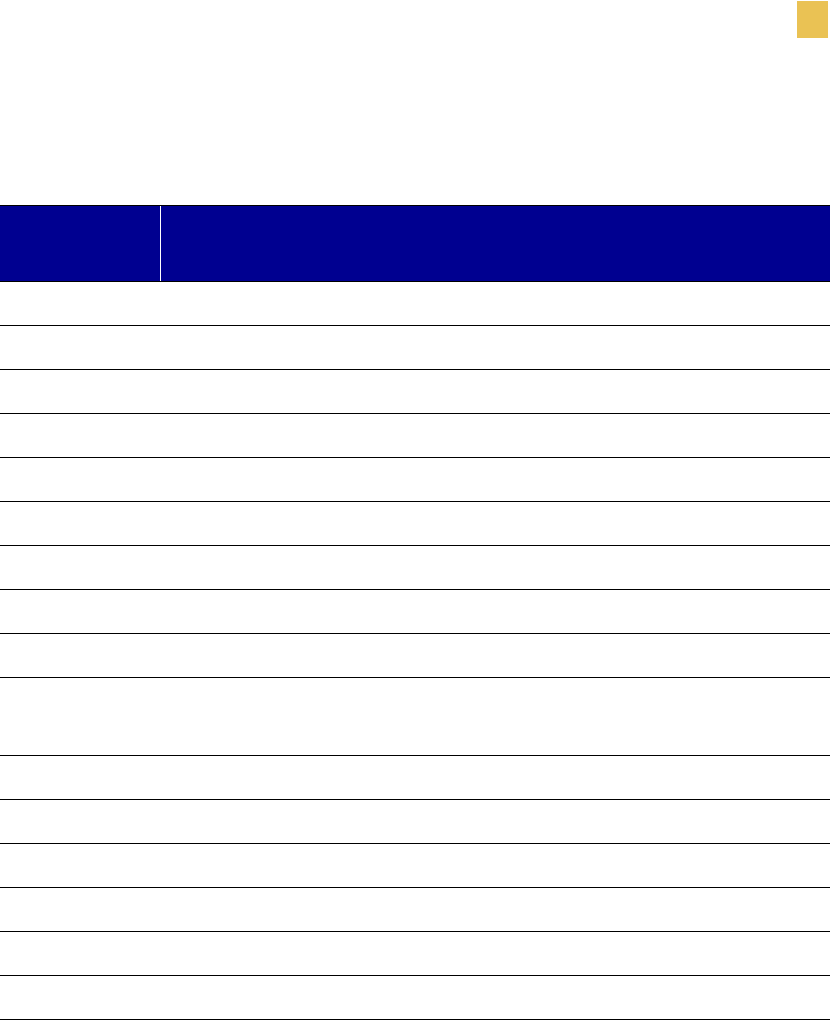
Data Ports
Standard Ports
R110/R170XiIIIPlus User Guide 95
The following table shows the pin configuration and function of a standard computer-to-
printer parallel cable.
36-Pin
Connectors
Description
1 nStrobe/HostClk
2–9 Data Bits 1–8
10 nACK/PtrClk
11 Busy/PtrBusy
12 PError/ACKDataReq
13 Select/Xflag
14 nAutoFd/HostBusy
15 Not used
16, 17 Ground
18 +5 V at 750 mA
The maximum current draw may be limited by option configuration.
19–30 Ground
31 ninit
32 nFault/NDataAvail
33, 34 Not used
35 +5 V through a 1.8 KΩ Resistor
36 NSelectin/1284 active
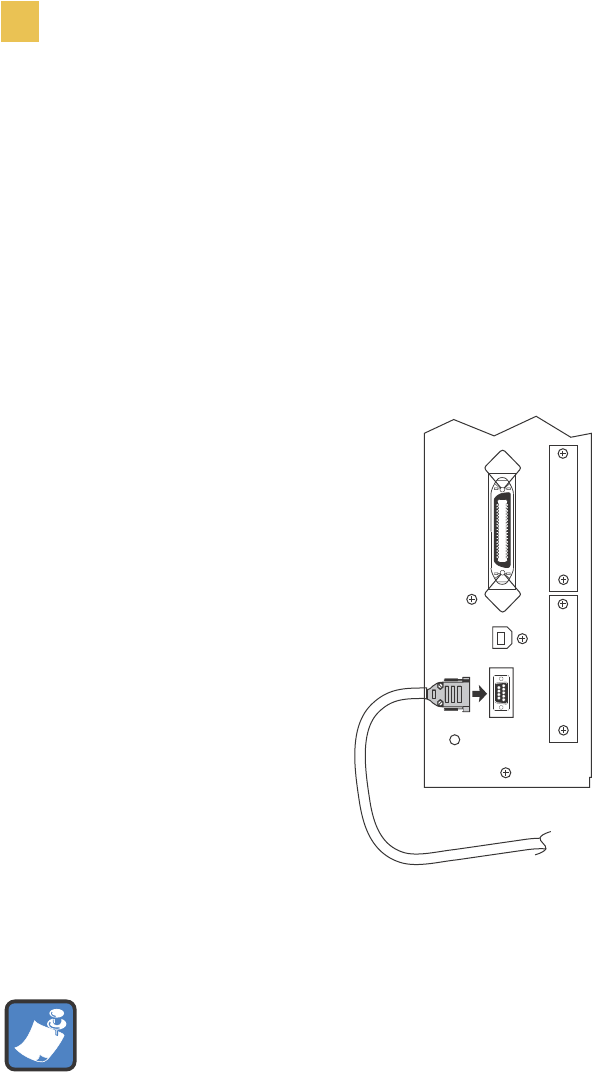
96 R110/R170XiIIIPlus User Guide
Data Ports
Standard Ports
Serial Port
To communicate using the serial data port of the printer, you must choose the number of data
and stop bits, parity, and handshaking. Parity applies only to data transmitted by the printer
because the parity of received data is ignored.
The values selected must be the same as those used by the host equipment connected to the
printer. Default settings are 9600 baud, 8 data bits, 1 stop bit, no parity, and XON/XOFF.
Connect the serial data cable to the female DB-9 connector (shown below) on the back panel
of the printer.
Use a DB-9 to DB-25 interface module for all RS-232 connections through a DB-25 cable. An
interface module is required for RS-422/RS-485 interface support (see RS-422/RS-485
Interconnections on page 101).
Note • For all RS-232 input and output signals, the printer follows the specifications of the
Electronics Industries Association (EIA) RS-232 and the Consultative Committee for
International Telegraph and Telephone (CCITT) V.24.
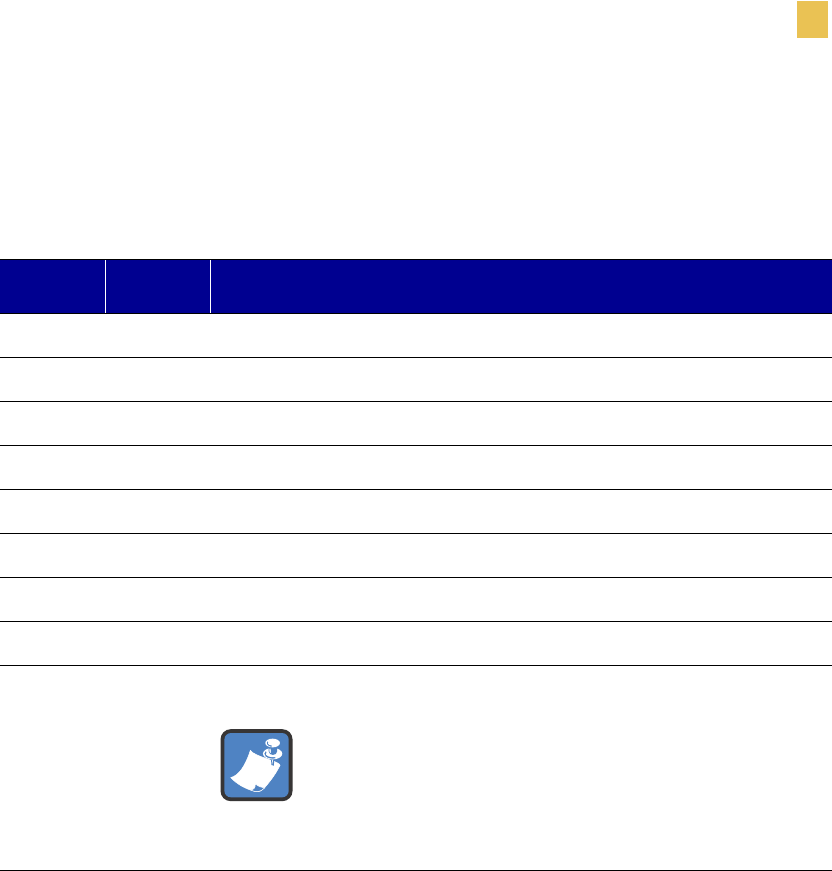
Data Ports
Standard Ports
R110/R170XiIIIPlus User Guide 97
Serial Pin Configuration
The table below shows the pin configuration and function of the rear panel serial data
connector on the printer.
Pin No. Name Description
1 — Not connected
2 RXD Receive data—data input to printer
3 TXD Transmit data—data output from printer
4 DTR Data terminal ready—output from printer
5 SG Signal ground
6 DSR Data set ready—input to printer
7 RTS Request to send—output from printer
8 CTS Clear to send—input to printer
9 +5 VDC +5 VDC signal output
Note • This pin is also available as a +5 VDC power
source at 750 mA. The maximum current draw may be
limited by option configuration. To enable this capability,
a jumper on the printer’s main logic board needs to be
installed on JP1, pins 2 and 3.
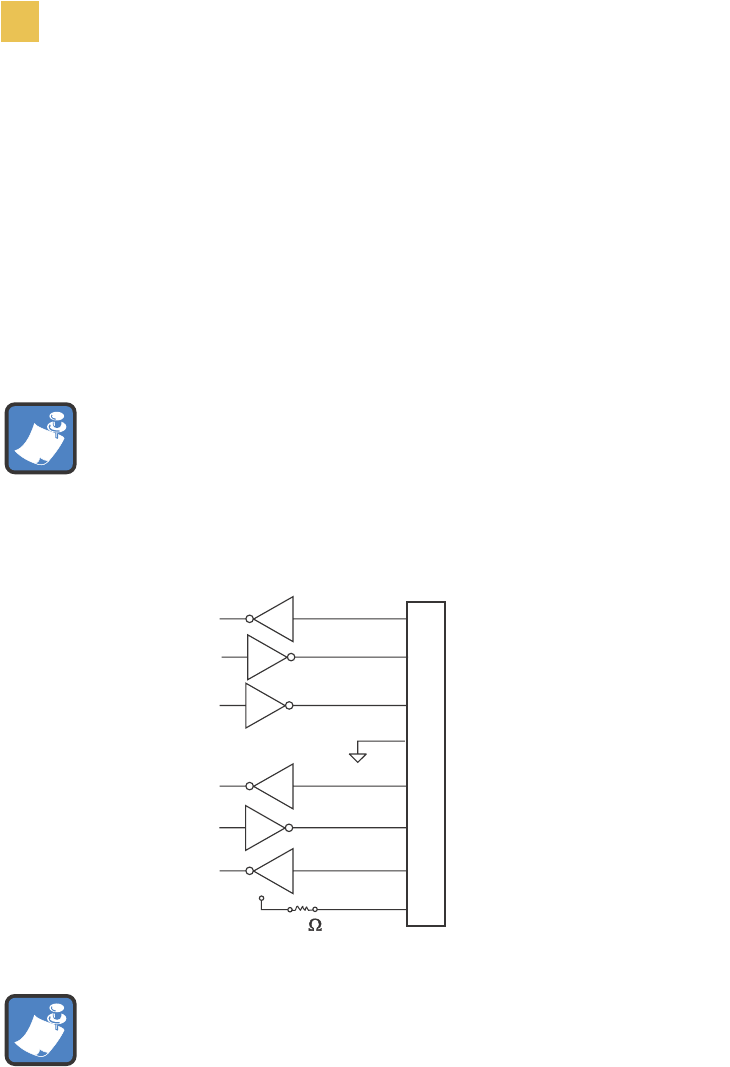
98 R110/R170XiIIIPlus User Guide
Data Ports
Standard Ports
RS-232 Interface Connections
Adapters are available from Zebra Technologies LLC.
• RS-422/RS-485 adapter, Zebra part number 33114M
• RS-232 DB-9 to DB-25 adapter, Zebra part number 33109M
Direct Connection to a Computer
The printer is configured as Data Terminal Equipment (DTE).
This illustration shows the internal connections of the printer’s RS-232 connector.
Note • The cable used to connect the printer to a computer must be a null modem (crossover)
cable. To connect the printer to any other DTE devices, use a null modem cable.
Note • Pin 9 is also available as a +5 VDC power source at 750 mA. The maximum current
draw may be limited by option configuration. To enable this capability, a jumper on the
printer’s main logic board needs to be installed on JP1, pins 2 and 3.
NOTE: Pin 1 is unused and unterminated.
RS-232 Connector (DTE)
Rear Panel Female DB-9
RXD (receive data) input
TXD (transmit data) output
DTR (data terminal ready) output
SG (signal ground)
DSR (data set ready) input
RTS (request to send) output
CTS (clear to send) input
+5 VDC signal source
2
3
4
5
6
7
8
9
R1
+5 VDC
1K
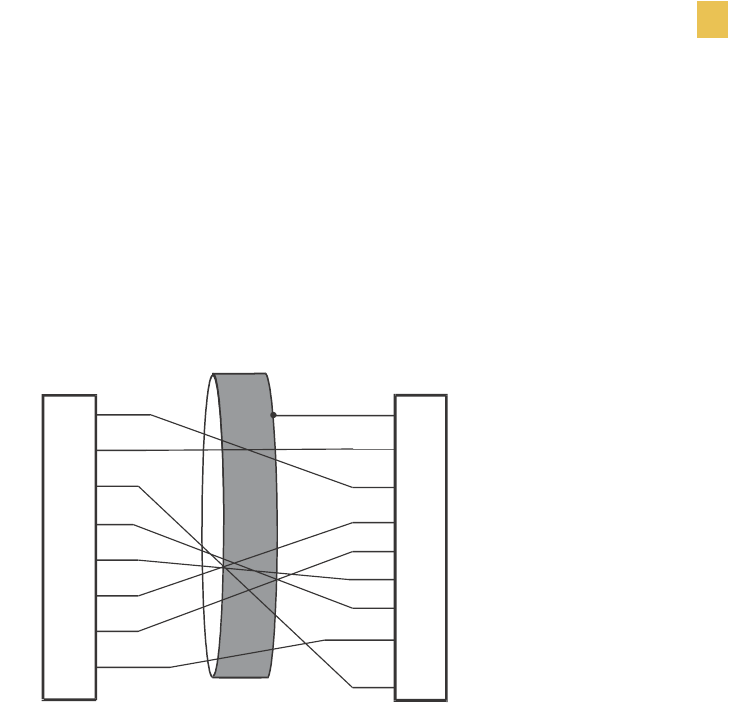
Data Ports
Standard Ports
R110/R170XiIIIPlus User Guide 99
DB-9 to DB-25 Connections
An interface adapter is required (Zebra part number 33109M) to connect the printer’s DB-9
interface to a DB-25 connector. A generic DB-25 adapter CAN be used, although the +5 VDC
signal source would not be passed through the adapter.
This illustration shows the connections required for the DB-9 to DB-25 interface.
Male DB-9 Adapter
Connector
(plugs into printer)
Female DB-25 Adapter
Connector
(plugs into cable)
NOTE: Pin 1 of DB-9 connector is unused and unterminated.
FG
TXD
RXD
RTS
DSR
SG
DTR
RXD
TXD
DTR
SG
DSR
RTS
CTS
+5 VDC
SIGNAL
2
3
4
5
6
7
8
9
1
2
3
4
6
7
9
20
+5 VDC
SIGNAL
5
CTS
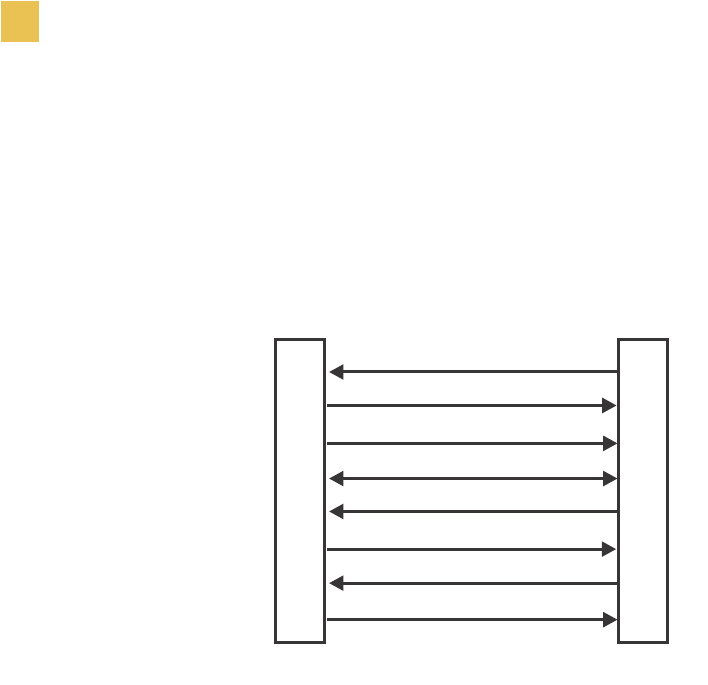
100 R110/R170XiIIIPlus User Guide
Data Ports
Standard Ports
Modem Connection
When the printer is connected via its RS-232 interface to Data Communication Equipment
(DCE) such as a modem, use a standard RS-232 (straight-through) interface cable.
This illustration shows the connections required for this cable.
DTE
(Printer)
DCE
(Modem, etc.)
RXD (receive data)
TXD (transmit data)
DTR (data terminal ready)
SG (signal ground)
DSR (data set ready)
RTS (request to send)
CTS (clear to send)
+5 VDC signal source
NOTE: Pin 1 is unused and unterminated at the printer.
2
3
4
5
6
7
8
9
2
3
4
5
6
7
8
9
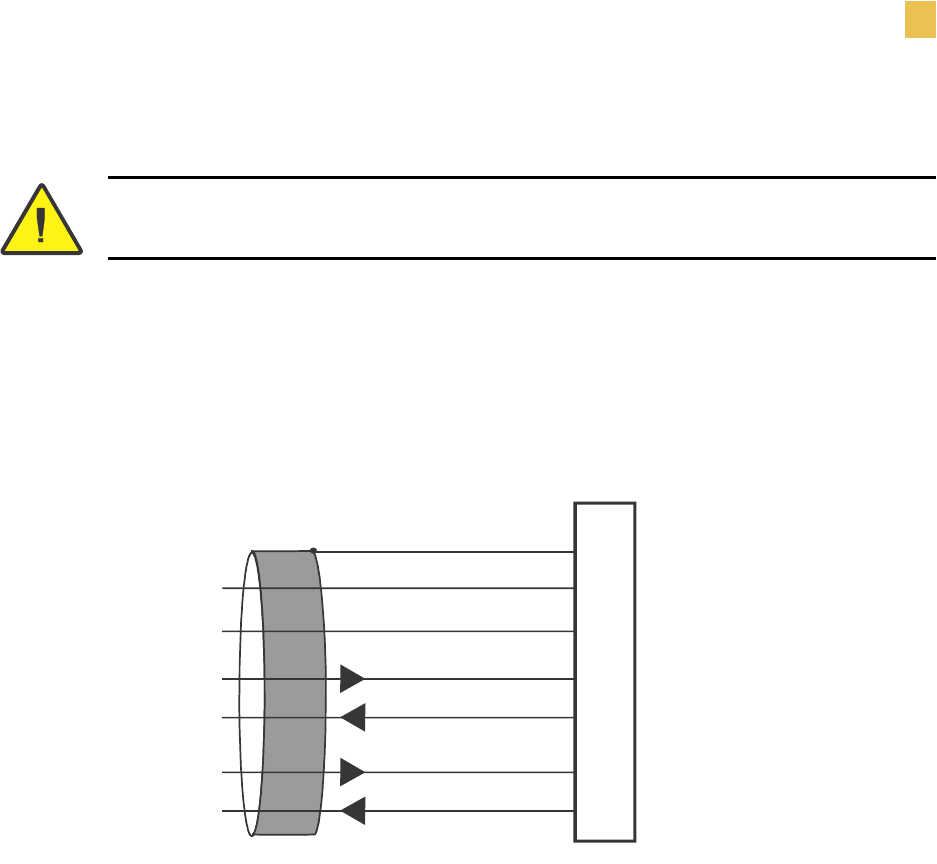
Data Ports
Standard Ports
R110/R170XiIIIPlus User Guide 101
RS-422/RS-485 Interconnections
An interface adapter (Zebra part number 33114M) is required to connect the printer’s RS-232
DB-9 interface to a host computer through an RS-422 or RS-485 interface. A generic DB-25
adapter can be used.
This illustration shows the cable wiring for interconnecting the DB-9 to the interface adapter’s
DB-25 female connector.
Caution • A qualified service technician must install a jumper on the printer’s main logic
board at JP1, pins 2 and 3, for the RS-422/RS-485 interface adapter to function properly.
Female DB-25 Connector on
RS-422/RS-485 Adapter
Data input B (–)
Data input A (+)
Data output B (–)
Data output A (+)
Frame ground
Signal ground ref.
+5 VDC 725 mA source
1
9
11
13
14
16
19
NOTE: Pins 2–8, 10, 12, 15, 17, 18, and 20–25 are unused and unterminated.
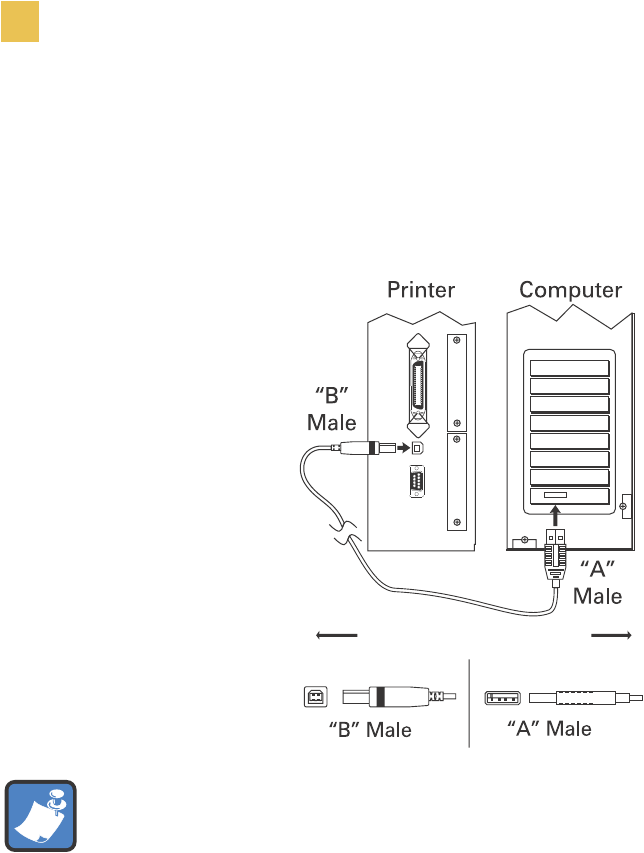
102 R110/R170XiIIIPlus User Guide
Data Ports
Standard Ports
USB 2.0 Port
A USB 2.0 port (which is USB 1.1 and 1.0 compatible) is available to connect your printer to
the host equipment. The industry-standard USB cable has an A-male connector on one end and
a B-male connector on the other end as shown in the following illustration.
=
Note • Use a USB 2.0-certified compliant cable no longer than 16.4 ft (5 m) long. A cable that
meets these requirements is available from Zebra (part number 33011).
16.4 ft (5 m) maximum

R110/R170XiIIIPlus User Guide 103
CHAPTER 8
Memory Cards
This chapter describes the optional cards that can be used with the printer and gives
instructions for installation.
Contents
PCMCIA Card . . . . . . . . . . . . . . . . . . . . . . . . . . . . . . . . . . . . . 104
CompactFlash Card . . . . . . . . . . . . . . . . . . . . . . . . . . . . . . . . 106
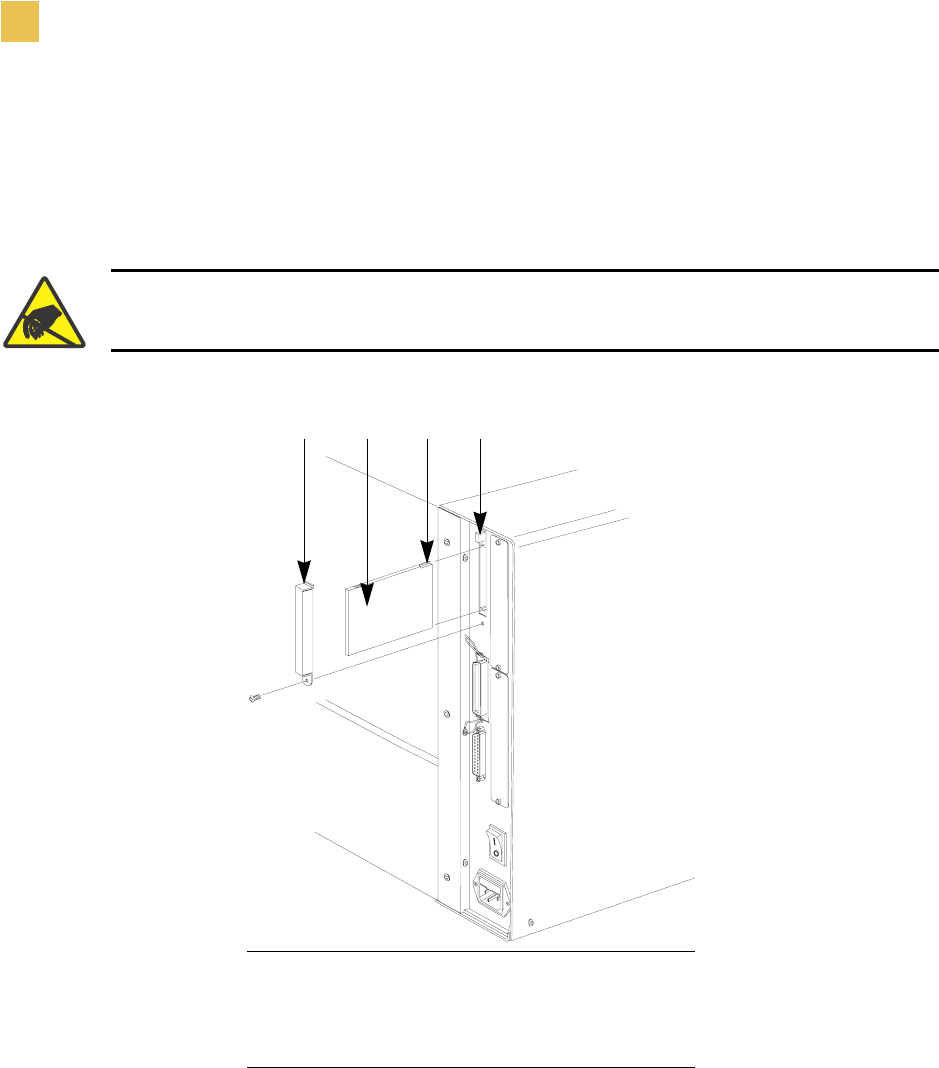
104 R110/R170XiIIIPlus User Guide
Memory Cards
PCMCIA Card
PCMCIA Card
A Type 1- or Type II-compliant PCMCIA card holds extra memory or font options for the
printer. The card is hot-swappable (it can be installed while the printer is on).
This illustration identifies the components used in this procedure.
Caution • Observe proper electrostatic safety precautions when handling any static-sensitive
components such as circuit boards and printheads.
1PCMCIA card shield
2Notch
3PCMCIA card
4Card-eject button
1 2 3 4
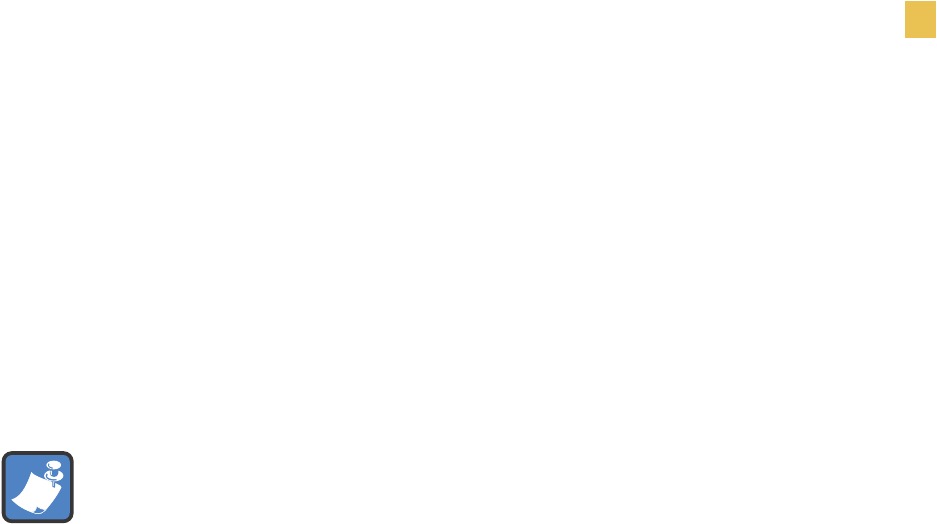
Memory Cards
PCMCIA Card
R110/R170XiIIIPlus User Guide 105
To install the PCMCIA card, complete these steps:
1. Remove the PCMCIA card shield from the rear of the printer as shown.
2. Insert the PCMCIA card, with the notch up, into the card slot as shown. Insert it far
enough to make the eject button pop out.
3. Reinstall the PCMCIA card shield over the PCMCIA card and card slot.
The printer is ready to operate with the additional memory or font option. To be
sure that the card has successfully initialized, print a configuration label as
instructed in Print a Configuration Label on page 29 and review it to see whether
the new memory card information is listed.
Note • The PCMCIA card may take a few minutes to initialize. The PAUSE light
flashes while the card initializes. If the card is already initialized, the PAUSE light
flashes only once or twice after the card is installed.
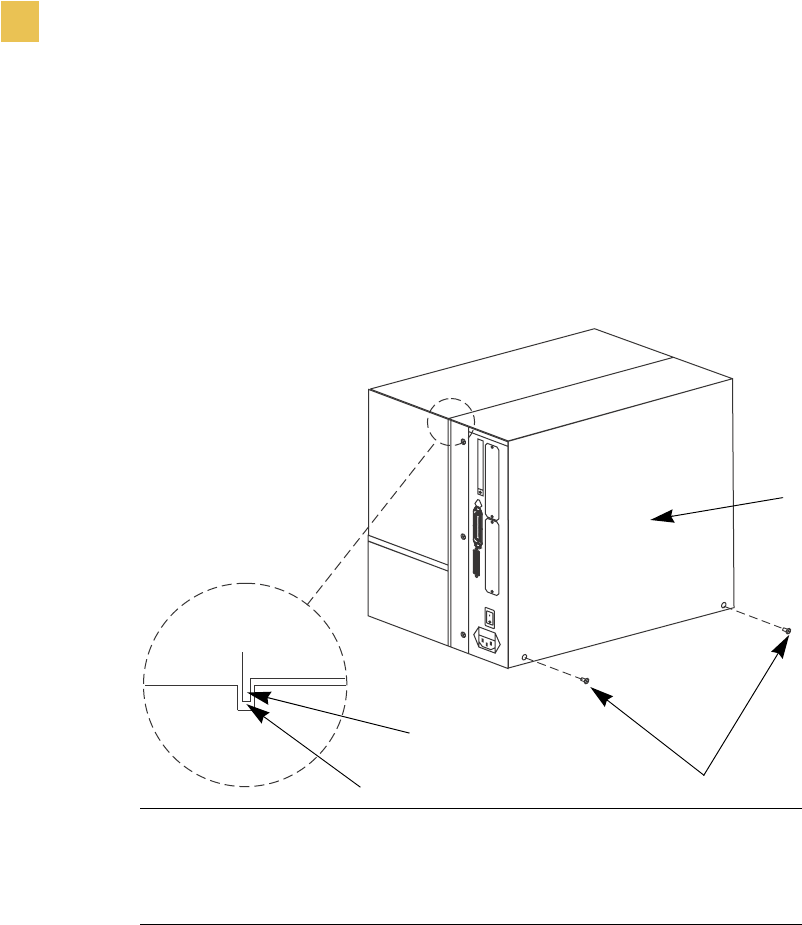
106 R110/R170XiIIIPlus User Guide
Memory Cards
CompactFlash Card
CompactFlash Card
A CompactFlash card is a nonvolatile memory card that stores data even when the power to
the printer is turned off. A Type I-compliant CompactFlash card holds extra memory or
optional fonts for your printer.
This illustration shows the parts of the printer used in this procedure.
1Electronics cover
2Screws
3Channel
4Lip of cover
3
42
1
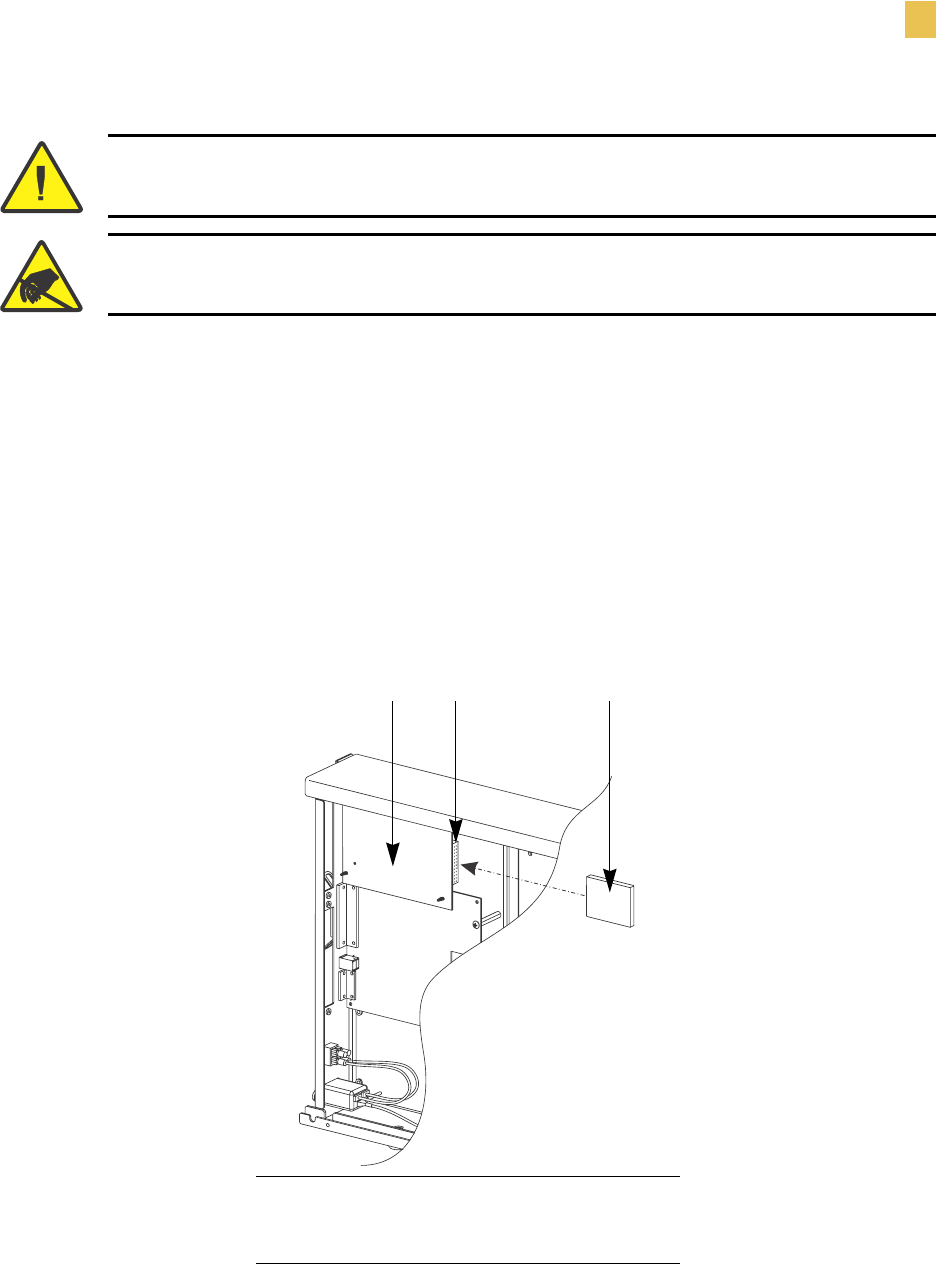
Memory Cards
CompactFlash Card
R110/R170XiIIIPlus User Guide 107
To install a CompactFlash card, complete these steps:
1. Turn the AC power Off (O).
2. Disconnect the AC power cord from the printer.
3. Remove the two screws near the bottom of the electronics cover.
4. Lift the electronics cover at the rear top corner. Pull the corner forward and up, then lift the
cover up and away from the printer.
5. Insert the CompactFlash card into the card slot on the upper portion of the option board.
Insert the card with the back (unlabeled) side of the card facing out. The card can be
inserted only one way and should snap into place.
The following illustration shows where to insert the CompactFlash card.
Caution • This procedure should only be performed by qualified service technicians.
Caution • Observe proper electrostatic safety precautions when handling any static-sensitive
components such as circuit boards and printheads.
1Option board
2Card slot
3Compact flash card
1 2 3

108 R110/R170XiIIIPlus User Guide
Memory Cards
CompactFlash Card
6. Reinstall the electronics cover by lowering the cover so the lip of the cover goes into the
channel on the top of the printer.
7. Secure the cover by reinstalling the two screws near the bottom of the cover.
8. Reconnect the printer AC power cord.
9. Press and hold CANCEL while turning the printer On (I).
The printer prints a configuration label.
10. Check for the presence of additional memory or optional fonts by looking at the
information on the configuration label.
Note • The CompactFlash card may take a few minutes to initialize. If the process is not
successfully completed within 10 minutes, contact Technical Support at
http://www.zebra.com/SS/service_support.htm for assistance.

R110/R170XiIIIPlus User Guide 109
CHAPTER 9
Routine Maintenance
Cleaning your printer regularly maintains print quality and may extend the life of the printer.
This appendix provides routine cleaning and maintenance procedures.
Contents
Cleaning Schedule . . . . . . . . . . . . . . . . . . . . . . . . . . . . . . . . . 110
Clean Exterior . . . . . . . . . . . . . . . . . . . . . . . . . . . . . . . . . . . . . 111
Clean Interior. . . . . . . . . . . . . . . . . . . . . . . . . . . . . . . . . . . . . . 111
Printhead and Platen Roller . . . . . . . . . . . . . . . . . . . . . . . . 111
Sensors . . . . . . . . . . . . . . . . . . . . . . . . . . . . . . . . . . . . . . . . 113
Snap Plate. . . . . . . . . . . . . . . . . . . . . . . . . . . . . . . . . . . . . . 115
Cutter. . . . . . . . . . . . . . . . . . . . . . . . . . . . . . . . . . . . . . . . . . 116
Replace Fuse . . . . . . . . . . . . . . . . . . . . . . . . . . . . . . . . . . . . . 117
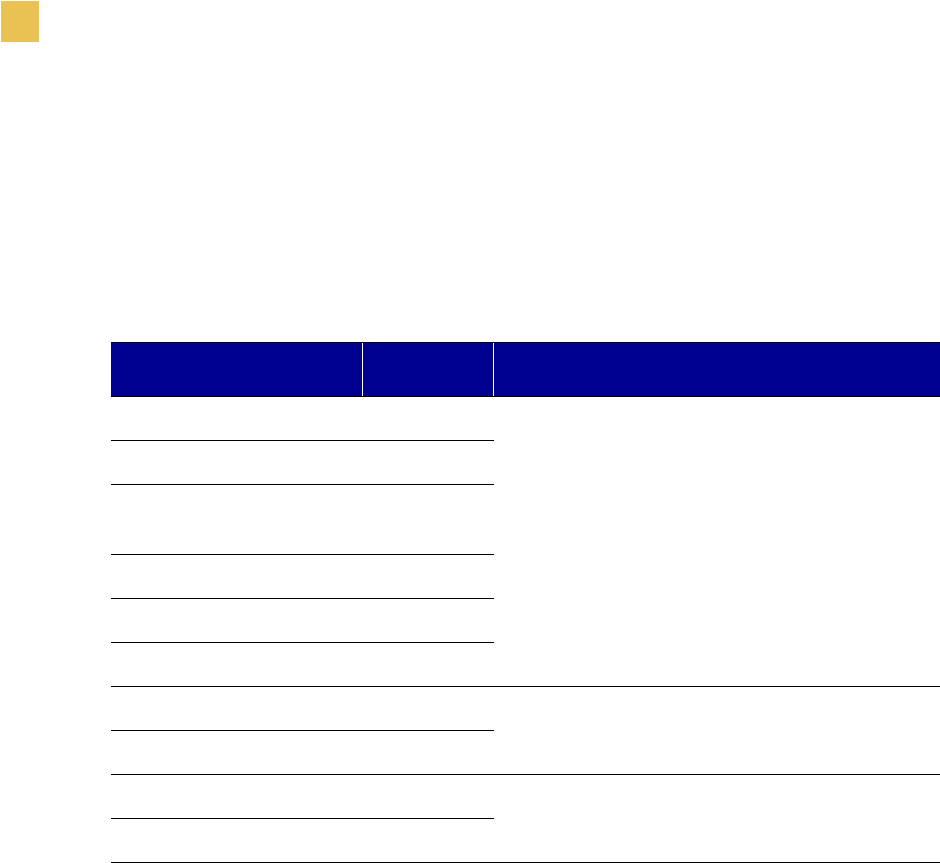
110 R110/R170XiIIIPlus User Guide
Routine Maintenance
Cleaning Schedule
Cleaning Schedule
The recommended cleaning schedule is shown in the table below. See the following pages for
specific procedures.
Caution • Use only the cleaning agents indicated. Zebra is not responsible for damage
caused by any other fluids being used on this printer.
Area Method Interval
Printhead Solvent*† Perform these procedures at the following times:
• When CLEAN HEAD NOW appears.
• Direct Thermal Print Mode: After every
roll of labels or 500 ft (150 m) of fanfold
labels.
• Thermal Transfer Print Mode: After
every roll (1500 ft or 450 m) of ribbon.
Platen roller Solvent*
Transmissive (media)
sensor
Air blow
Black mark sensor Air blow
Media path Solvent*
Ribbon sensor Air blow
Label-available sensors Air blow Monthly
Tear-off/peel-off bar Solvent*
Snap plate Solvent* As needed
Cutter Solvent*
* Use Zebra’s Preventative Maintenance kit, part number 47362, or a solution of
90% isopropyl alcohol and 10% deionized water.
† For 600 dpi printers, use Zebra’s Save-a-Printhead cleaning film. This specially coated
material removes contamination buildup without damaging the printhead. Call your
authorized Zebra reseller or distributor for more information.
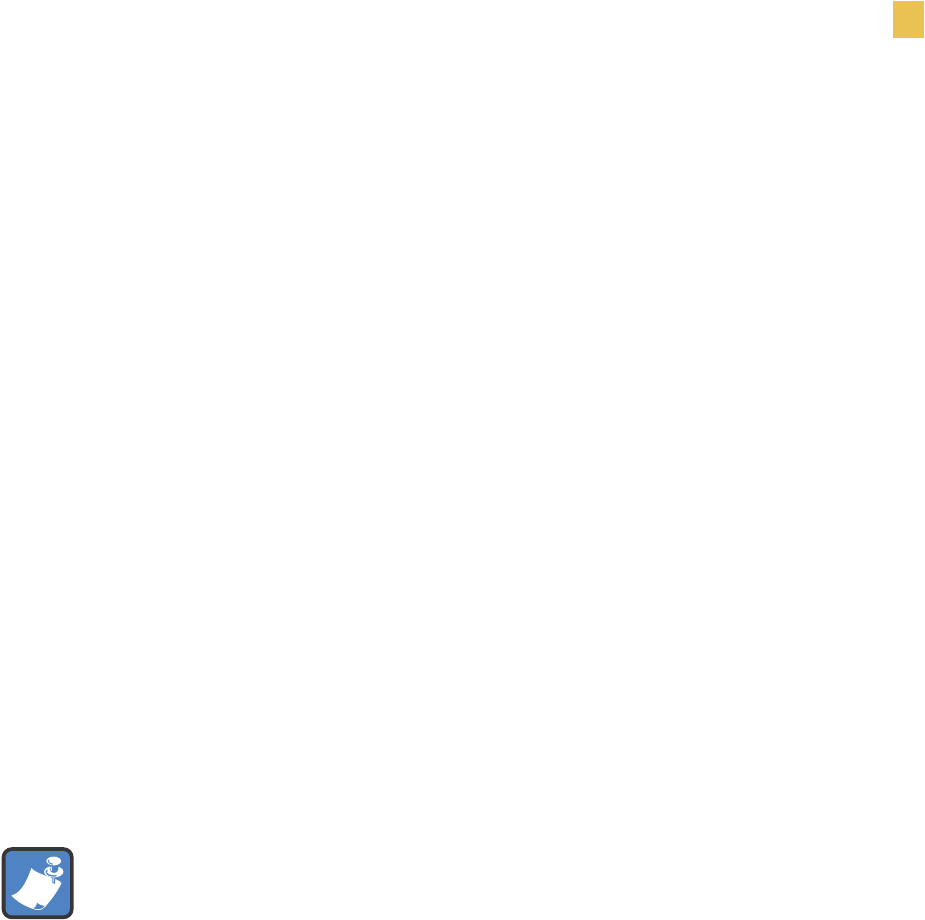
Routine Maintenance
Clean Exterior
R110/R170XiIIIPlus User Guide 111
Clean Exterior
Clean the outside surfaces of the printer with a lint-free cloth. Use a mild detergent solution or
desktop cleaner sparingly, as needed.
Clean Interior
After every four rolls of labels, inspect the inside of the printer. Use a soft bristle brush or a
vacuum cleaner to remove any dirt and lint from the interior of the printer.
Printhead and Platen Roller
After every roll of ribbon, clean the printhead. Clean the printhead more often if you see
inconsistent print quality, such as voids in the bar code or graphics.
For 200 and 300 dpi printers Clean after every roll (1500 feet or 450 m) of thermal
transfer ribbon or after every roll (500 feet or 150 m) of direct thermal labels or when CLEAN
HEAD NOW appears on the LCD.
For 600 dpi printers Clean after each roll (500 feet or 150 m) of labels or when CLEAN
HEAD NOW appears on the LCD.
Caution • Do not use harsh or abrasive cleaning agents or solvents.
Notes • You do not need to turn off the printer before cleaning the printhead.
If power is turned off, all label formats and images, as well as any temporarily saved
parameter settings stored in the printer’s internal memory, are lost. When power is turned
back on, these items must be reloaded.
If power is removed from a 600 dpi printer when cleaning the printhead, the CLEAN HEAD
NOW warning shown on the LCD will not disappear.
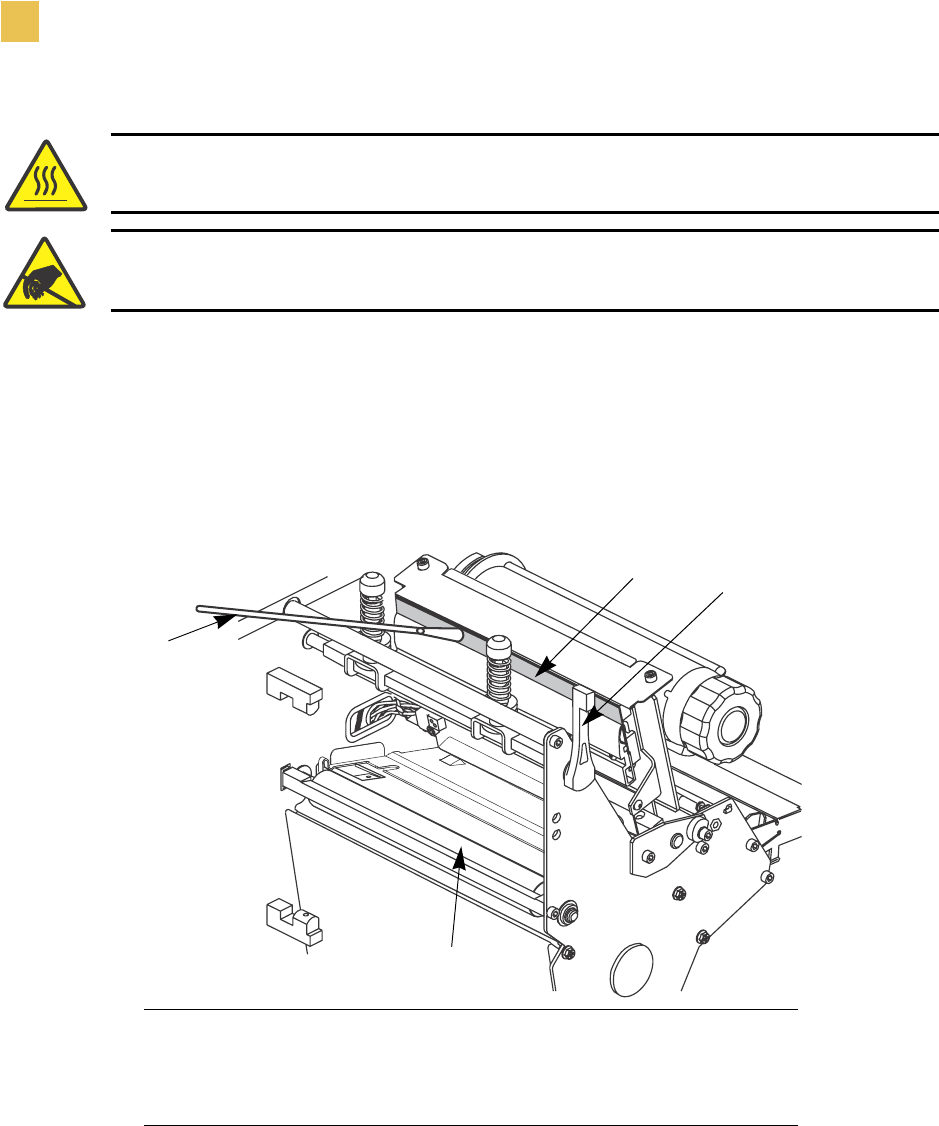
112 R110/R170XiIIIPlus User Guide
Routine Maintenance
Clean Interior
To clean the printhead and platen roller, complete these steps:
1. Open the printhead.
2. Remove the labels and ribbon (if loaded).
3. Use Zebra’s Preventative Maintenance kit, part number 47362, or a solution of
90% isopropyl alcohol and 10% deionized water on an applicator to wipe along the print
elements from end to end, as shown in the following illustration. (The print elements are
on the brown strip on the printhead.) Allow a few seconds for the solvent to evaporate.
4. Rotate the platen roller and clean thoroughly with solvent and an applicator.
5. Brush or vacuum any accumulated paper lint and dust away from the rollers.
6. Reload ribbon (if required).
7. Close the printhead.
Caution • The printhead is hot and can cause severe burns. Allow the printhead to cool.
Electrostatic Discharge Caution • Observe proper electrostatic safety precautions when
handling any static-sensitive components such as circuit boards and printheads.
1Applicator
2Platen roller
3Printhead print elements
4Printhead lever
1
2
34
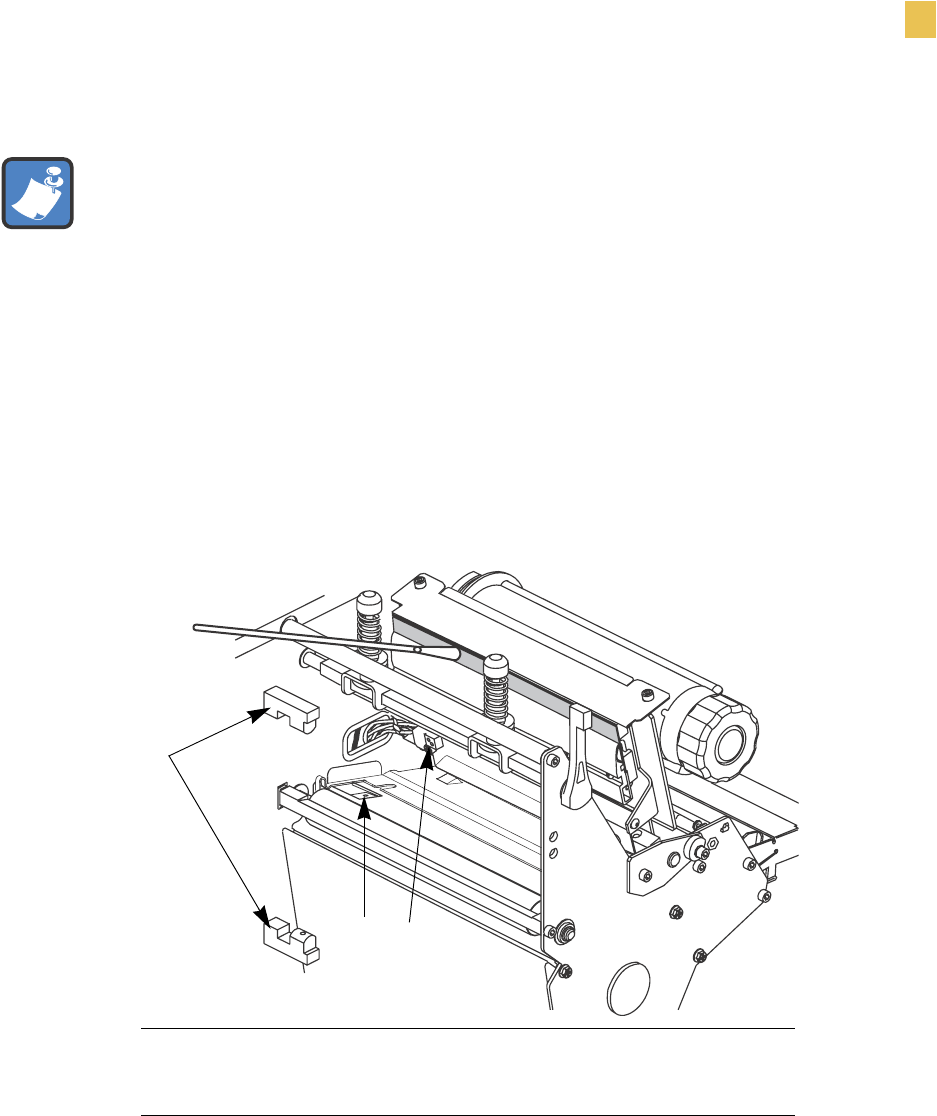
Routine Maintenance
Clean Interior
R110/R170XiIIIPlus User Guide 113
Sensors
Brush or vacuum any accumulated paper lint and dust off the sensors whenever the sensors are
blocked. At minimum, clean the sensors according to the recommendations in Cleaning
Schedule on page 110.
Ribbon and Label-Available Sensor Locations
The ribbon sensor and optional label-available sensor are shown in the following illustration.
Transmissive (Media) Sensor Locations
Upper and lower transmissive (media) sensors are shown in the following illustrations.
Note • If print quality does not improve when you perform this procedure, clean the printhead
with Save-a-Printhead cleaning film. This specially coated material removes contamination
buildup without damaging the printhead. Call your authorized Zebra reseller or distributor for
more information.
1Label-available sensors
2Black mark sensor
3Ribbon sensor
1
23
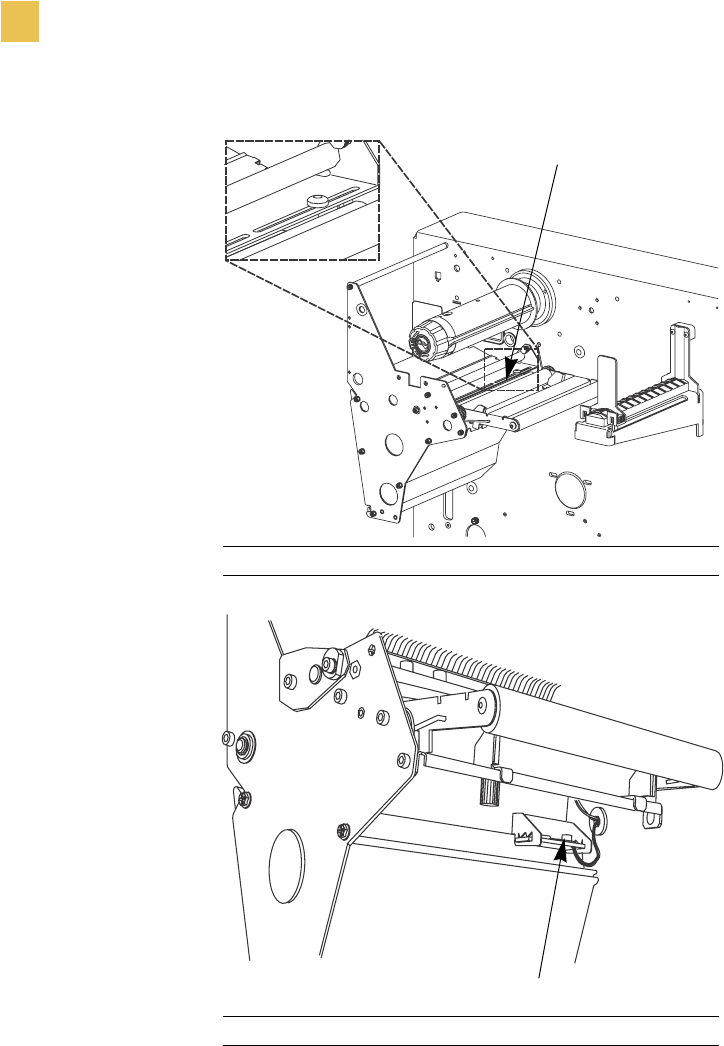
114 R110/R170XiIIIPlus User Guide
Routine Maintenance
Clean Interior
1Upper media sensor
1Lower media sensor
1
1
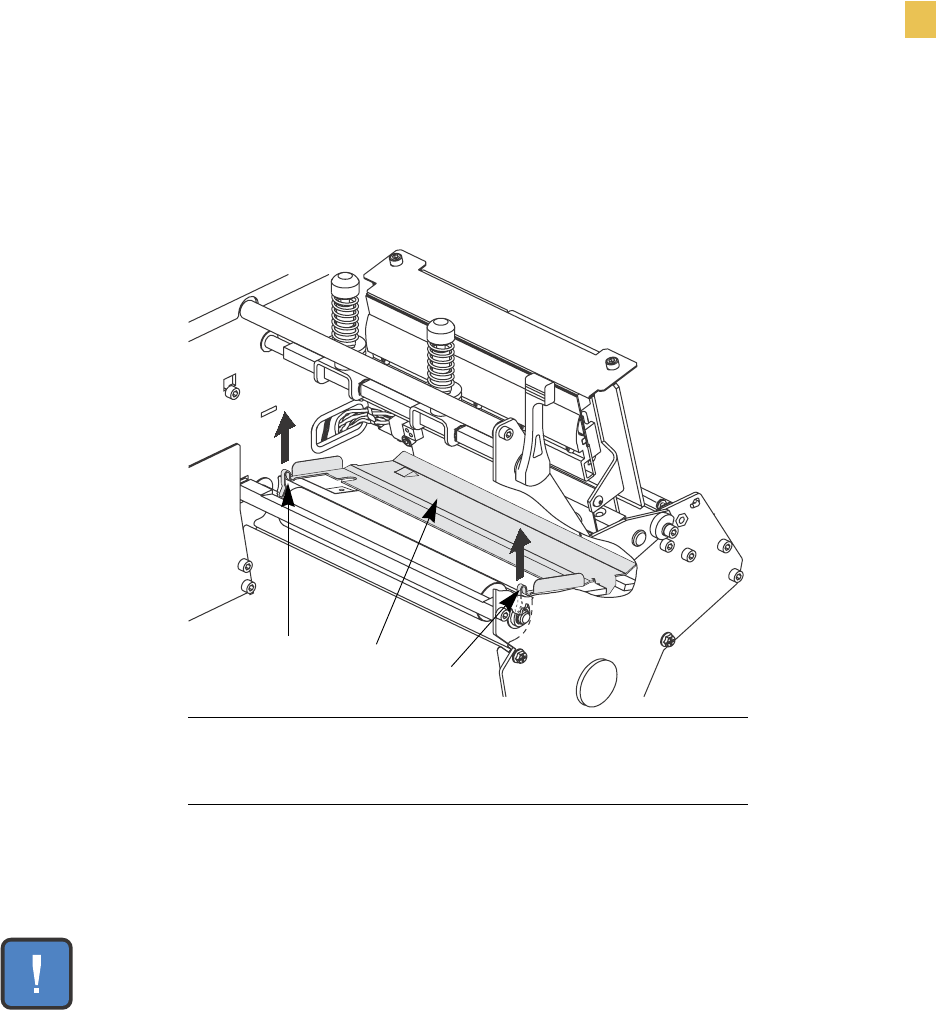
Routine Maintenance
Clean Interior
R110/R170XiIIIPlus User Guide 115
Snap Plate
Clean the snap plate when label adhesive or a label is stuck to the underside of the snap plate.
This illustration shows snap plate and the loops on either side.
To clean the snap plate, complete these steps:
1. Insert a small-blade screwdriver or similar tool into the loop on the left side of the snap
plate.
2. Gently lift the left side of the snap plate.
3. Insert a small-blade screwdriver or similar tool into the loop on the right side of the snap
plate.
4. Gently lift the right side of the snap plate.
5. Remove the snap plate from the printer.
6. Clean the snap plate with cleaning solvent and a soft cloth.
7. To reinstall the snap plate, insert the two tabs on the bottom of the snap plate into the two
slots of the media path.
8. Slide the snap plate toward you.
1Left loop
2Snap plate
3Right loop
Important • Take care not to bend, twist, or otherwise deform the loops. If the snap plate
is damaged in any way, you may need a new plate for proper ribbon sensing.
123
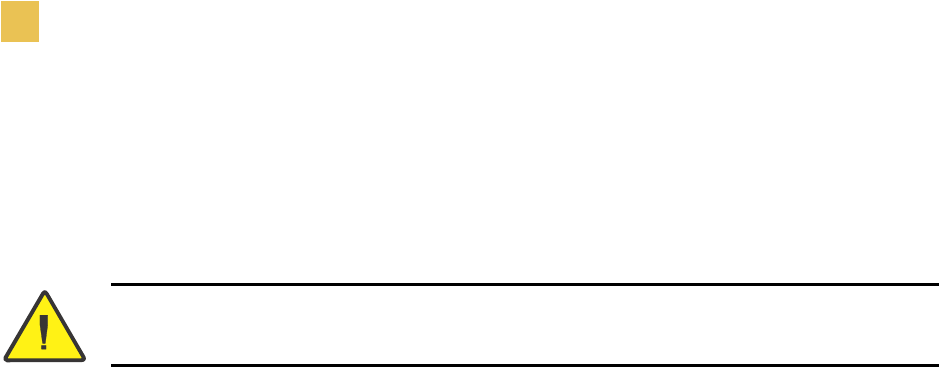
116 R110/R170XiIIIPlus User Guide
Routine Maintenance
Clean Interior
9. Press down on the loops to lock the snap plate into place.
Cutter
If the cutter is not cutting the labels cleanly or if it jams with labels, clean the cutter.
To clean the cutter, complete these steps:
1. Turn Off (O) the printer.
2. Unplug the power cord.
3. Clean the stationary cutter blade with solvent.
If this does not remove label fragments and adhesive, contact an authorized service
technician.
Caution • The cutter blade is sharp. Do not touch or rub the blade with your fingers.
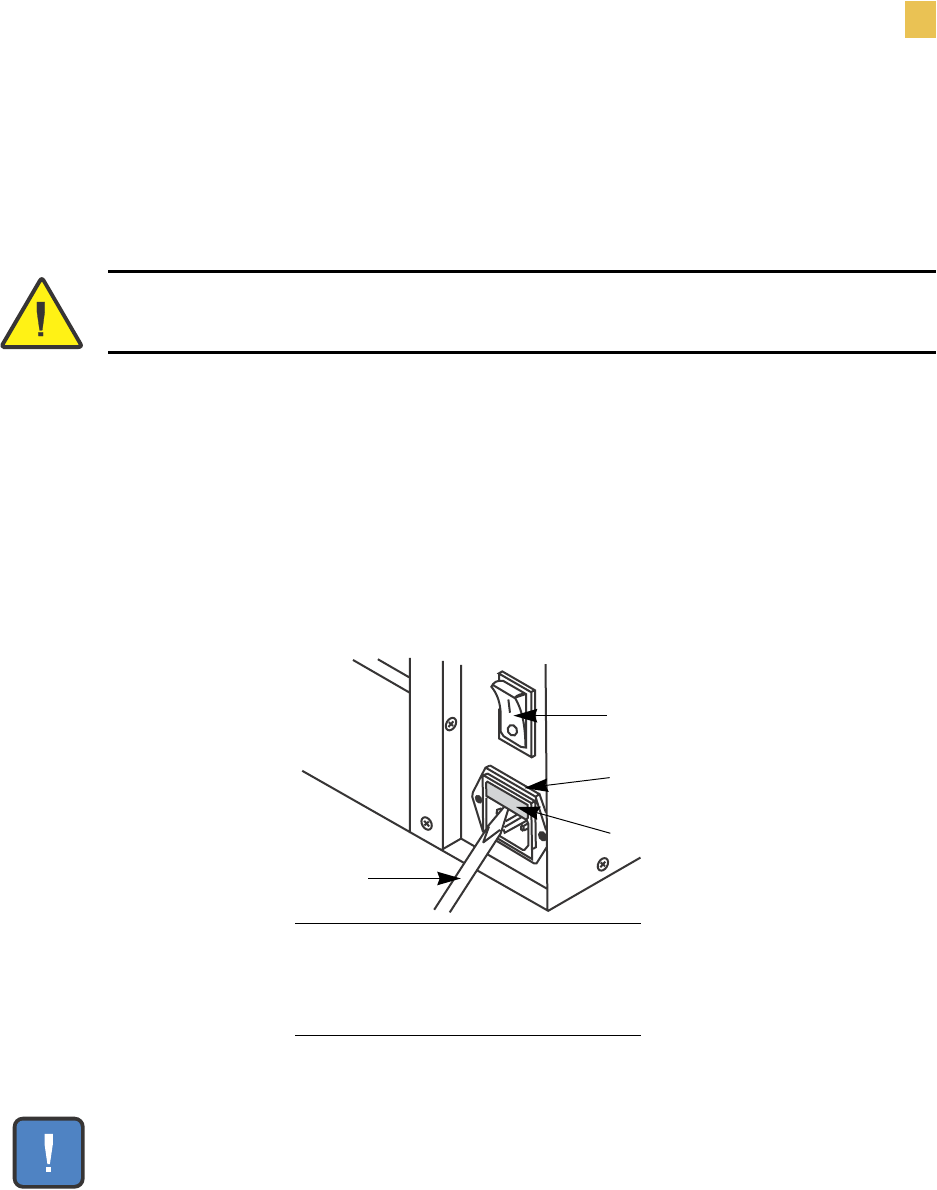
Routine Maintenance
Replace Fuse
R110/R170XiIIIPlus User Guide 117
Replace Fuse
The fuse is user-replaceable in the R170XiIIIPlus printer. The R110XiIIIPlus fuse must be
replaced only by an authorized service technician.
The printer uses a metric-style fuse (5 × 20 mm IEC) rated at F5A, 250 V. The AC power entry
module comes with two approved fuses in the fuse holder: one is in-circuit, and the second is
provided as a spare. The end caps of the fuse must bear the certification mark of a known
international safety organization.
To replace a faulty fuse, complete these steps:
1. Use a small-blade screwdriver or similar tool to remove the fuse holder.
The fuse holder is part of the AC power entry module at the rear of the printer. This
illustration identifies the parts of the AC power entry module.
2. Remove the faulty fuse and install a new fuse in the in-circuit position as shown.
This illustration identifies the parts of the fuse holder.
Caution • Turn the AC power switch Off (O) and remove the power cord before performing
this procedure.
1Power switch
2Fuse holder
3AC power entry module
4Small-blade screwdriver
Important • If you use the spare fuse, be sure to order a replacement fuse from your
authorized Zebra distributor. The spare fuse should be the exact type and rating as the
original in-circuit fuse.
1
2
3
4
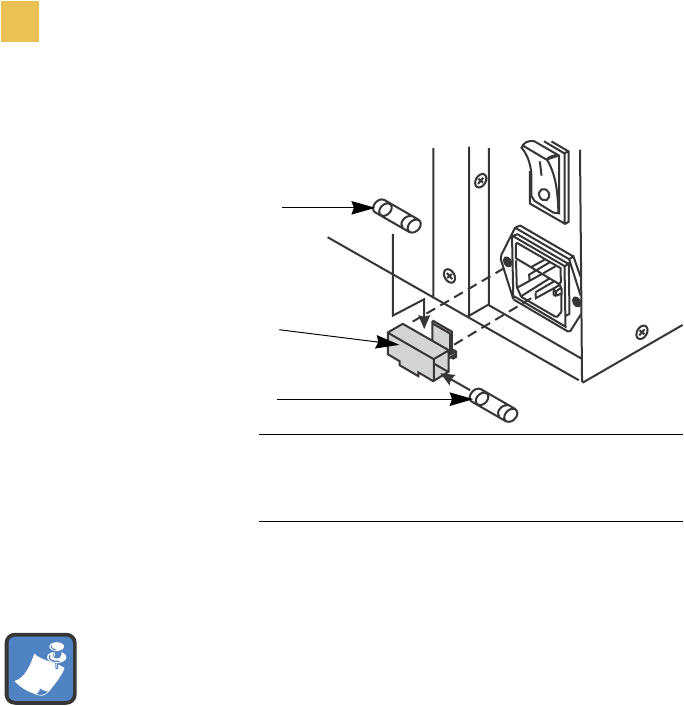
118 R110/R170XiIIIPlus User Guide
Routine Maintenance
Replace Fuse
3. Snap the fuse holder back into the AC power entry module.
4. Reconnect the power cord, and turn the printer On (I).
1In-circuit fuse
2Fuse holder
3Spare fuse
Note • If the printer does not power on, an internal component failure may have occurred, and
the printer requires servicing by an authorized service technician.
1
2
3

R110/R170XiIIIPlus User Guide 119
CHAPTER 10
Troubleshooting
This chapter provides you with information about LCD, print quality, communications, and
other errors that you might need to troubleshoot.
Contents
Troubleshooting. . . . . . . . . . . . . . . . . . . . . . . . . . . . . . . . . . . . 120
LCD Error Messages. . . . . . . . . . . . . . . . . . . . . . . . . . . . . . . . 121
Print Quality Problems. . . . . . . . . . . . . . . . . . . . . . . . . . . . . . . 126
Communications Problems . . . . . . . . . . . . . . . . . . . . . . . . . . . 129
Printer Diagnostics . . . . . . . . . . . . . . . . . . . . . . . . . . . . . . . . . 131
Power-On Self Test . . . . . . . . . . . . . . . . . . . . . . . . . . . . . . . 131
Additional Printer Self Tests . . . . . . . . . . . . . . . . . . . . . . . . 131
Communications Diagnostics Test . . . . . . . . . . . . . . . . . . . 135
Additional Printer Diagnostics . . . . . . . . . . . . . . . . . . . . . . . 135

120 R110/R170XiIIIPlus User Guide
Troubleshooting
Troubleshooting
Troubleshooting
If an error condition exists with the printer, review this checklist:
Is there an error message on the LCD? If yes, see LCD Error Messages
on page 121 for more information.
Is the CHECK RIBBON light on when ribbon is loaded properly or are
non-continuous labels are being treated as continuous labels? If yes, see Media and
Ribbon Sensor Calibration on page 32.
Are you experiencing problems with print quality? If yes, see Print Quality
Problems on page 126.
Are you experiencing communications problems? If yes, see Communications
Problems on page 129.
If the labels are not printing or advancing correctly, review this checklist:
Are you using the correct type of labels? Review the types of label in Types of
Media on page 15.
Review the label- and ribbon-loading illustrations, starting with Load the Printer
on page 20.
Check the position of the media sensor and move if necessary, as shown in Adjust
Sensors on page 32.
Does the printhead need to be adjusted? See Adjust the Printhead on page 37 for
more information.
Do the sensors need to be calibrated? See Media and Ribbon Sensor Calibration
on page 32 for more information.
If none of the above suggestions correct the problem, review this checklist:
Perform one or more of the self-tests given in Printer Diagnostics on page 131.
Use the results to help identify the problem.
If you are still having problems, see Support on page xx for customer support
information.
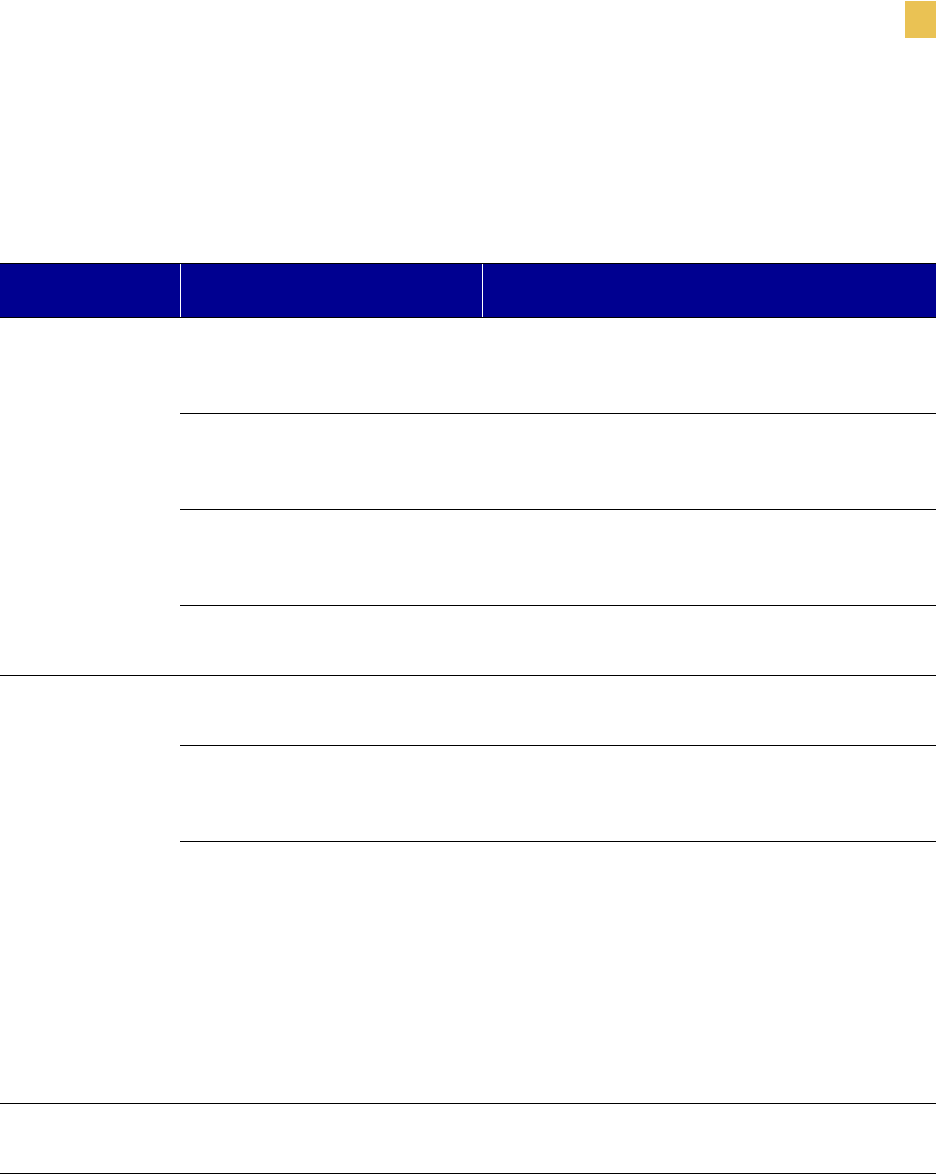
Troubleshooting
LCD Error Messages
R110/R170XiIIIPlus User Guide 121
LCD Error Messages
The LCD displays messages when there is an error. This table identifies LCD errors, the
possible causes, and the recommended solutions.
LCD Possible Cause Recommended Solution
RIBBON OUT Thermal Transfer Mode—
Ribbon is not loaded or is
loaded incorrectly.
Load the ribbon correctly, following directions in
Load Ribbon on page 24.
Thermal Transfer Mode—
Ribbon is loaded but the ribbon
sensor is not sensing the ribbon.
Adjust the media and ribbon sensors. See Media
and Ribbon Sensor Calibration on page 32.
Direct Thermal Mode—
Ribbon is loaded.
Make sure that ribbon is not loaded and that the
printer is in Direct Thermal Print Mode. See
Selecting Print Method on page 59.
Direct Thermal Mode—
Settings are incorrect.
Make sure the printer driver and software settings
are compatible with Direct Thermal Print Mode.
PAPER OUT Labels are not loaded or are
loaded incorrectly.
Load the labels correctly. See Load the Printer
on page 20.
Media Sensor is not adjusted
correctly.
Check the position of the media sensors, and
adjust if necessary. See Media and Ribbon Sensor
Calibration on page 32.
Printer is set for non-continuous
labels but continuous labels are
loaded.
• Make sure the labels and the Media Type
settings match. See Setting Media Type
on page 58.
• Make sure the printer driver or software
settings match the label and Media Type
settings.
• Calibrate the printer. For more information,
see Calibrate the Printer on page 31.
HEAD OPEN The printhead is not fully
closed.
Close the printhead.
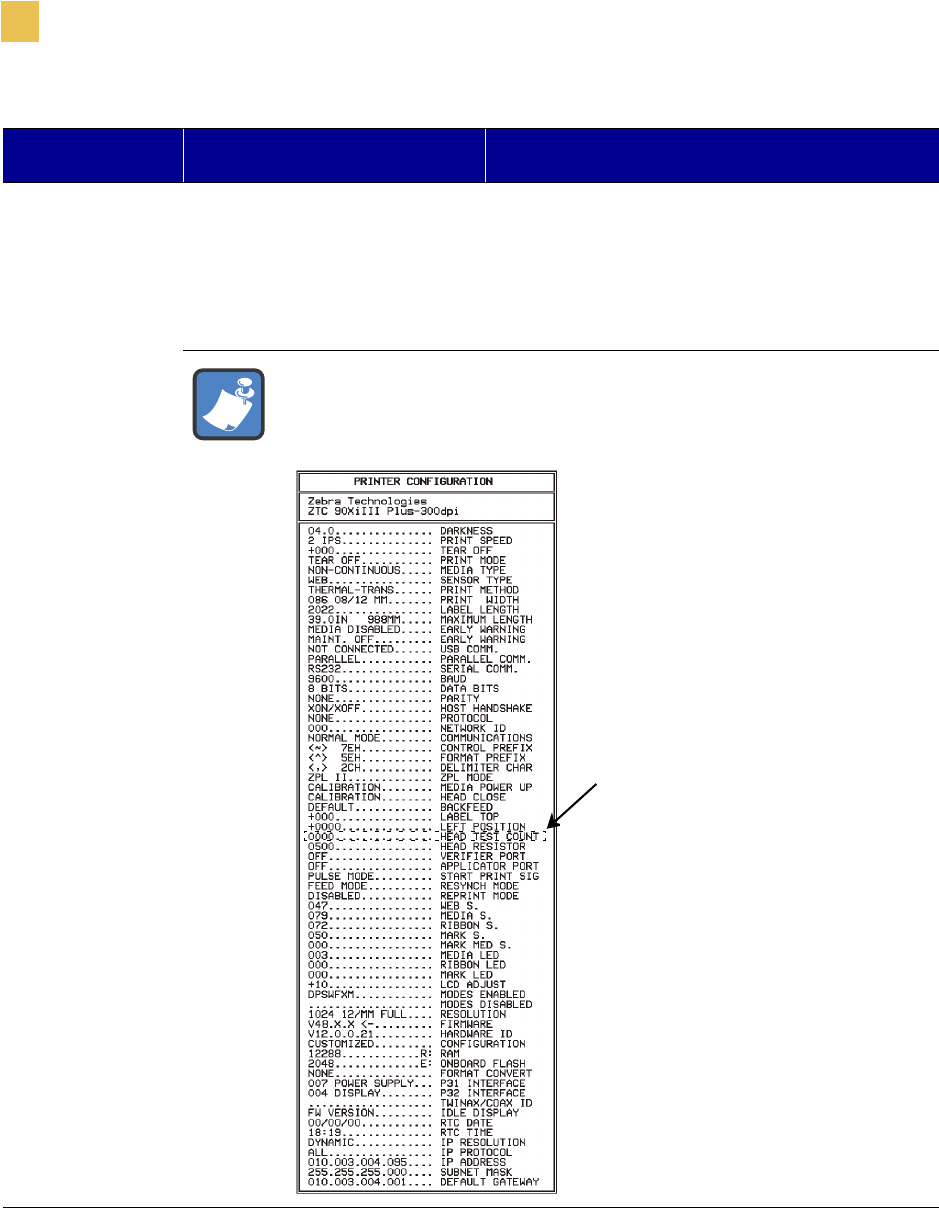
122 R110/R170XiIIIPlus User Guide
Troubleshooting
LCD Error Messages
HEAD ELEMENT
BAD
One or more of the printhead
elements failed the printhead
element test.
• If the failed elements affect your printing
application, replace the printhead.
• To override this error, disable the head test
count feature on the front panel by
defaulting the value to 0000.
Note • This message does not apply to 200 dpi and 300 dpi
R110XiIIIPlus printers. For 600 dpi R110XiIIIPlus printers, this message
would only be possible if the Head Test Count option is installed.
LCD Possible Cause Recommended Solution
If the Head Test Option is installed,
HEAD TEST COUNT will be listed
on the configuration label.
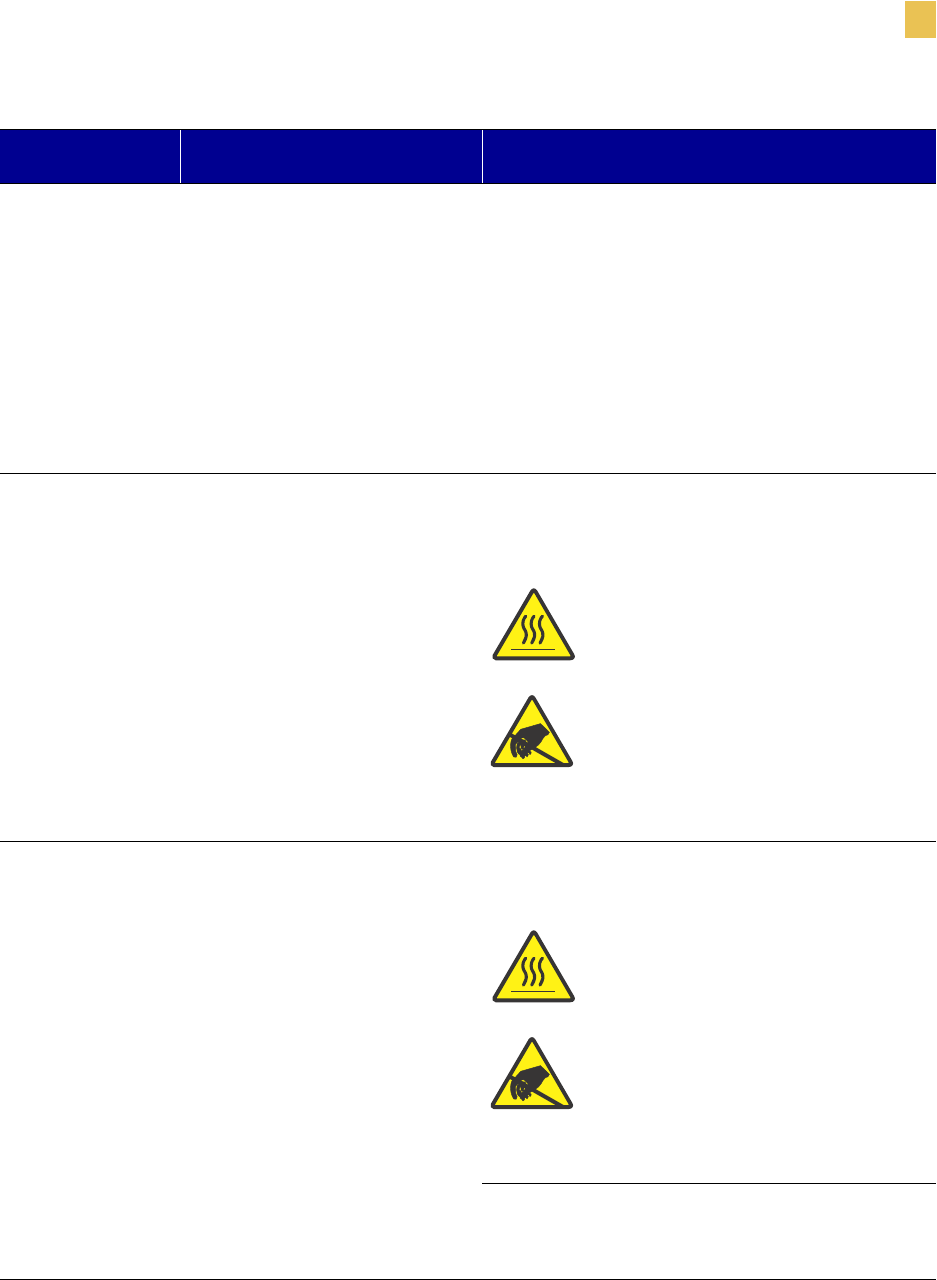
Troubleshooting
LCD Error Messages
R110/R170XiIIIPlus User Guide 123
RIBBON IN Ribbon is loaded, but the printer
is set for Direct Thermal mode.
• To operate in Direct Thermal mode, remove
the ribbon.
• To operate in Thermal Transfer mode, leave
the ribbon loaded and change the print
method to Thermal Transfer. See Selecting
Print Method on page 59.
• Ensure that the printer driver and/or
software settings are correctly set
(if applicable).
HEAD TOO HOT The printhead is over
temperature.
Printing automatically resumes when the
printhead elements cool to an acceptable
operating temperature.
Caution • The printhead is hot and
can cause severe burns. Allow the
printhead to cool.
Caution • Observe proper
electrostatic safety precautions
when handling any static-sensitive
components such as circuit boards
and printheads.
CLEAN HEAD
NOW
The printhead requires cleaning. Clean the printhead according to the instructions
in Printhead and Platen Roller on page 111.
Caution • The printhead is hot and
can cause severe burns. Allow the
printhead to cool.
Caution • Observe proper
electrostatic safety precautions
when handling any static-sensitive
components such as circuit boards
and printheads.
If the message does not go away after the
printhead is cleaned, open the printhead and then
close it.
LCD Possible Cause Recommended Solution
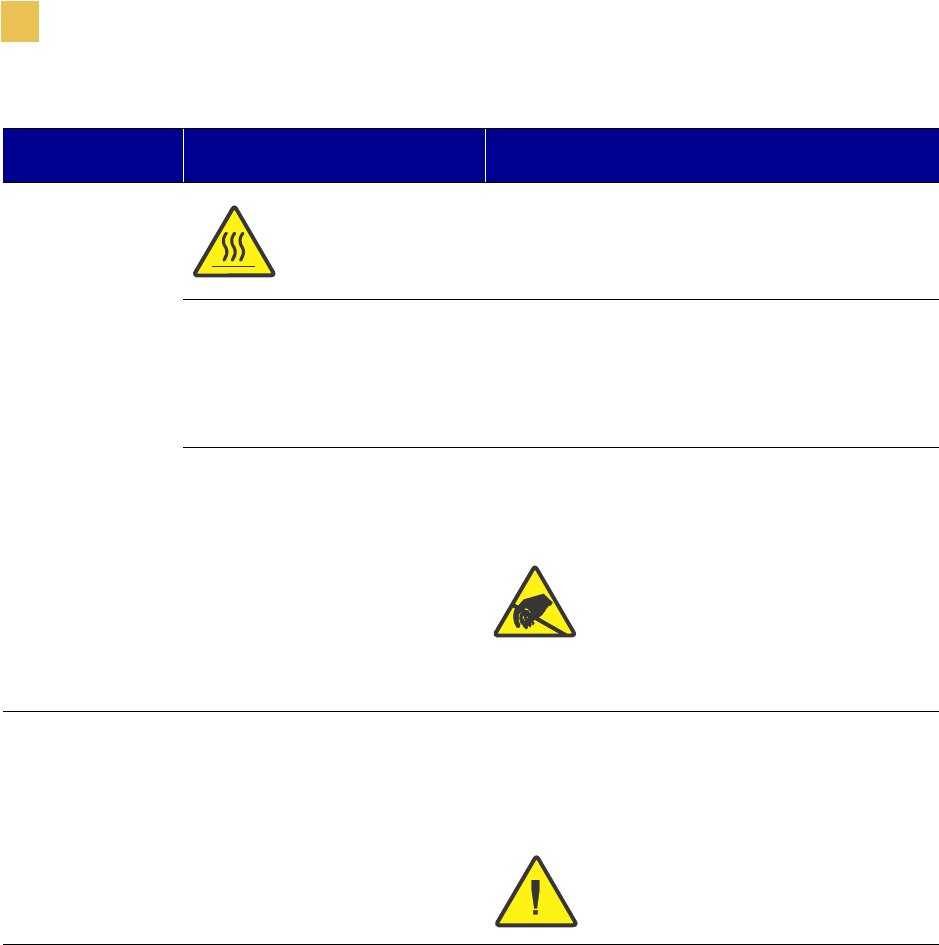
124 R110/R170XiIIIPlus User Guide
Troubleshooting
LCD Error Messages
HEAD COLD Caution • An improperly connected printhead data or power cable can
cause this error message. The printhead can still be hot enough to cause
severe burns. Allow the printhead to cool.
The printhead is under
temperature.
Continue printing while the printhead reaches the
correct operating temperature. If the error
remains, the environment may be too cold for
proper printing. Relocate the printer to a warmer
area.
Printhead data cable is not
properly connected.
Disconnect and reconnect the data cable to the
printhead. Ensure that the cable connector is fully
inserted into the printhead connector.
Caution • Observe proper
electrostatic safety precautions
when handling any static-sensitive
components such as circuit boards
and printheads.
CUTTER JAMMED Cutter blade is in the media
path.
Turn off the printer power and unplug the printer.
Inspect the cutter module for debris and clean as
needed following the cleaning instructions in
Cutter on page 116.
Caution • The cutter blade is sharp.
Do not touch or rub the blade with
your fingers.
LCD Possible Cause Recommended Solution
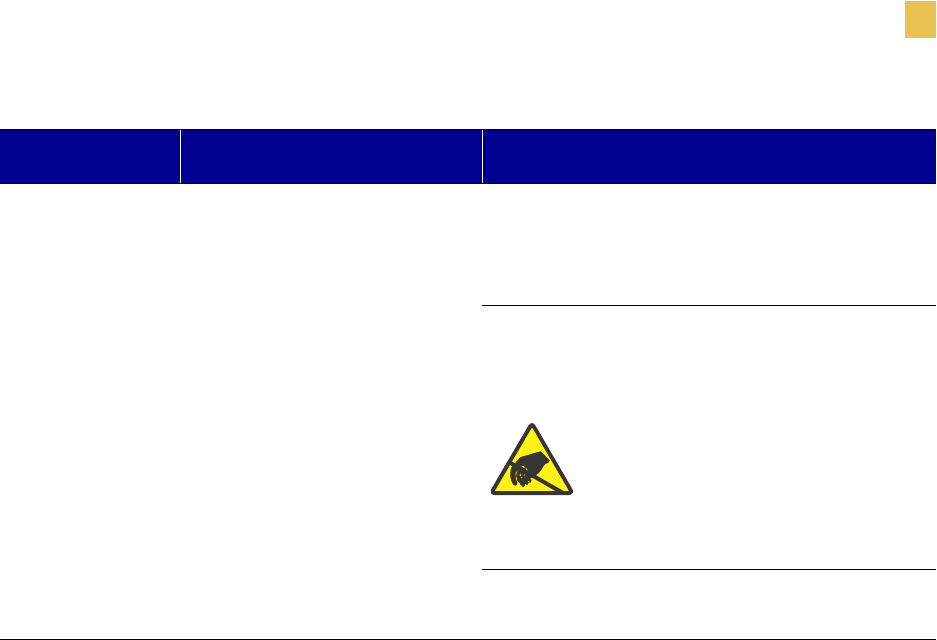
Troubleshooting
LCD Error Messages
R110/R170XiIIIPlus User Guide 125
OUT OF MEMORY There is not enough memory to
perform the function shown on
the second line of the error
message.
Turn the printer off then back on to clear memory,
and try to print again. If the error recurs, there is
insufficient memory for the label length,
downloaded fonts or graphics, and images.
Ensure that the device, such as Flash memory or
PCMCIA card, is installed and not write-
protected or full. See Memory Cards on page 103.
Caution • Observe proper
electrostatic safety precautions
when handling any static-sensitive
components such as circuit boards
and printheads.
Ensure that the data is not directed to a device that
is not installed or available.
LCD Possible Cause Recommended Solution
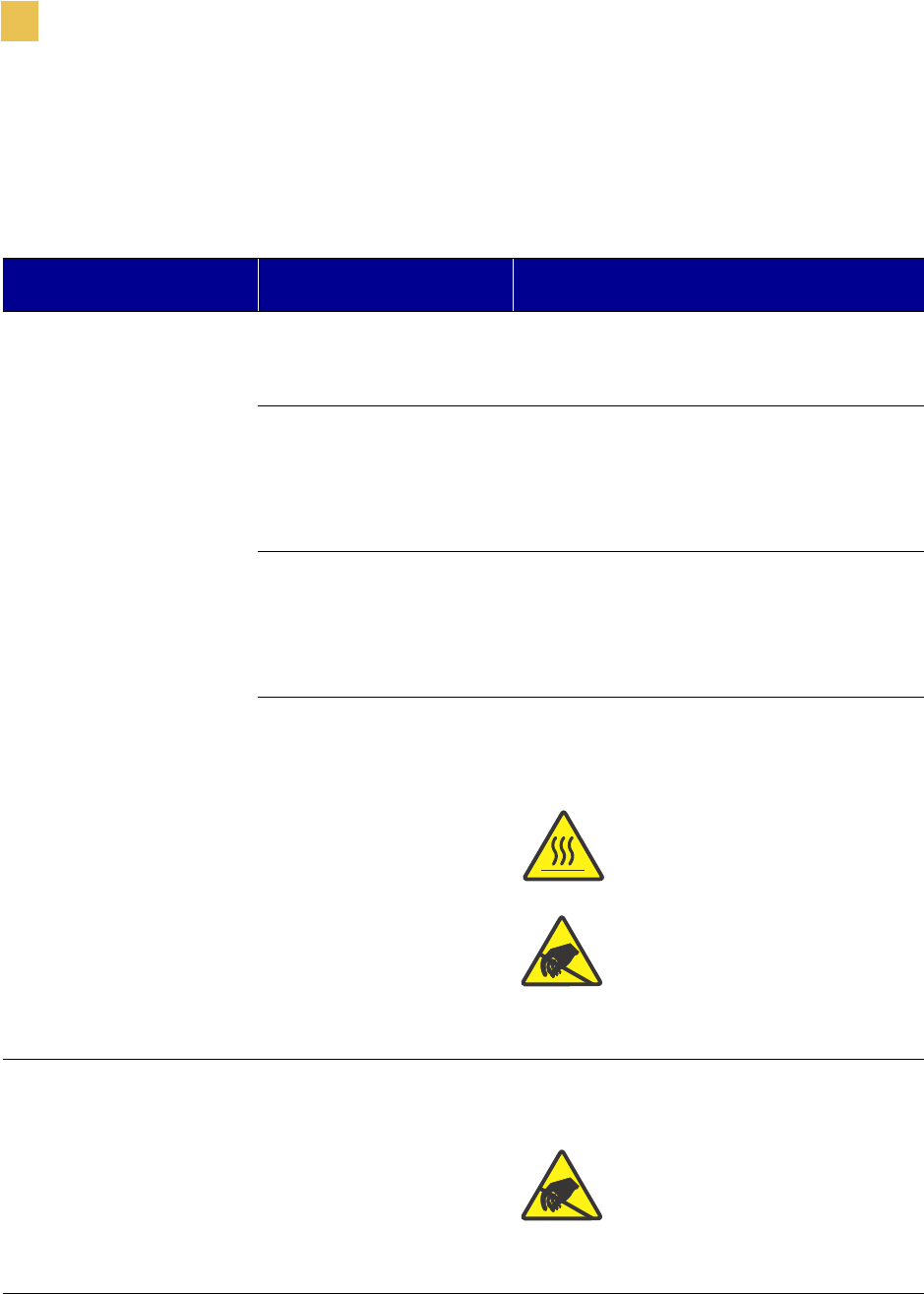
126 R110/R170XiIIIPlus User Guide
Troubleshooting
Print Quality Problems
Print Quality Problems
This table identifies problems with print quality, the possible causes, and the recommended
solutions.
Problem Possible Cause Recommended Solution
General print quality
issues
You are using an incorrect
combination of labels and
ribbon for your application.
Consult your authorized Zebra reseller or
distributor for information and advice.
The printer is set at the
incorrect print speed.
For optimal print quality, set the print speed
to the lowest possible setting for your
application via ZPL II, the driver, or the
software. See Adjusting Print Speed
on page 57.
The printer is set at an
incorrect darkness level.
For optimal print quality, set the darkness to
the lowest possible setting for your
application via the front panel, the driver, or
the software. See Adjusting Print Darkness
on page 57.
The printhead is dirty. Clean the printhead according to the
instructions in Printhead and Platen Roller
on page 111.
Caution • The printhead is hot
and can cause severe burns. Allow
the printhead to cool.
Caution • Observe proper
electrostatic safety precautions
when handling any static-
sensitive components such as
circuit boards and printheads.
There is light printing
(or no printing) on the
left or right side of the
label or the printed
image is not sharp.
The toggle pressure needs
to be adjusted.
Follow the instructions in Adjust the
Printhead on page 37.
Caution • Observe proper
electrostatic safety precautions
when handling any static-
sensitive components such as
circuit boards and printheads.
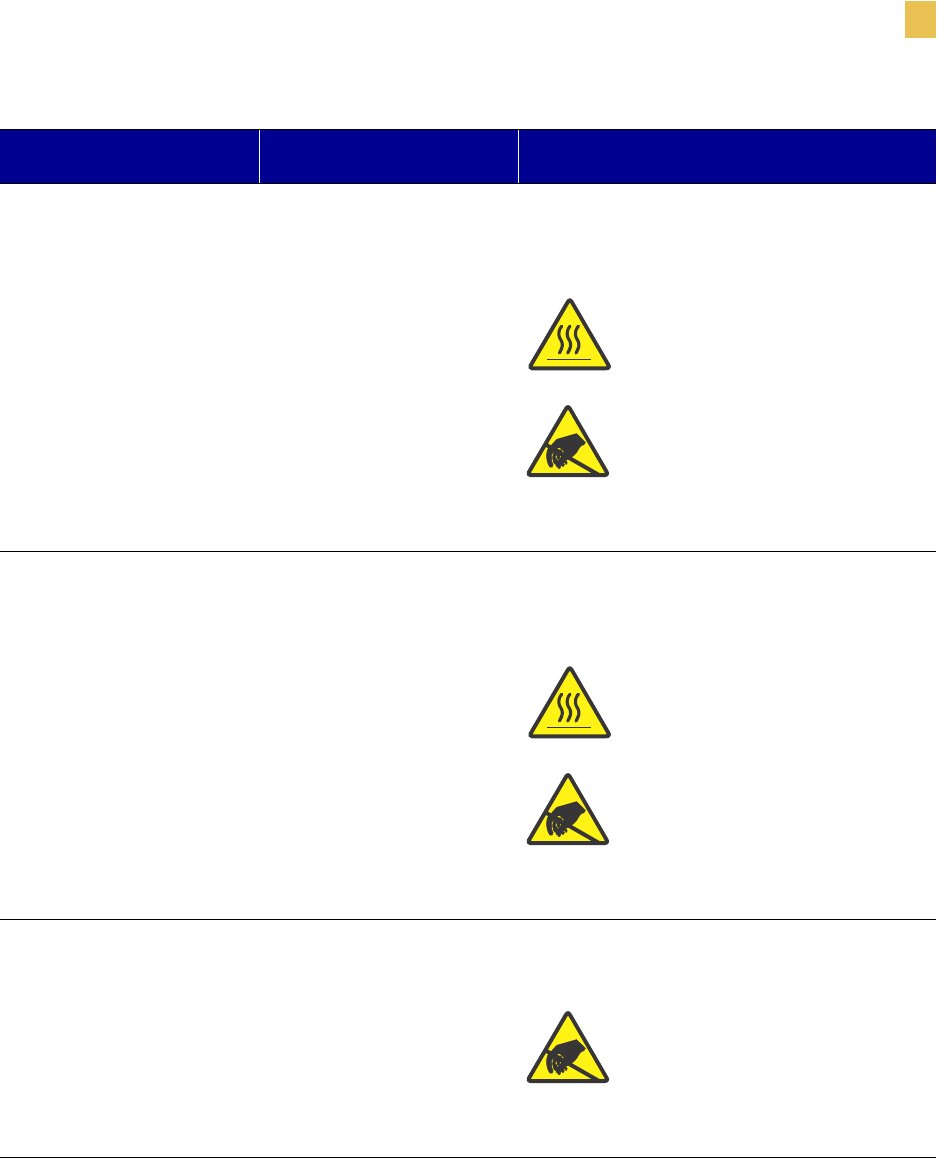
Troubleshooting
Print Quality Problems
R110/R170XiIIIPlus User Guide 127
Gray lines on blank
labels with no
consistent pattern
The printhead is dirty. Clean the printhead according to the
instructions in Printhead and Platen Roller
on page 111.
Caution • The printhead is hot
and can cause severe burns. Allow
the printhead to cool.
Caution • Observe proper
electrostatic safety precautions
when handling any static-
sensitive components such as
circuit boards and printheads.
Light, consistent
vertical lines running
through the labels
The printhead or platen
roller is dirty.
Clean the printhead and platen roller as
instructed in Printhead and Platen Roller
on page 111.
Caution • The printhead is hot
and can cause severe burns. Allow
the printhead to cool.
Caution • Observe proper
electrostatic safety precautions
when handling any static-
sensitive components such as
circuit boards and printheads.
Intermittent creases on
the left and right edges
of the labels
There is too much toggle
pressure on the printhead.
Reduce the toggle pressure. See Adjust the
Printhead on page 37.
Caution • Observe proper
electrostatic safety precautions
when handling any static-
sensitive components such as
circuit boards and printheads.
Problem Possible Cause Recommended Solution
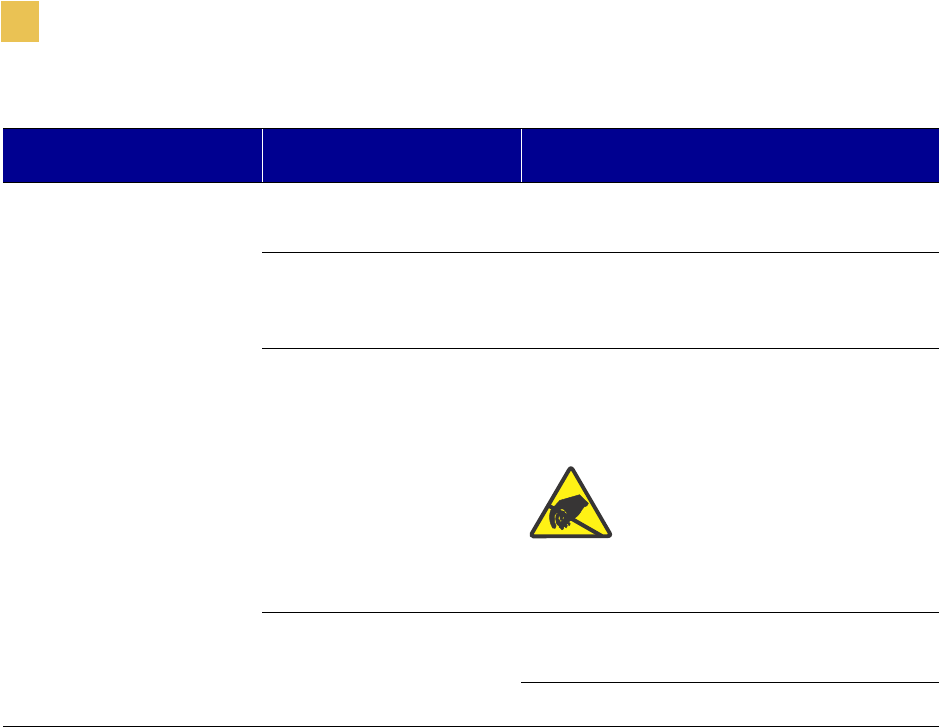
128 R110/R170XiIIIPlus User Guide
Troubleshooting
Print Quality Problems
Wrinkled Ribbon The ribbon is not loaded
correctly.
Load the ribbon correctly. See Load Ribbon
on page 24.
The darkness setting is
incorrect.
Set the darkness to the lowest possible setting
for good print quality. See Adjusting Print
Darkness on page 57.
Incorrect printhead
pressure or balance.
Set the pressure to the minimum required for
good print quality. See Adjust the Printhead
on page 37.
Caution • Observe proper
electrostatic safety precautions
when handling any static-
sensitive components such as
circuit boards and printheads.
The labels are not feeding
correctly. They are shifting
from side to side.
Make sure that the media guide and media
supply guide touch the edge of the media.
Adjust the ribbon strip plate.
Problem Possible Cause Recommended Solution
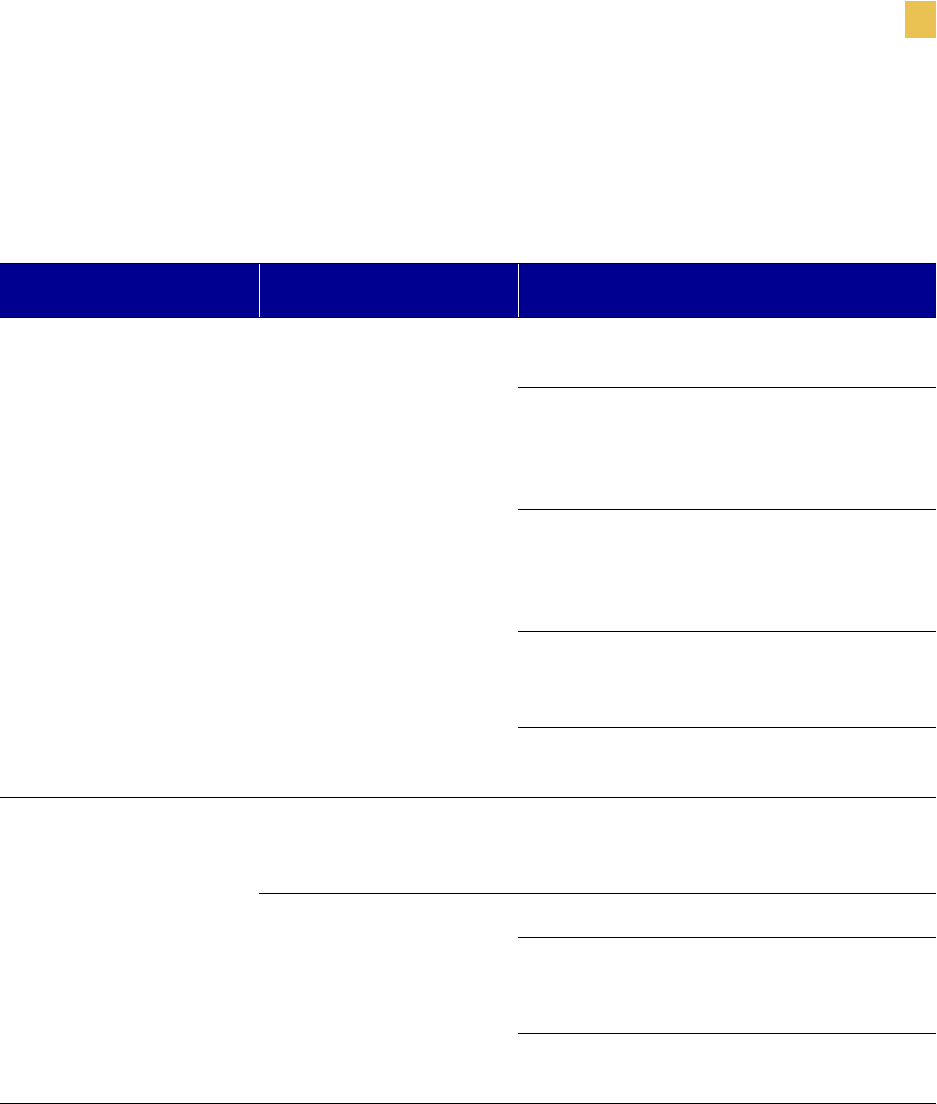
Troubleshooting
Communications Problems
R110/R170XiIIIPlus User Guide 129
Communications Problems
This table identifies problems with communications, the possible causes, and the
recommended solutions.
Problem Possible Cause Recommended Solution
A label format was sent
to the printer but was
not recognized. The
DATA light does not
flash.
The communication
parameters are incorrect.
Check the printer driver or software
communications settings (if applicable).
If you are using serial communication, check
the serial port setting in the front panel menu.
See Setting Serial Communications
on page 65.
Make sure you are using the correct
communication cable. See Data Cable
Requirements on page 14 for the
requirements.
Using the front panel controls, check the
protocol setting. It should be set to NONE. See
Setting Protocol on page 66.
If a driver is used, check the driver
communication settings for your connection.
A label format was sent
to the printer. Several
labels print, then the
printer skips,
misplaces, misses, or
distorts the image on
the label.
The host is set to EPP
parallel communications.
Change the settings on the computer host to
standard parallel communications. See
Setting Parallel Communications on page 64.
The serial communication
settings are incorrect.
Ensure that the flow control settings match.
Check the communication cable length. See
Data Cable Requirements on page 14 for
requirements.
Check the printer driver or software
communications settings (if applicable).
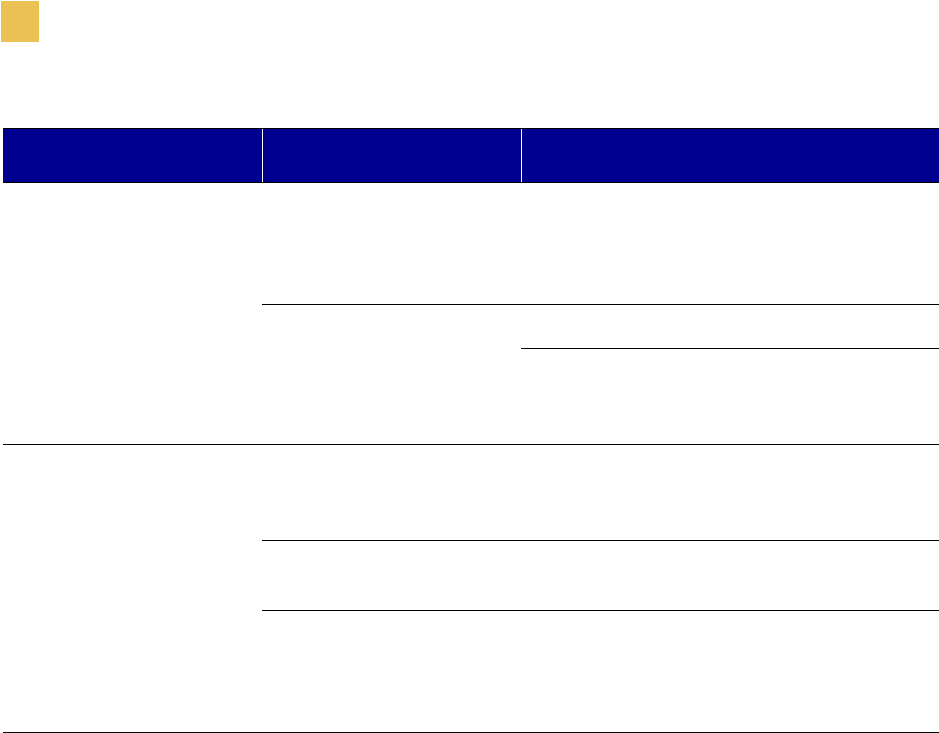
130 R110/R170XiIIIPlus User Guide
Troubleshooting
Communications Problems
A label format was sent
to the printer but was
not recognized. The
DATA light flashes but
no printing occurs.
The prefix and delimiter
characters set in the printer
do not match the ones in
the label format.
Verify the prefix and delimiter characters. See
Format Prefix Character on page 68 and
Delimiter Character on page 68 for the
requirements.
Incorrect data is being sent
to the printer.
Ensure that ZPL is being used.
Check the communication settings on the
computer. Ensure that they match the printer
settings.
The printer fails to
calibrate or detect the
top of the label.
The printer was not
calibrated for the label
being used.
Perform the calibration procedure in
CANCEL Self Test on page 132.
The printer is configured
for continuous media.
Set the media type to non-continuous media.
See Setting Media Type on page 58.
The driver or software
configuration is not set
correctly.
Driver or software settings produce ZPL
commands that can overwrite the printer
configuration. Check the driver or software
media-related setting.
Problem Possible Cause Recommended Solution
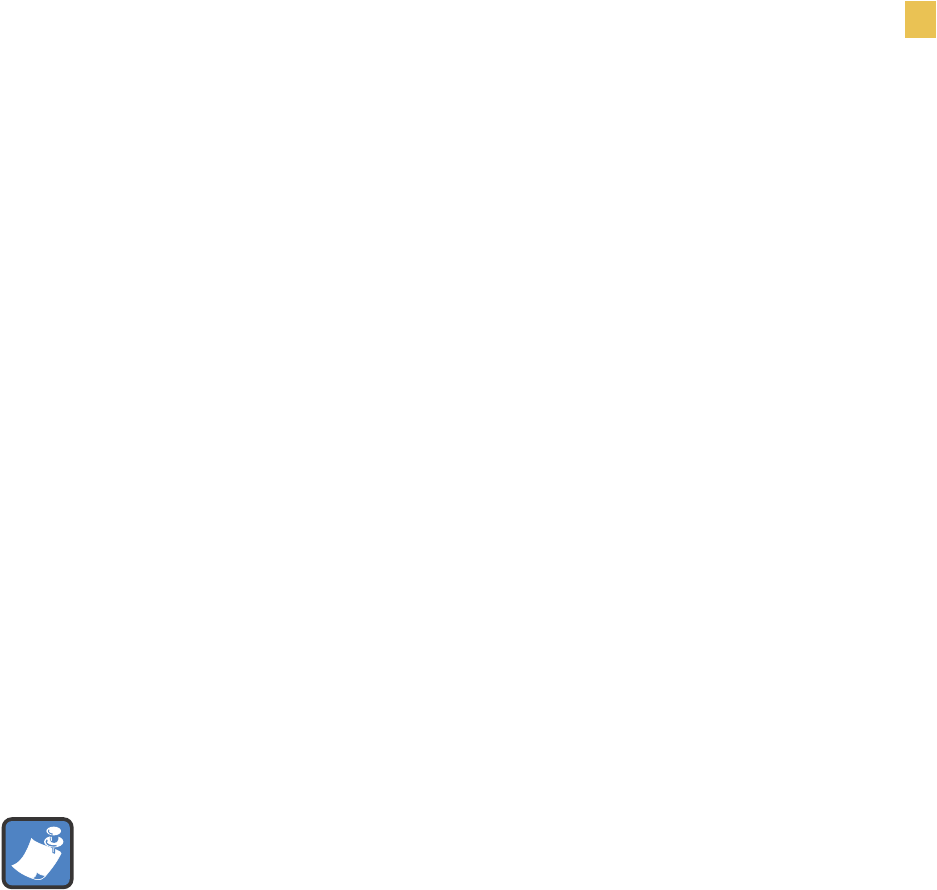
Troubleshooting
Printer Diagnostics
R110/R170XiIIIPlus User Guide 131
Printer Diagnostics
Self tests give information about the condition of the printer. The most commonly used are the
Power-On and the CANCEL self test.
Power-On Self Test
The Power-On Self Test (POST) is performed automatically each time the printer is turned on.
During either test sequence, the front panel LEDs light up and the LCD monitors the progress
of the POST. If the printer fails any of these tests, FAILED shows on the LCD. If this occurs,
notify an authorized Zebra reseller.
Additional Printer Self Tests
These self tests produce sample printouts and provide specific information that help determine
the operating conditions for the printer.
Each self test is enabled by pressing a specific front panel key or combination of keys while
turning the power On (I). Keep the key(s) depressed until the DATA light turns off. When the
POST is complete, the selected self test starts automatically.
Caution • Be sure that the print width is set to match the label width you are using before
running any self tests. If the labels are not wide enough, the test may print on the platen
roller and damage it.
Note • When performing a self test, do not send a label format to the printer. For remote hosts,
disconnect all data interface cables from the printer. For printers in Peel-Off Mode, remove the
labels as they come out of the printer.
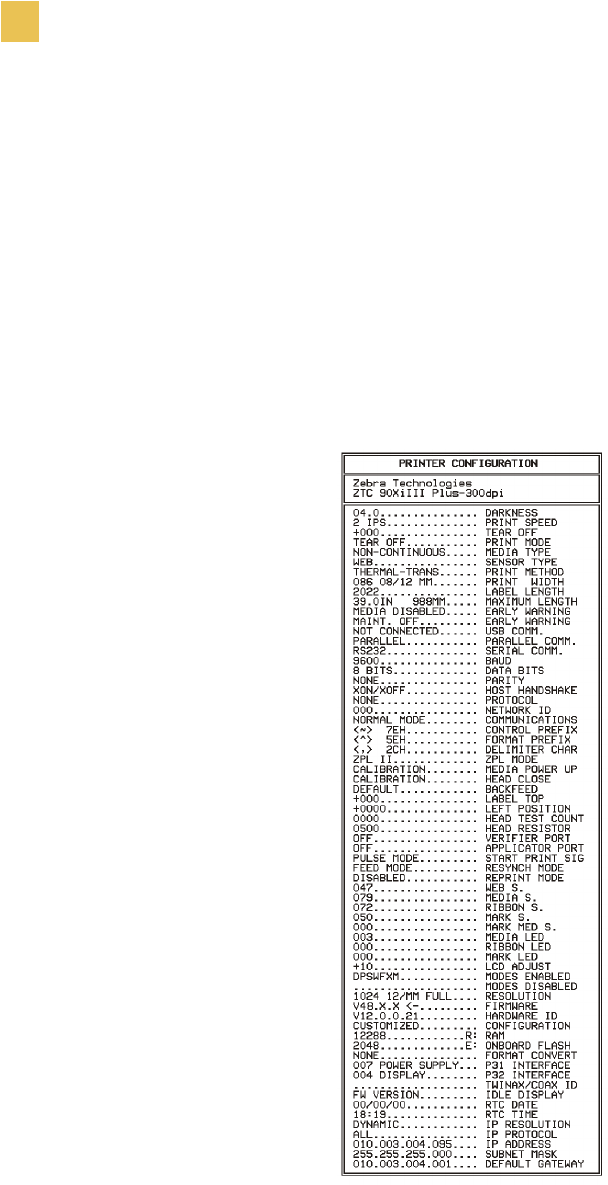
132 R110/R170XiIIIPlus User Guide
Troubleshooting
Printer Diagnostics
CANCEL Self Test
The CANCEL self test prints a configuration label, which tells you the current settings for the
printer.
To perform the CANCEL Self Test, complete these steps:
1. Turn Off (O) the printer.
2. Press and hold CANCEL while turning the power On (I). Hold CANCEL until the
DATA light turns off.
A configuration label prints.
The printer configuration can be changed by performing a calibration procedure. See Print a
Configuration Label on page 29 for more information.
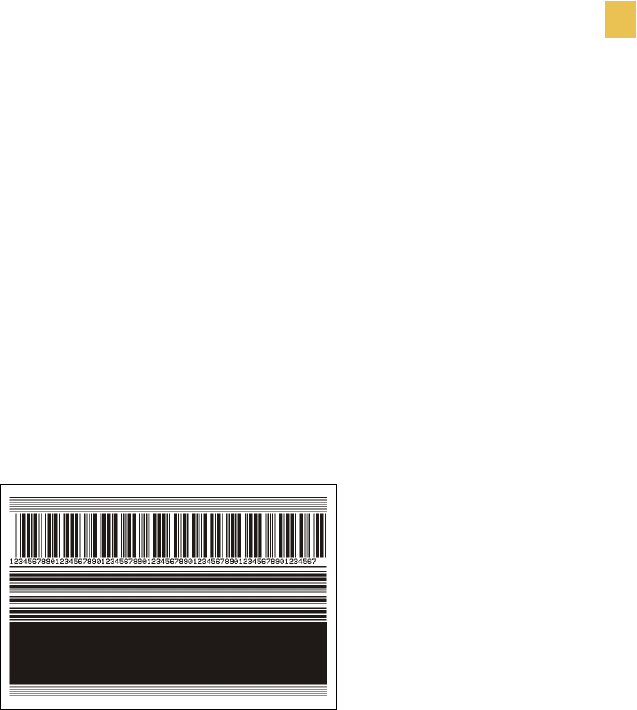
Troubleshooting
Printer Diagnostics
R110/R170XiIIIPlus User Guide 133
PAUSE Self Test
This self test can be used to provide the test labels required when making adjustments to the
printer’s mechanical assemblies. See the sample printout below.
To perform a PAUSE self test, complete these steps:
1. Turn Off (O) the printer.
2. Press and hold PAUSE while turning the power On (I). Hold PAUSE until the DATA
light turns off.
• The initial self test prints 15 labels at 2.4 in. (61 mm) per second, then
automatically pauses the printer. When PAUSE is pressed, an additional 15
labels print. The labels look similar to the one shown below.
• While the printer is paused, pressing CANCEL alters the self test. When
PAUSE is pressed, 15 labels print at 6 in. or 152 mm per second.
• While the printer is paused, pressing CANCEL again alters the self test a
second time. When PAUSE is pressed, 50 labels print at 2.4 in. (61 mm per
second).
• While the printer is paused, pressing CANCEL again alters the self test a third
time. When PAUSE is pressed, 50 labels print at 6 in. (152 mm) per second.
• While the printer is paused, pressing CANCEL again alters the self test a
fourth time. When PAUSE is pressed, 15 labels print at the printer’s
maximum speed.
• To exit this self test at any time, press and hold CANCEL.
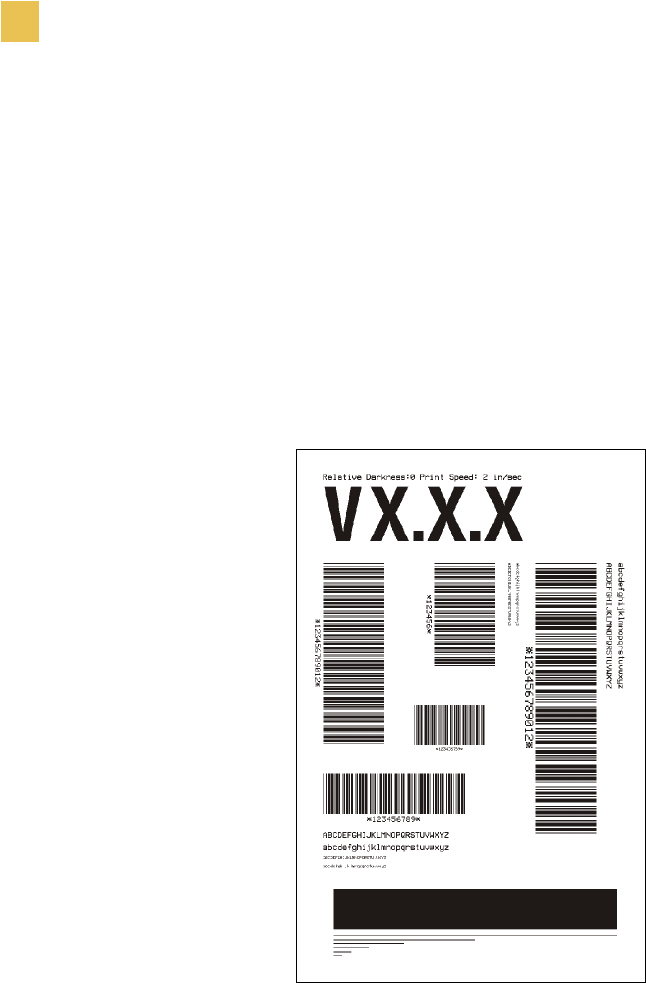
134 R110/R170XiIIIPlus User Guide
Troubleshooting
Printer Diagnostics
FEED Self Test
This test helps you choose the best darkness setting for your printer.
To perform a FEED self test, complete these steps:
1. Turn Off (O) the printer.
2. Press and hold FEED while turning the power On (I). Hold FEED until the DATA light
turns off.
The printer prints a series of labels like the one below at various darkness settings
higher and lower than the darkness value shown on the configuration label.
3. Inspect the labels and determine which one has the best darkness setting for your
application. This value can be entered into the printer by setting the darkness during the
configuration procedure.
The value printed on that label is added to (plus) or subtracted from (minus) the
darkness value specified on the configuration label. The resulting numeric value
(0 to 30) is the best darkness value for that specific label/ribbon combination.
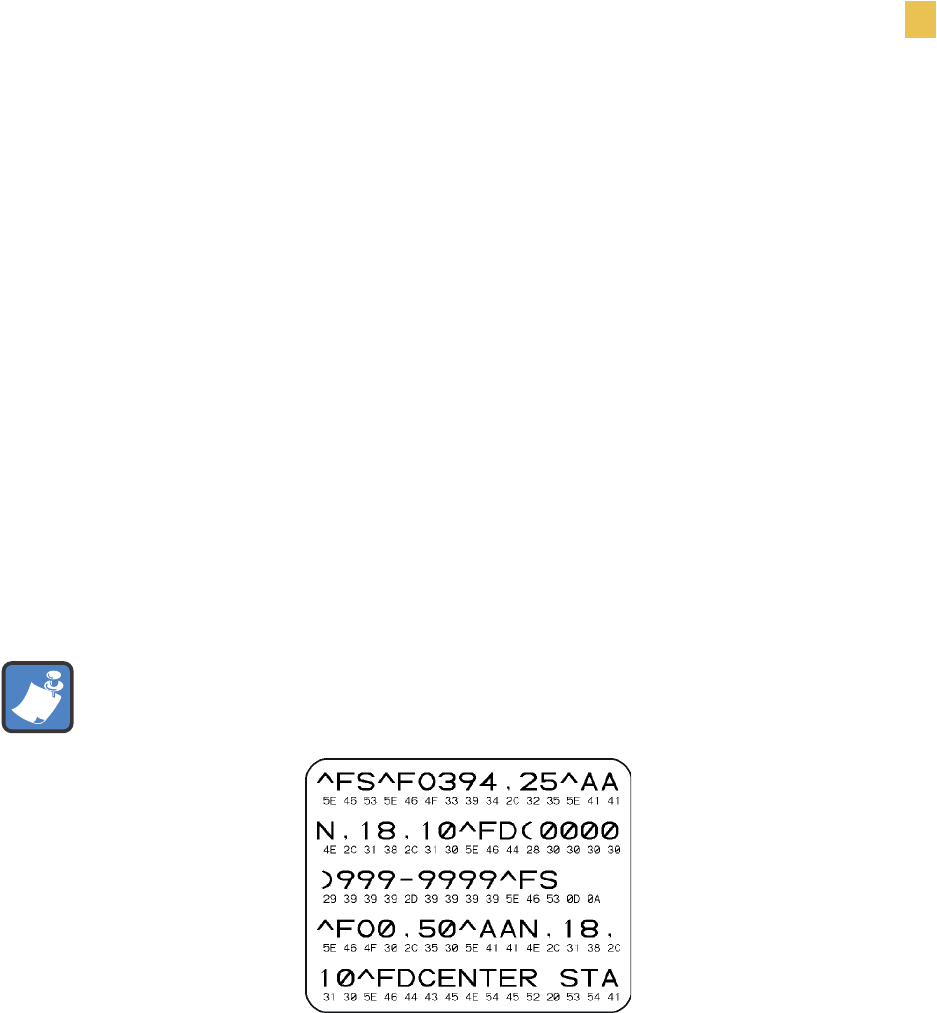
Troubleshooting
Printer Diagnostics
R110/R170XiIIIPlus User Guide 135
FEED and PAUSE Self Test
Performing this self test temporarily resets the printer configuration to the factory default
values. These values are active only until power is turned off unless you save them
permanently in memory.
To perform a FEED and PAUSE self test, complete these steps:
1. Turn Off (O) the printer.
2. Press and hold FEED and PAUSE while turning the power On (I). Hold FEED and
PAUSE until the DATA light turns off.
No labels print at the end of this test.
Communications Diagnostics Test
This test is controlled from the front panel display. See Setting Communications Mode
on page 67. The following illustration shows a typical printout from this test. Turn off the
power to exit this self test and return to normal operation.
Additional Printer Diagnostics
Additional diagnostic tests are available for this printer. See the Maintenance Manual for
information about these additional tests.
Note • The communications test label prints upside-down.
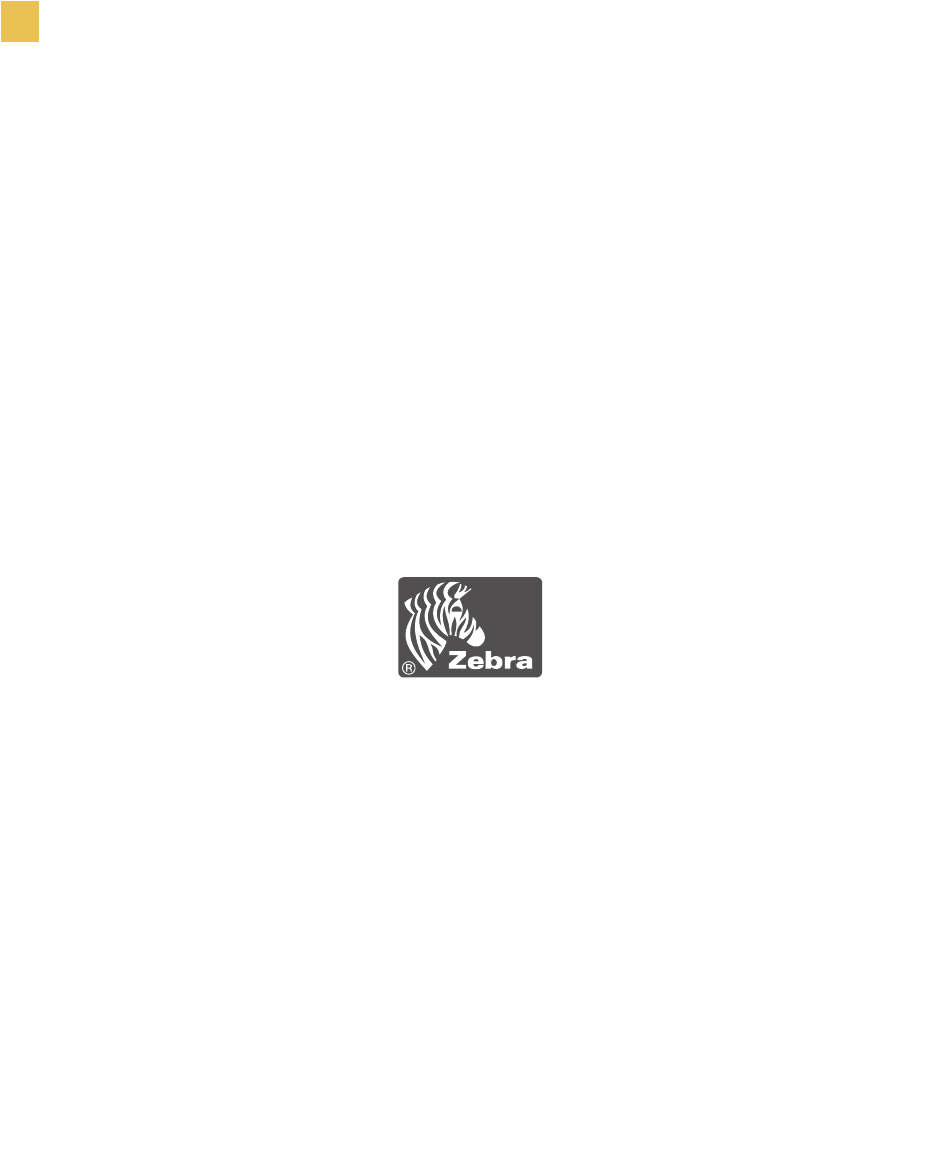
136 R110/R170XiIIIPlus User Guide
Troubleshooting
Printer Diagnostics

R110/R170XiIIIPlus User Guide 137
APPENDIX A
Specifications
This appendix provides the features of and specifications for the RXiIIIPlus printers.
Contents
Features . . . . . . . . . . . . . . . . . . . . . . . . . . . . . . . . . . . . . . . . . 138
Standard Features. . . . . . . . . . . . . . . . . . . . . . . . . . . . . . . . 138
Print Modes . . . . . . . . . . . . . . . . . . . . . . . . . . . . . . . . . . . . . 138
Zebra Programming Language (ZPL II®) . . . . . . . . . . . . . . 138
Bar Codes . . . . . . . . . . . . . . . . . . . . . . . . . . . . . . . . . . . . . . 139
Agency Approvals for All Printers . . . . . . . . . . . . . . . . . . . . 140
Compliance for All Printers . . . . . . . . . . . . . . . . . . . . . . . . . 140
General Specifications . . . . . . . . . . . . . . . . . . . . . . . . . . . . . . 141
Electrical Specifications. . . . . . . . . . . . . . . . . . . . . . . . . . . . 141
Environmental Conditions for Operation and Storage . . . . . 141
Print Specifications by Model . . . . . . . . . . . . . . . . . . . . . . . . . 142
Ribbon Specifications by Model . . . . . . . . . . . . . . . . . . . . . . . 144
Label Specifications . . . . . . . . . . . . . . . . . . . . . . . . . . . . . . . . 146
R110XiIIIPlus Printers . . . . . . . . . . . . . . . . . . . . . . . . . . . . . 146
R170XiIIIPlus Printers . . . . . . . . . . . . . . . . . . . . . . . . . . . . . 149

138 R110/R170XiIIIPlus User Guide
Specifications
Features
Features
This section lists the standard and optional features for the printer.
Standard Features
• Thermal transfer and direct thermal printing
• DRAM 16 MB
• USB 2.0 Port
• Real-time Clock
• Advanced Counter
Print Modes
Four different print modes can be used, depending on the printer options purchased.
•Tear-Off Mode: Labels are produced in strips.
•Peel-Off Mode: Labels are dispensed and peeled from the backing as needed.
•Cutter Mode: Labels are printed and individually cut.
•Rewind Mode: Labels are rewound internally.
Zebra Programming Language (ZPL II®)
ZPL features include:
• Downloadable graphics, scalable and bitmap fonts, and label formats
• Object copying between memory areas
• (RAM, memory card, and internal Flash)
• Code page 850 character set
• Adjustable print cache
• Data compression
• Automatic virtual input buffer management
• Format inversion
• Mirror image printing
• Four-position field rotation (0°, 90°, 180°, 270°)
• Slew command
• Controlled via mainframe, mini-computer, PC, portable data terminal
Note • Printer specifications are subject to change without notice.

Specifications
Features
R110/R170XiIIIPlus User Guide 139
• Programmable quantity with print, pause, and cut control
• Communicates in printable ASCII characters
• Error-checking protocol
• Status message to host upon request
• Serialized fields
• In-spec OCR-A and OCR-B
•UPC/EAN
• User-programmable password
Bar Codes
Types of bar codes include:
• Bar code ratios—2:1, 7:3, 5:2, 3:1
• Codabar (supports ratios of 2:1 up to 3:1)
• CODABLOCK
•Code 11
• Code 39 (supports ratios of 2:1 up to 3:1)
• Code 49 (two-dimensional bar code)
• Code 93
• Code 128 (with subsets A, B, and C and UCC case codes)
• Check digit calculation where applicable
• Data Matrix
• EAN-8, EAN-13, EAN extensions
•ISBT-128
• Industrial 2 of 5
• Interleaved 2 of 5 (supports ratios of 2:1 up to 3:1, Modulus 10 Check Digit)
• LOGMARS
•MaxiCode
•Micro PDF
•MSI
• PDF-417 (2-dimensional bar code)
• PLANET code
• Plessey
• POSTNET
• QR-Code
• RSS code
• Standard 2 of 5

140 R110/R170XiIIIPlus User Guide
Specifications
Features
• TLC 39
• UPC-A, UPC-E, UPC extensions
Agency Approvals for All Printers
Approvals include:
• Binational UL 60950 3rd edition/CSA CAN/CSA-C22.2 No. 60950-00 3rd edition
• IEC 950/EN60950
• EN55022:1998 Class B
• EN55024: 1998
• EN61000-3-2,3
• Canadian ICES-003, Class B
• FCC class B
• Argentina 92/98 Phase 3
• Australia AS/NZS 3548
• R.OC. CNS 13438
Compliance for All Printers
• Complies with FCC class B and Canadian Doc. class A rules
• Carries the CE mark of compliance
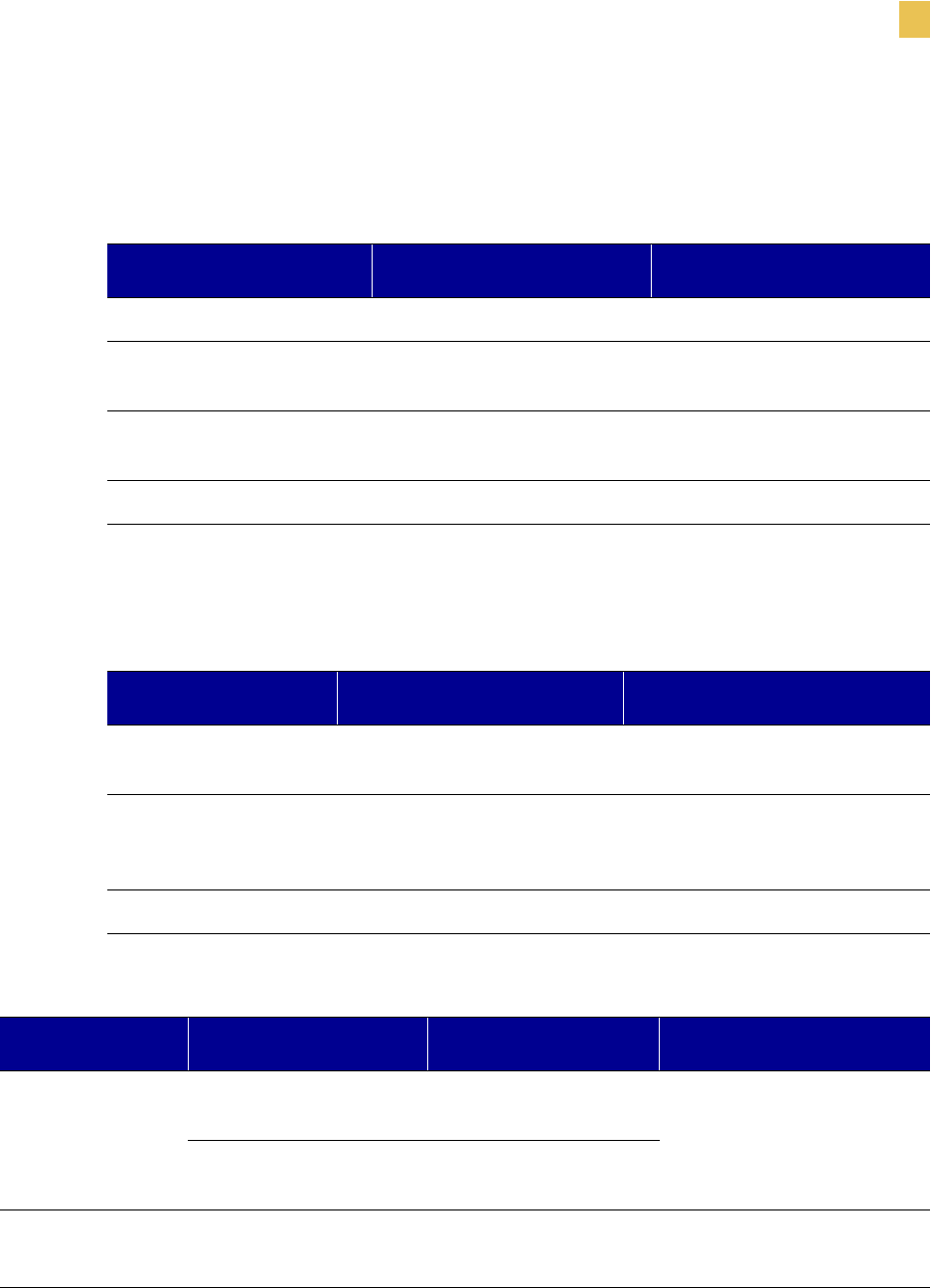
Specifications
General Specifications
R110/R170XiIIIPlus User Guide 141
General Specifications
The following table gives the general specifications for the printer by model number.
Electrical Specifications
The following table gives electrical specifications for the printers by model number.
Environmental Conditions for Operation and Storage
Dimensions R110Xi IIIPlus R170Xi IIIPlus
Height 15.5 in (393.7 mm) 15.5 in. (393.7 mm)
Width 10.37 in. (263.5 mm) 13.15 in.
(334.4 mm)
Depth 19.5 in. (495.3 mm) 19.5 in.
(495.3 mm)
Weight without options 51 lb. (25 kg) 67 lb. (30.5 kg)
Power R110Xi IIIPlus R170Xi IIIPlus
General 90 to 264 VAC;
48 to 62 Hz
90 to 264 VAC;
48 to 62 Hz
Power consumption
printing PAUSE test at
slowest speed
180 W 220 W
Printer idle 20 W 19 W
Environment Mode Temperature Relative Humidity
Operation Thermal Transfer 41° to 104°F
(5° to 40° C)
20 to 85% non-condensing
Direct Thermal 32° to 104°F
(0° to 40° C)
Storage Thermal Transfer or
Direct Thermal
–40° to 140°F
(–40° to 60° C)
5 to 85% non-condensing
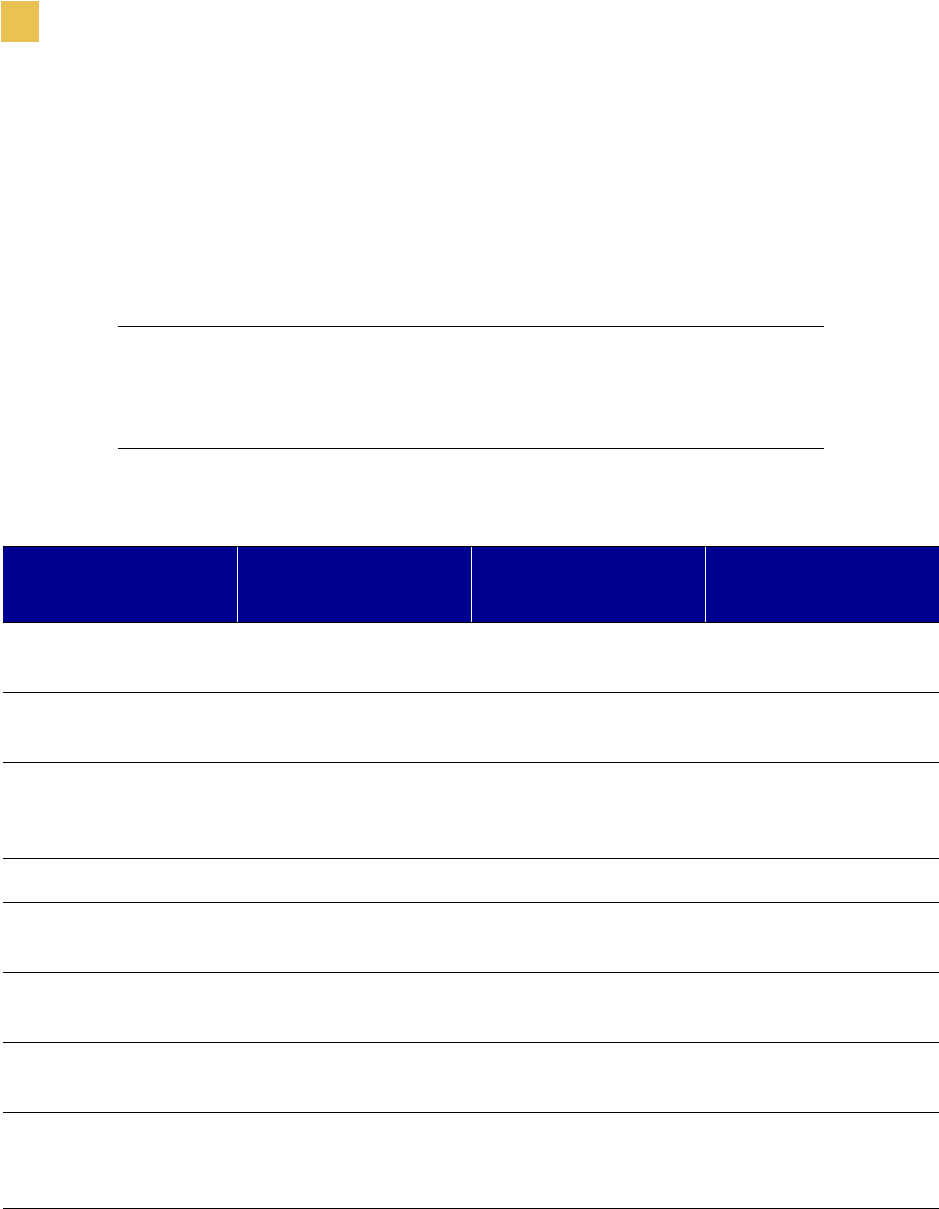
142 R110/R170XiIIIPlus User Guide
Specifications
Print Specifications by Model
Print Specifications by Model
Refer to the key and the tables that follow for printer specifications.
Model Specifications Key
This table contains the key for print specifications for the tables that follow.
R110
Xi
III
Plus
Non-Continuous printing (gap, notch, or hole between labels).
Continuous printing (no gap, notch or hole).
Ladder (rotated) orientation.
Picket fence (nonrotated) orientation.
Specification R110XiIIIPlus
200 dpi
R110XiIIIPlus
300 dpi
R110XiIIIPlus
600 dpi
Printhead resolution 203 dots/inch
(8 dots/mm)
300 dots/inch
(12 dots/mm)
600 dots/inch
(24 dots/mm)
Dot size
(width×length)
0.0049×0.0049 in.
(0.125×0.125 mm)
0.0033×0.0039 in.
(0.84×0.100 mm)
0.0016×0.0016 in.
(0.042×0.042 mm)
First dot location
(measured from inside
media edge)
0.10 ± 0.035 in.
(2.5 ± 0.89 mm)
0.023 ± 0.035 in.
(0.6 ± 0.9 mm)
0.023 ± 0.035 in.
(0.6 ± 0.9 mm)
Maximum print width 4.09 in. (104 mm) 4.09 in. (104 mm) 3.2 in. (81 mm)
Selectable print speeds
(inches per second)
2.4, 3 through 10 2.4, 3 through 8 1.5, 2 through 4
Maximum Print length 39 in. (991 mm)
150 in. (3810 mm)
39 in. (991 mm)
100 in. (3810 mm)
39 in. (991 mm)
39 in. (991 mm)
Bar code modulus (X)
dimension
4.9 mil to 49 mil
4.9 mil to 49 mil
3.9 mil to 39 mil
3.33 mil to 33 mil
1.6 mil to 16 mil
1.6 mil to 16 mil
Thin film printhead with
Element Energy
Equalizer (E3)®
Yes Yes Ye s
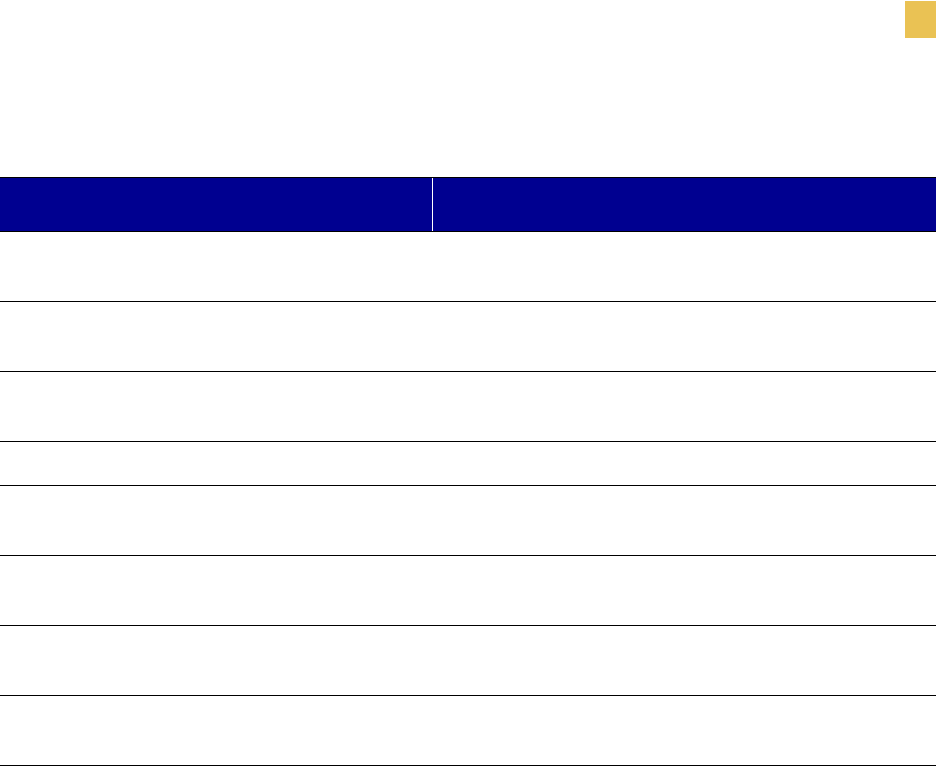
Specifications
Print Specifications by Model
R110/R170XiIIIPlus User Guide 143
R170
Xi
III
Plus
Specification 170XiIIIPlus
Printhead resolution 300 dots/inch
(12 dots/mm)
Dot size (width×length) 0.0033×0.0039 in.
(0.84×0.100 mm)
First dot location (measured from inside media
edge)
0.10 ± 0.035 in.
(2.5 ± 0.89 mm)
Maximum print width 6.6 in. (168 mm)
Selectable print speeds
(in. per second)
2.4, 3, 4, 5, 6, 7, 8
Maximum print length 39 in. (991 mm)
100 in. (3810 mm)
Bar code modulus (X) dimension 3.9 mil to 39 mil
3.33 mil to 33 mil
Thin film printhead with Element Energy
Equalizer (E3)
Yes
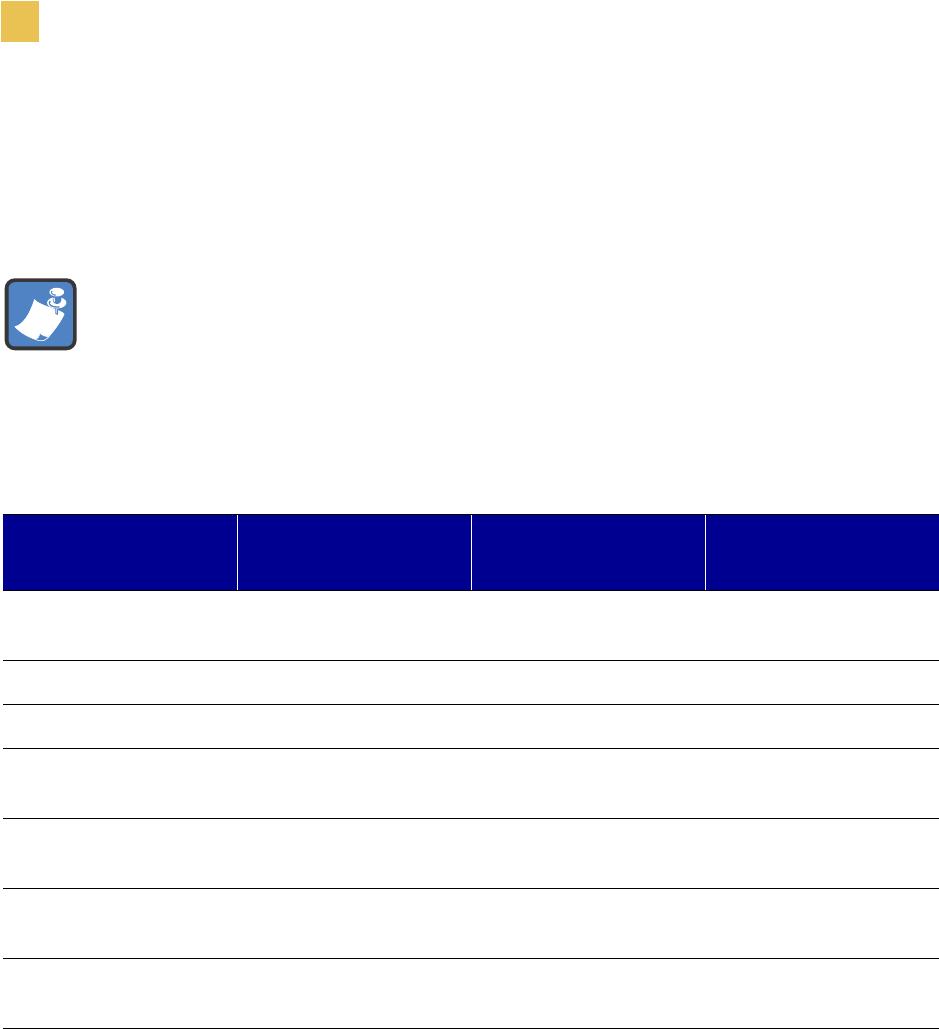
144 R110/R170XiIIIPlus User Guide
Specifications
Ribbon Specifications by Model
Ribbon Specifications by Model
Refer to the tables that follow for ribbon specifications for your type of printer.
R110
Xi
III
Plus
Note • Match the ribbon to the label width and printhead width that you are using.
• Ribbon must be wound with the coated side out.
• Ribbon should be at least as wide as the labels to protect the printhead from excessive
wear.
Specifications R110XiIIIPlus
200 dpi
R110XiIIIPlus
300 dpi
R110XiIIIPlus
600 dpi
Printhead resolution 203 dots/inch
(8 dots/mm)
300 dots/inch
(12 dots/mm)
600 dots/inch
(24 dots/mm)
Ribbon width Minimum 0.79 in. (20 mm) 0.79 in. (20 mm) 0.79 in. (20 mm)
Ribbon width Maximum 4.33 in. (110 mm) 4.33 in. (110 mm) 3.40 in. (87 mm)
Standard length with 2:1
label to ribbon ratio
984 ft (300 m) 984 ft (300 m) 984 ft (300 m)
Standard length with 3:1
label to ribbon ratio
1476 ft (450 m) 1476 ft (450 m) 1476 ft (450 m)
Ribbon core inside
diameter
1.0 in. (25.4 mm) 1.0 in. (25.4 mm) 1.0 in. (25.4 mm)
Maximum ribbon roll
outside diameter
3.2 in. (81.3 mm) 3.2 in. (81.3 mm) 3.2 in. (81.3 mm)
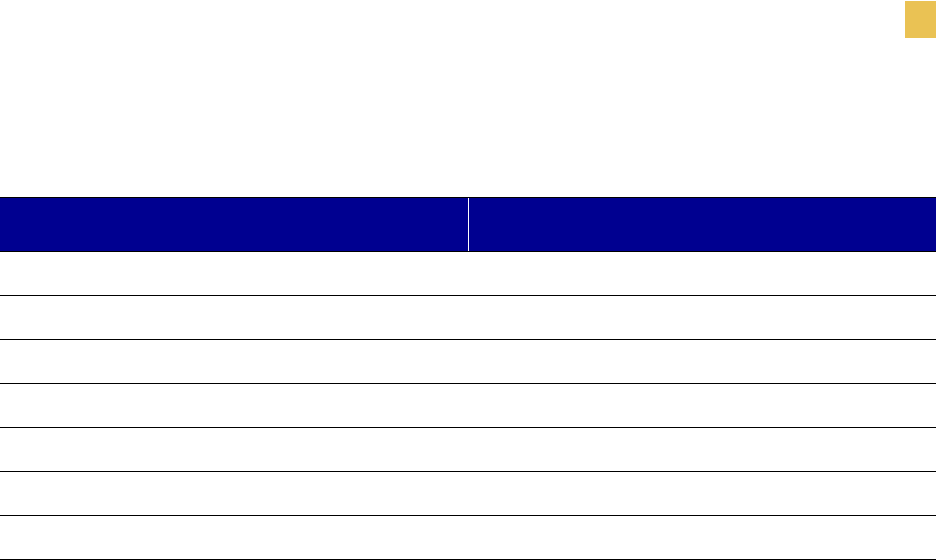
Specifications
Ribbon Specifications by Model
R110/R170XiIIIPlus User Guide 145
R170
Xi
III
Plus
Specifications 170XiIIIPlus
Printhead resolution 300 dots/inch(12 dots/mm)
Ribbon width Minimum 2.0 in. (51 mm)
Ribbon width Maximum 6.7 in. (170 mm)
Standard length with 2:1 label to ribbon ratio 984 ft (300 m)
Standard length with 3:1 label to ribbon ratio 1476 ft (450 m)
Ribbon core inside diameter 1.0 in. (25.4 mm)
Maximum ribbon roll outside diameter 3.2 in. (81.3 mm)
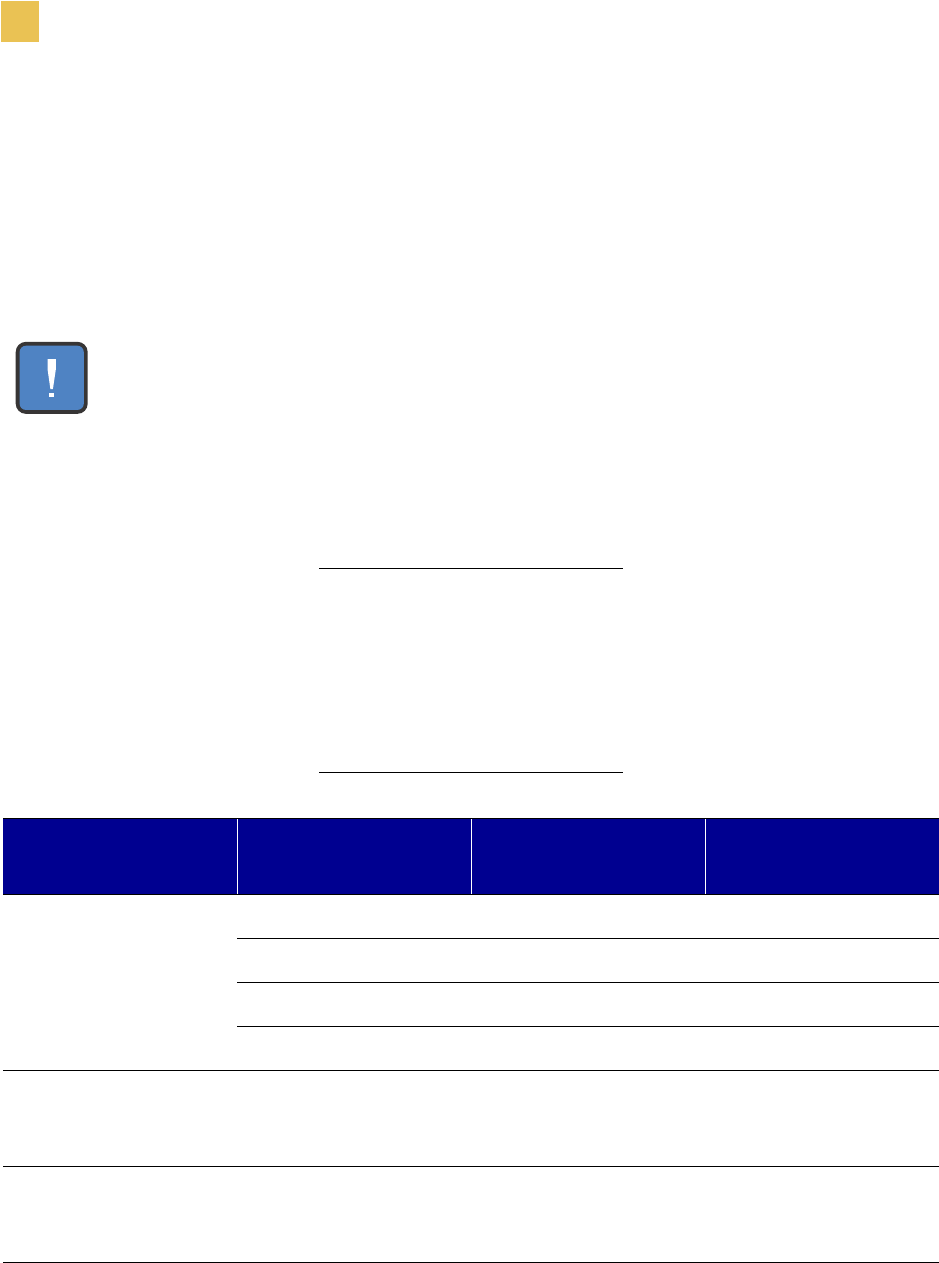
146 R110/R170XiIIIPlus User Guide
Specifications
Label Specifications
Label Specifications
RXiIIIPlus printers need the correct size and type of labels for best performance. The tables
that follow give you the specifications you need.
R110XiIIIPlus Printers
Label Specification Key
This table contains the key for the label modes, dimensions, and directions:
Important • Media registration and minimum label length are affected by label type and
width, ribbon type, print speed, and printer mode of operation. Performance improves as
these factors are optimized. Zebra recommends qualifying any application with thorough
testing.
TTear-Off
PPeel-Off
CCutter
RRewind
Minimum
Maximum
Preferred
Specifications R110XiIIIPlus
200 dpi
R110XiIIIPlus
300 dpi
R110XiIIIPlus
600 dpi
Minimum label length 0.7 in. (18 mm) T0.7 in. (18 mm) T0.7 in. (18 mm) T
0.5 in. (13 mm) P0.5 in. (13 mm) P0.5 in. (13 mm) P
1.5 in. (38 mm) C1.5 in. (38 mm) C1.5 in. (38 mm) C
0.25 in. (6 mm) R0.25 in. (6 mm) R0.25 in. (6 mm) R
Total media width (label
+ backing,
if any)
0.79 in. (20 mm)
4.5 in. (114 mm)
0.79 in. (20 mm)
4.5 in. (114 mm)
0.79 in. (20 mm)
4.5 in. (114 mm)
Total thickness (includes
backing,
if any)
0.003 in. (0.076 mm)
0.012 in. (0.305 mm)
0.003 in. (0.076 mm)
0.012 in. (0.305 mm)
0.003 in. (0.076 mm)
0.012 in. (0.305 mm)
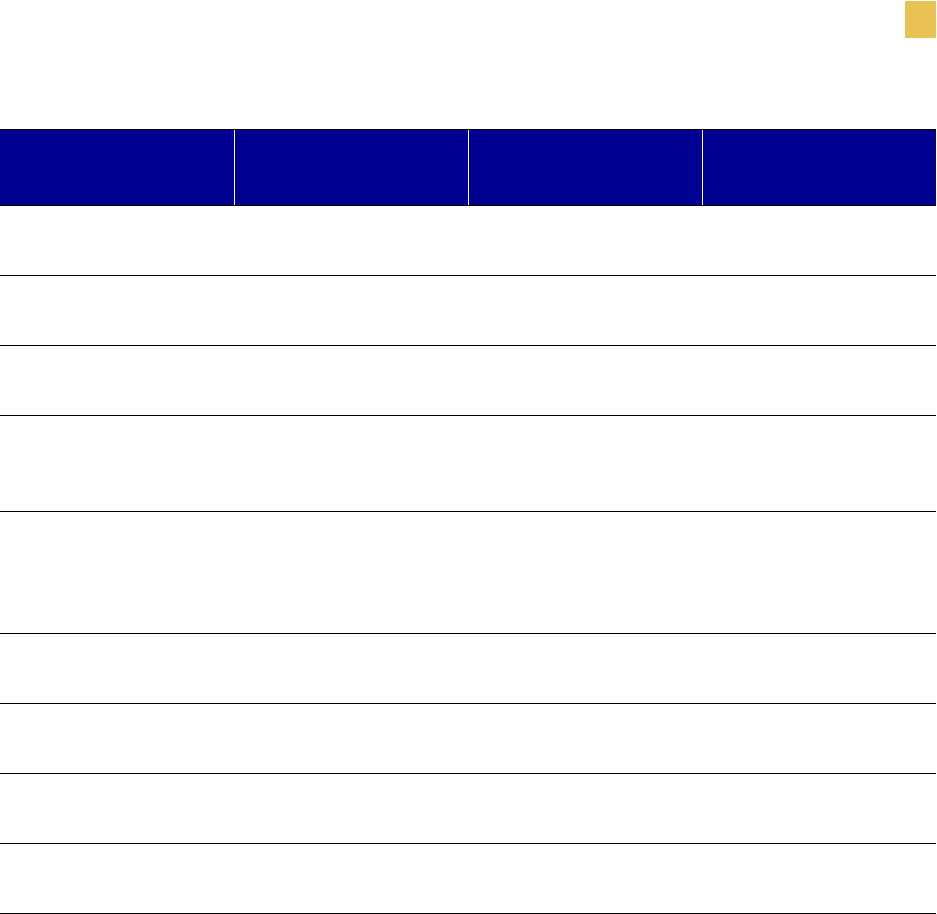
Specifications
Label Specifications
R110/R170XiIIIPlus User Guide 147
Cutter maximum full-
width media thickness
0.009 in. (0.23 mm) 0.009 in. (0.23 mm) Does not apply
Roll media core inside
diameter
3 in. (76 mm) 3 in. (76 mm) 3 in. (76 mm)
Maximum roll diameter
on 3in. (76mm) core
8.0 in. (203 mm) 8.0 in. (203 mm) 8.0 in. (203 mm)
Interlabel gap 0.079 in.2 mm)
0.157 in. (4 mm)
0.118 in. (3 mm)
0.079 in. (2 mm)
0.157 in. (4 mm)
0.118 in. (3 mm)
0.079 in. (2 mm)
0.157 in. (4 mm)
0.118 in. (3 mm)
Maximum internal
fanfold media pack size
(label + backing)
L× W×H
8.0×4.5×4.5 in.
(20×114×114 mm)
8.0×5.5×4.5 in.
(203×40×114 mm)
8.0×7.1×4.5 in.
(203×180×114 mm)
Ticket/tag sensing notch
L× W
0.12×0.25 in.
(3×6 mm)
0.12×0.25 in.
(3×6 mm)
0.12×0.25 in.
(3×6 mm)
Ticket/tag sensing hole
diameter
0.125 in. (3 mm) 0.125 in. (3 mm) 0.125 in. (3 mm)
Label registration
tolerance (vertical)
± 0.06 in.
(± 1.5 mm)
± 0.06 in.
(± 1.5 mm)
± 0.06 in.
(± 1.5 mm)
Label registration
tolerance (horizontal)
± 0.06 in.
(± 1.5 mm)
± 0.06 in.
(± 1.5 mm)
± 0.06 in.
(± 1.5 mm)
Specifications R110XiIIIPlus
200 dpi
R110XiIIIPlus
300 dpi
R110XiIIIPlus
600 dpi
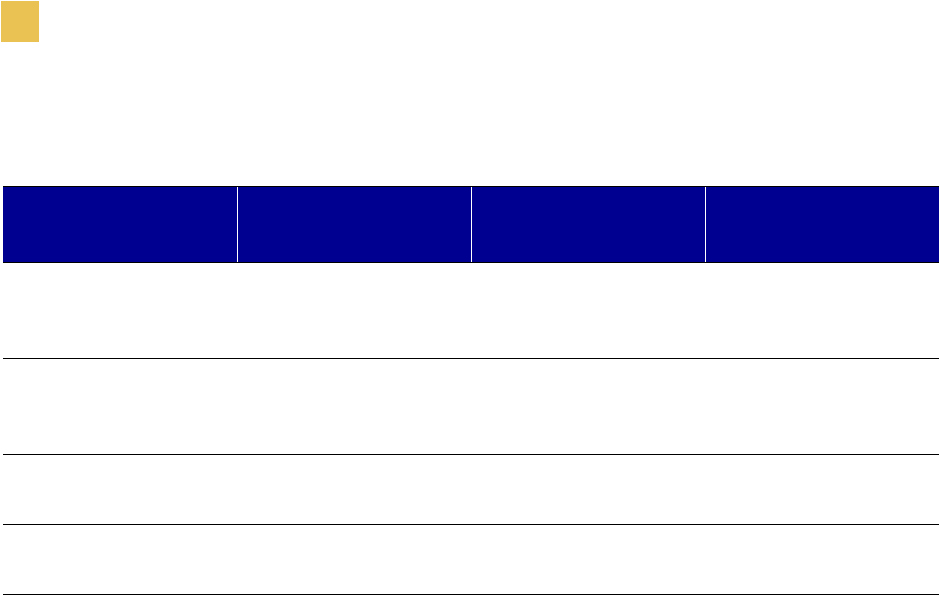
148 R110/R170XiIIIPlus User Guide
Specifications
Label Specifications
Black Mark Sensing Only
Specifications R110XiIIIPlus
200 dpi
R110XiIIIPlus
300 dpi
R110XiIIIPlus
600 dpi
Mark length (measuring
parallel to label/tag
edge)
0.12 in. (3 mm)
0.43 in. (11 mm)
0.12 in. (3 mm)
0.43 in. (11 mm)
0.12 in. (3 mm)
0.43 in. (11 mm)
Mark width (measuring
to perpendicular
label/tag edge)
0.43 in. (11 mm)
Full media width
0.43 in. (11 mm)
Full media width
0.43 in. (11 mm)
Full media width
Mark location within 0.040 in. (1 mm)
of the inside media edge
within 0.040 in. (1 mm)
of the inside media edge
within 0.040 in. (1 mm)
of the inside media edge
Mark density in Optical
Density Unit (ODU)
>1.0 >1.0 >1.0
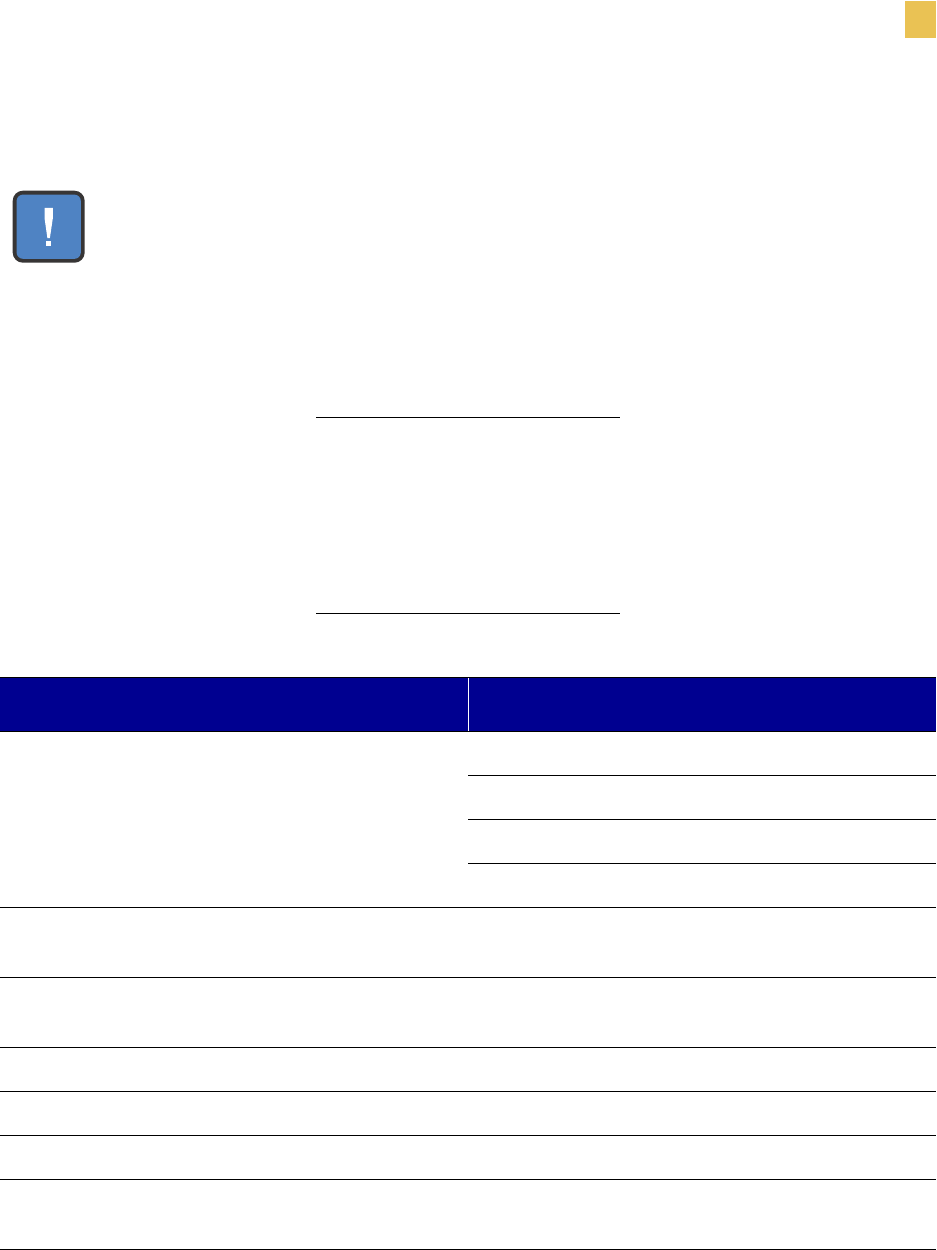
Specifications
Label Specifications
R110/R170XiIIIPlus User Guide 149
R170XiIIIPlus Printers
Label Specification Key
This table contains the key for the label modes, dimensions, and directions:
Important • Media registration and minimum label length are affected by label type and
width, ribbon type, print speed, and printer mode of operation. Performance improves as
these factors are optimized. Zebra recommends qualifying any application with thorough
testing.
T Tear-Off
PPeel-Off
C Cutter
RRewind
Minimum
Maximum
Preferred
Specifications R170Xi IIIPlus
Minimum label length 0.7 in. (18 mm) T
0.5in. (13mm) P
1.5in. (38mm) C
0.25 in. (6 mm) R
Total media width (label + backing, if any) 2.00 in. (51 mm)
7.1 in. (180 mm)
Total thickness (includes backing, if any) 0.003 in. (0.076 mm)
0.012 in. (0.305 mm)
Cutter maximum full-width media thickness 0.007 in. (0.18 mm)
Roll media core inside diameter 3 in. (76 mm)
Maximum roll diameter 8.0 in. (203 mm)
Inter-label gap 0.079 in. (2 mm)
0.118 in. (3 mm)
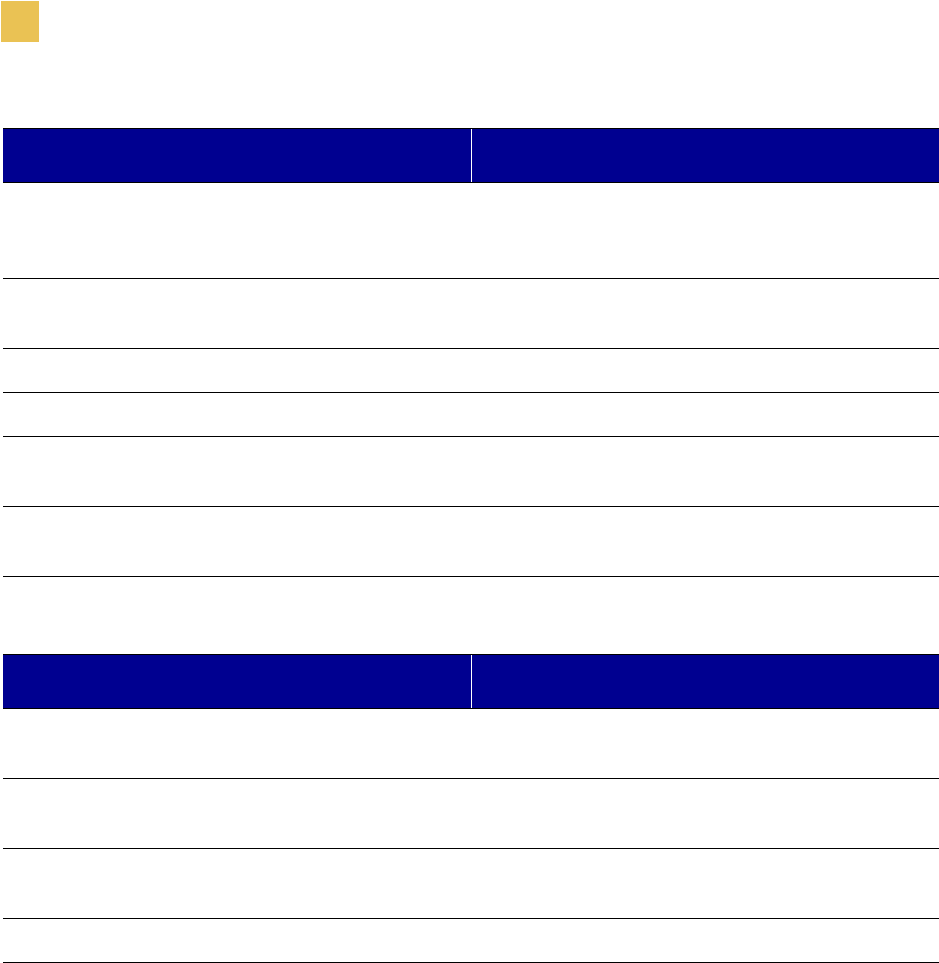
150 R110/R170XiIIIPlus User Guide
Specifications
Label Specifications
R170
Xi
III
Plus
Black Mark Sensing Only
Preferred inter-label gap Maximum inter-label gap = 2 × (label length for
which you have calibrated the printer) + 1 in.
(25.4 mm)
Maximum internal fanfold media pack size (label +
backing) L×W×H
8.0×7.1×4.5 in.
(203×114×114 mm)
Ticket/tag sensing notch L×W 0.12×0.25 in.(3×6 mm)
Ticket/tag sensing hole diameter 0.125 in.(3 mm)
Effective leading edge registration accuracy
(vertical)
± 0.060 in. (± 1.5 mm)
Effective leading edge registration accuracy
(horizontal)
± 0.060 in. (± 1.5 mm)
Specifications R170Xi IIIPlus
Mark length (measuring parallel to label or
tag edge)
0.12 in. (3 mm)
0.43 in. (11 mm)
Mark width (measuring to perpendicular label or
tag edge)
0.43 in. (11 mm)
Full media width
Mark location Marks must be located within 0.040 in. (1 mm) of
the inside media edge.
Mark density in Optical Density Unit (ODU) >1.0
Specifications R170Xi IIIPlus

R110/R170XiIIIPlus User Guide 151
Index
A
about this document, xxi
adjustments
LCD, 74
left position, 70
lower media sensor, 36
print darkness, 57
printhead toggle pressure, 37
print speed, 57
sensors, 32
tear-off position, 58
upper media sensor, 34
agency approvals, 140
alert setting, 60
applicator port setting, 72
auto-calibration, 31
B
backfeed setting, 70
backing removal, 51
bar codes
list available codes, 61
types of codes, 139
baud setting, 65
before you begin setup, 8
bitmap scaling factor, 74
black mark media
definition, 15
setting sensor type, 58
when to clean sensor, 110
BP-360X-Plus II
black mark specifications, 150
Brady support, xx
buttons on front panel, 4
C
cable requirements, 14
calibration
media and ribbon sensor, 32, , 64
methods, 31
setting for head close, 69
setting for media power up, 69
Canadian DOC compliance, vi
CANCEL self test, 132
check firmware version, 31
checklist
before you begin, 8
troubleshooting, 120
CHECK RIBBON light on, 32
CLEAN HEAD NOW message, 123
cleaning
cutter, 116
exterior of printer, 111
interior, 111
printhead and platen roller, 111
recommended schedule, 110
sensors, 113
snap plate, 115
communication interfaces
overview and location, 13
types of connections, 94
communications diagnostics test
sample printout, 135
selecting, 67
communications problems, 129
CompactFlash card
initialize, 62
installation, 106
compliance, 140
components, 6

152 R110/R170XiIIIPlus User Guide
Index
configuration
enter setup mode, 54
leave setup mode, 54
configuration label
print during CANCEL self test, 132
printing after loading printer, 29
printing using List Setup command, 61
sample, 29
connect printer to power source, 11
contact information, xx
continuous media
defined, 15
setting media type, 58
control prefix setting, 67
creases on labels, 127
create ribbon leader, 24
customer support, xx
cutter
cleaning, 116
CUTTER JAMMED message, 124
set up Cutter Mode, 43
set up Rewind Mode with cutter, 48
when to clean, 110
D
darkness setting, 57
data bits setting, 65
data cable requirements, 14
data connections
RS-232, 98
RS-422/RS-485, 101
data ports, 94
data source
communication interface location, 13
communication interfaces, 94
provide connections, 10
date setting, 75
DB-9 to DB-25 connection, 99
default gateway setting, 77
default password, 56
delimiter character setting, 68
diagnostics, 131
direct connection to a computer, 98
direct thermal mode
ribbon considerations, 18
direct thermal transfer mode
setting, 59
disable password protection, 56
display language selection, 75
document conventions
cautions, notes, examples, xxii
command line, xxii
file names and directories, xxii
hot links, xxii
illustration callouts, xxiii
document organization, xxi
dpi format conversion, 74
E
Early Warning setting, 60
electrical noise, 14
electrical specifications, 141
enter setup mode, 54
environmental specifications, 141
error messages, 121
exterior cleaning, 111
F
fanfold media loading, 22
FCC compliance, v
features, 138
FEED and PAUSE self test, 135
FEED self test, 134
firmware version, 31
Flash memory, 62
fonts
listing, 61
using CompactFlash card, 106
using PCMCIA card, 104
format convert setting, 74
format list, 61
format prefix setting, 68

Index
R110/R170XiIIIPlus User Guide 153
front panel
buttons, 4
enter setup mode, 54
illustration, 3
LCD error messages, 121
LCD setup messages, 57
leave setup mode, 54
lights, 5
fuse replacement, 117
G
gray lines on labels, 127
H
HEAD COLD message, 124
HEAD ELEMENT BAD message, 122
HEAD OPEN message, 121
HEAD TOO HOT message, 123
host handshake setting, 66
I
IBM Twinax or Coax option, 13
idle display setting, 75
image not sharp, 126
images list, 61
initialize Flash memory, 62
initialize memory card, 62
inspect the printer, 9
interior cleaning, 111
international safety organizations, 11
IP settings
default gateway, 77
IP address, 76
IP resolution, 76
protocols, 76
subnet mask, 77
L
label-available sensor
location, 113
when to clean, 110
label backing removal, 51
label length maximum setting, 59
labels did not print, 129
label specifications by model, 146
labels per roll setting, 61
label top
printer cannot detect, 130
setting, 70
language selection, 75
LCD messages
adjust LCD settings, 74
error messages, 121
language selection, 75
setup mode, 57
leave setup mode, 54
liability, vi
light or no printing, 126
lights on front panel, 5
list settings
all settings, 61
bar codes, 61
fonts, 61
formats, 61
images, 61
setup, 61
load the printer
load fanfold media, 22
load roll media, 20
ribbon, 24
long calibration, 31
lower media sensor adjustment, 36
M
mark LED setting, 74
Mark Med S. setting, 74
maximum label length setting, 59
media
label specifications by model, 146
load fanfold media, 22
load roll media, 20
media LED setting, 74
media low warning, 60
RFID “smart” labels, 17
setting labels per roll, 61
setting media type, 58
types of media, 15

154 R110/R170XiIIIPlus User Guide
Index
media and ribbon sensor calibration
procedure, 32, , 64
when to perform, 32
media path cleaning, 110
media power up setting, 69
media sensor
adjustment, 34
location, 113
print media sensor profile, 63
sensor sensitivity calibration, 31
Media S. setting, 74
memory card installation
CompactFlash card, 106
PCMCIA card, 104
modem connection, 100
N
network ID setting, 66
non-continuous media
black mark, 15
setting media type, 58
web media, 16
O
operating conditions, 10
OUT OF MEMORY message, 125
P
PAPER OUT message, 121
parallel port
location, 13
pin configuration, 95
setting parallel communications, 64
settings, 94
parity setting, 65
passwords
default, 56
disable, 56
entering, 56
PAUSE self test, 133
PCMCIA card
initialize, 62
installation, 104
peel-off bar cleaning, 110
Peel-Off Mode, 41
pin configuration
parallel port, 95
serial port, 97
platen roller
cleaning, 111
when to clean, 110
ports, 94
power cord specifications, 11
Power-On Self Test (POST), 131
power source, 11
print configuration label
CANCEL self test, 132
List Setup command, 61
when printer is loaded, 29
print darkness setting, 57
printer components, 6
printer diagnostics, 131
printer operation, 19
printer self tests, 131
printer settings
applicator port, 72
backfeed, 70
baud, 65
configuration label as baseline, 29
control prefix, 67
data bits, 65
date, 75
delimiter character, 68
Early Warning, 60
format convert, 74
format prefix, 68
head resistor, 71
head test count, 71
host handshake, 66
idle display, 75
IP settings, 76
labels per roll, 61
label top, 70
language, 75
LCD, 74
left position, 70
maximum label length, 59
media type, 58
network ID, 66

Index
R110/R170XiIIIPlus User Guide 155
printer settings (continued)
parallel communications, 64
parity, 65
passwords, 56
print darkness, 57
print method, 59
print speed, 57
print width, 59
protocol, 66
resynch mode, 73
ribbon length, 61
saving, 54
sensor type, 58
serial communications, 65
setting through front panel, 54
start print signal, 73
time, 75
verifier port, 72
ZPL mode, 68
printer setup
before you begin, 8
load the printer, 20
printhead
cleaning, 111
early warning message, 60
head close setting, 69
head resistor value setting, 71
head test count setting, 71
pressure adjustment, 37
when to clean, 110
print modes
Cutter Mode, 43
features, 138
Peel-Off Mode, 41
Rewind Mode, 45
Rewind Mode with Cutter option, 48
selecting, 40, , 58
Tear-Off Mode, 20
print quality
effect of printhead toggle pressure, 37
troubleshooting problems, 126
PrintServer II settings
default gateway, 77
IP address, 76
IP protocols, 76
IP resolution, 76
subnet mask, 77
print speed setting, 57
print width setting, 59
product improvements, v
proprietary statement, v
protocol setting, 66
R
R110XiIIIPlus
black mark specifications, 148
general specifications, 142
label specifications, 146
ribbon specifications, 144
R170XiIIIPlus
black mark specifications, 150
general specifications, 143
label specifications, 149
ribbon specifications, 145
related documents, xxiv
relative humidity requirements, 10
remove backing from rewind spindle, 51
remove used ribbon, 28
replace fuse, 117
report shipping damage, 9
reship the printer, 9
resynch mode setting, 73
Rewind Mode, 45
Rewind Mode with Cutter option, 48
rewind plate installation, 46
rewind spindle, 51
RFID
guidelines, 79
sample ZPL commands, 91
“smart” labels, 17
transponder placement, 80
ZPL commands, 81

156 R110/R170XiIIIPlus User Guide
Index
ribbon
CHECK RIBBON light on, 32
create ribbon leader, 24
load, 24
removal, 28
RIBBON IN message, 123
ribbon LED setting, 74
ribbon low warning, 60
Ribbon Out message, 121
setting length, 61
specifications, 144
troubleshooting wrinkles, 128
when used, 18
ribbon sensor
calibration procedure, 64
cleaning, 113
location, 113
sensitivity calibration, 31
when to clean, 110
Ribbon S. setting, 74
roll media loading, 20
routine maintenance, 109
RS-232 interface connections, 98
RS-422/RS-485 interconnections, 101
RTC (Real-time clock) setting
date, 75
time, 75
S
schedule for cleaning, 110
select a printer site, 10
selecting a print mode, 40
self tests
CANCEL, 132
FEED, 134
FEED and PAUSE, 135
how to perform additional tests, 131
PAUSE, 133
Power-On Self Test (POST), 131
Sensor Profile calibration
description, 31
procedure, 63
sensors
adjusting, 32
cleaning, 113
label-available sensor location, 113
lower media sensor adjustment, 36
media and ribbon sensor calibration, 32
ribbon sensor location, 113
setting sensor type, 58
transmissive (media) sensor adjustment, 34
transmissive (media) sensor location, 113
upper media sensor adjustment, 34
serial port
location, 13
pin configuration, 97
settings, 96
setting serial communications, 65
setup checklist, 8
setup mode
enter setup mode, 54
LCD messages, 57
leave setup mode, 54
shipping
report damage, 9
reship the printer, 9
short calibration, 31
site requirements, 10
“smart” labels, 17
snap plate
cleaning, 115
when to clean, 110
spacing requirements, 10
specifications
by model number, 142
electrical, 141
environmental, 141
general, 141
power cord, 11
ribbon, 144
standard data ports, 94
standard features, 138
start print signal setting, 73
store the printer, 9
subnet mask setting, 77
support, xx
surface for the printer, 10

Index
R110/R170XiIIIPlus User Guide 157
T
take label setting, 74
Tear-Off Mode
load the printer, 20
tear-off bar cleaning, 110
tear-off position adjustment, 58
temperature requirements, 10
thermal transfer mode
load ribbon, 24
ribbon considerations, 18
setting, 59
time setting, 75
toggle pressure adjustment, 37
top of label
printer cannot detect, 130
setting, 70
transmissive (media) sensor
adjustment, 34
location, 113
when to clean, 110
transponder placement, 80
troubleshooting
checklist, 120
CHECK RIBBON light on, 32
communications problems, 129
LCD error messages, 121
non-continuous labels treated as continuous, 32
printer diagnostics, 131
print quality problems, 126
wrinkled ribbon, 128
types of media, 15
RFID “smart” labels, 17
U
unpack the printer, 9
upgrade firmware, 31
upper media sensor adjustment, 34
USB 2.0 port
location, 13
settings, 102
V
verifier port setting, 72
vertical lines on labels, 127
W
web media
definition, 16
setting sensor type, 58
Web S. setting, 74
wireless card socket option, 13
wrinkled ribbon, 128
Z
ZebraNet PrintServer II, 13
Zebra Programming Language (ZPL II)
sample RFID Programming, 91
^HV, Host Verification, 86
^RS, RFID Setup, 87
^RT, Read Tag, 84
^WT, Write Tag, 82
Zebra support, xx
ZPL Programming Language
features, 138
ZPL mode setting, 68
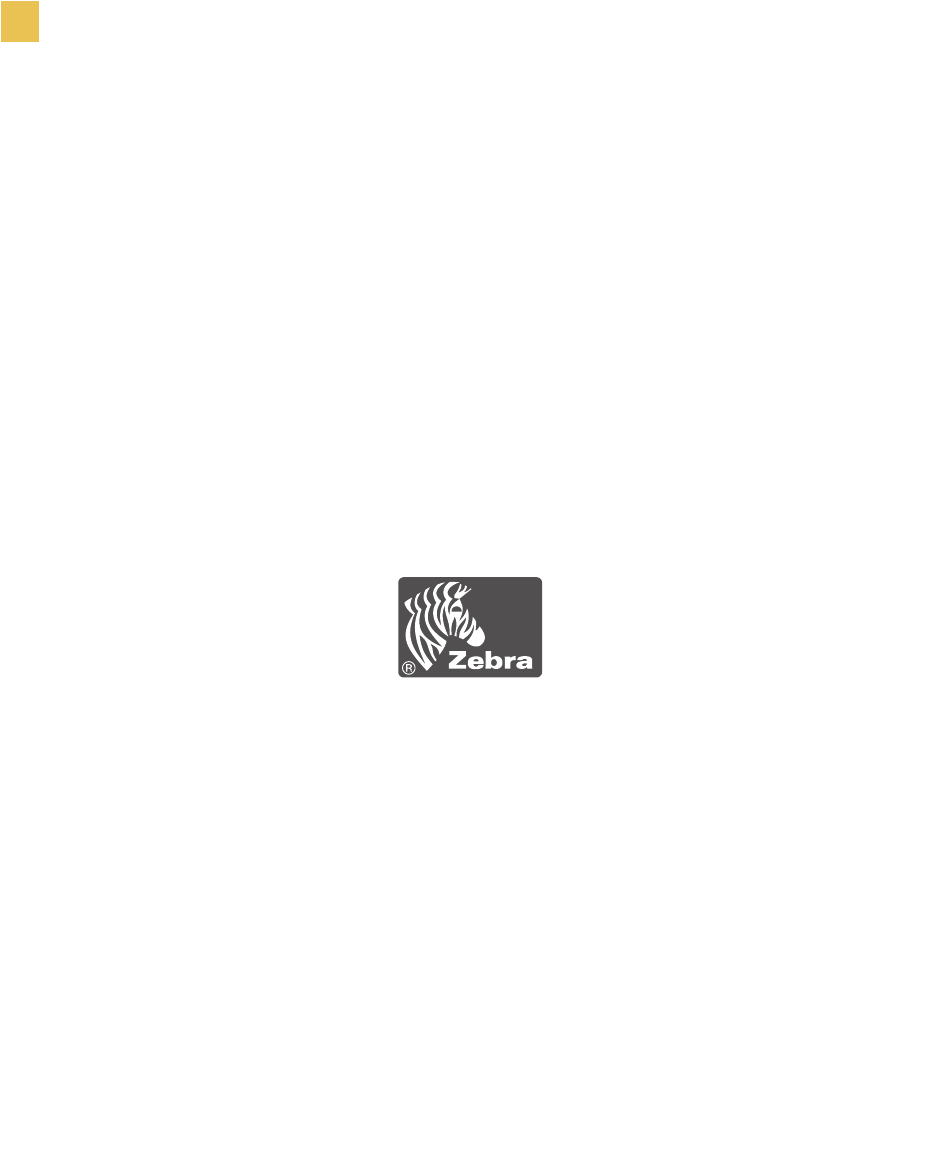
158 R110/R170XiIIIPlus User Guide
Index

R110/R170XiIIIPlus User Guide 1
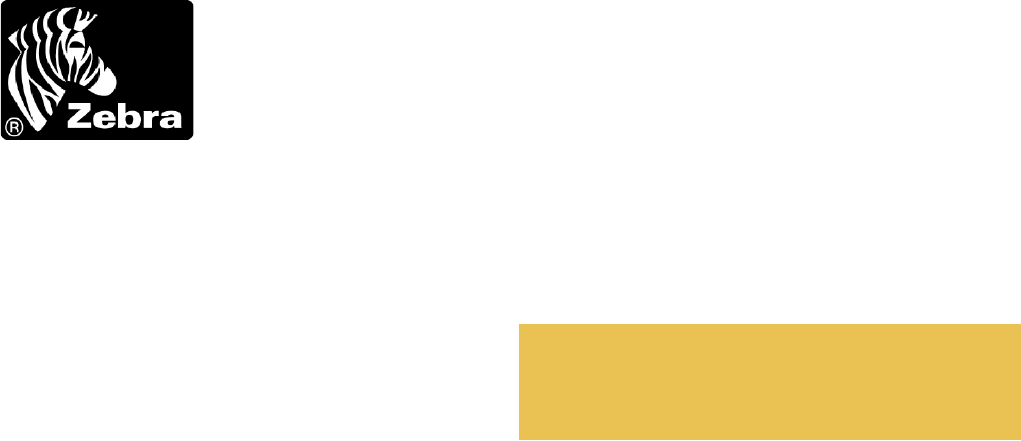
Zebra Technologies Corporation
333 Corporate Woods Parkway
Vernon Hills, Illinois 60061.3109 U.S.A.
Telephone: +1 847.634.6700
Facsimile: +1 847.913.8766
Zebra Technologies Europe Limited
Zebra House
The Valley Centre, Gordon Road
High Wycombe
Buckinghamshire HP13 6EQ, UK
Telephone: +44 (0) 1494 472872
Facsimile: +44 (0) 1494 450103
Customer Order # 13383L Rev. 2
Manufacturer Part # 13383LB Rev. 2
© 2004 ZIH Corp.
